Allison Collection Photos
August, 1944
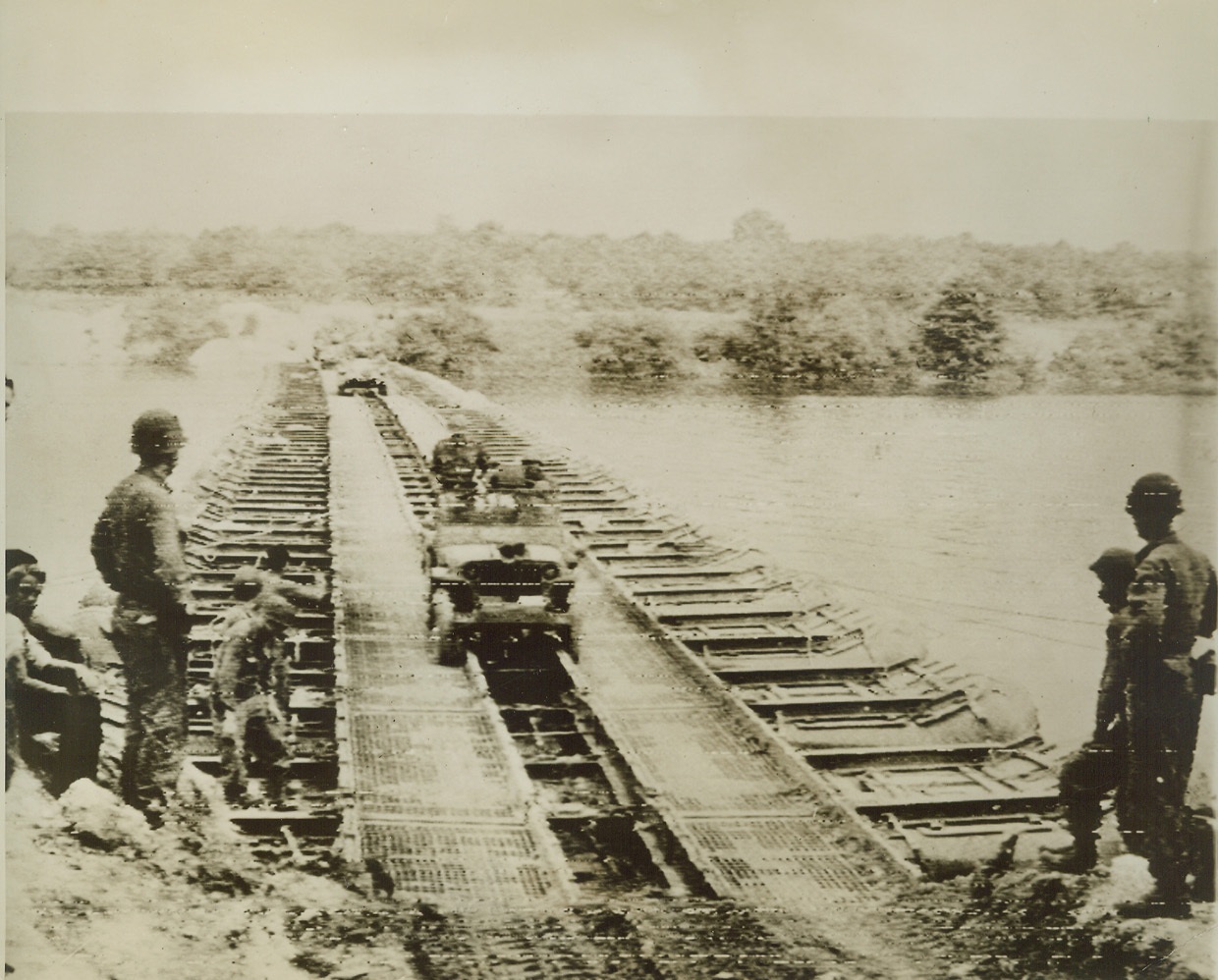
Patton Stays Up Front, 8/30/1944. France – A U.S. Jeep, carrying Lt. Gen. George S. Patton, rolls across a pontoon bridge over the Seine River on the heels of his rampaging 3rd Army. He was the first American officer to set foot on the northern bank of the historic river in this war. Credit (Army Radiotelephoto from ACME);
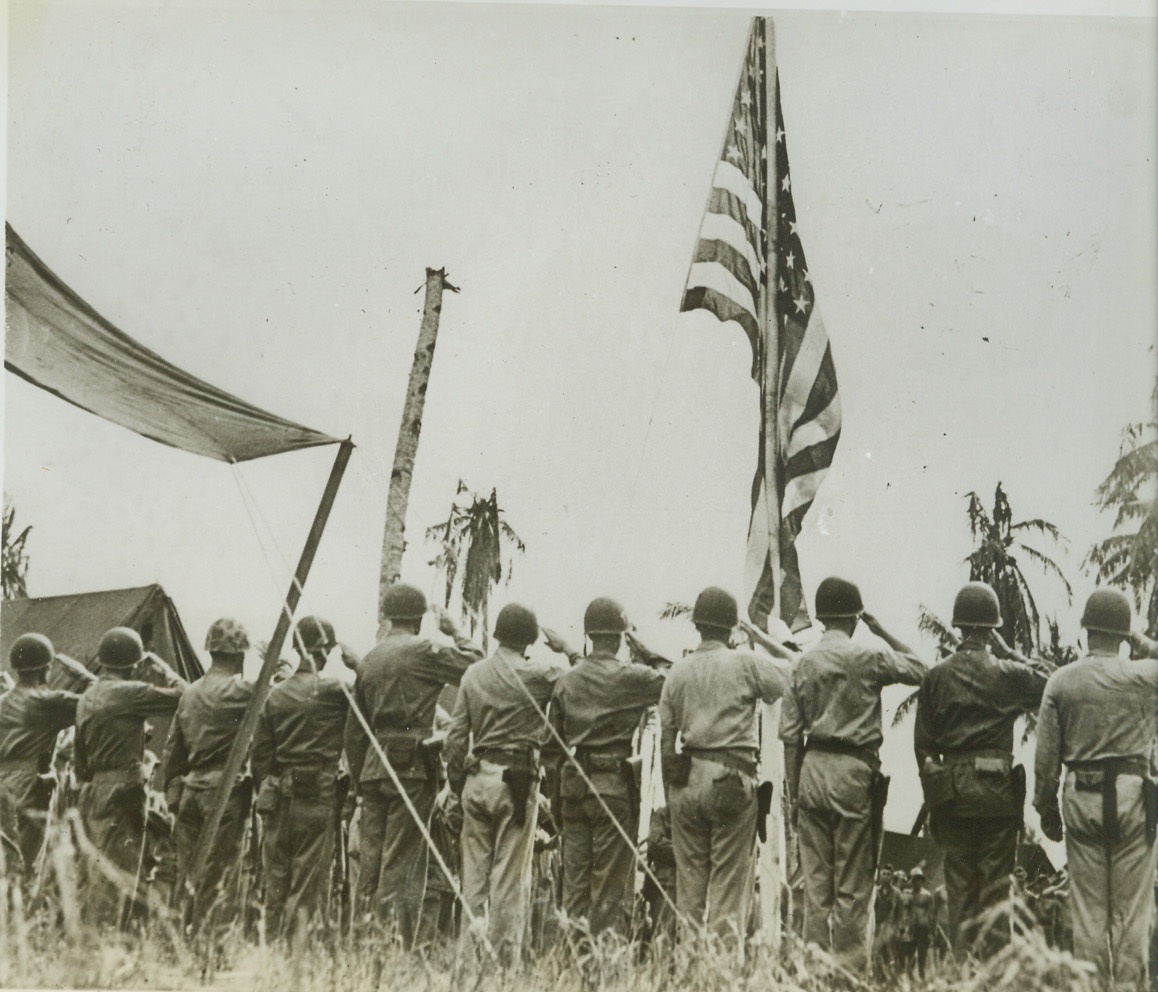
The Call to Colors, 8/6/1944. Guam – Still attired in their battle helmets, Marines of the First Provisional Marine Brigade snap to a smart salute as the American flag waves aloft in the first flag-raising ceremony in front of Maj. Gen. Roy S. Geiger’s headquarters at Agat, Orote Peninsula. Credit (ACME);
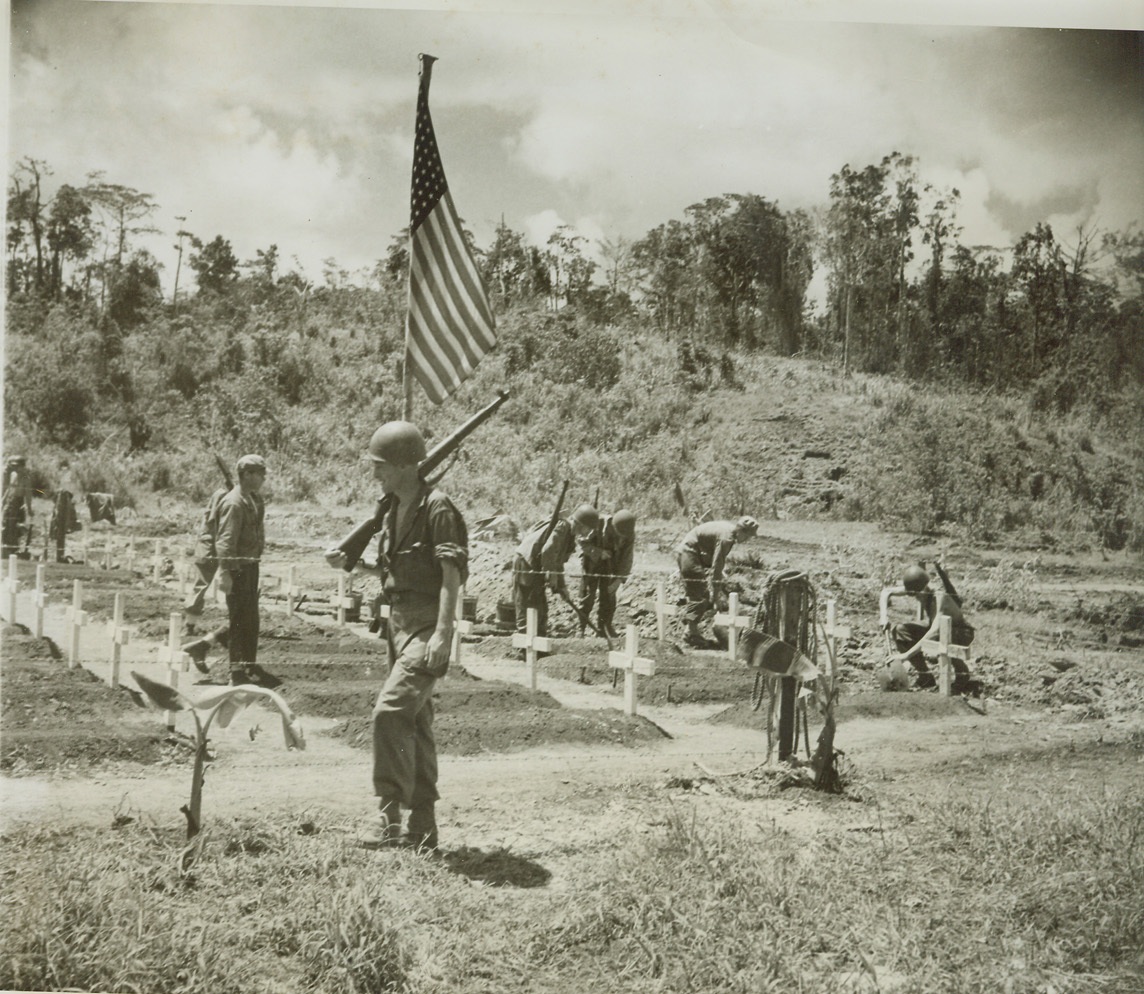
Sentry for Protection, 8/6/1944. Lorengau, Manus Island – Pacing up and down beside the American cemetery at Lorengau, Manus Island, in the Admiralty group, this sentry protects men working on the Yank graves in background. A few hours before, a Jap sniper had picked this spot to strike at American fighters as they set up crosses to mark the graves of their buddies. Credit: (ACME Photo by Thomas L. Shafer, for the War Picture Pool);
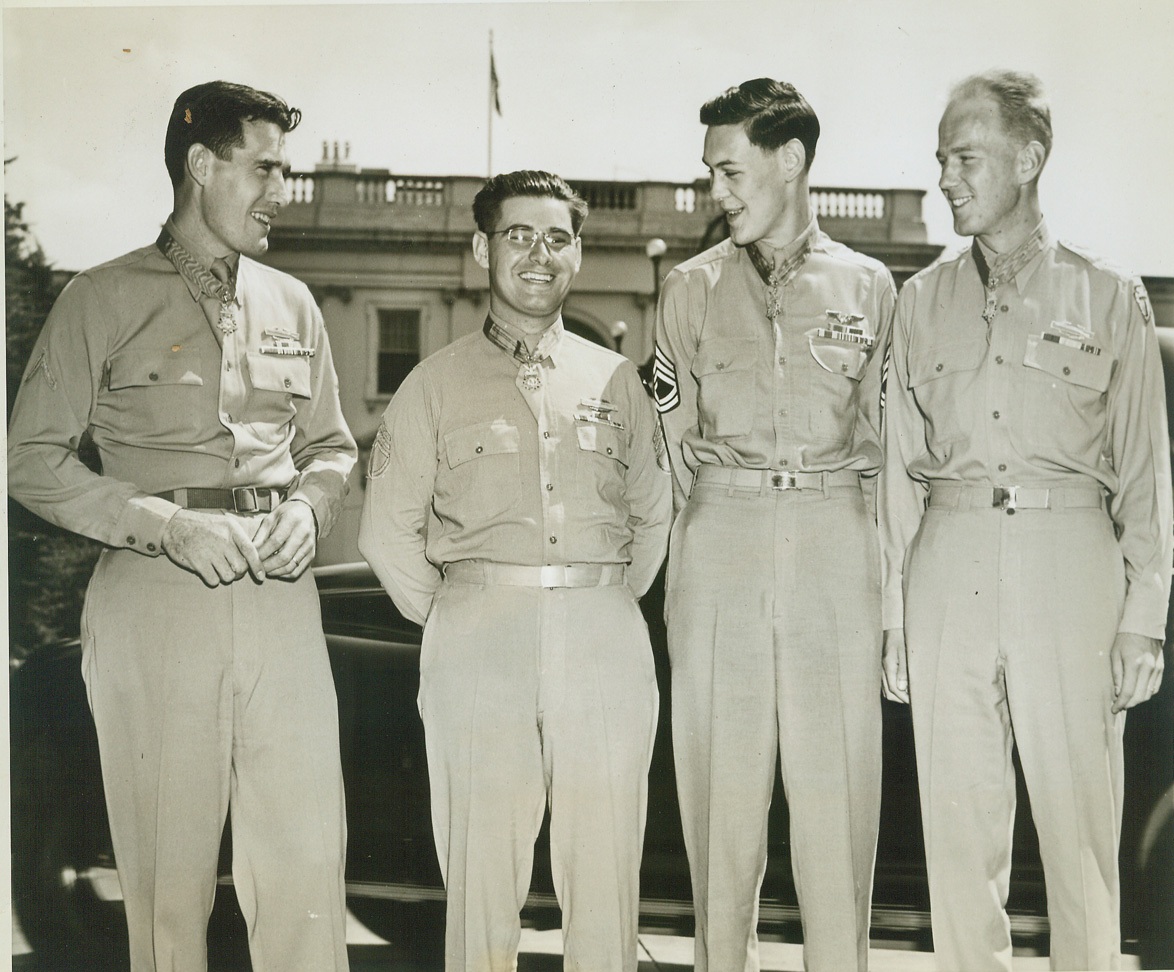
RECEIVE NATION’S HIGHEST AWARD FROM FDR, 8/30/1944. Washington, DC – On the White House lawn is this quartet of war heroes after each had been presented with the Medal of Honor, the Nation’s highest award for gallantry, by President Roosevelt. They are (left to right) Pfc. William J. Johnston, Colchester, Conn., machine gunner who held off two German counterattacks and stuck to his gun although his comrades thought him mortally wounded; S/Sgt. Jessie R. Drowley, Luzerne, Mich., who was cited for heroism on Bougainville; T/Sgt. Forrest L. Vosler, Livonia, N.Y., who received an eye injury and other wounds on a Bremen raid and asked to be tossed from the plane to lighten its load; and 1st Lt. Arnold L Bjorklund, Seattle, Wash., who used three hand grenades to destroy two machine guns, a heavy mortar, and to kill seven Germans. NY#12 DJH LON 70 CEP LV SEA CAN. Credit Line (ACME);
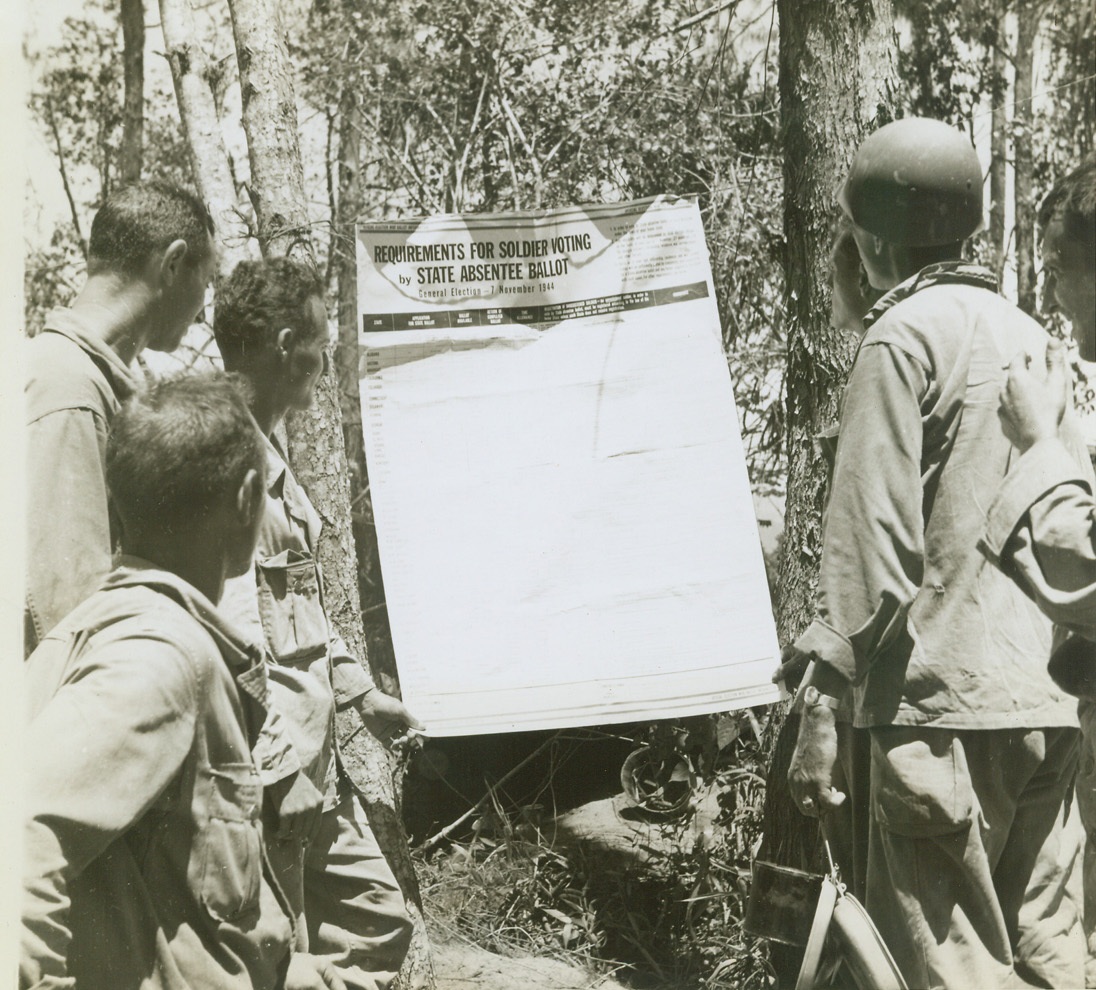
YANKS IN NEW GUINEA SEE ELECTION BALLOT, 8/11/1944. NEW GUINEA – Near the battle front down the Driniumor River, 16 miles east of Aitape on New Guinea, American soldiers take time out from war duties to read requirements for soldiers voting by state absentee ballot. Credit: OWI Radiophoto by Tom Shafer for ACME;

AMPHIBIOUS SUPPLY TRAILERS, 8/13/1944. CAMP LEJEUNE, N.C. – An amphibious tractor hauls ashore a new amphibious cargo trailer during a series of test by US Marines. The water-tight trailers have a capacity of 220 cubic feet. When used in combat, they will insure the delivery of supplies in a more usable condition. Credit: U.S. Marine Corps photo via OWI Radiophoto from ACME;
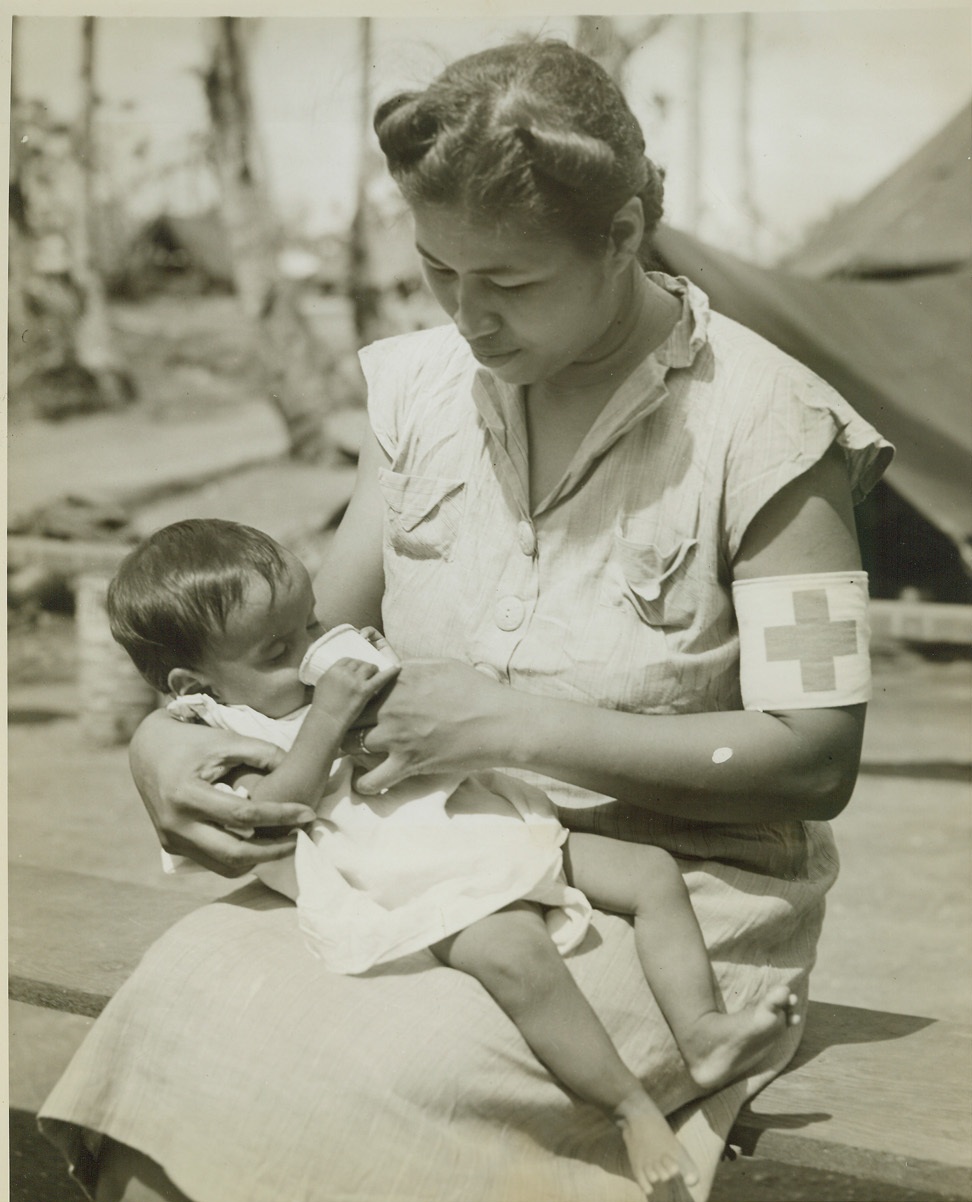
FIRST MILK FOR GUAM CHILD, 8/23/1944. GUAM – Nurse Maria S. Aguon gives this little 9-months-old baby its first taste of milk since birth at the civilian internment camp near Agana on the island of Guam. Many Chamorro mothers now in the camp, were fed so poorly under Japanese domination, that they had no breast milk for their babies. Credit: OWI Radiophoto by Stanley Troutman for ACME;
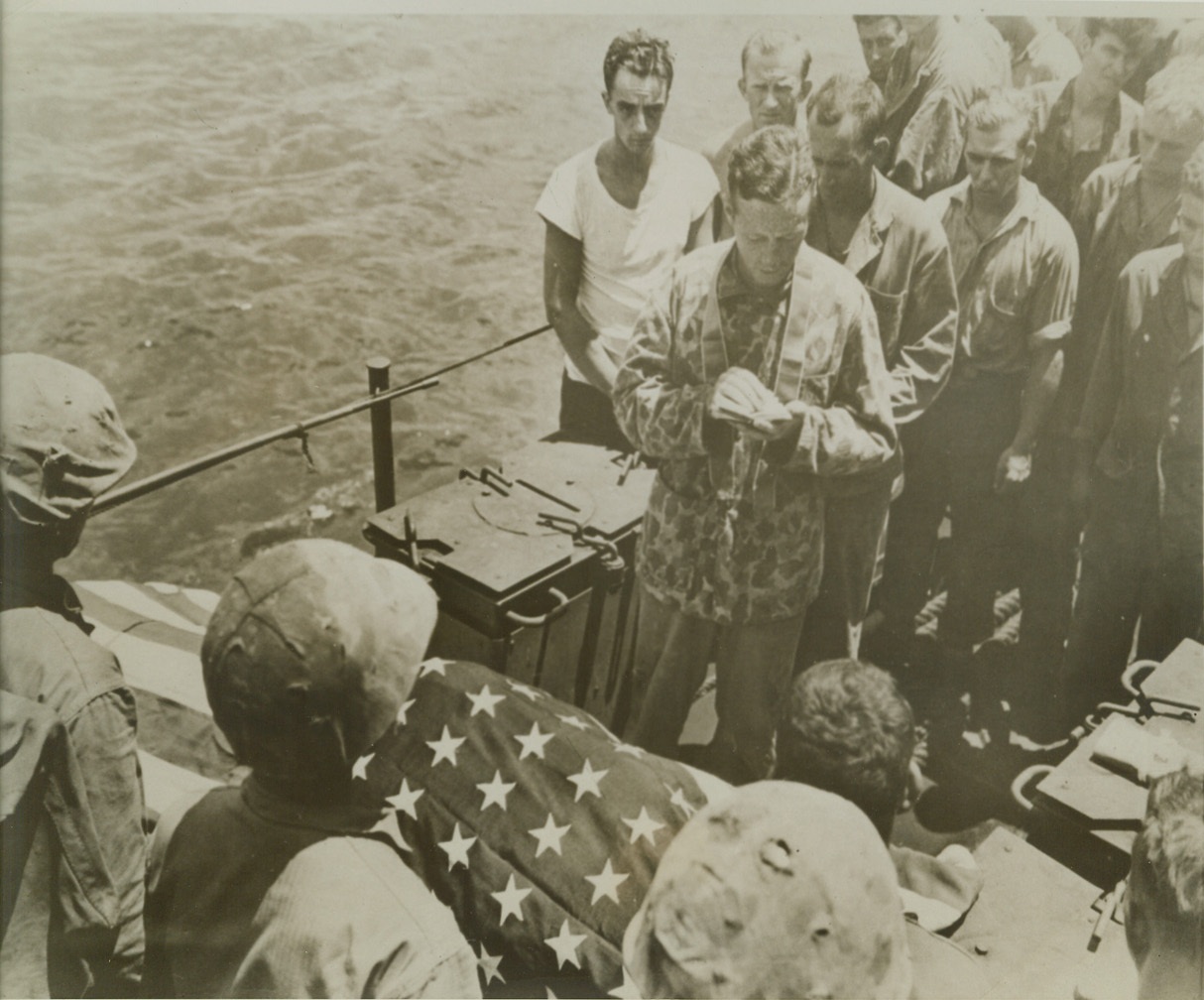
LAST RITES FOR MARINE, 8/8/1944. SOMEWHERE IN THE PACIFIC – Still wearing his camouflaged tunic, Lt. (JG) Joseph P. F. Gallagher, USNR, Catholic Chaplain, 840 Grand Concourse, Bronx, N.Y., reads the burial service for a Marine who died in the assault on Tinian Island. His friends form an Honor Guard for the burial at sea. Credit: U.S. Marine Corp photo via OWI Radiophoto from ACME;
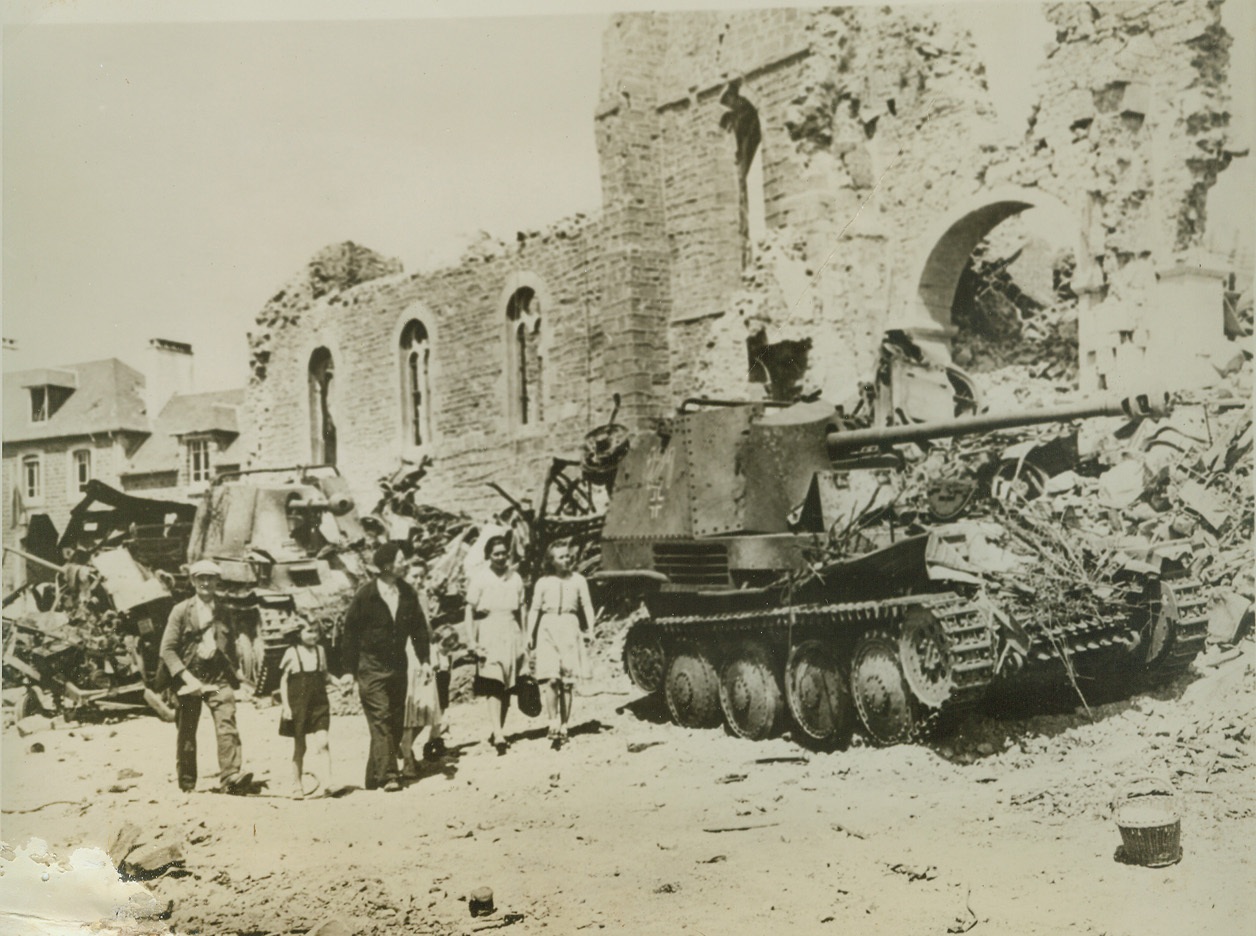
UNWELCOME GUEST IN RONCEY, 8/11/1944. RONCEY, FRANCE – These citizens of Roncey, returning to their home town after the wave of battle had swept past it, are greeted by wreckage and debris-strewn streets. German tanks and other pieces of wrecked or abandoned enemy equipment litter the roads. Credit: ACME;
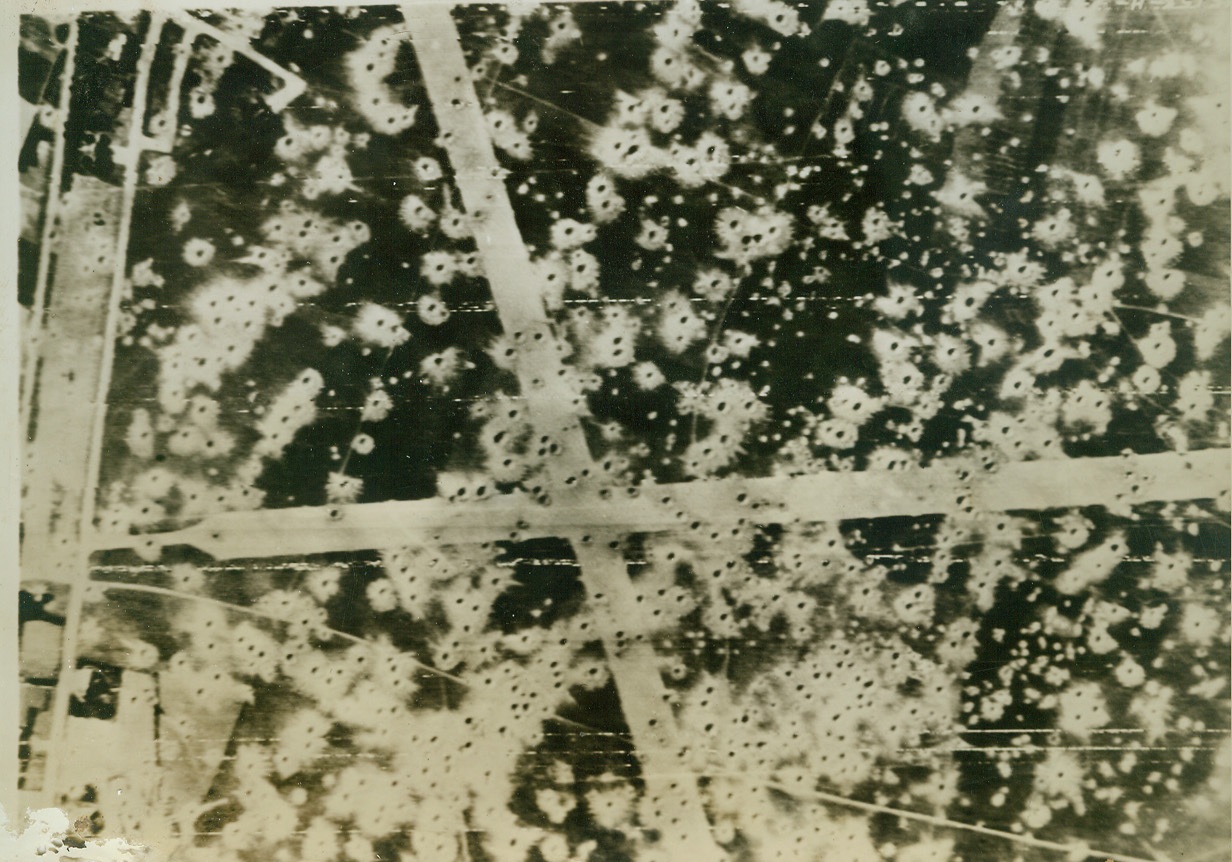
AIR HOLES IN AIRFIELD, 8/20/1944. BELGIUM – Bomb craters slash across the runways and the surrounding parking areas are splattered with the pits after an attack on Le Culot Airfield by RAF bombers on August 15. Renewed Allied air offensive is greatly responsible for keeping the Luftwaffe almost grounded. This is a British official Air Ministry photo. Credit: U.S. Army Radiotelephoto from ACME;
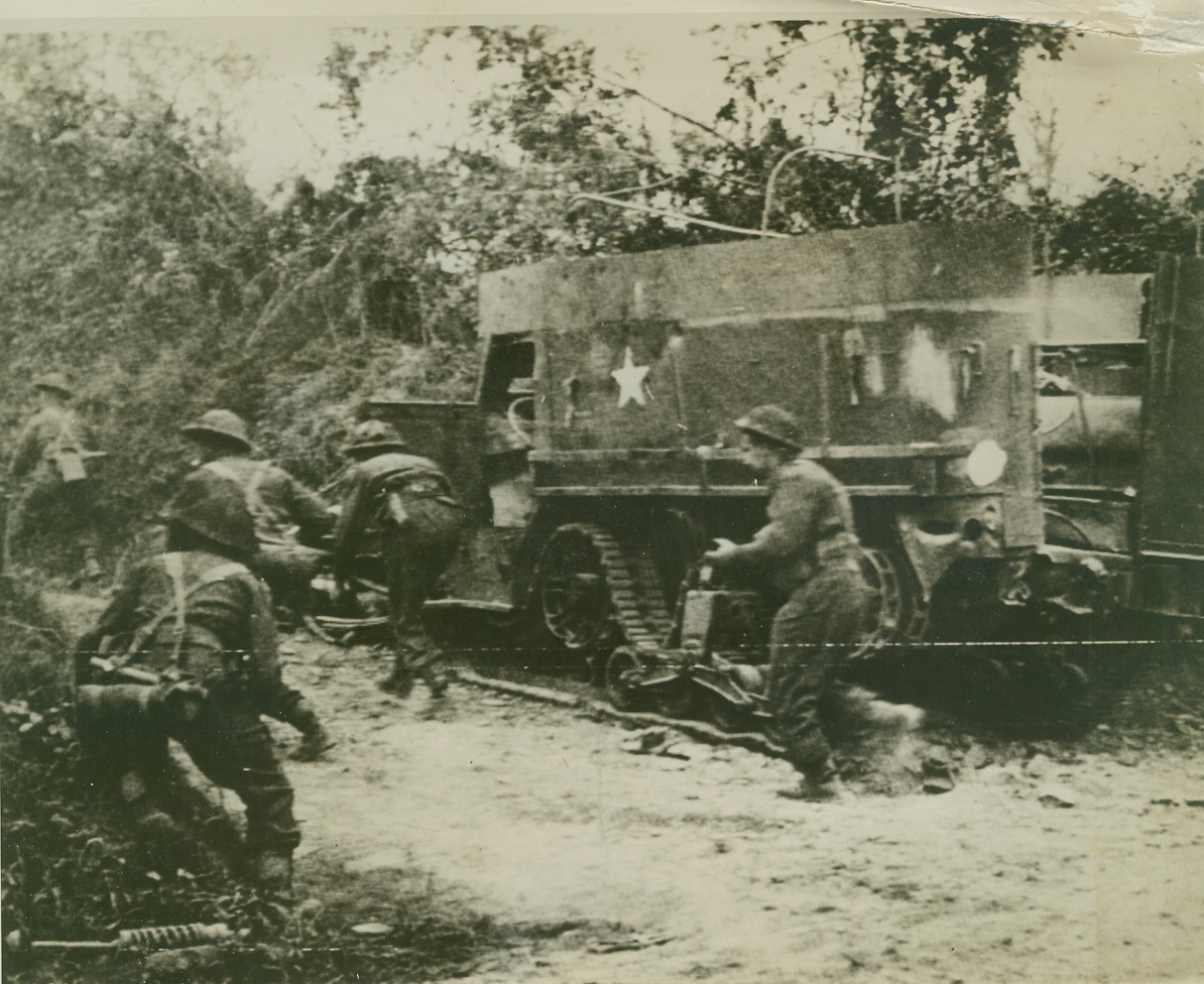
MOPPING UP, 8/7/1944. FRANCE – Crouching as they run, troops of the British Second Army dash ahead on a road near Tracy Bocage. The fighting men are mopping up during their army’s advance across France. Credit: British official photo via U.S. Signal Corps radiotelephoto from ACME;
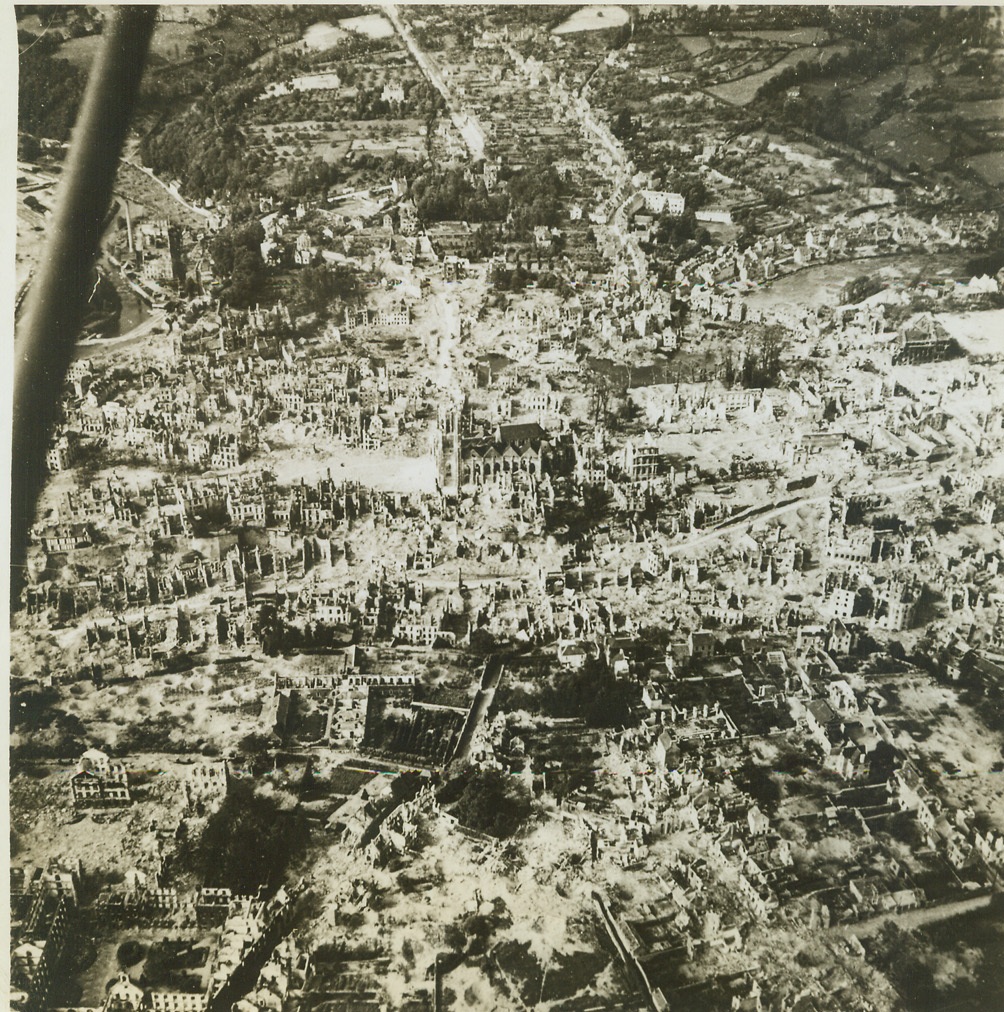
Battle-Ravaged St. Lo, 8/8/1944. This airview from an Allied plane shows the terrible extent of damage suffered by St. Lo in the flaming battle for the possession of the Cherbourg peninsula, in France. Credit: (ACME) (WP);
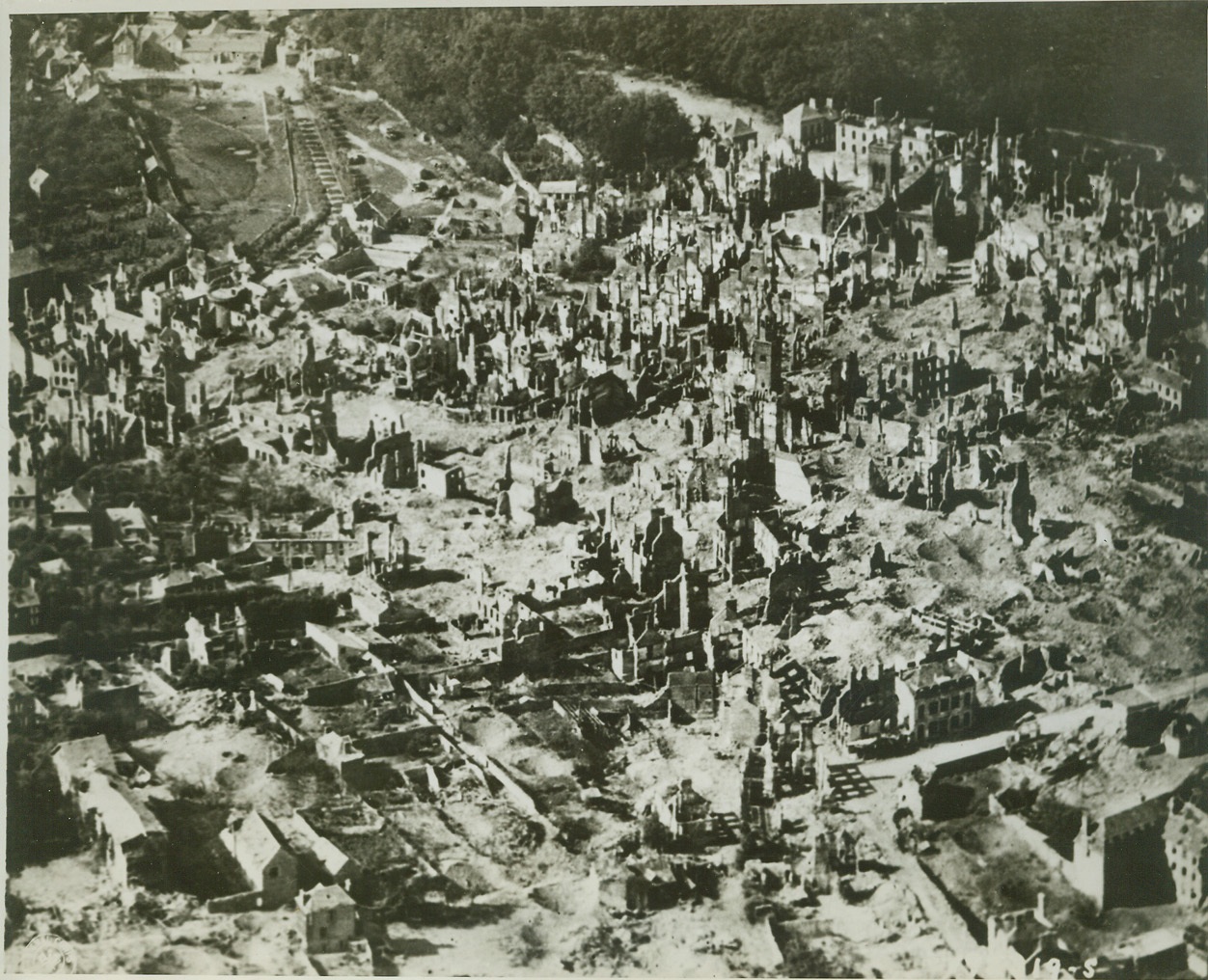
No Title. 8/14/1944.
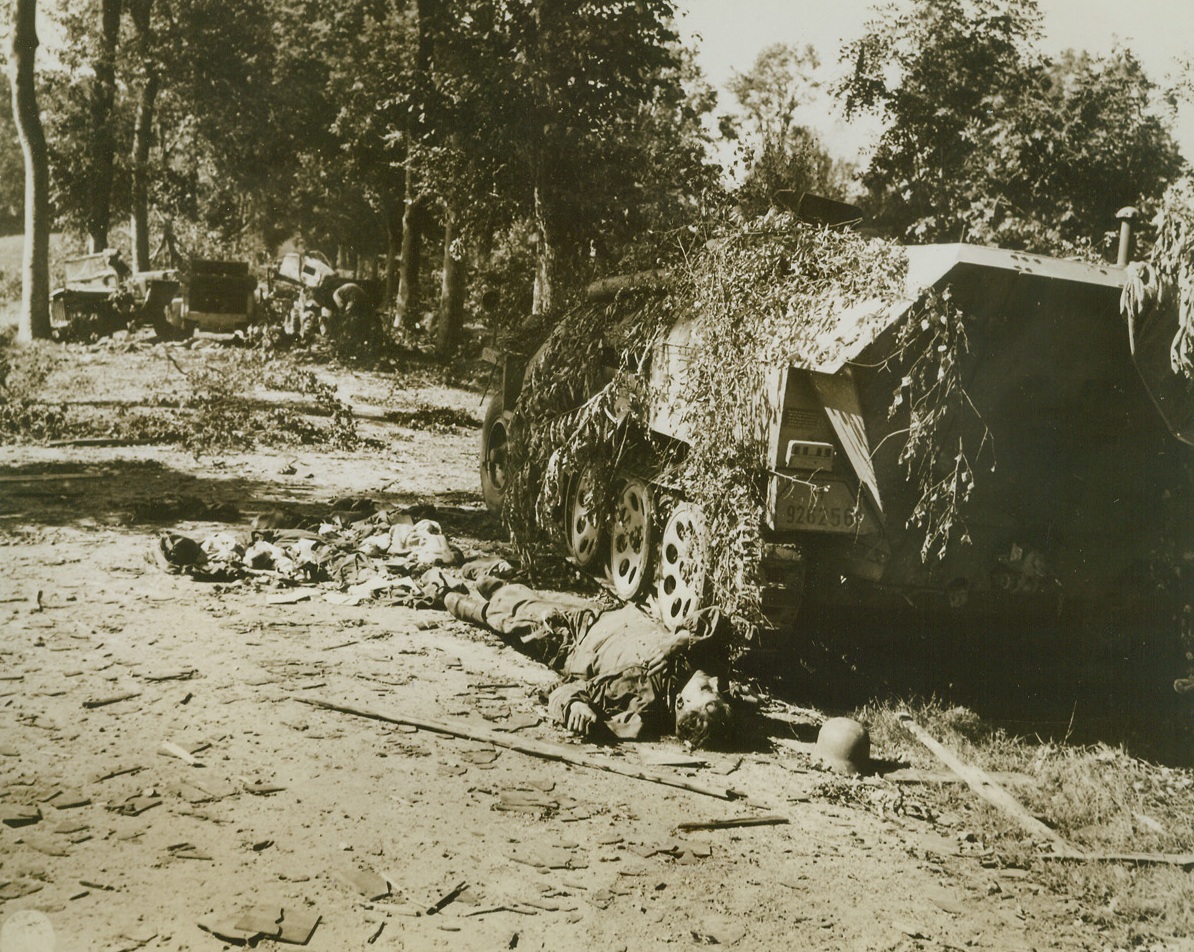
Attempted Retreat Ends in Death, 8/22/1944. FRANCE – This German soldier was killed s he attempted to flee from his half-track vehicle as German forces retreated toward Mortain, France. Other vehicles in his unit (background) were also knocked out as they fled homeward. Credit; (Signal Corps Photo From ACME);
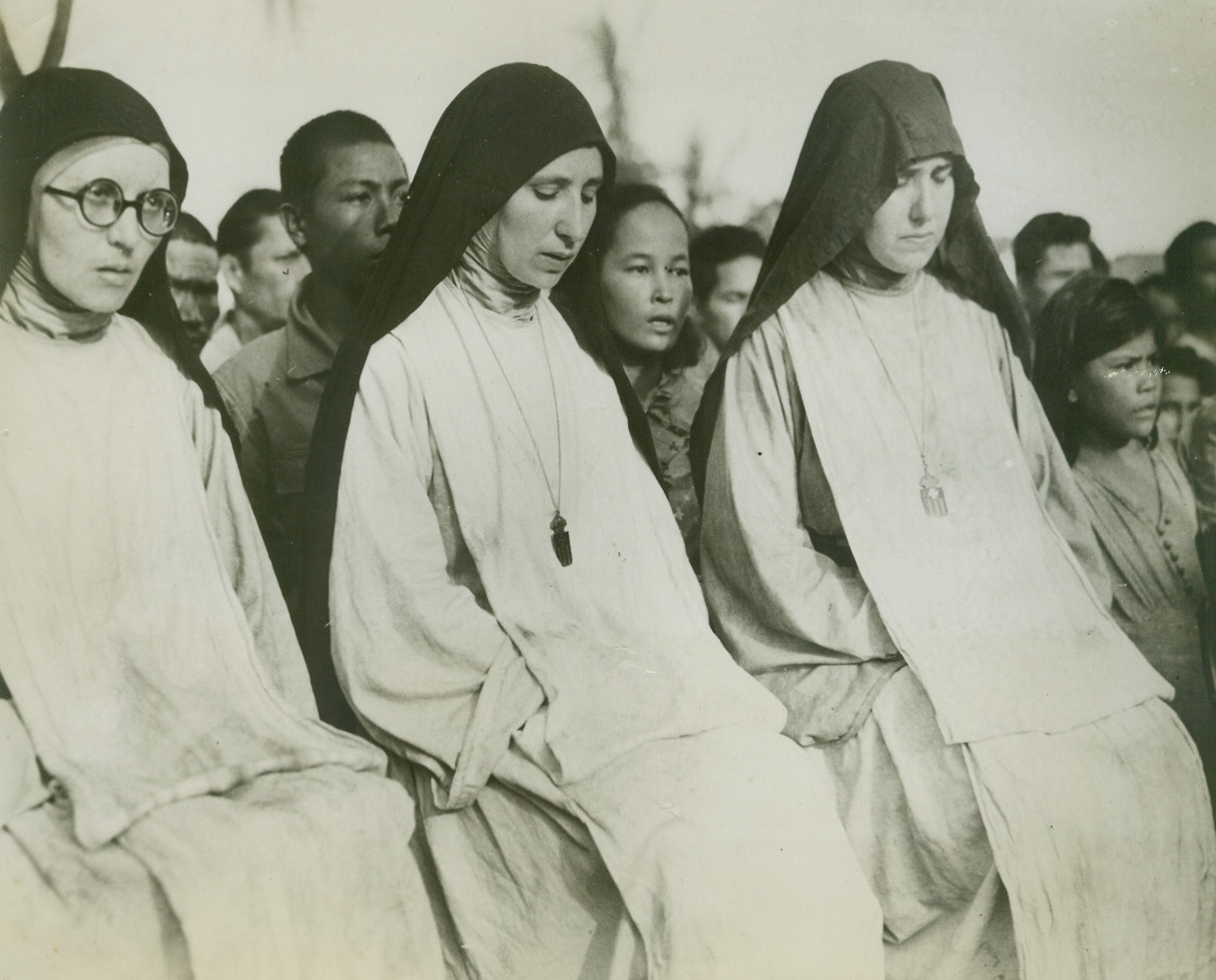
NUNS ATTEND FIRST MASS ON LIBERATED SAIPAN, 8/1/1944. SAIPAN ISLAND—Catholic nuns attend the first Mass held on Saipan since 1940, when the Japanese abolished Christian rites. Attending Mass with them are other civilians freed from the Japs by the capture of Saipan by the U.S. “triphibian” (air-land-sea) forces.Credit: Official U.S. Navy photo from Acme;

NAZIS SURRENDER CHAMBER OF DEPUTIES IN PARIS, 8/30/1944. FRANCE—Two Nazi officers who were part of the 400 Germans who barricaded themselves in the Chamber of Deputies in Paris and fought off liberating troops, wait to be driven away after their surrender to French partisan forces. The flag of truce is in the back of the car.Credit: Acme;
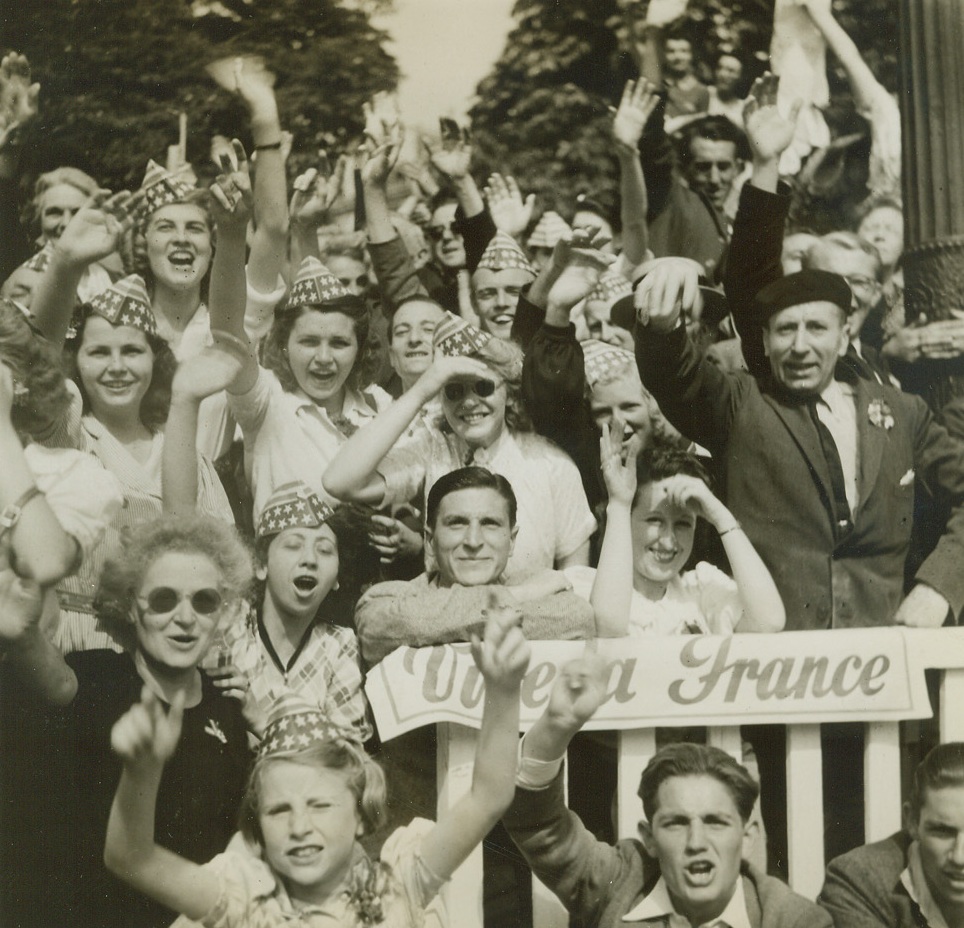
VIVE THE STARS AND STRIPES, 8/31/1944. PARIS—Wild with joy over the liberation of Paris, and singing the praises of their American allies, these celebrating Parisians let the Stars and Stripes go to their heads. Wearing the gay paper hats, they cheer and wave as the forces of liberation march past on parade. Credit: Acme photo by Bert Brandt for the War Picture Pool;

German Women Train for Anti-Aircraft Duty, 8/19/1944. In this photo, radioed to New York today (August 19) from Stockholm, German women work side-by-side with the men in training for work in ack-ack units. According to the German caption, these women will replace the men who will be released, under Germany’s total mobilization program, to fight at the front. Credit (ACME Radiophoto);

Expanding New Beachhead, 8/16/1944. Moving cautiously and watching every house for enemy snipers, American Infantrymen advance through a street in a town east of Toulon. In the background, can be seen the beach, one of the many points Allied invasion forces hit along the coast of Southern France. Note German rifle and helmet (right, foreground). Credit: ACME PHOTO BY SHERMAN MONTROSE FOR WAR PICTURE POOL VIA ARMY RADIOTELEPHOTO.;

Bomb-Torn St. Lo Plays Host to Yanks, 8/12/1944. ST. LO, FRANCE -- It was a victory in ground gain only for American troops which took St. Lo. Practically all of the city was in the same condition as the section shown here. Soldiers amble down the street looking to both sides, where, stretching as far as the eye can see, is rubble and debris from shattered buildings and emplacements. Credit (ACME) (WP);
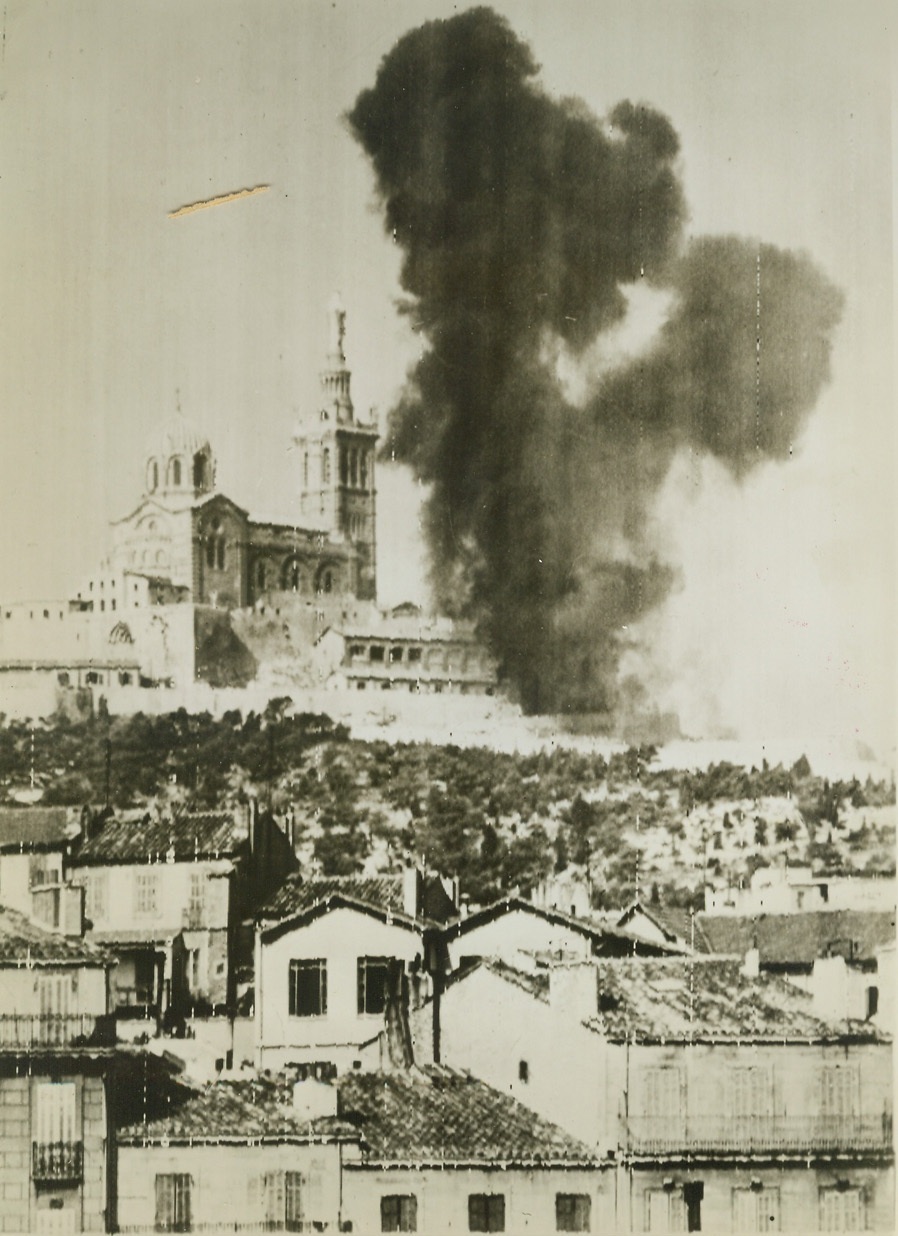
Cathedral An Enemy Target, 8/31/1944. FRANCE -- Smoke rises from a hit near the famous Cathedral of Notre Dame De La Garde situated on a hill in Marseille and the target for German fire after the city was captured by French forces. Credit (Army Radiotelephoto From ACME);
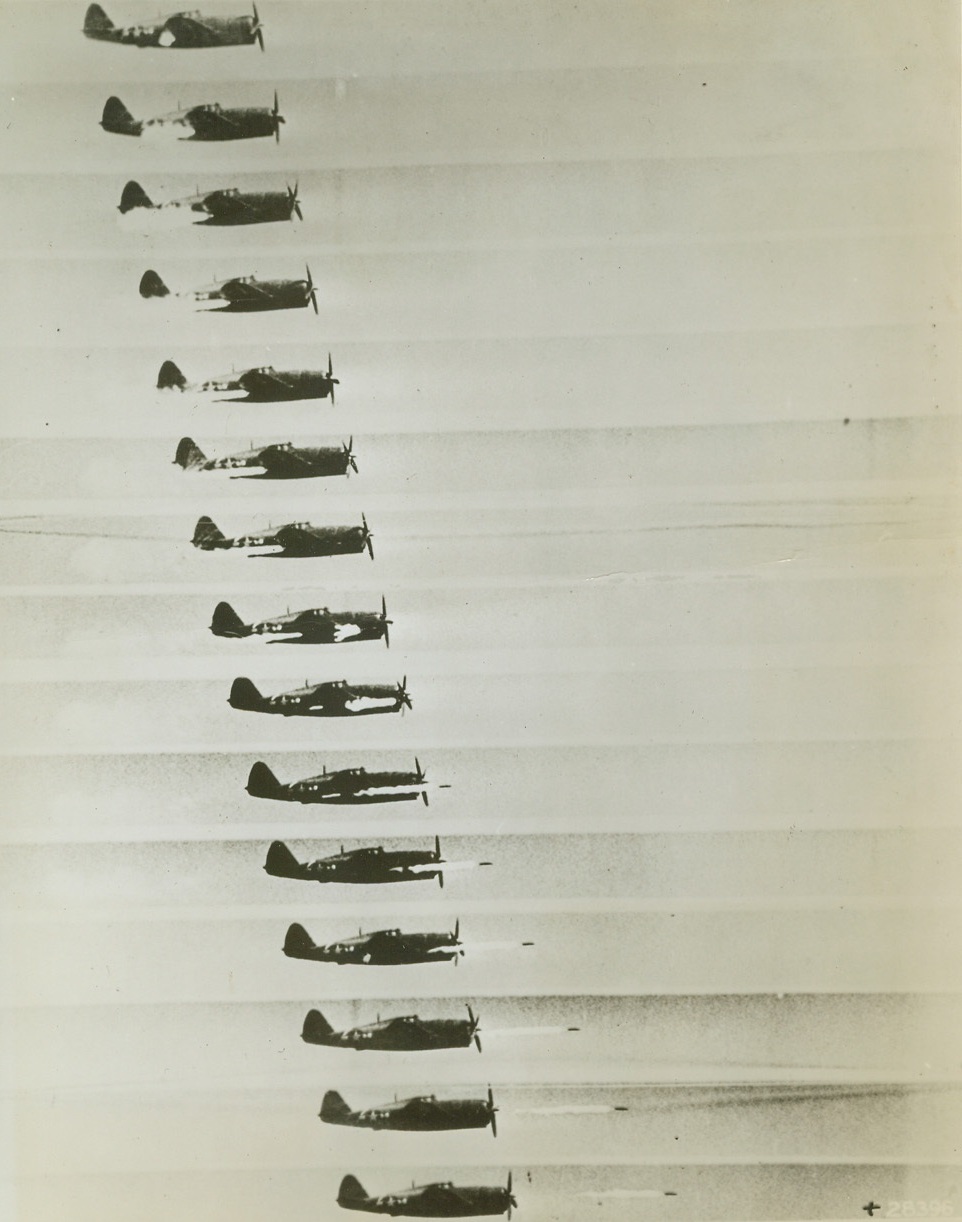
P-47 Sports Super-Armament, 8/1/1944. A deadly weapon of war is this huge P-47 Thunderbolt with its eight .50 caliber machine guns and new rocket gun armament. These high speed photos show the firing of the rocket projectile. The top shows the initial stages of the firing and the succeeding ones follow through until the rocket is shown clear of the plane. Credit (USAAF Photo from ACME);
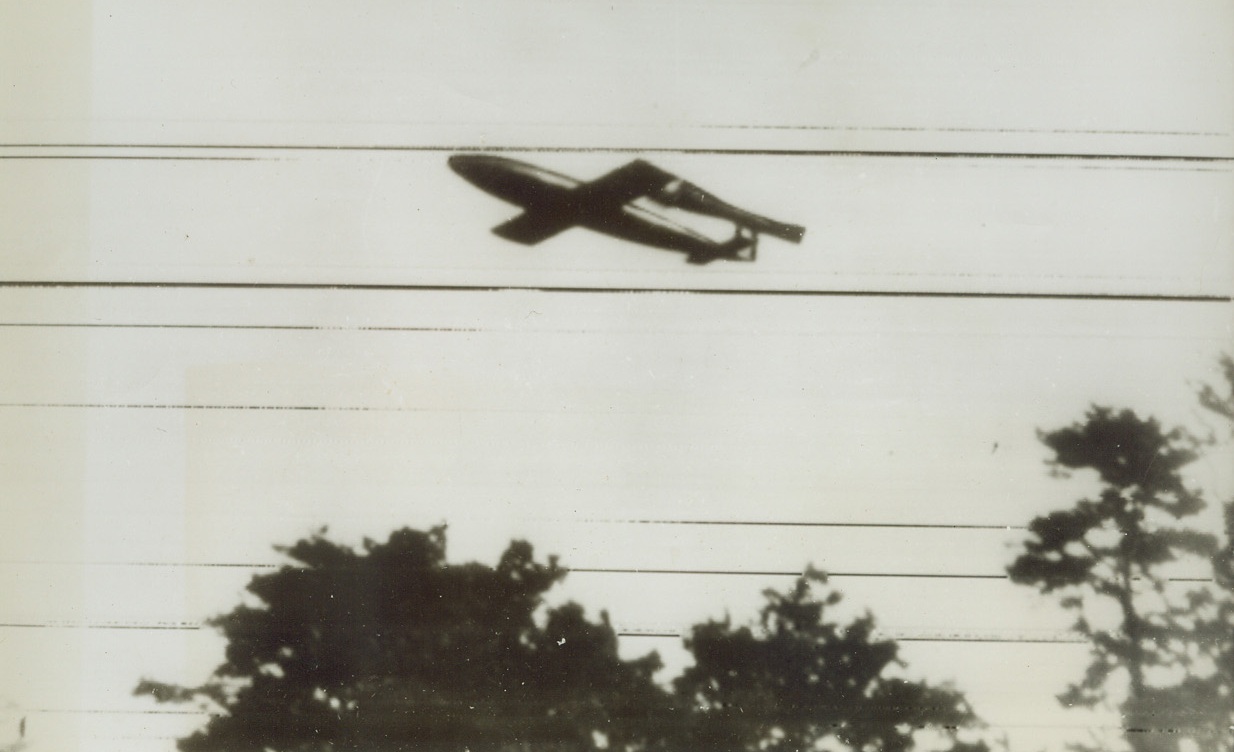
HEADING FOR TROUBLE, 8/9/1944. BERLIN—Out for no good, this Nazi V-1 flying bomb is heading into trouble of its own making as it rattles toward England. Photo radioed to New York from Stockholm today (August 9th). Credit: Acme radiophoto;

THEY FIGHT TO FREE POLAND, 8/23/1944. POLAND—Guerillas of the Polish Home Army, some wearing uniforms taken from ambushed German soldiers, plan an expedition with their commanding officer. Members of Poland’s 9th Infantry Regiment, the partisans operate behind the German lines. Credit: Acme;
![NO TIME FOR NERVOUSNESS, 8/22/1944. AT SEA—Veterans of the Italian and Sicilian campaigns and old timers at the business of invasion, infantrymen of the 45th Division relax before heading into the invasion of southern France. There’s no time for invasion jitters when the blue Mediterranean invites a fighter to take a swim. The boys dive off the [illegible] will soon bring them to the French coast. Credit: Acme photo by Sherman Montrose for the War Picture Pool;](/media/15278/77091879.jpg)
NO TIME FOR NERVOUSNESS, 8/22/1944. AT SEA—Veterans of the Italian and Sicilian campaigns and old timers at the business of invasion, infantrymen of the 45th Division relax before heading into the invasion of southern France. There’s no time for invasion jitters when the blue Mediterranean invites a fighter to take a swim. The boys dive off the [illegible] will soon bring them to the French coast. Credit: Acme photo by Sherman Montrose for the War Picture Pool;
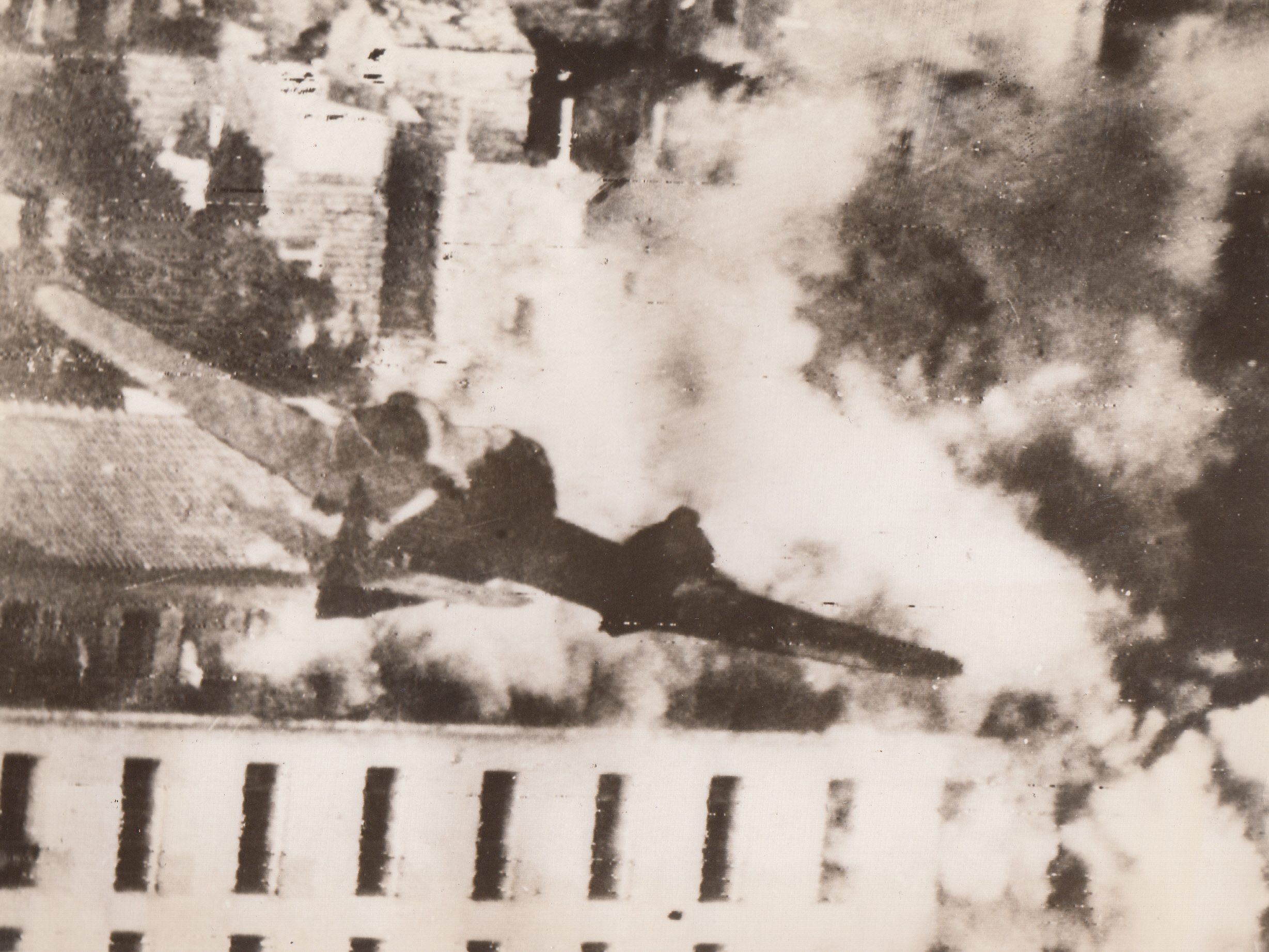
COMING IN A ROOF-TOP LEVEL, 8/22/1944. YUGOSLAVIA—A rocket-carrying Beaufighter of the Balkan Air Force goes in at roof-top level to loose its cargo of destruction on the already smoking building, suspected of being German headquarters, in Dubrovnik, Yugoslavia.;
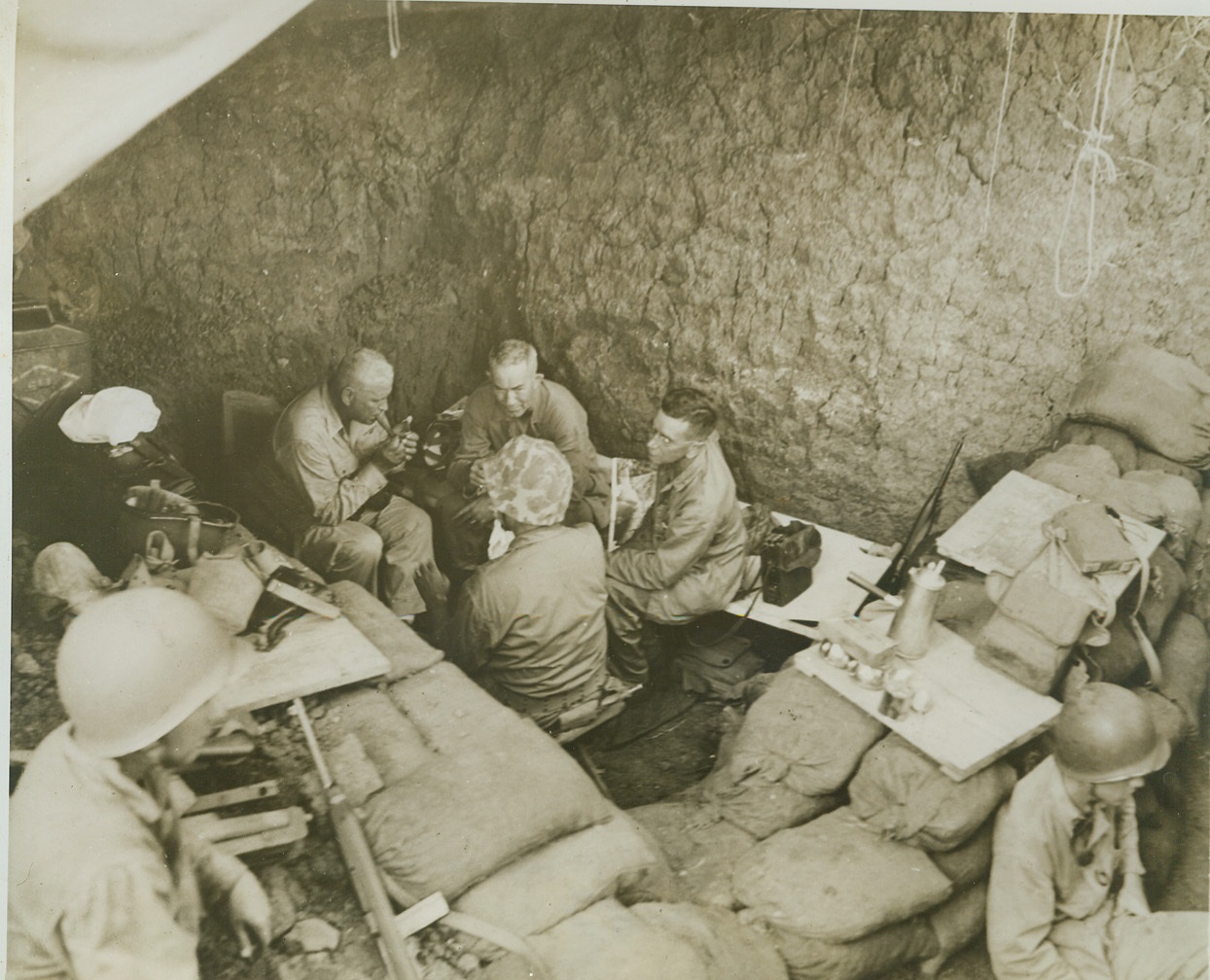
Underground Guam Command Post, 8/22/1944. GUAM -- In this super foxhole turned into a command post on Guam, Maj. Gen. Roy S. Geiger (left), commander of Third Marine Amphibious Corps, confers with Maj. Gen. Allen H. Turnage, USMC. Sand bags and alert sentries furnish additional protection against possible Jap interruption of this battlefront strategy huddle. Credit (Marine Corps Photo from ACME);
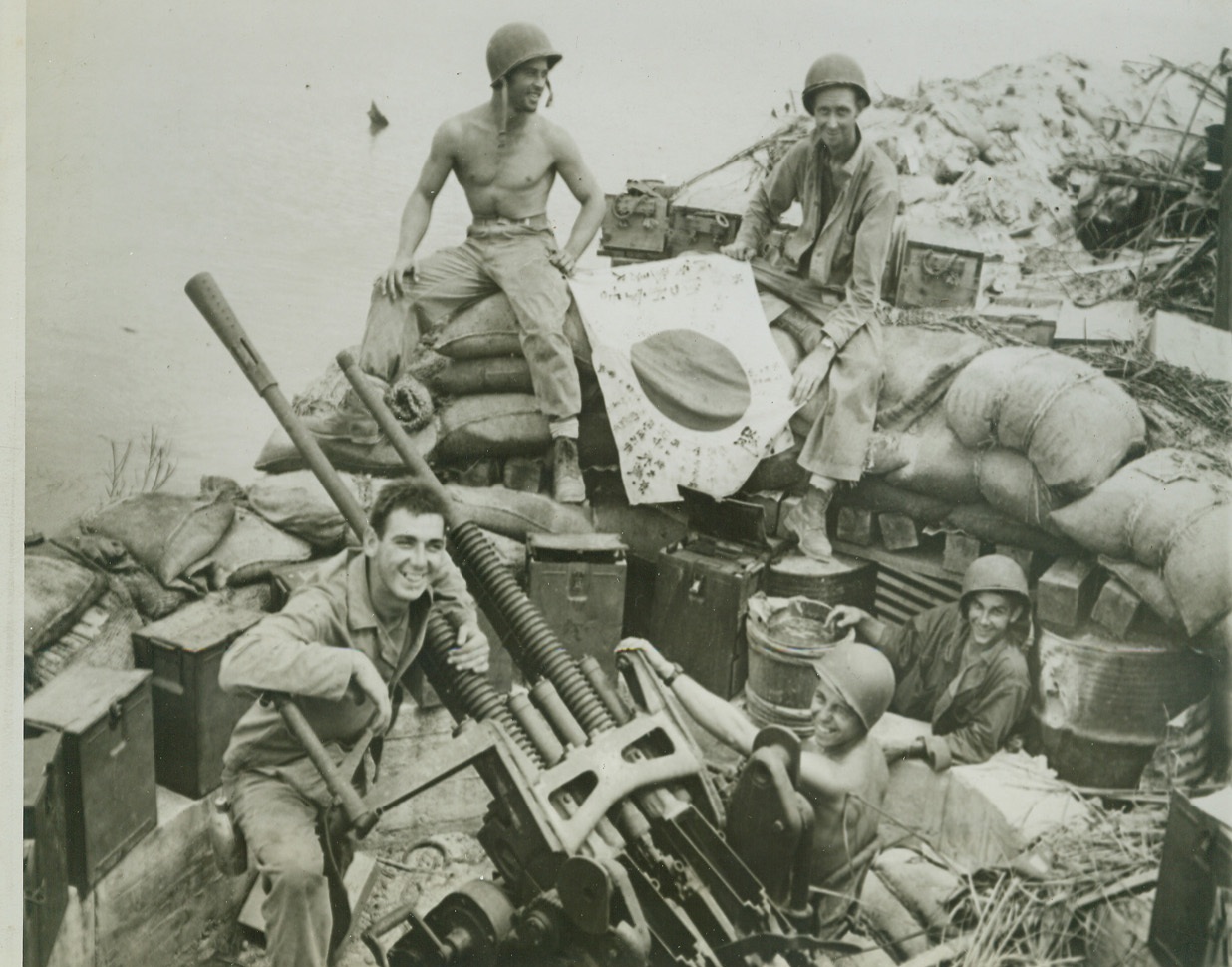
Jap Gun on Guam a Yank Prize, 8/2/1944. GUAM -- Useless now except as a memento of action gone by is this captured Jap gun taken during the American assault of Piti, Jap Naval station at Guam. In the gun pit are Sgt. Joe A. Grimes, Groesbeck, Tex. (rear, left) and Cpl. James W. Redding, (rear, right), Atlanta, Ga., examining a Jap flag, while (left to right, front) Pfc. Joe Woolsey, Jerseyville, Ill.; Pfc. Warren Jordan, Newark, N.J.; and Pfc. Joe Gilles, LaCrosse Wis., exhibit the gun. Credit- WP-(ACME);
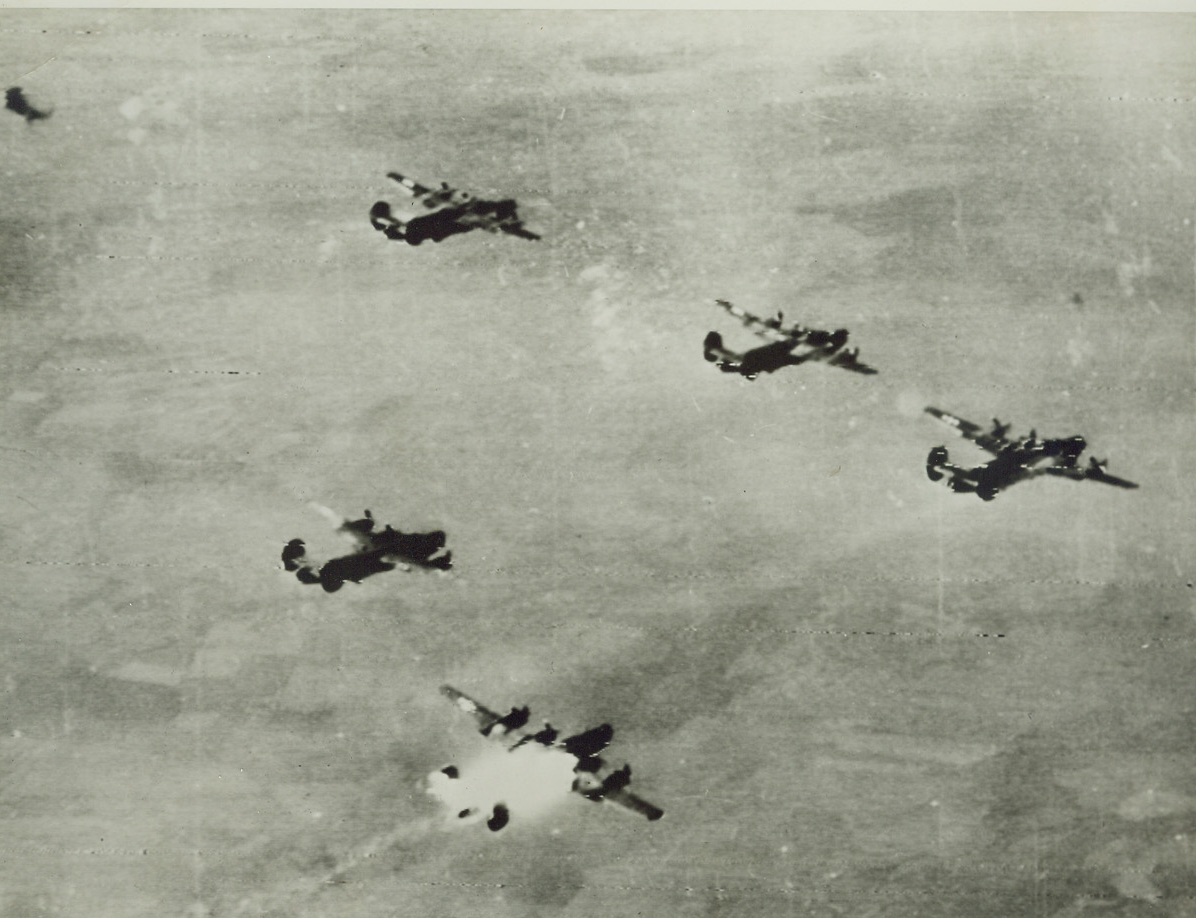
A Liberator is Lost, 8/8/1944. A B-24 Liberator of the U.S. 15th Air Force bursts into flames after it was hit by enemy fire during a raid on the North Oil refinery at Blechhammer, Germany. Three crew members were seen to escape by parachute before the plane disintegrated in midair. Credit Line (Army Radiotelephoto from ACME);

It’s A Great Day for Grenoble, 8/28/1944. GRENOBLE, FRANCE – Swarming from their homes into the street to welcome Americans of the 7th Army who liberated their town, citizens of Grenoble crowd around the armored vehicles in enthusiastic greeting to the Yank forces. Credit (ACME Radiophoto via OWI);
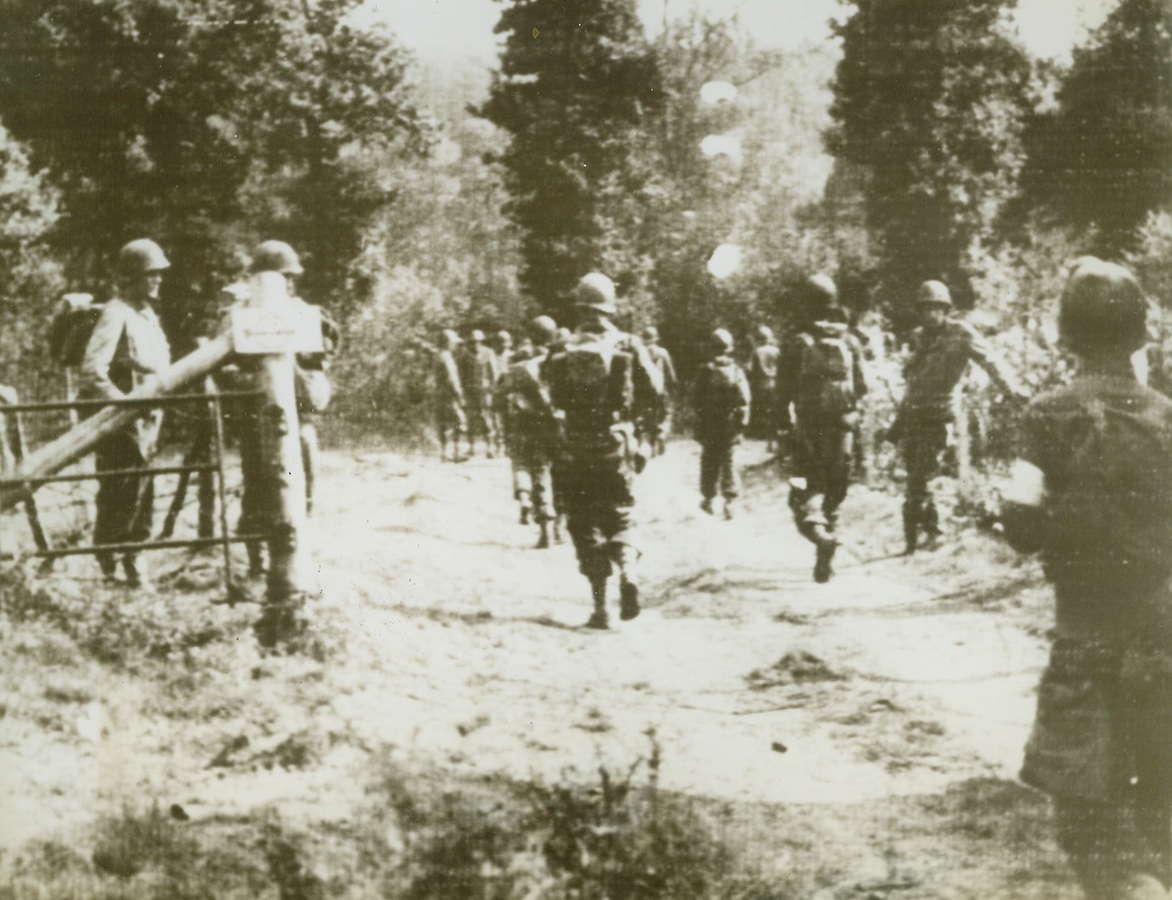
Yanks Skirt Aachen, 8/17/1944. GERMANY – Moving across the border from Belgium, Yanks advance up a road leading to Aachen Staat forest in Germany. American forces have entered the town proper and the Germans are engaging in a desperate house-to-house fight against overwhelming odds. Credit (Signal Corps Radiotelephoto from ACME);
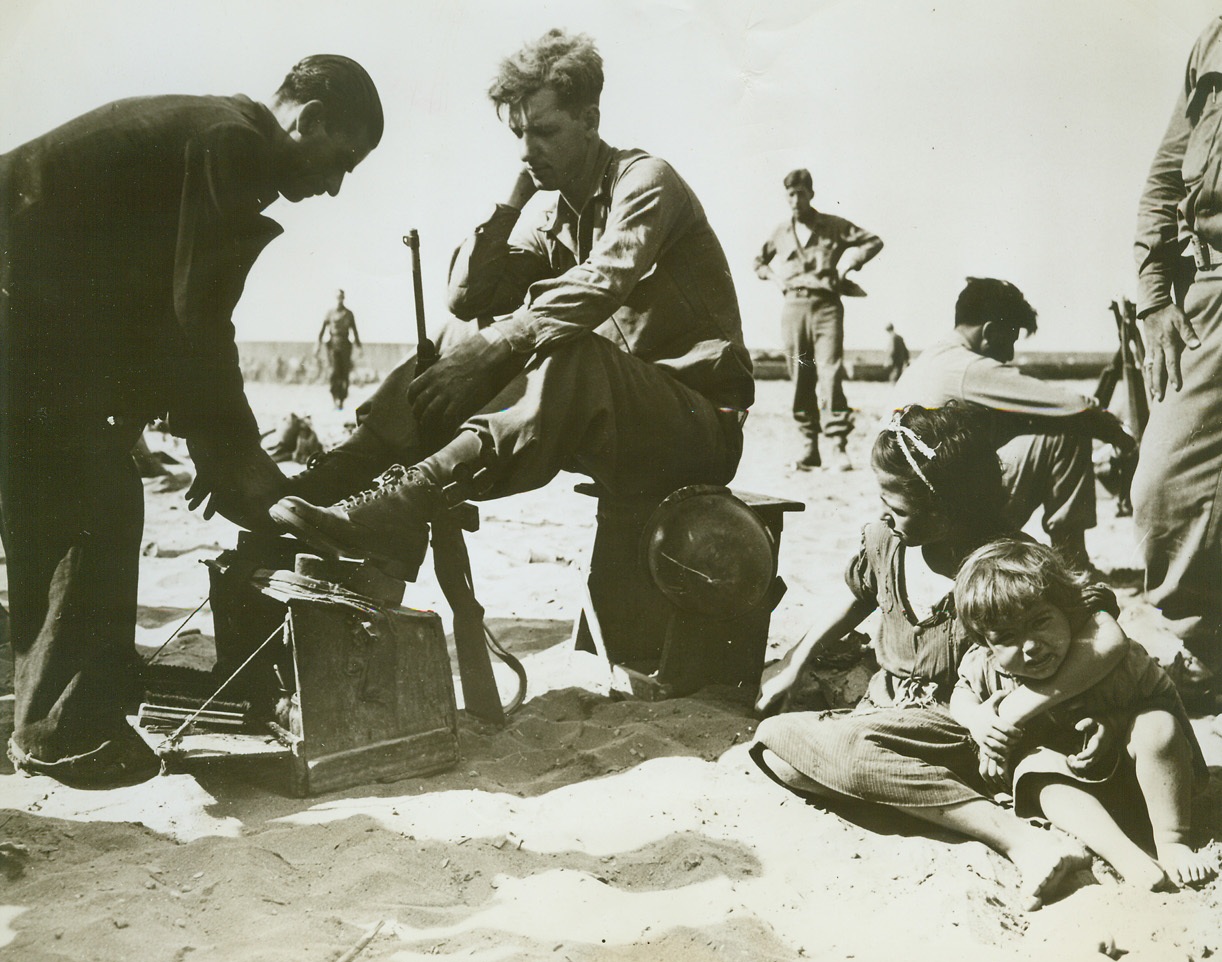
Polishing Up for Invasion of “Fashion Center”, 8/19/1944. ITALY – All set for style-conscious France is Pfc. James P. Royle, Boston, Mass., getting a last minute shoeshine before shoving off from an Italian port for the invasion of Southern France. Credit (Signal Corps Photo from ACME);
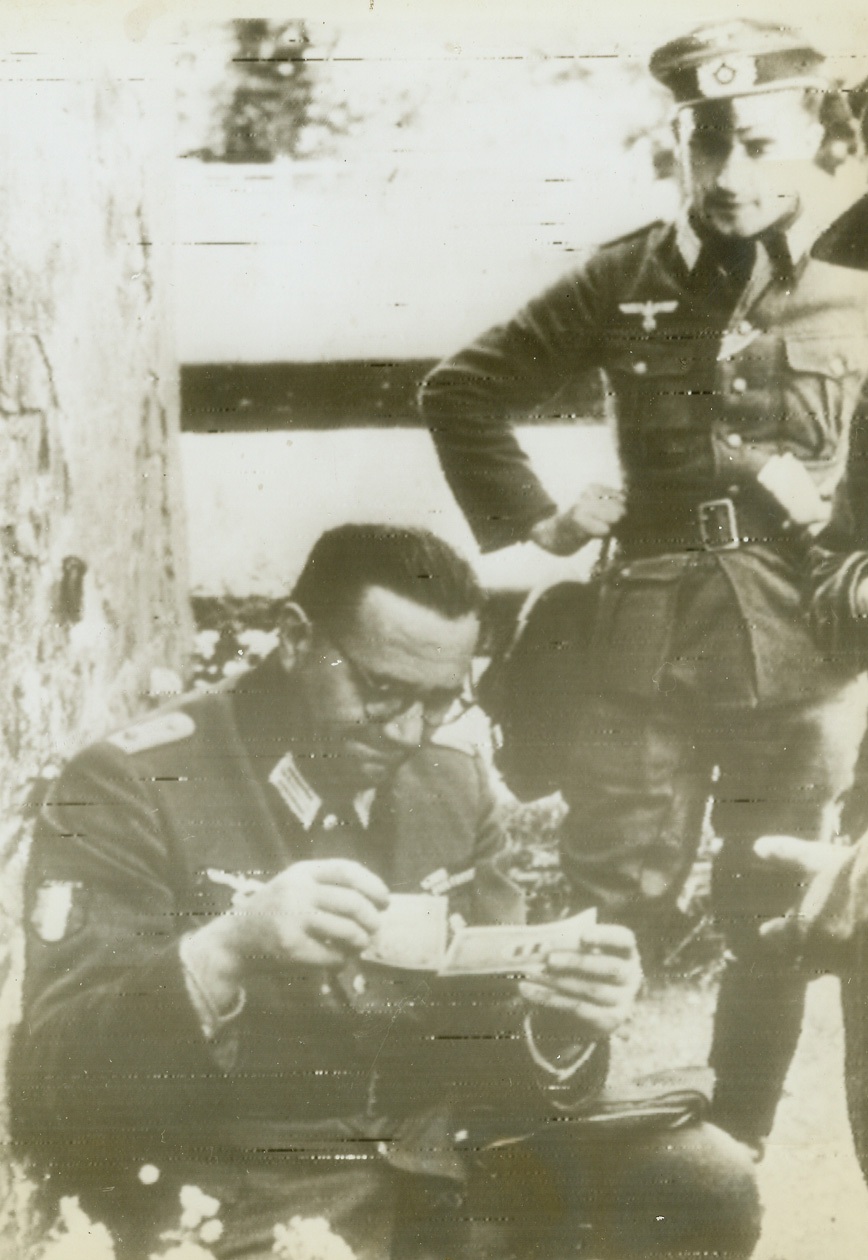
“Roosevelt’s Fake Money”, 8/4/1944. According to the German caption accompanying this photo, radioed today from Stockholm, Jacques Doriot, French Nazi leader attired in German uniform, examines invasion francs, dubbed by the German caption “Roosevelt’s fake money.”Credit (ACME Radiophoto);

Gateway to Florence, 8/14/1944. FLORENCE, ITALY – Passing through the Porta Romano, a South African tank unit enters the city of Florence, hub of the Germans last defense line in Italy. British 8th Army troops have cleaned out the last Nazi resistance pockets, and AMG officials have taken over. Credit Radiotelephoto from ACME);
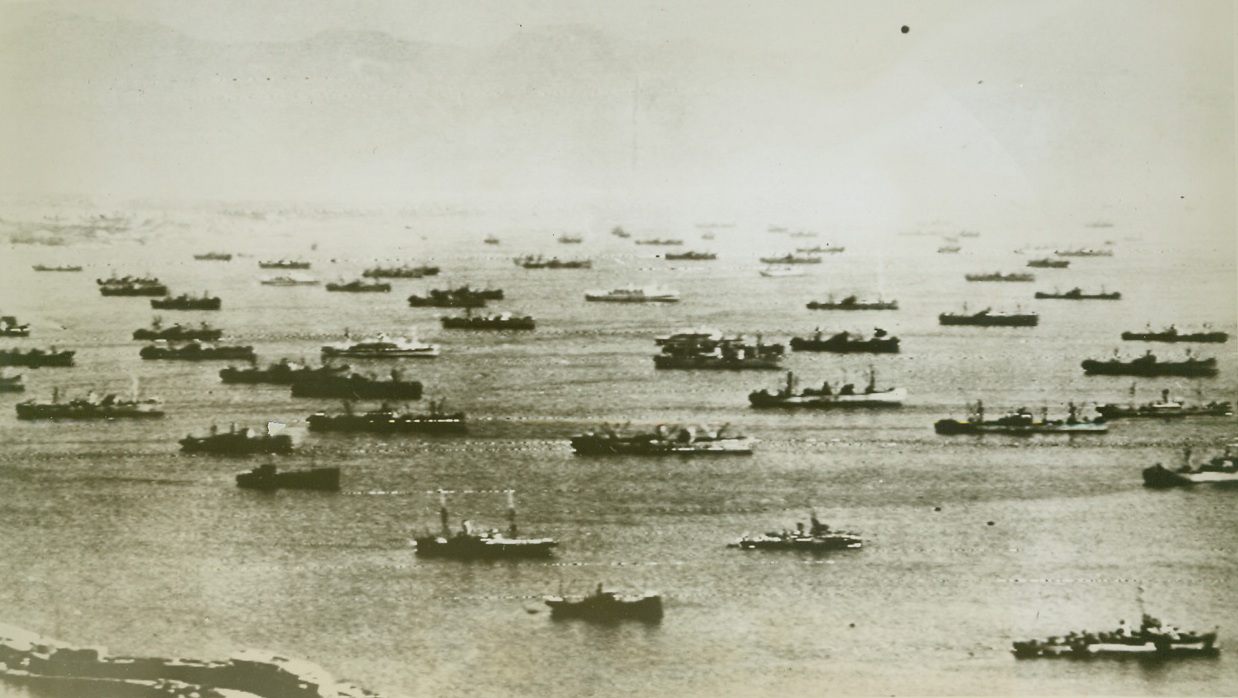
Headed for Southern France, 8/15/1944. Flashed to the U.S. today by Radiotelephoto as the invasion of Southern France was announced this photo shows approximately 75 ships assembled at a port in Southern Italy, ready to leave for the new invasion. Credit Line (Army Radiotelephoto from ACME);
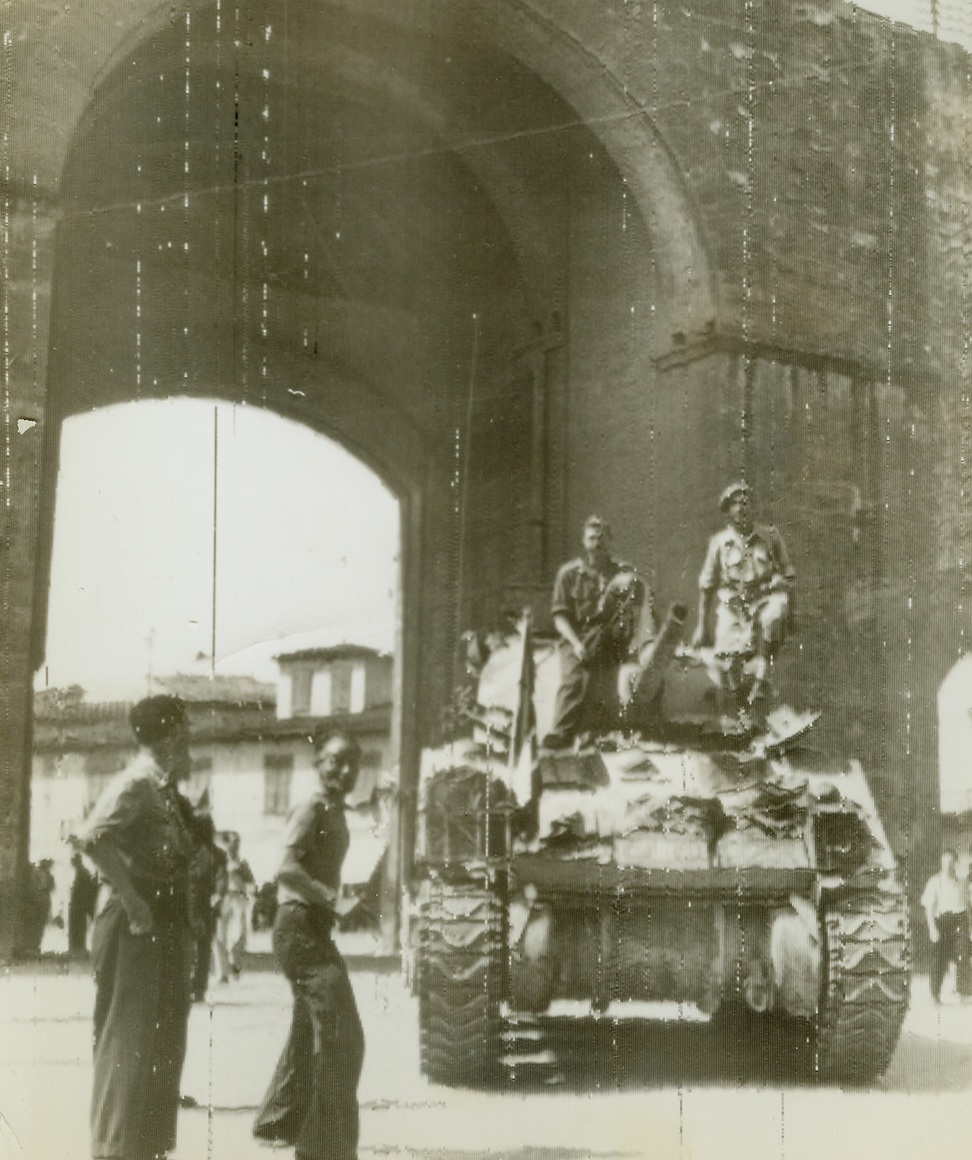
British Tank Enters Florence, 8/8/1944. FLORENCE, ITALY – Crewmen stand atop their British tank as it enters Florence through the Porta Romano. It is manned by soldiers of the South African unit of the British 8th Army, which were first to enter Florence.Credit (British Official Radiotelephoto via OWI from ACME);
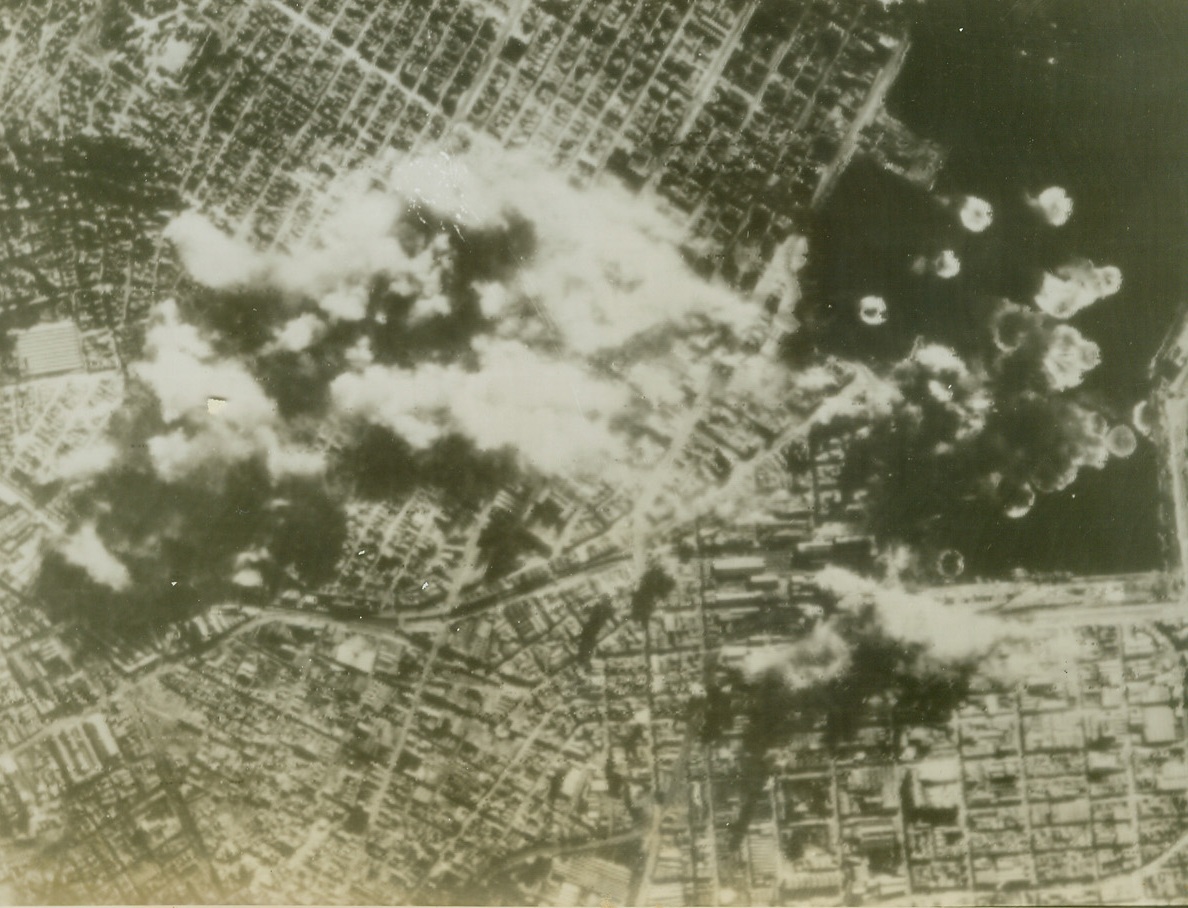
U.S. Bombers Slug Port of Athens, 8/15/1944. ATHENS, GREECE – Smoke shrouds the already battered dock area of Athens as U.S. Flying Fortresses bomb the vital Nazi supply center, on January 11th. Bomb-bursts dot the harbor waters as the B-17’s of the 15th United States Army Air Force wing over their target. Credit (U.S. Army Air Force Photo Via OWI Radiophoto from ACME);
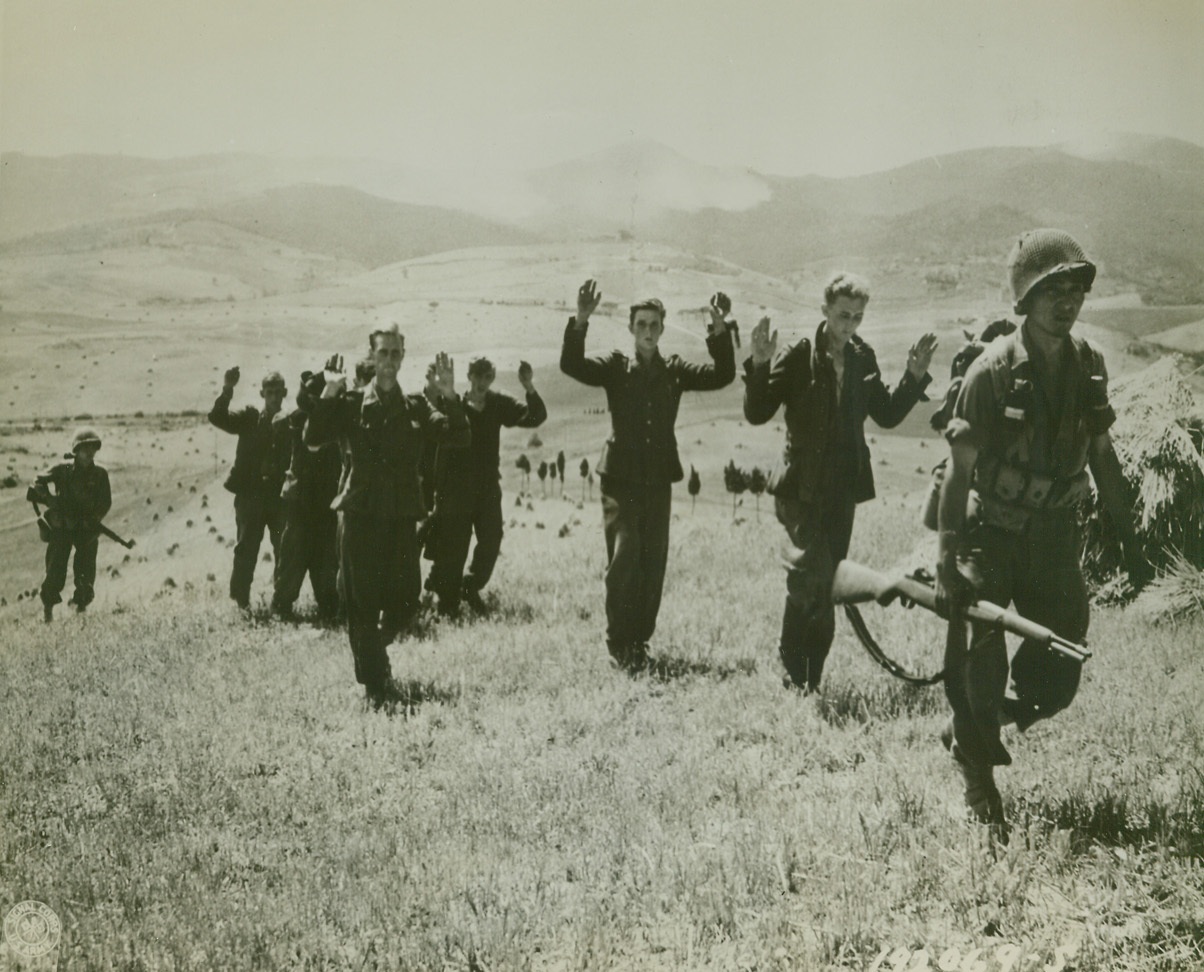
Hands Up – Give Up, 8/7/1944. ORCIANO, ITALY – Holding their hands high, German storm troopers follow their American captors after a short but sharp exchange of fire in the Orciano area. The enemy warriors surrendered to the riflemen of the 100th Infantry Battalion – Americans of Japanese ancestry. Credit Line (Official U.S. Army Photo from Acme);
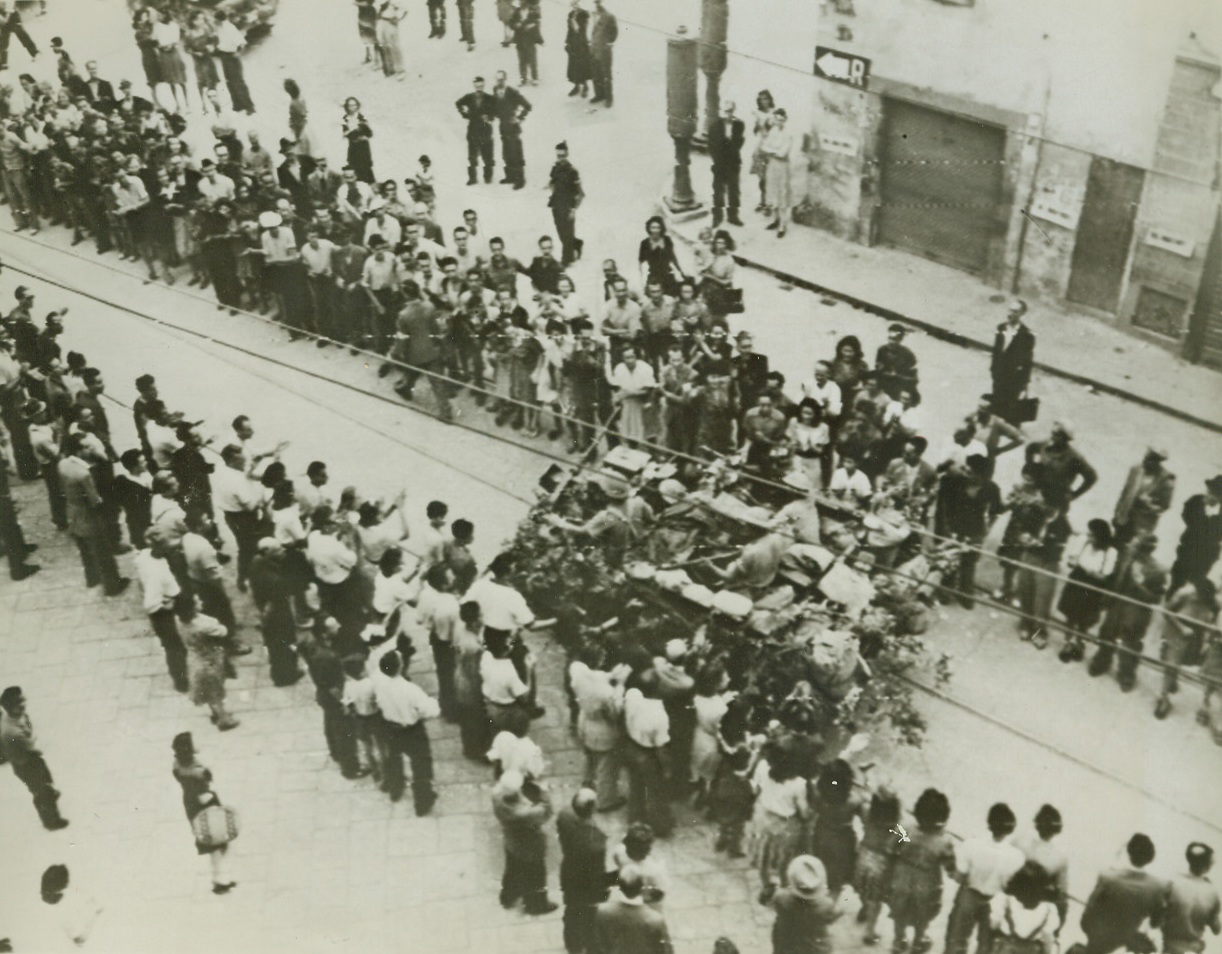
Florentines Cheer Allied Heroes, 8/7/1944. FLORENCE, ITALY – Joyous, cheering throngs line the route as Allied troops make their victorious entry into the southern outskirts of Florence. A vehicle of the South African armored force passes down the aisle formed by applauding, waving natives.Credit (Signal Corps Radiotelephoto from Acme);
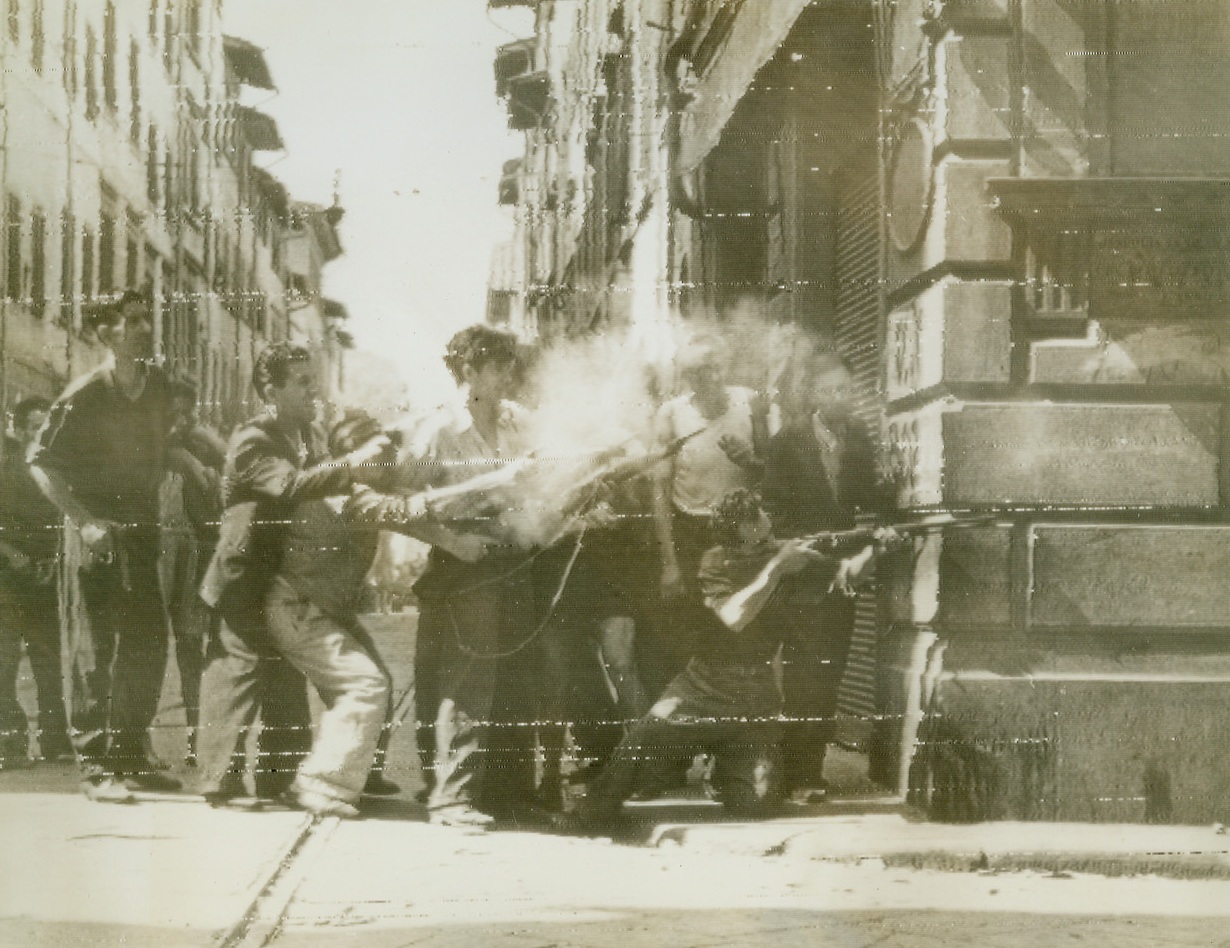
Street Fighting in Florence, 8/8/1944. FLORENCE, ITALY – As units of the South African troops of the British 8th Army enter the outskirts of Florence, hub of the Germans last defense line in Italy, anti-fascists lean out from the shelter of a building and fire around a street corner at German forces within the city. These civilians have given great aid in stemming the fighting of German and Fascist snipers.Credit (British Official Radiophoto via OWI from Acme);
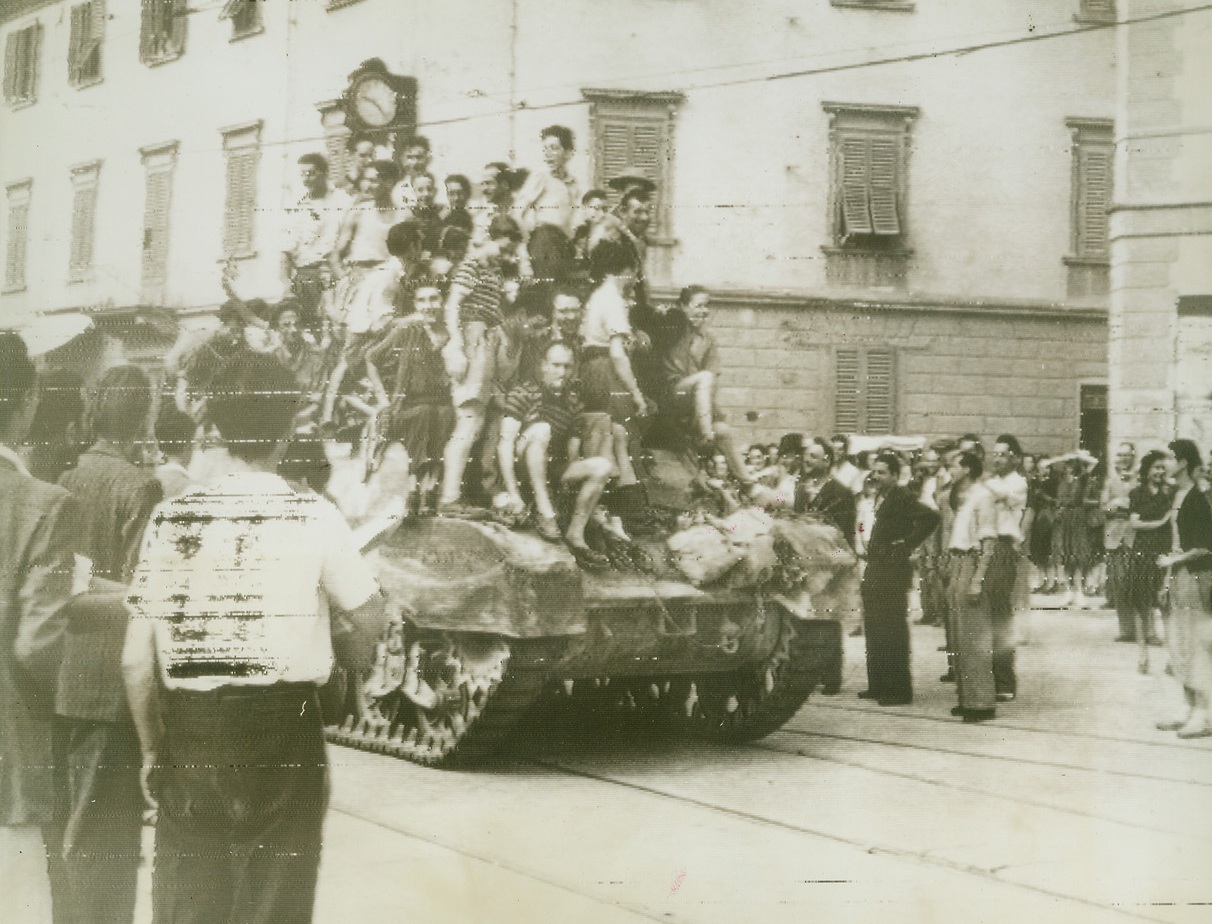
Florentines Welcome British Army, 8/8/1944. FLORENCE, ITALY – Jubilant youngsters jump atop a British tank as the people of Florence fill the streets to welcome a unit of the British 8th Army entering the city’s outskirts. Clock in the background reads 9:25. Credit (British Official Radiophoto via OWI from Acme);
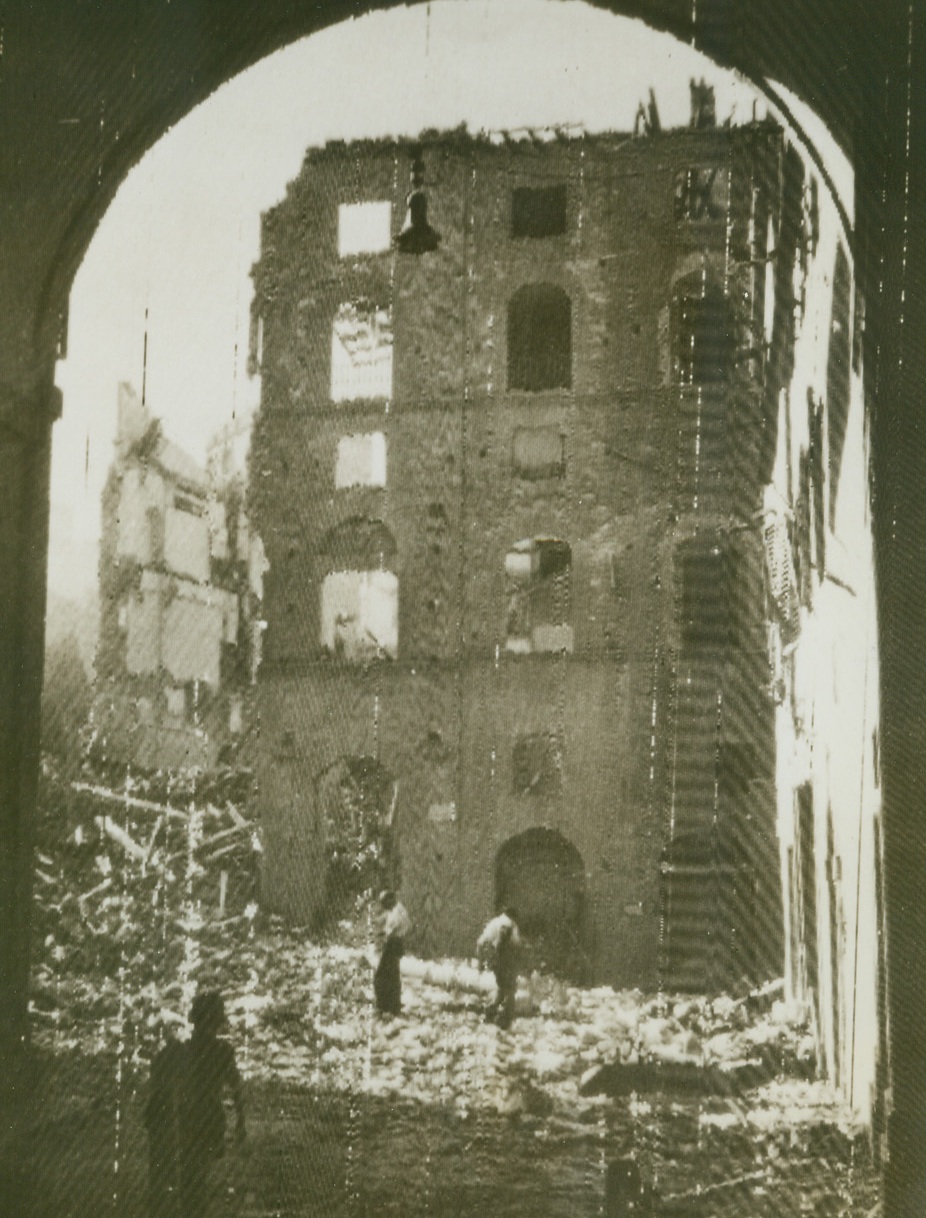
Wrecked Houses in Florence, 8/9/1944. Natives comb through the ruins of buildings in the once-beautiful art center of Florence, after Nazis had abandoned this section of the Italian city. Some of Florence still is in Nazi hands.Credit Line (OWI Radiophoto from Acme);
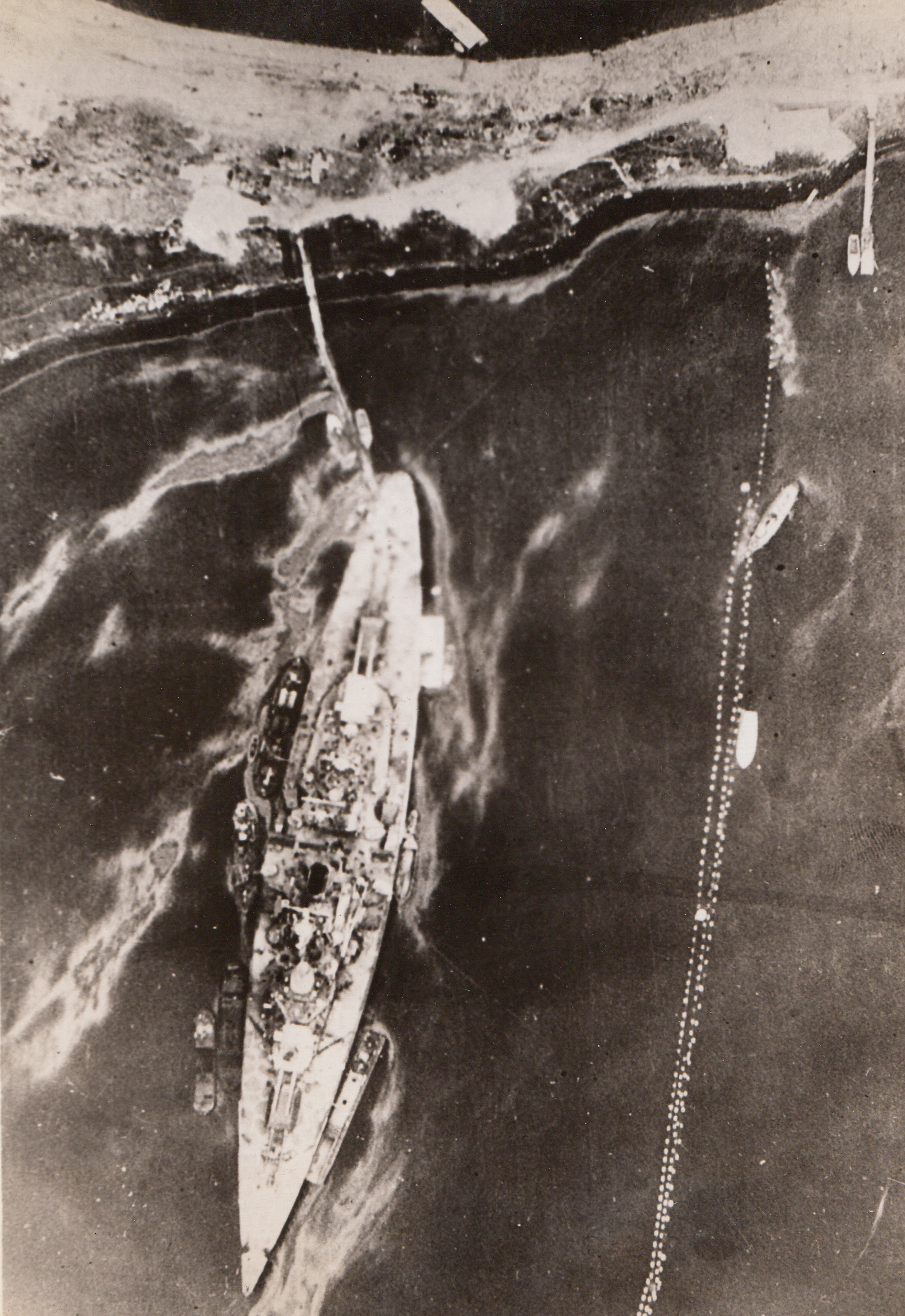
Twice-Damaged Tirpitz, 8/12/1944. NORWAY – This recent photo of the Tirpitz at her moorings in Kaafjord, Norway, was taken by an RAF reconnaissance plane of the Coastal Command. The ship was damaged in Kaafjord on two occasions, once by British submarines on Sept. 22, 1944, and again by Fleet Air Arm attack on April 3, 1944. Some of the damage has evidently been repaired, but the starboard boat and aircraft crane are missing.;

Jap-Americans Fight in Italy, 8/14/1944. ITALY – Proving their loyalty on the battle front are these two Jap-Americans fighting in Italy. Combing for snipers, Pvt. Veikichi Arakaki, from Koloa Kauai, T.H. (Hawaii), and a buddy at left, fire rifle grenades into the hills. Bursts can be seen on the hillside.Credit (Signal Corps Radiotelephoto from Acme);
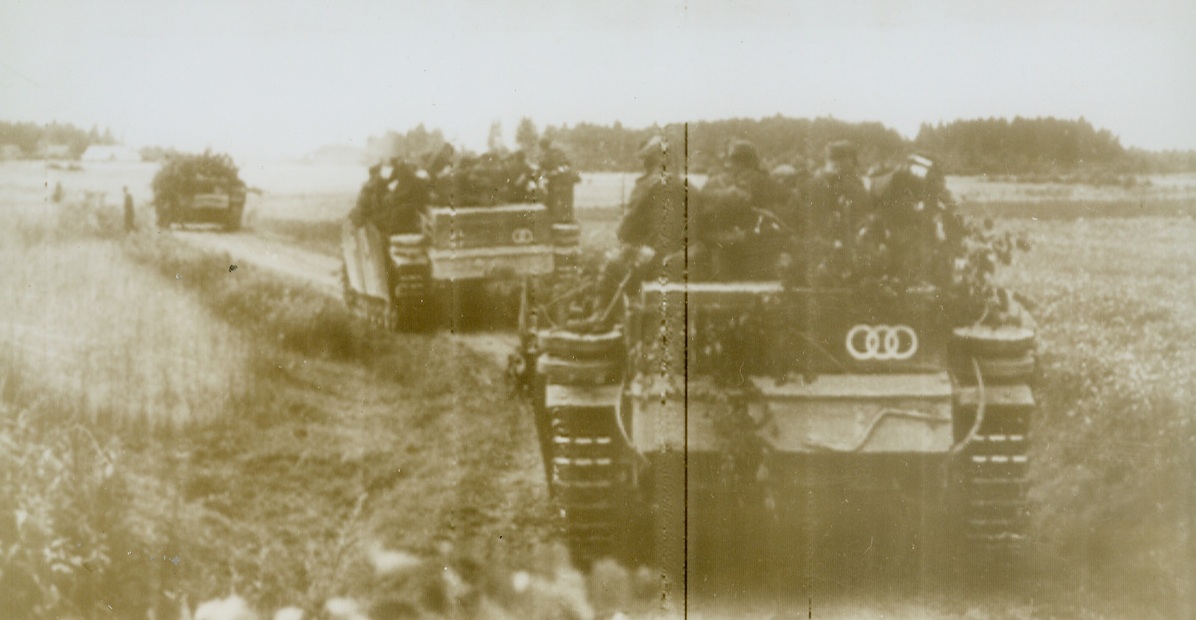
Tank Evacuation for German Soldiers, 8/22/1944. According to the German caption accompanying this photo, radioed from Stockholm today (August 22), the picture shows “a defense battle on the east front.” It actually shows tanks being used to transport German soldiers in their retreat from the front.Credit (Acme Radiophoto);
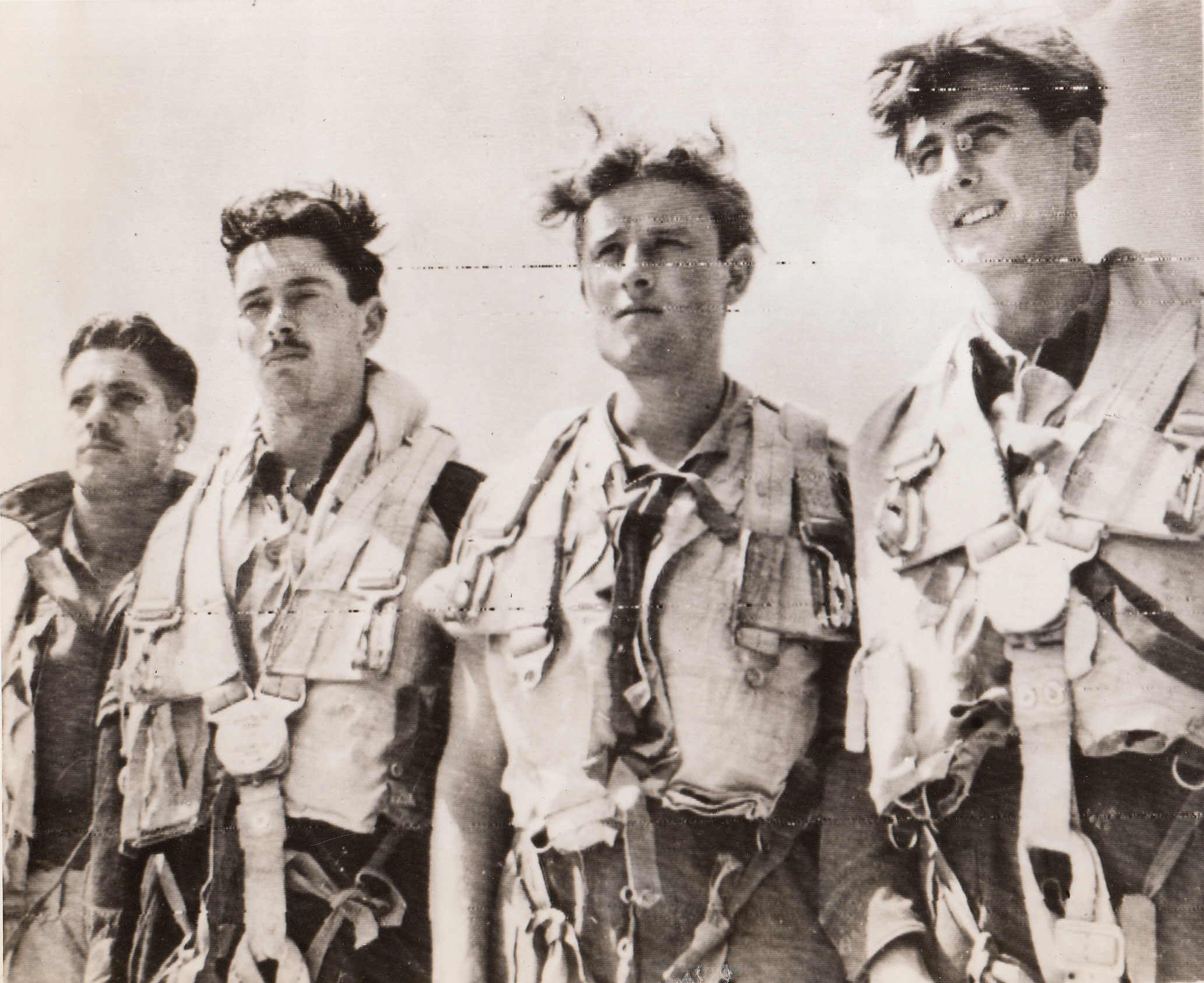
Flew Supplies to Warsaw Patriots, 8/23/1944. ITALY – Back at their base in Italy are these four members of an RAF Liberator crew who recently flew from Italy to Warsaw and back to drop supplies to patriots battling the Nazis in the Polish capitol. They are (left to right): F/S Kenneth Pearce, Sgt. Peter Green, Sgt. Derek Coates, and Sgt. John Rush.;
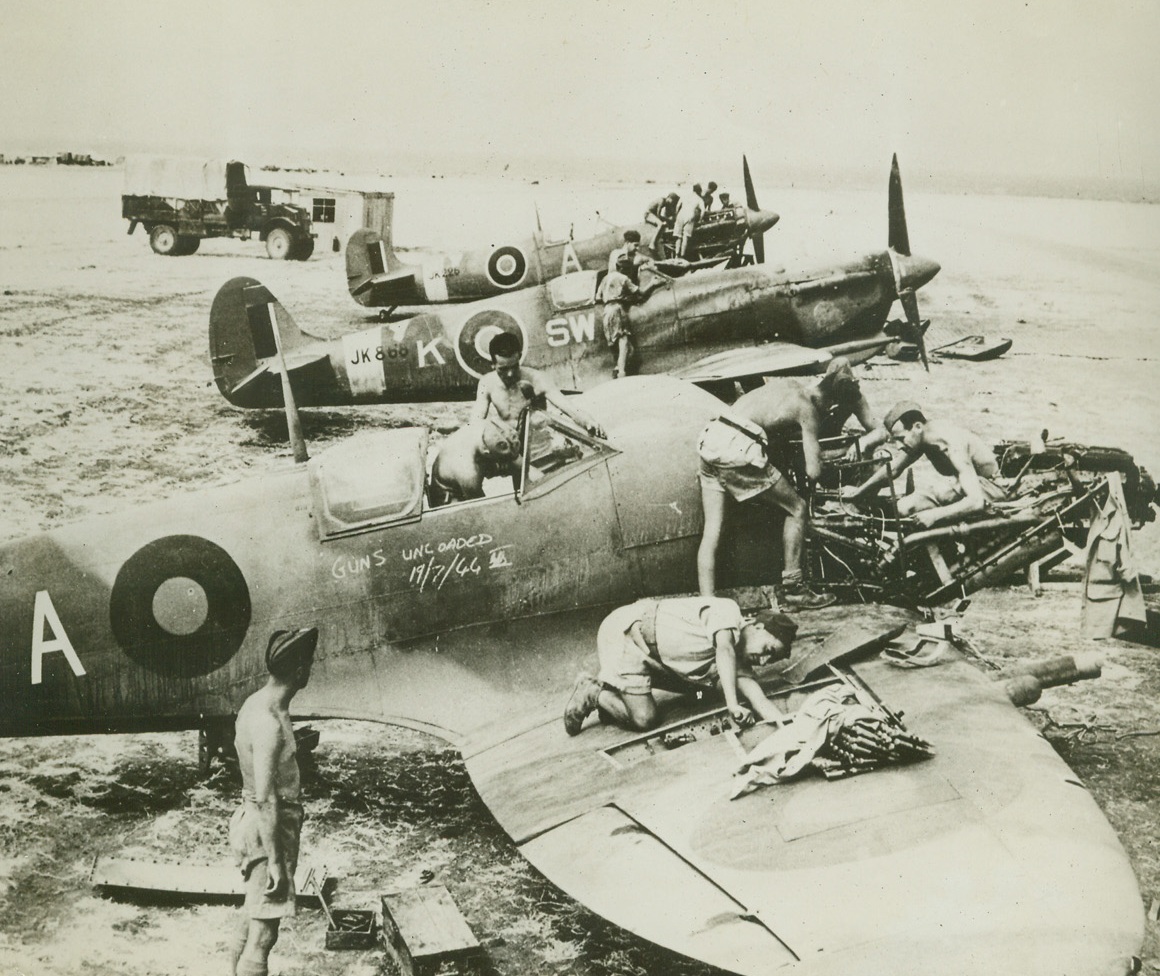
Partisans Learn Plane Mechanics, 8/18/1944. ITALY – In Liberated Italy a specially selected group of Marshal Tito’s Yogoslav Partisan Army is being trained along with RAF ground crews in the intricacies of modern airplane mechanics. All the men have been chosen for particular abilities. Their teachers are RAF non-coms. Photo shows Partisans and men of the Royal Air Force hard at work on a trio of Spitfires.Credit (British Official Photo from Acme);
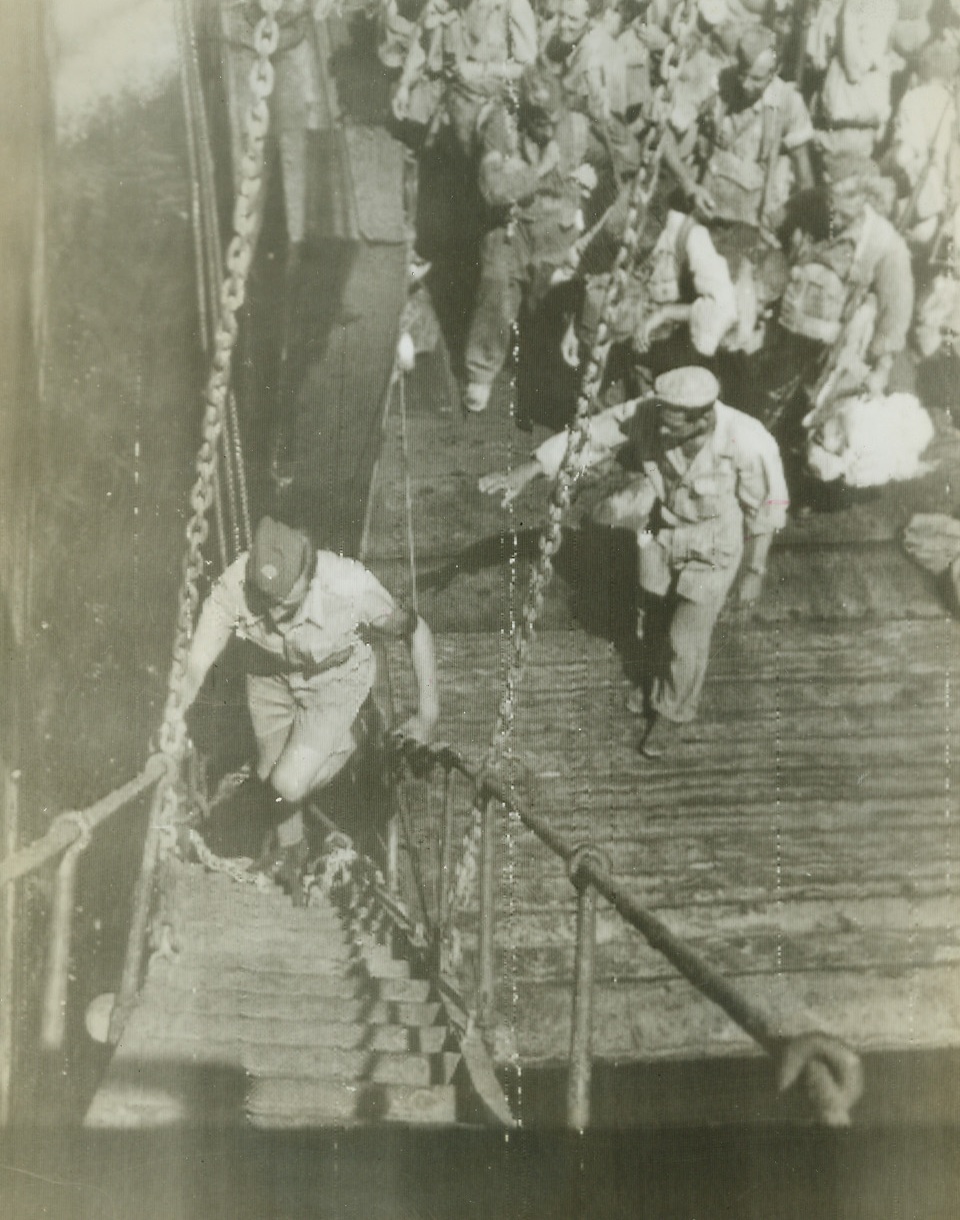
On Their Way to France, 8/15/1944. ITALY – Walking up the gang-plank as his comrades wait their turn on the dock below, a ground crew member of the Royal Air Force boards a vessel at an Italian port headed for the new invasion front in southern France.Credit (OWI Radiophoto from Acme);

Enemy Mines Go Up, 8/7/1944. LEGHORN, ITALY – Taking cover behind a tank, Cpl. Duane T. Moen, Minneapolis, Minn., is on the alert for snipers as his Fifth Army buddies set off mines sowed heavily in one of the main streets leading to Leghorn harbor. A giant column of smoke rises in background as the mines blow up.Credit Line (Official U.S. Army Photo from Acme);

Polish Patriots on Parade, 8/23/1944. POLAND – After church services celebrating Poland’s National Day (May 3rd), Polish guerilla fighters troop past their colors in a town 120 miles southwest of Warsaw. The patriots are members of the Nrubieszow (Podleze) battalion of their country’s home army. Photo obtained through a neutral source.Credit Line (Acme);
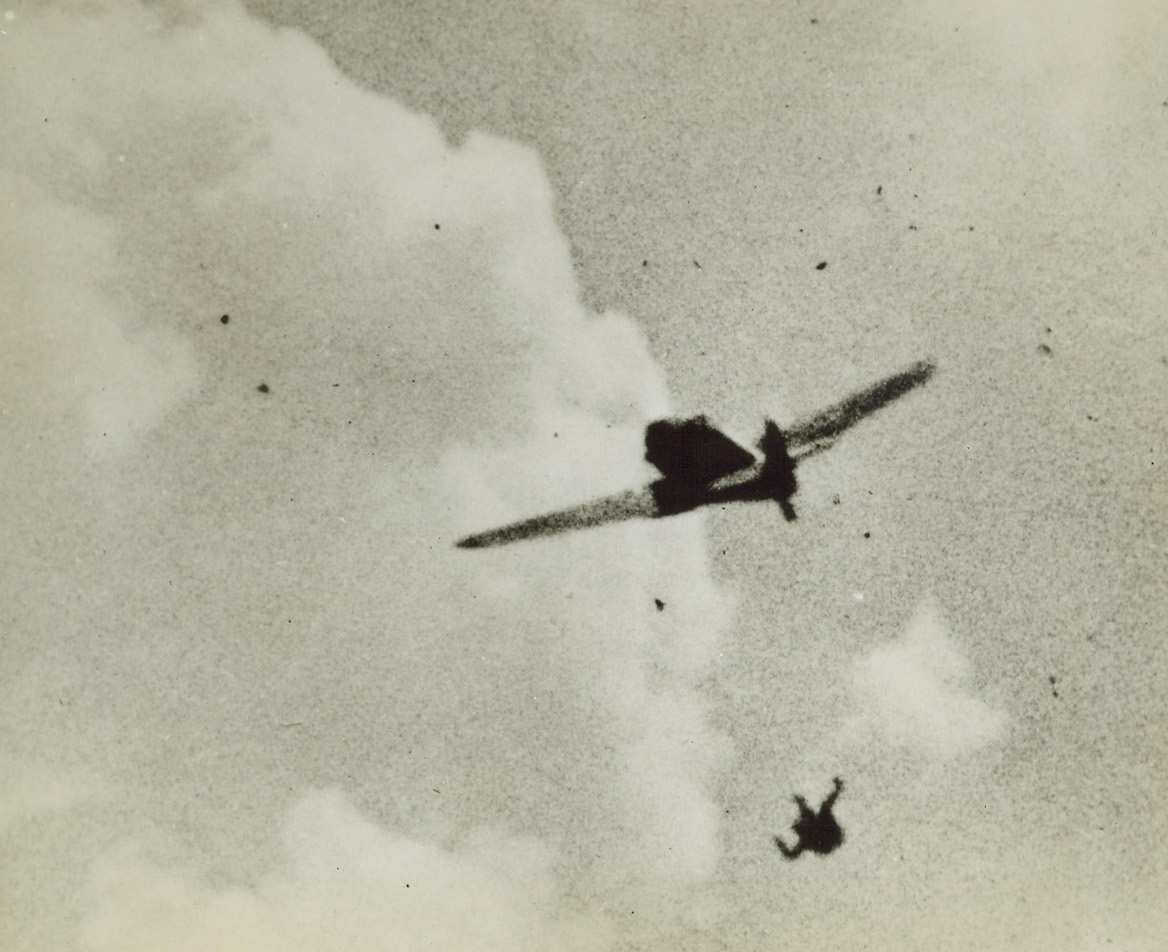
Nazi Hits the Silk, 8/23/1944. Arms and legs all akimbo, a Luftwaffe fighter pilot tumbles earthward, his plane flying on, still level, without him. A U.S. Army 8th Air Force fighter pilot attacked the enemy craft somewhere over France and although the plane seems unharmed, the pilot, unnerved by hits Yank scored, baled out.Credit (USAAF Photo from Acme);

Bridge Florence Canal in Record Time, 8/19/1944. ITALY – Working with terrific speed, men of the Royal Engineers astounded the people of Florence by replacing the destroyed Ponte San Trinita with a Bailey Bridge in record time. Bridge was built on the piers of the wrecked span. Except for a few entrenched Nazi snipers, the ancient city is now completely in Allied hands. Photo by British Army Film Unit. Credit (OWI Radiophoto from Acme);
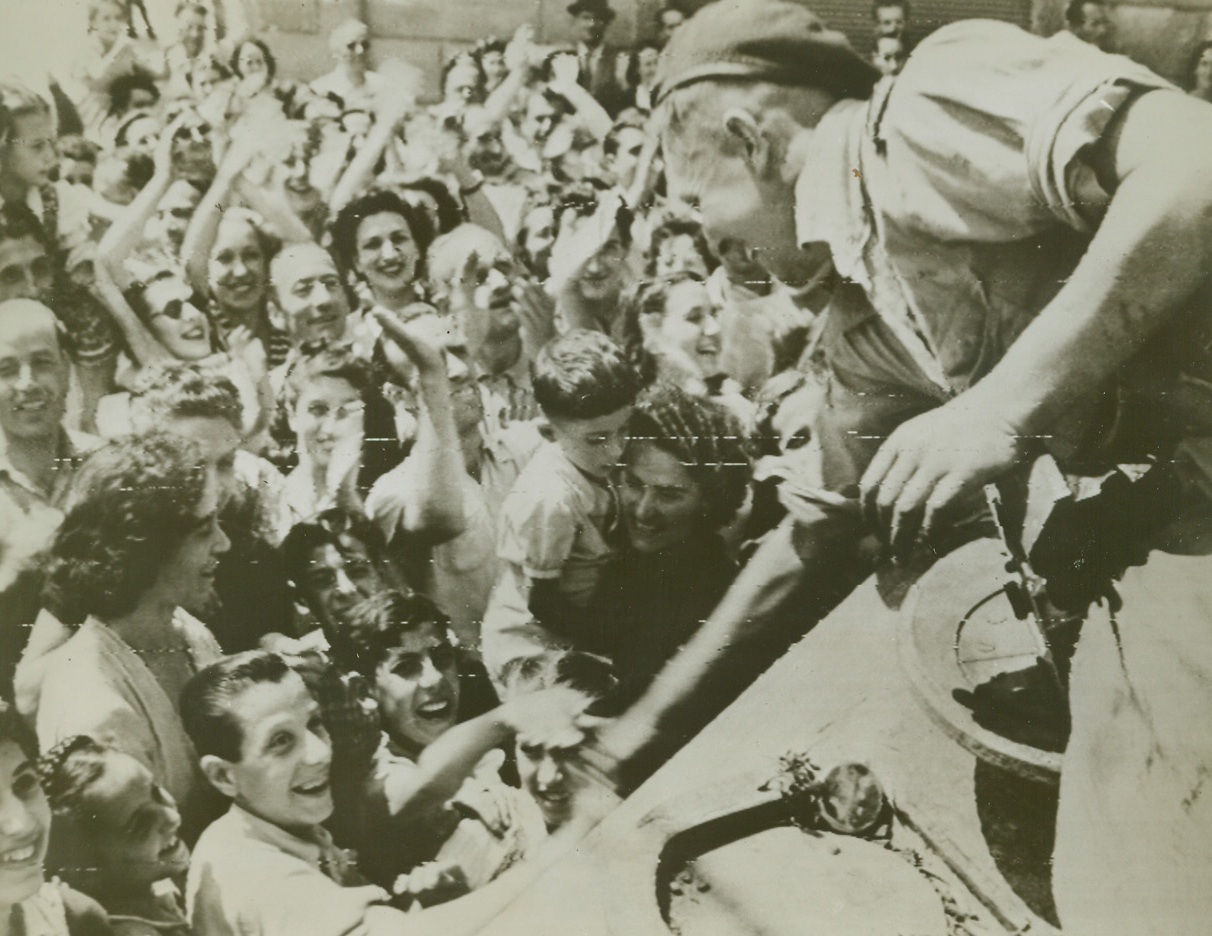
Welcome to Florence, 8/7/1944. FLORENCE, ITALY – Waving and smiling their greetings to the Allied Liberators, joyous Florentines welcome victorious troops at the southern outskirts of their city. A member of a South African tank crew leans down to shake friendly hands.Credit (Signal Corps Radiotelephoto from Acme);
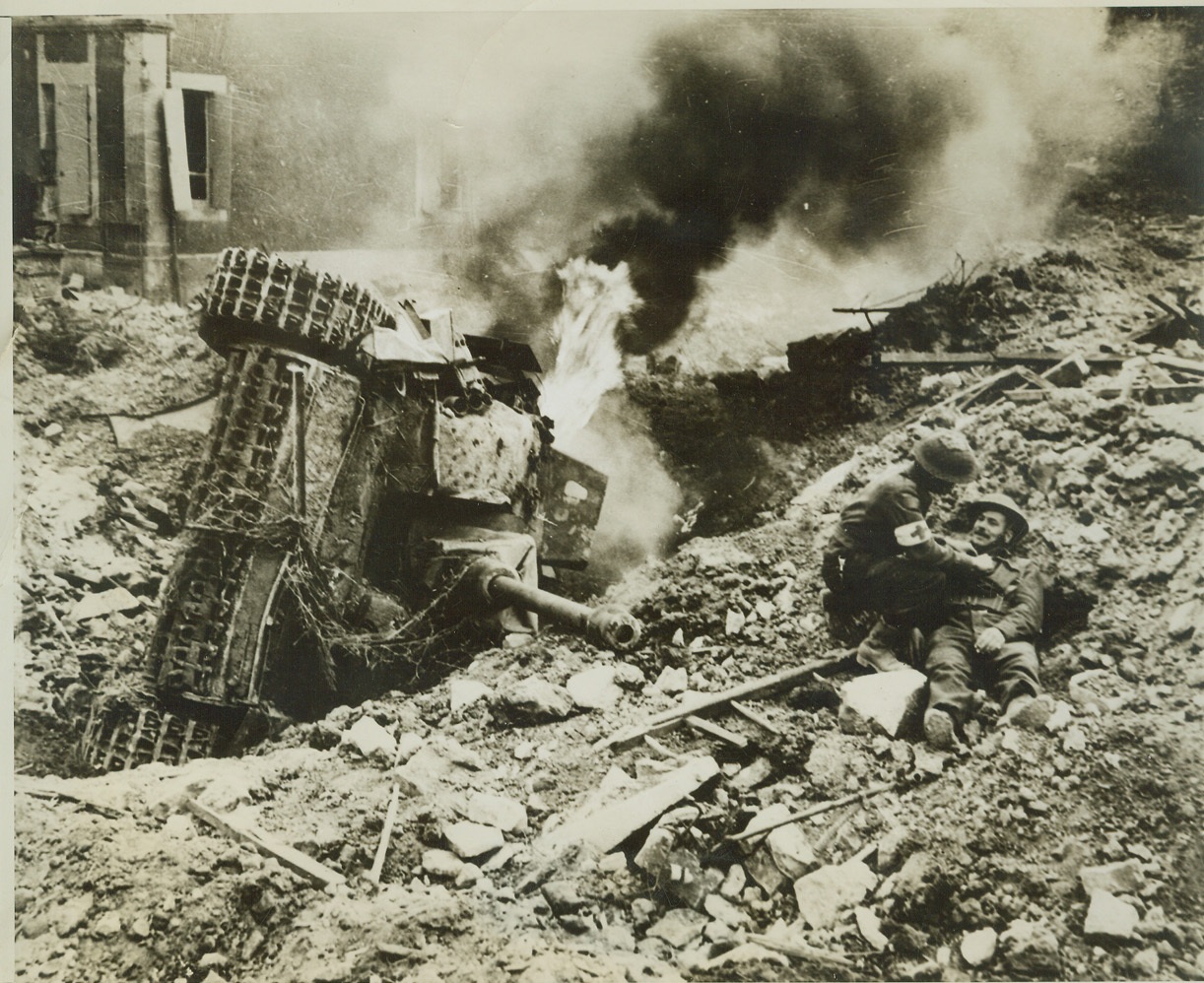
Trap Closes on Nazis, 8/16/1944. FRANCE -- A German tank, overturned in a deep bomb crater, burns fiercely along the road to Falaise, where Allied forces are closing a trap on the German 7th Army, which has already been torn to ribbons. At right (photo above) a medical orderly looks over a Canadian soldier who has fallen but is uninjured. Credit: (ACME) (WP);
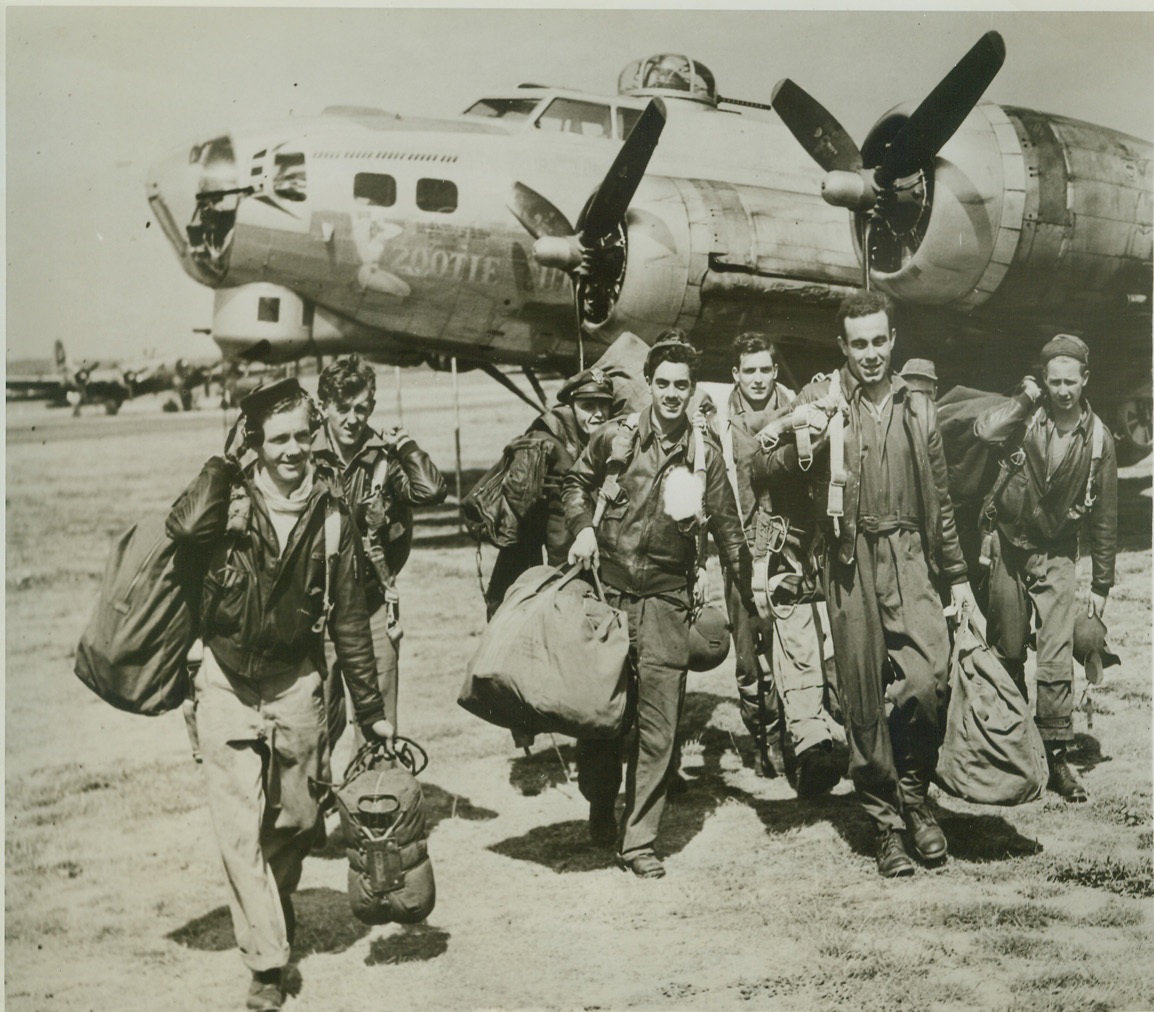
Yank Return from Raid, 8/22/1944. ENGLAND -- American airmen walk from their Fortress bomber on returning to their base in Britain after raiding strategic targets in Alsace Lorraine. They are (left to right): T/Sgt. Harry Soderburg, Lueders, Tex.; T/Sgt. Fernand Savasuk, Winslow, Me.; 1st Lt. Richard Davies, Congers, N.Y.; S/Sgt. Bernice Stanton, Cookville, Tenn.; 2nd Lt. Joseph Hughes (rear), Pittsburgh, Pa.; 2nd Lt. Harry Neumann, Union City, N.J.; S/Sgt. Raymond Glasser, Little Sioux, Iowa; Sgt. Mervin Wingard (rear), Kittaning, Pa.; and Sgt. Bill Baker of Chanute, Kansas. Credit: (ACME);
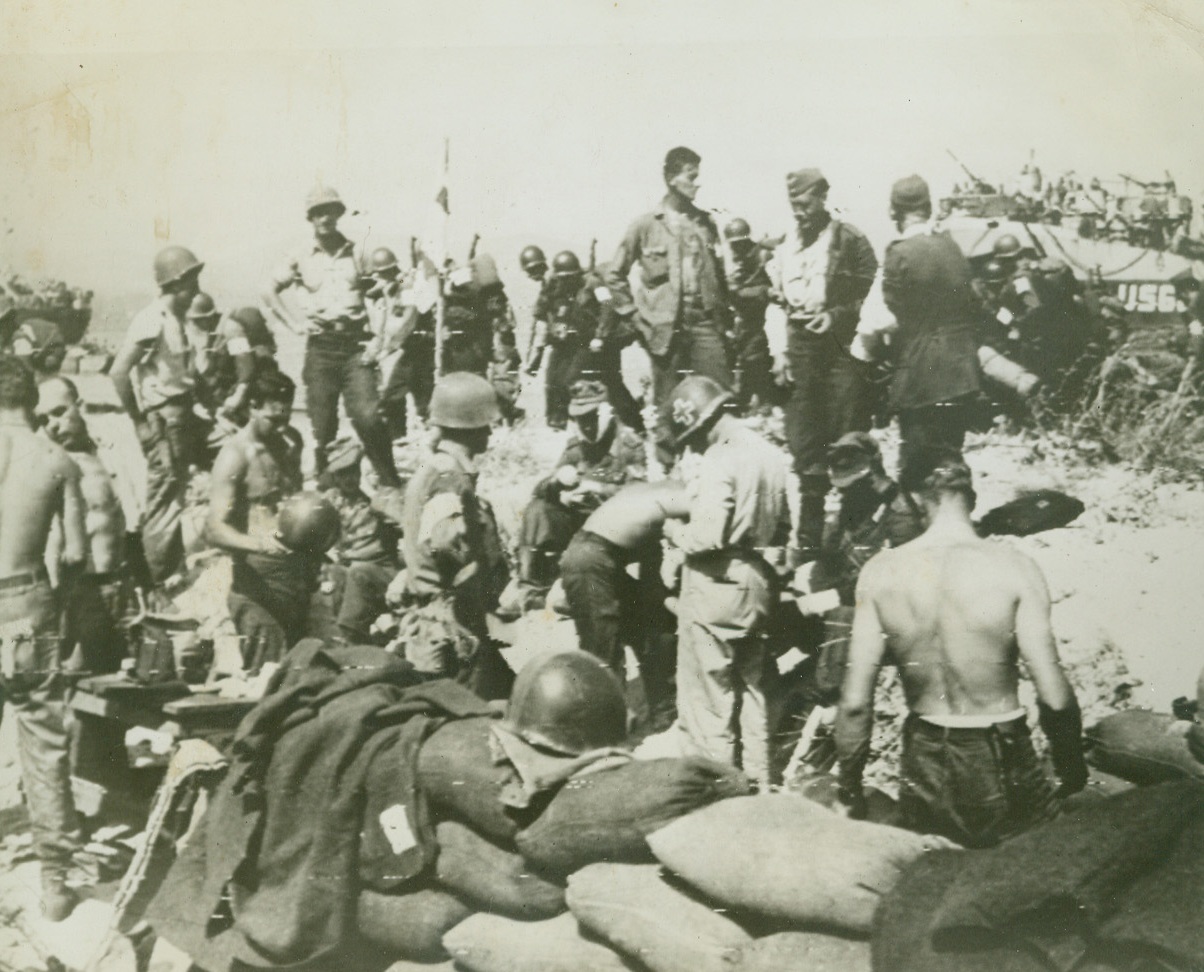
FIRST AID FOR FRIEND AND FOE, 8/16/1944. U.S. Infantrymen and German prisoners receive medical treatment from American corpsmen at a beach dressing station in Southern France, while (background), Yank troops file by on their way to consolidate the new beachhead. Credit: Acme photo by Sherman Montrose for War Picture Pool via Army radiotelephoto;
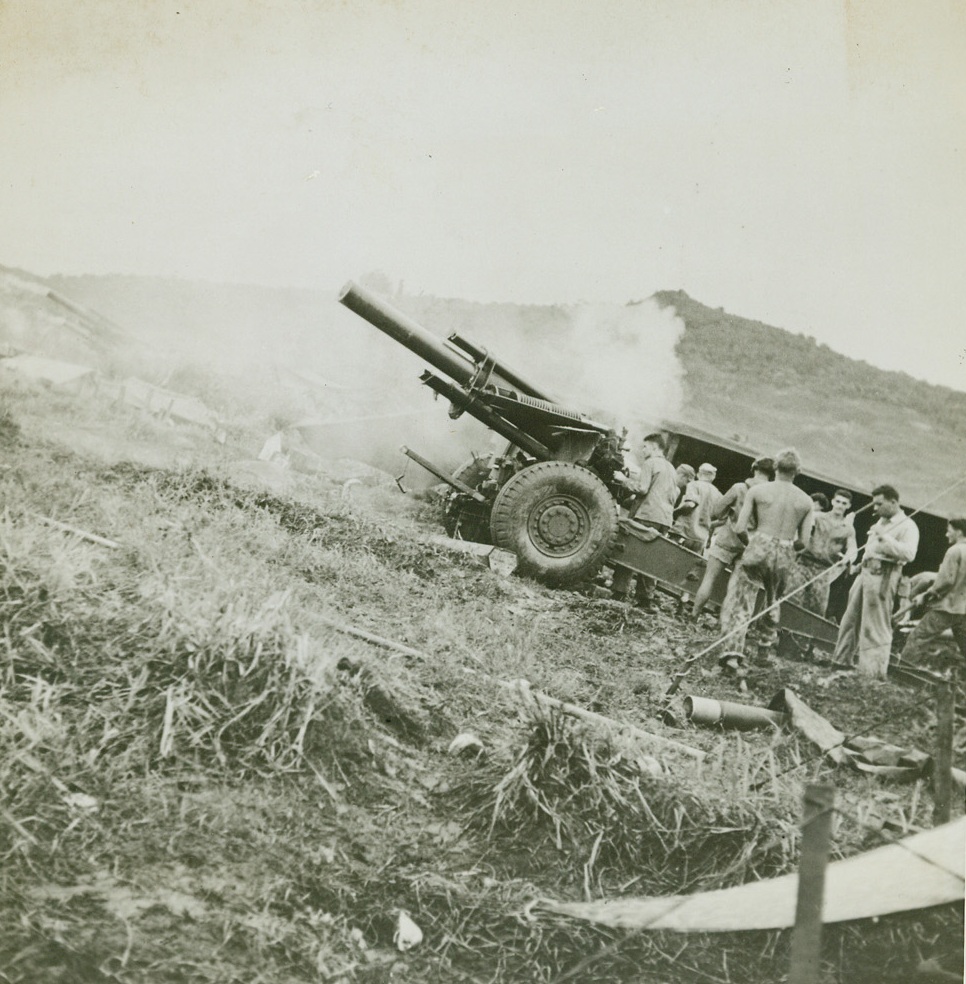
BLAST JAPS OFF GUAM, 8/11/1944. GUAM—A Marine howitzer, one of the first to be brought ashore, blasts enemy positions in the battle for Guam, the first American base to be taken by the Japs and the first to be recovered from them. More than 10,000 Japanese were killed in the fighting for the island. Credit: U.S. Navy photo from Acme;
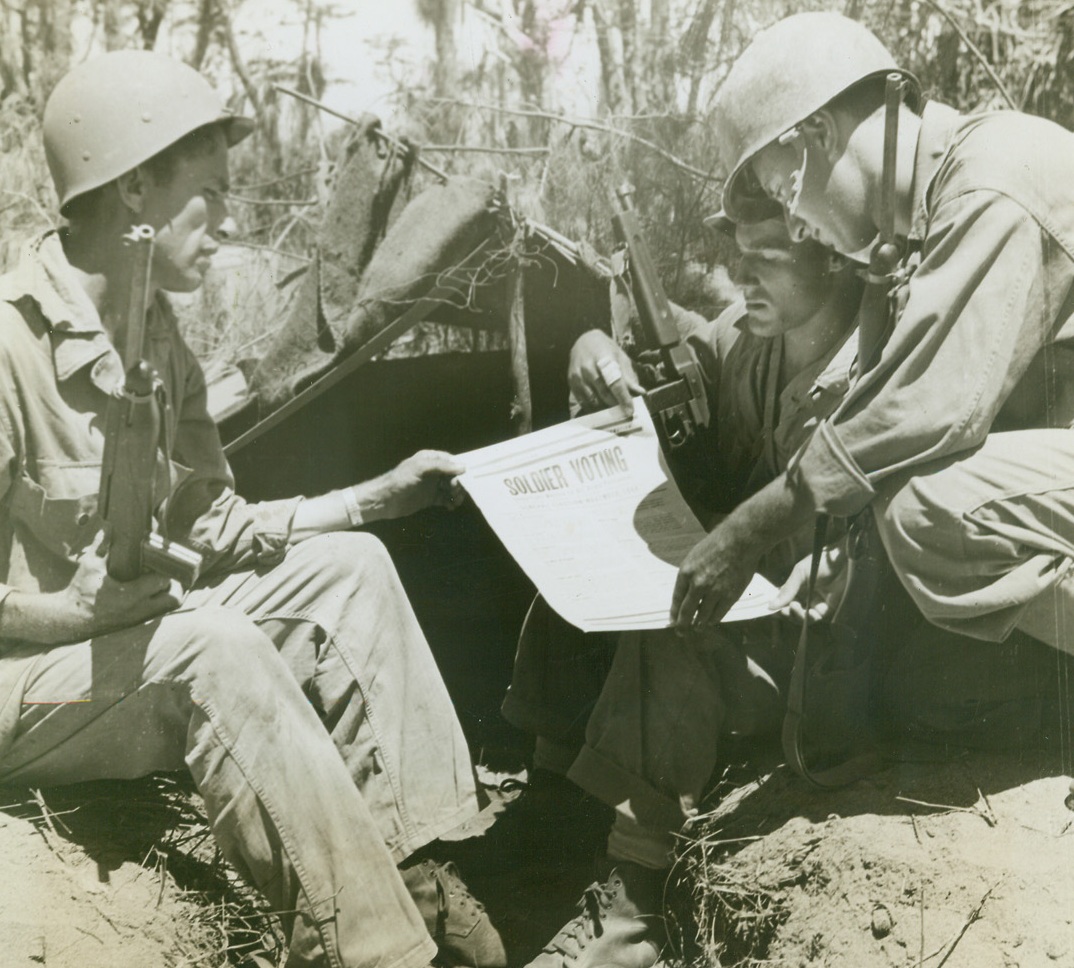
POLITICS ON THE BATTLE FRONT, 8/11/1944. NEW GUINEA—Yanks in New Guinea, near the battle lines down the Driniumor River near Aitare on New Guinea, study requirements for soldier absentee ballot. They are (left to right): Pfc. Leonard C. Layton, Dayton, O.; Cpl. Henry Betley, Barron, Wis.; and Pfc. Andrew Rothstein, New York City, all members of a headquarters company. Credit-WP (ACME Photo by Tom Shafer, War Pool Correspondent);
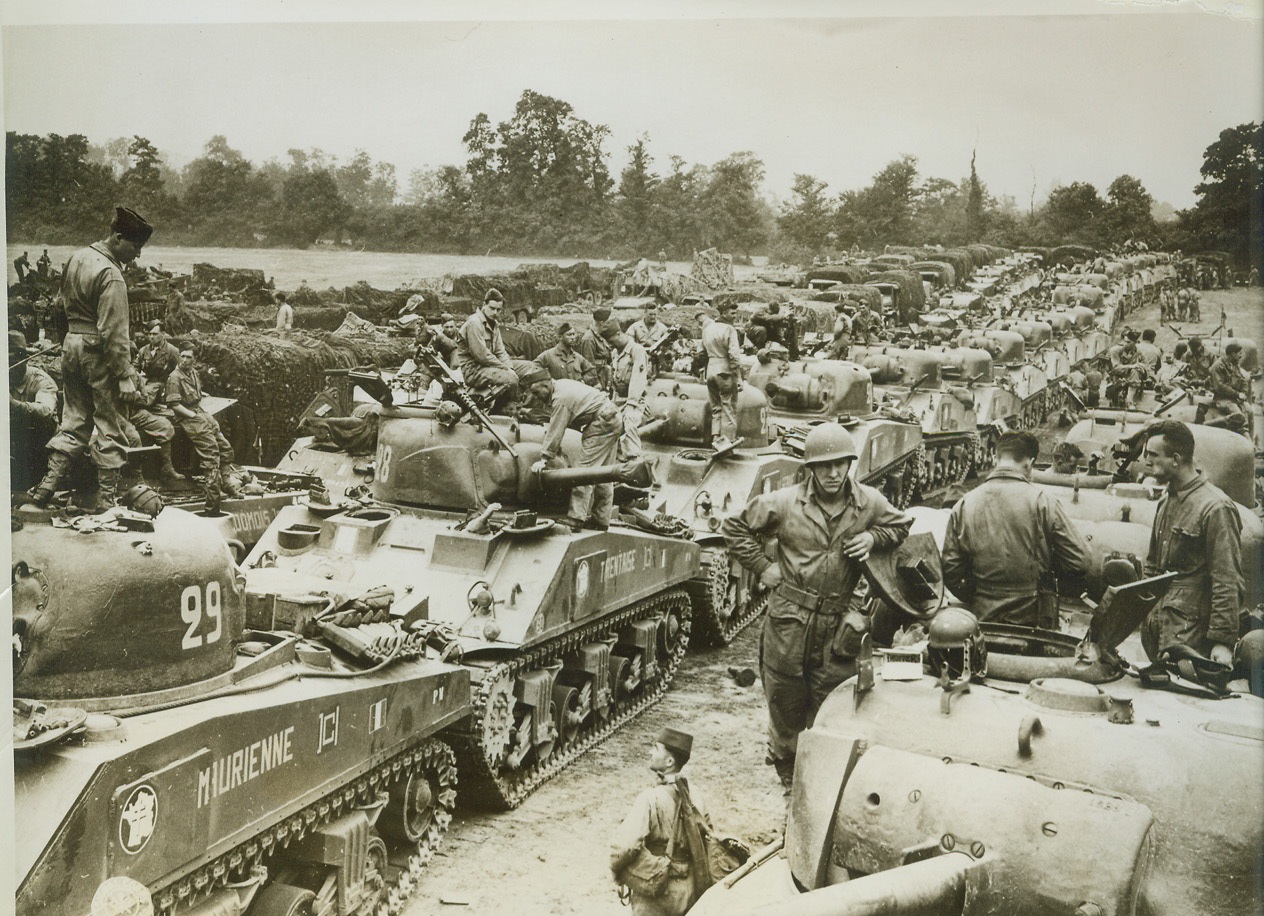
Free French on Way to Free France, 8/15/1944. Free French troops with their armored vehicles shown at a transient area somewhere in the European Theater of Operations just before hopping to the Continent in support of the Allied attack to free France from the Nazis. Credit: (Signal Corps Photo from ACME);
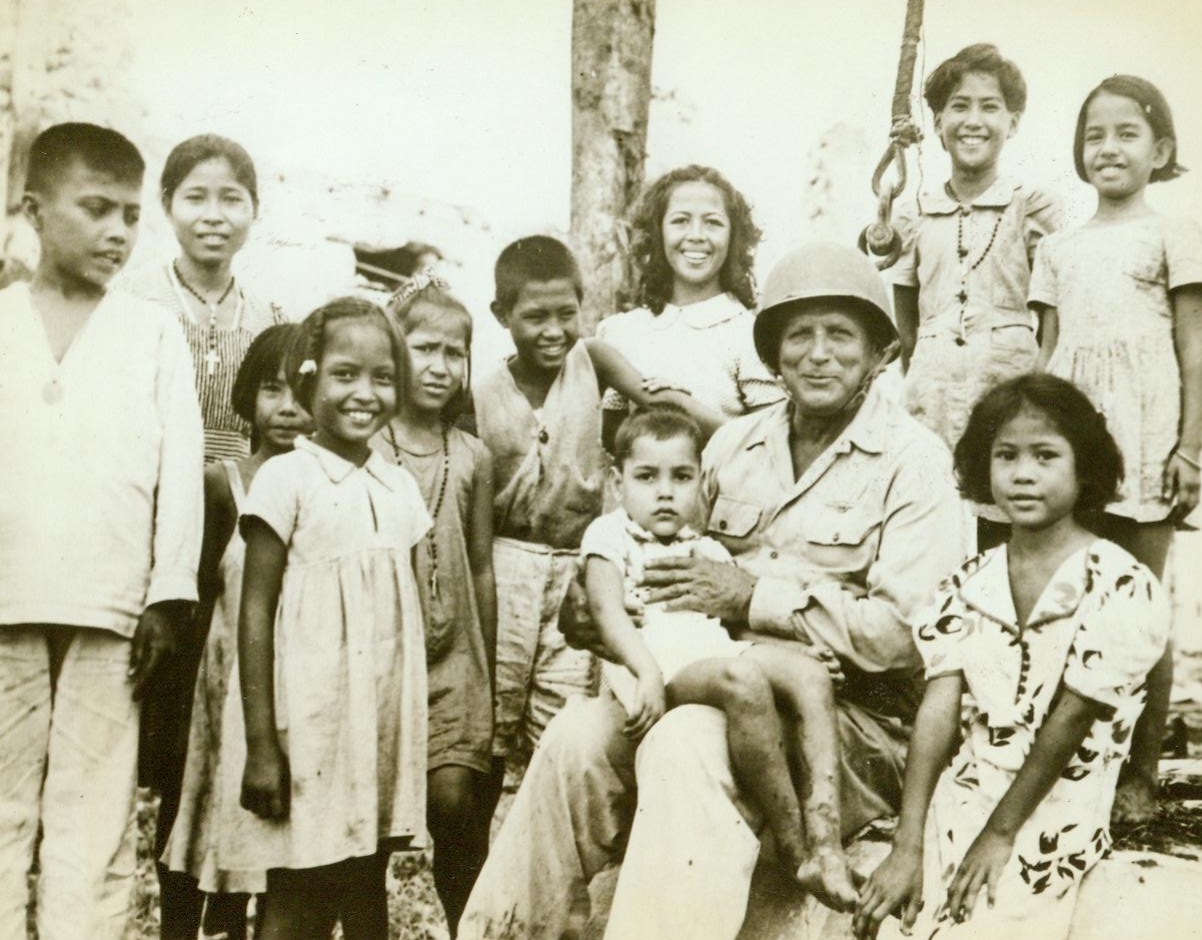
Benevolent General, 8/12/1944. Guam – Smiling Maj. Gen. Roy S. Geiger, USMC, commander of US Expeditionary Forces on Guam, holds one sober-faced native child on his lap, while others surround him, grinning cheerfully. The children were rescued from the Japanese by American forces 8/23/44 Credit (ACME);
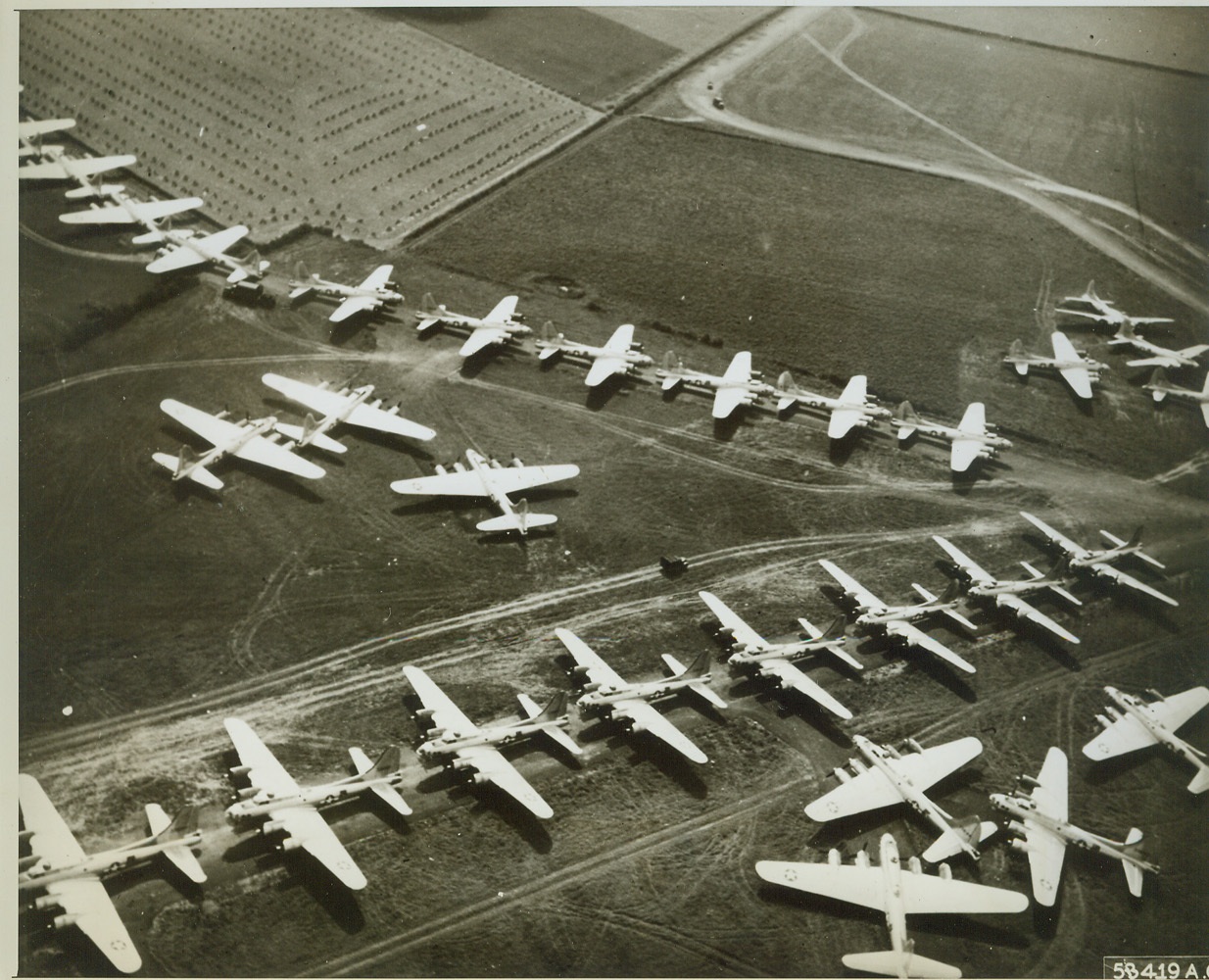
Aerial Might on Display, 8/23/1944. ENGLAND -- A tribute to American labor and production power one of the largest group of B-17 Fortresses ever seen together in the confines of a photograph are lined up and ready for combat. This is only a small portion of the aerial might which is assembled in England as replacements for the strategic bombers of the U.S. Army 8th Air Force. Credit (USAAF Photo from ACME);
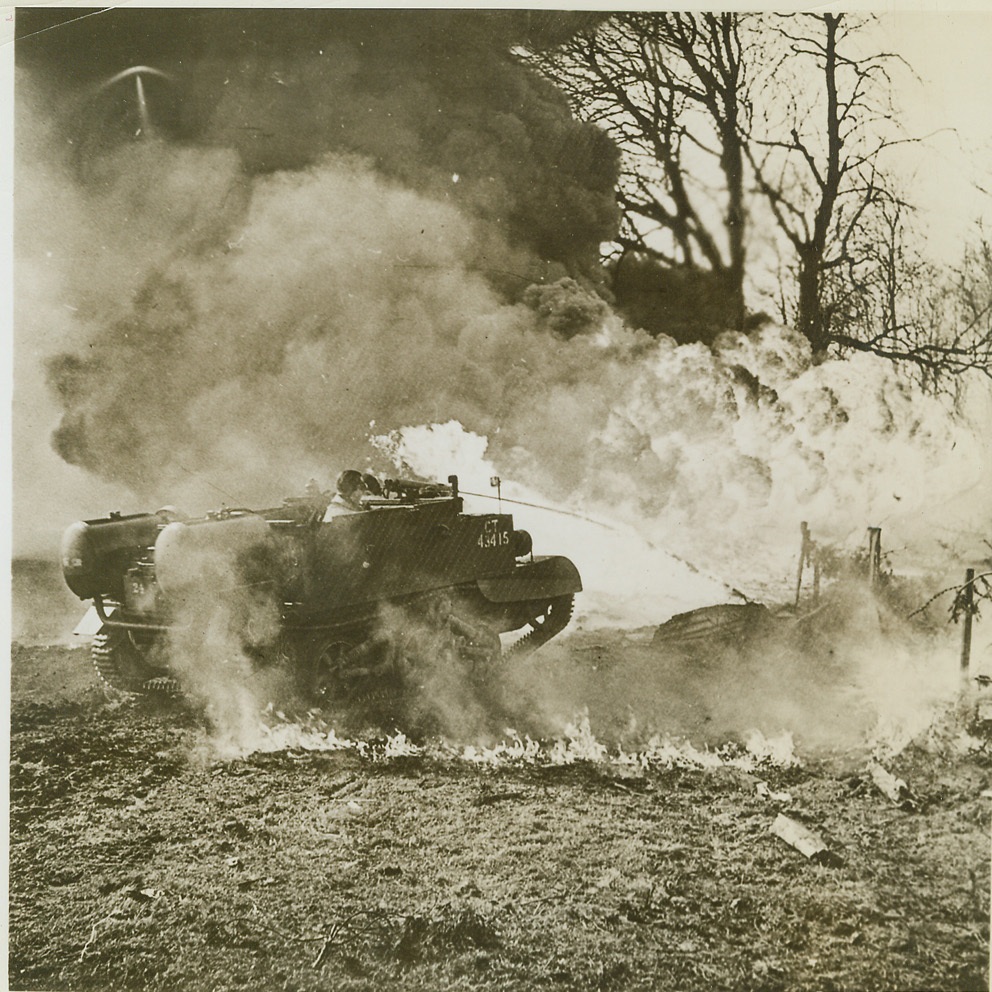
"Wasp" Packs a Flaming Sting, 8/30/1944. Among the powerful flame-throwers now being used by British Armies in France is the ferocious "Wasp". Sending a fearsome stream of fire into German strongpoints, the flame-thrower is fitting to a carrier with a bullet-proof body. In the "Wasp", as in all other weapons of this kind, a special type of fuel is used. Credit (British Official Photo from ACME);
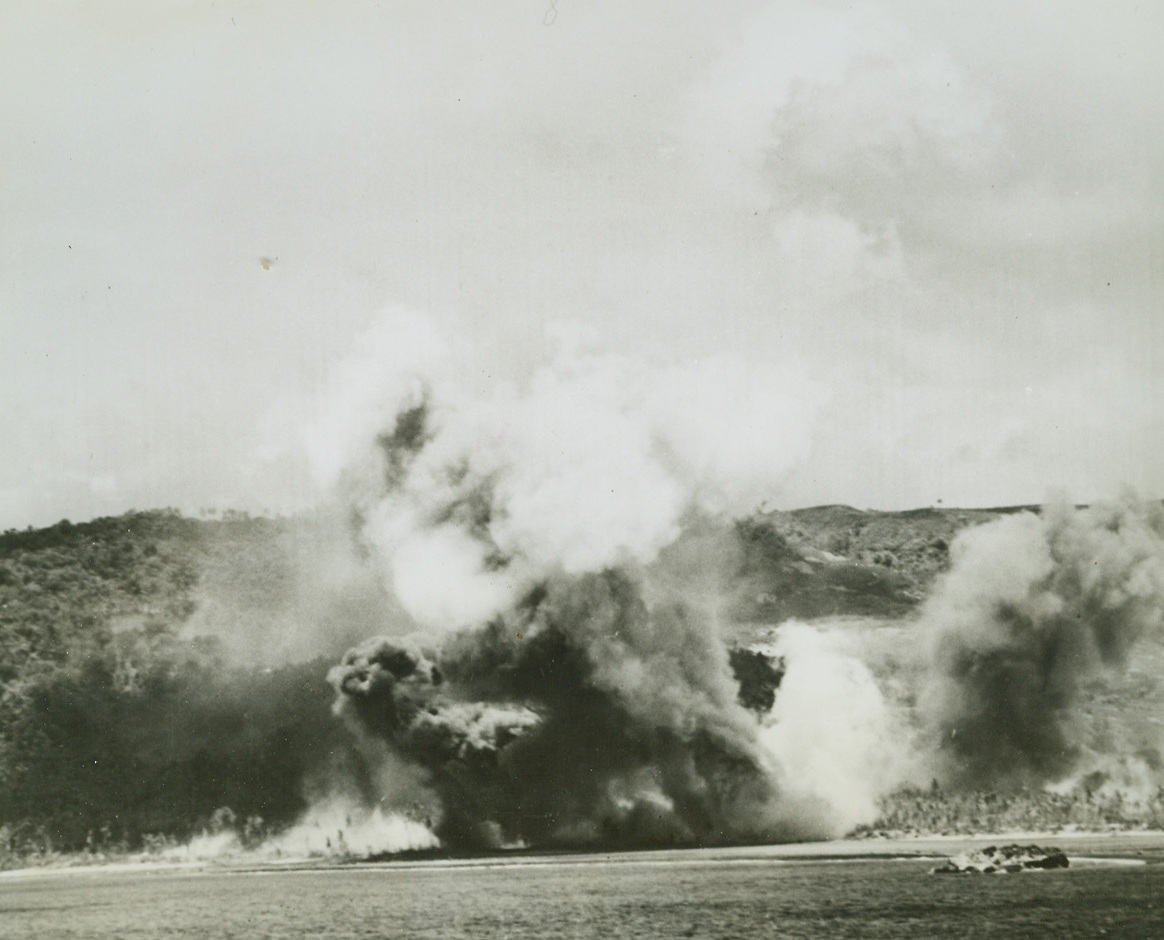
Pre-Invasion Bombardment on Guam, 8/2/1944. Guam Is. – Grey and black smoke rises in huge billows from the shores of Guam, as US Navy guns and planes hammer at the Jap installation on July 21 to soften it for Marine and Army landing forces.Credit: Official US Navy photo from ACME;
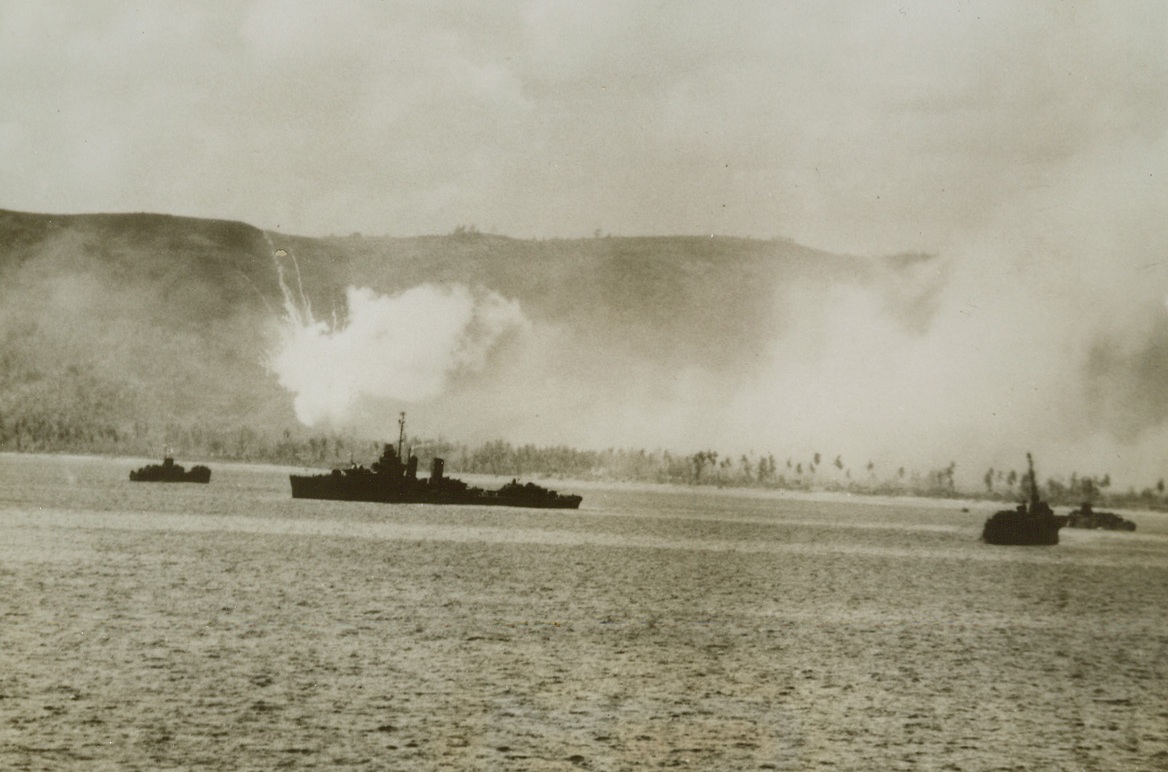
Fire and Brimstone on Guam’s D-Day, 8/2/1944. Guam Is. – A phosphorus shell explodes in a burst of burning fog, and US ships move into the harbor at Guam as landing assaults are launched against the Japanese stronghold. The landings were preceded by aerial and surface bombardment.Credit: US Navy photo from ACME;
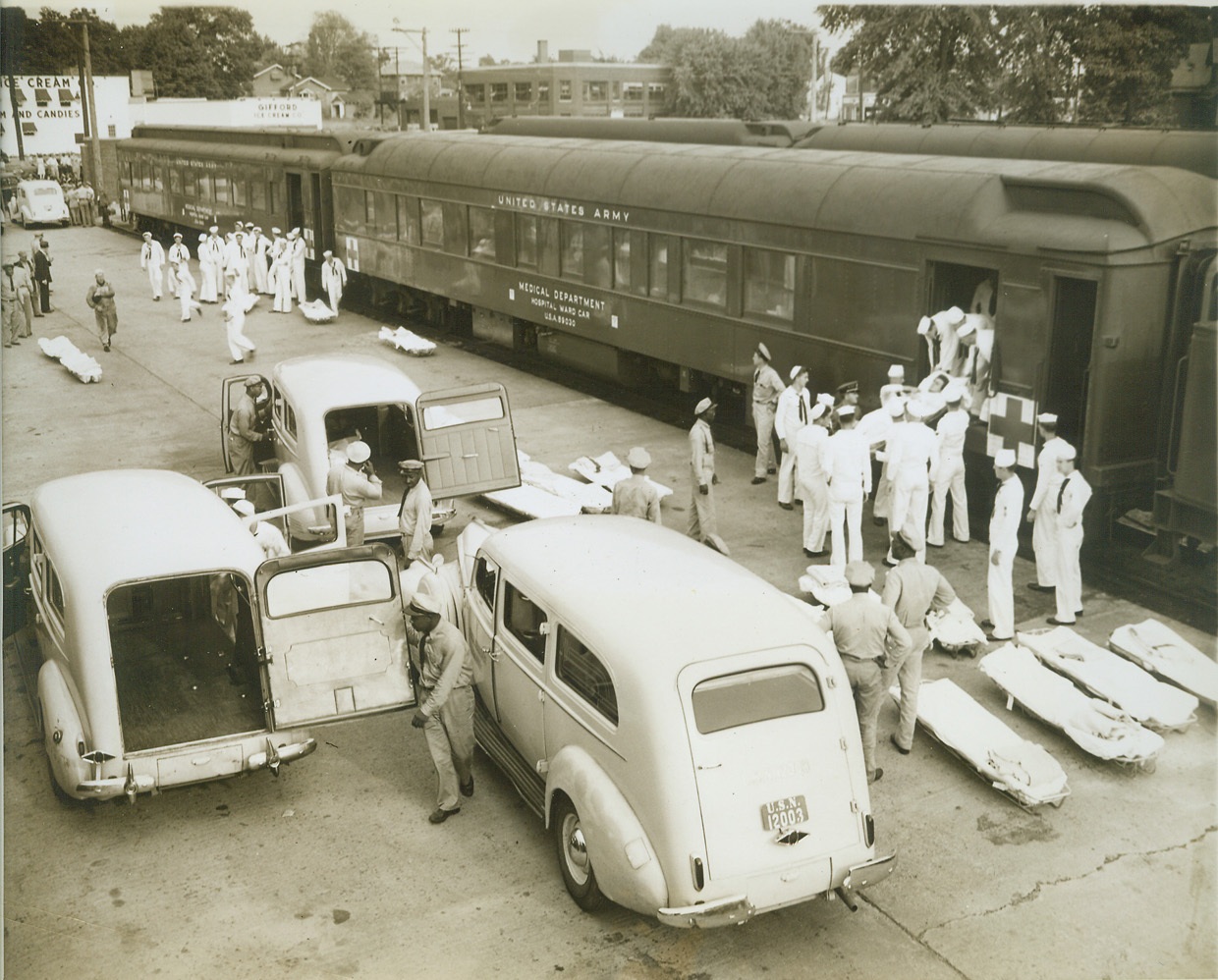
Navy's Normandy Wounded Brought Home, 8/2/1944. WASHINGTON, D.C. -- With ambulances and stretchers waiting, some of the one hundred and twenty nine Navy men wounded in Normandy are lifted from a hospital train which carried them to Silver Springs where they will receive further treatment in the Naval Medical Hospital. These Naval heroes were brought across the Atlantic from France in a hospital ship. Credit: (ACME);

Yank Gunners Down Jap Plane, 8/17/1944. A U.S. Navy photographer, using a camera with a 40-inch lens, filmed the destruction of a Jap plane over Guam, last June 19. At the top, the Nip roars along over an American aircraft carrier. In the center photo, sharp-eyed Yank gunners on the carrier register a hit on the enemy, and (below) the Jap plane explodes in flame. The plane was 7.000 feet above the carrier. Credit: U.S. Navy photo from ACME;
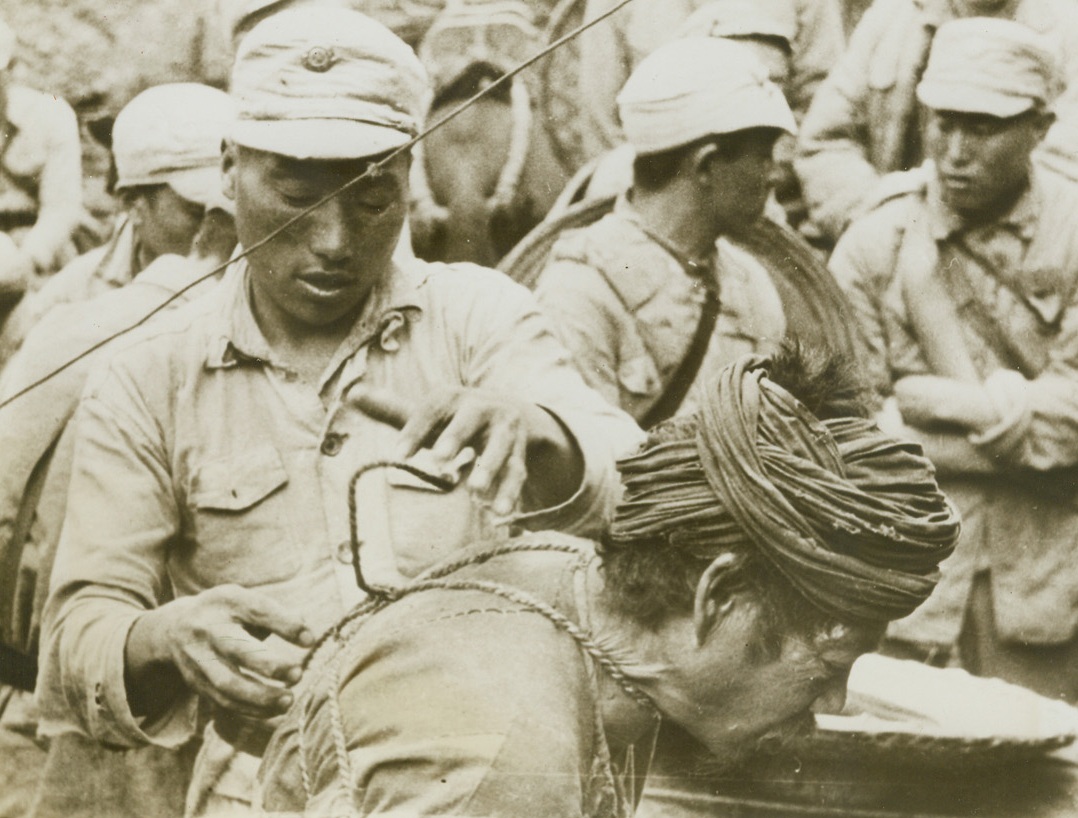
Up for Trial, 8/21/1944. China – Suspected of being a Japanese spy, this peasant is untrussed by a Chinese warrior at Division Headquarters on the Salween River front. Although he will be given a fair trial, the suspect will receive little sympathy from the Chinese if he is proven guilty. Jap spies are quickly disposed of by Chinese forces fighting to reopen the Burma road. Credit: Signal Corps photo from ACME;
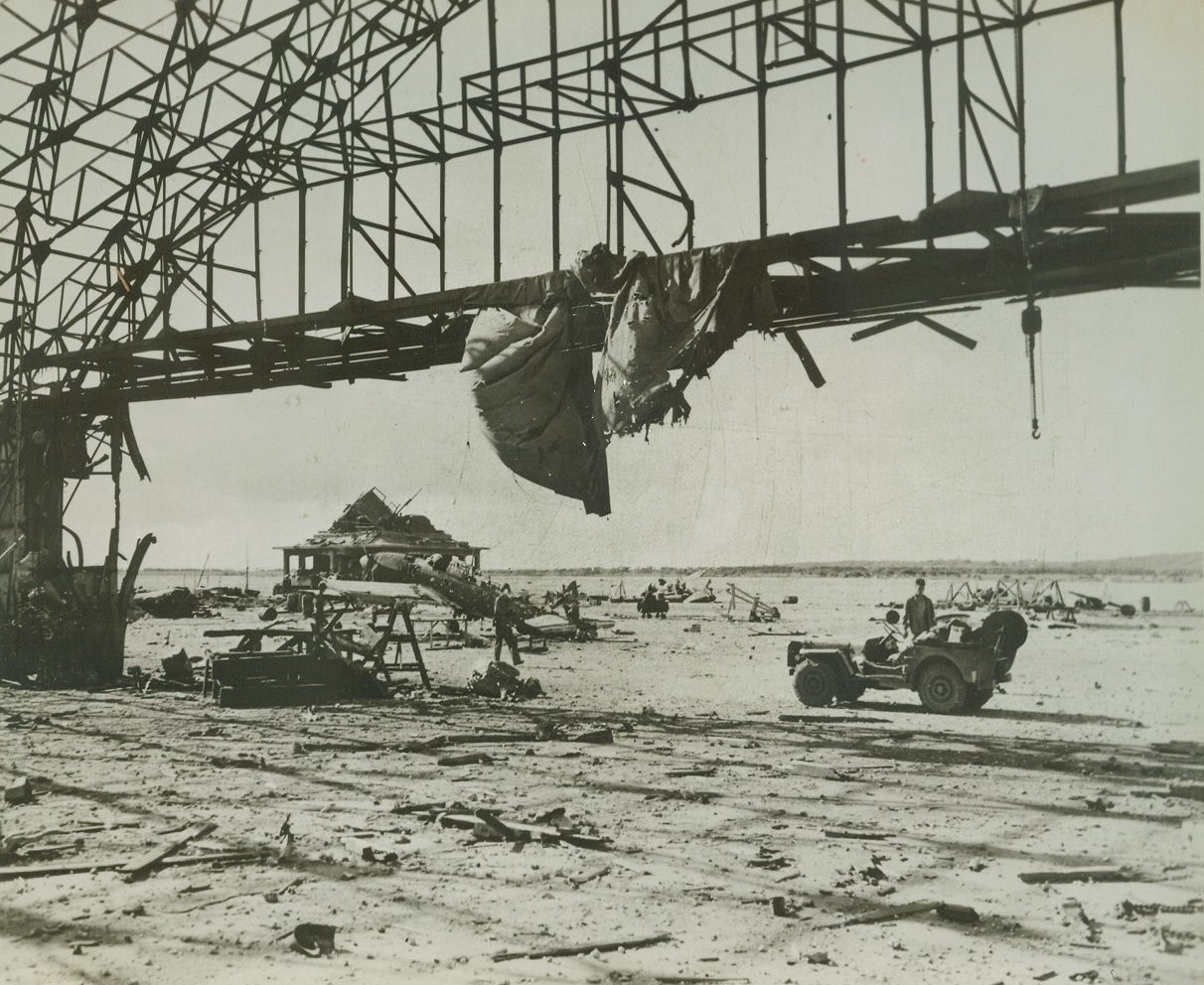
After Yank Bombardment, 8/11/1944. TINIAN – Pre-invasion naval and aerial bombardment completely shattered enemy installations and equipment at this Jap airport on the Northern end of Tinian. Marine forces captured the field shortly after hitting the beach and reconstruction of the strip is already underway. Credit: Marine Corps photo from ACME;

Old Glory Moves Up to Battle, 8/11/1944. GANA, GUAM – Moving through the war-shattered town of Agana, tanks and armored vehicles of the Third U.S. Marine Division roll to the North on the hells of retreating Japs. They carry with them the American flag, to wave once again over the island that was seized by the Japs shortly after Pearl Harbor. Credit: ACME;
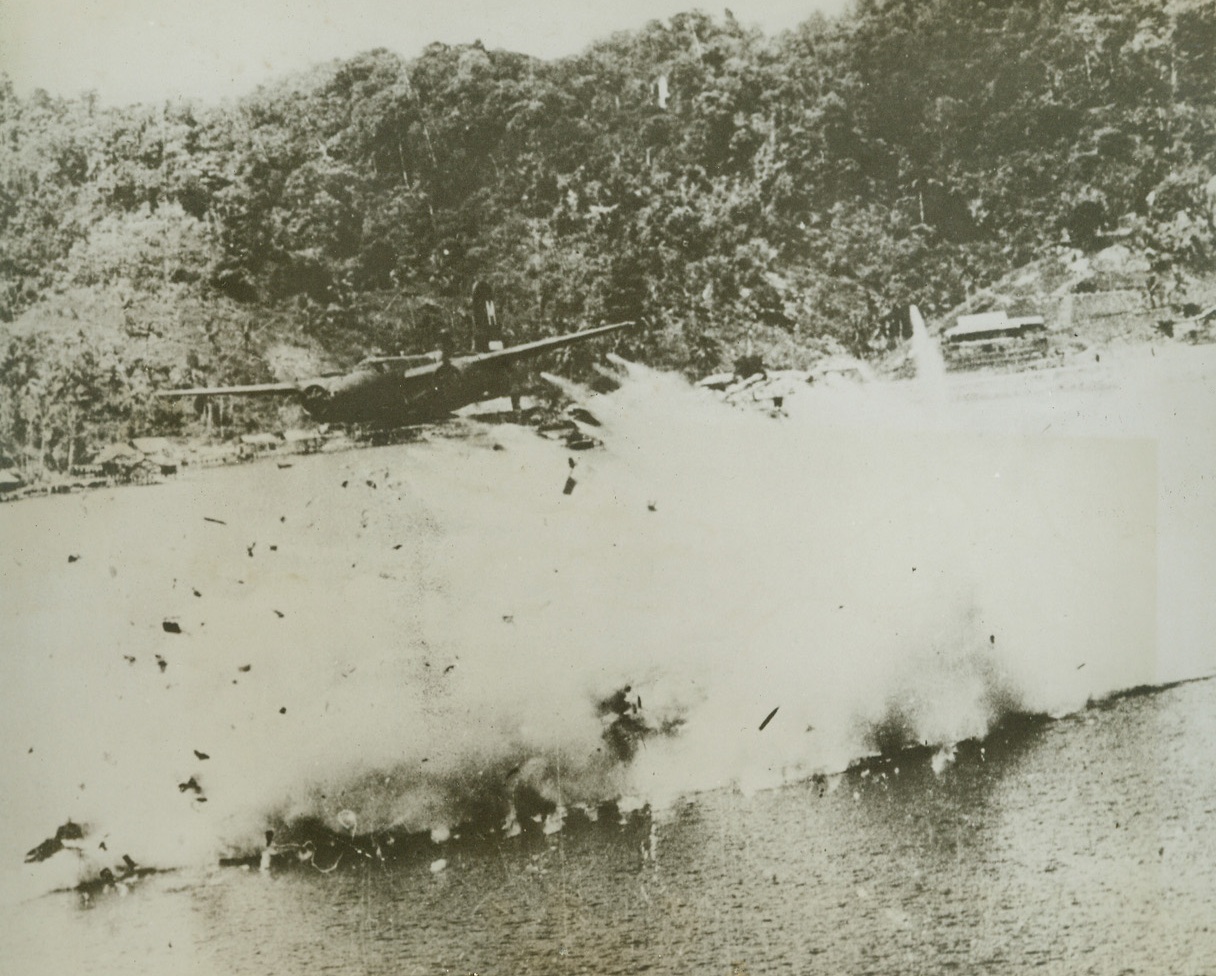
The Last Flight of a Yank Bomber - #2, 8/10/1944. KOKAS, DUTCH NEW GUINEA – What was once an A-20 attack bomber is now but a mass of smoke and flying parts as the plane explodes after crashing into the sea, a victim of a direct ack-ack hit. A companion ship heads safely homeward from a low-level raid on Jap installations at Kokas, Dutch New Guinea. Credit: USAAF photo from ACME;
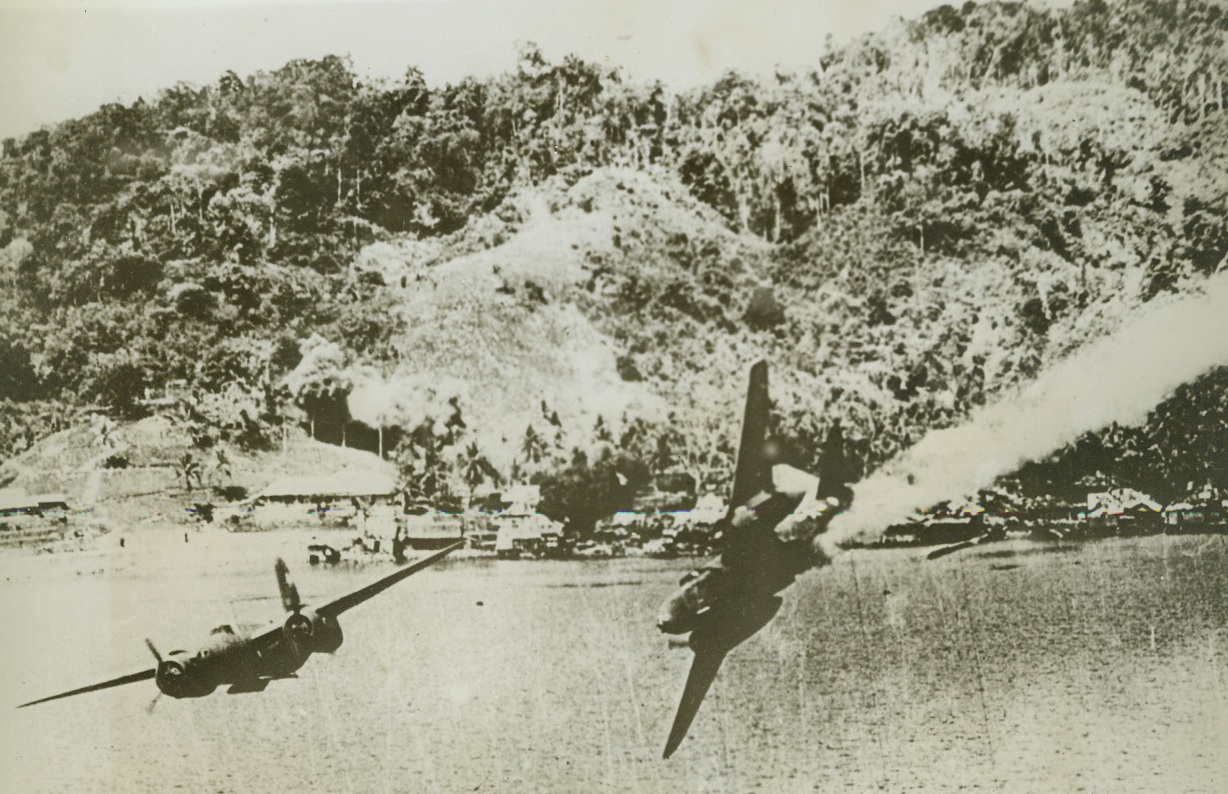
The Last Flight of a Yank Bomber - #1, 8/10/1944. KOKAS, DUTCH NEW GUINEA – In a slow, graceful dive, an A-20 attack bomber heads for the sea on its final flight after being hit by ack-ack bursts. A companion ship at left maneuvers for safety. Smoke streaming from the tail of the wounded craft marks a trail of death, as the ship was too low to permit crewmen to parachute. Both planes were returning from a low-level raid on Jap installations at Kokas, Dutch New Guinea. Credit: USAAF photo from ACME;

No Targets—Gun Crew Rests, 8/11/1944. AGANA, GUAM – When they ran out of Japs to shoot at on Agana, these gun crew members laid down their arms to relax for awhile, but they leave the cartridge belt in their gun—just in case. Left to right: Pfc. W. C. Dean, Meridian, Miss.; Pfc. R. A. Rouse, Cincinnati, Oh.; Pfc. E. J. Bernier (lying down), River Rouge, Michigan; and Cpl. T. L. McHugh, Cincinnati, Oh. Men in foreground and at extreme right are unidentified. All are of the Third Marine Division Credit: ACME;
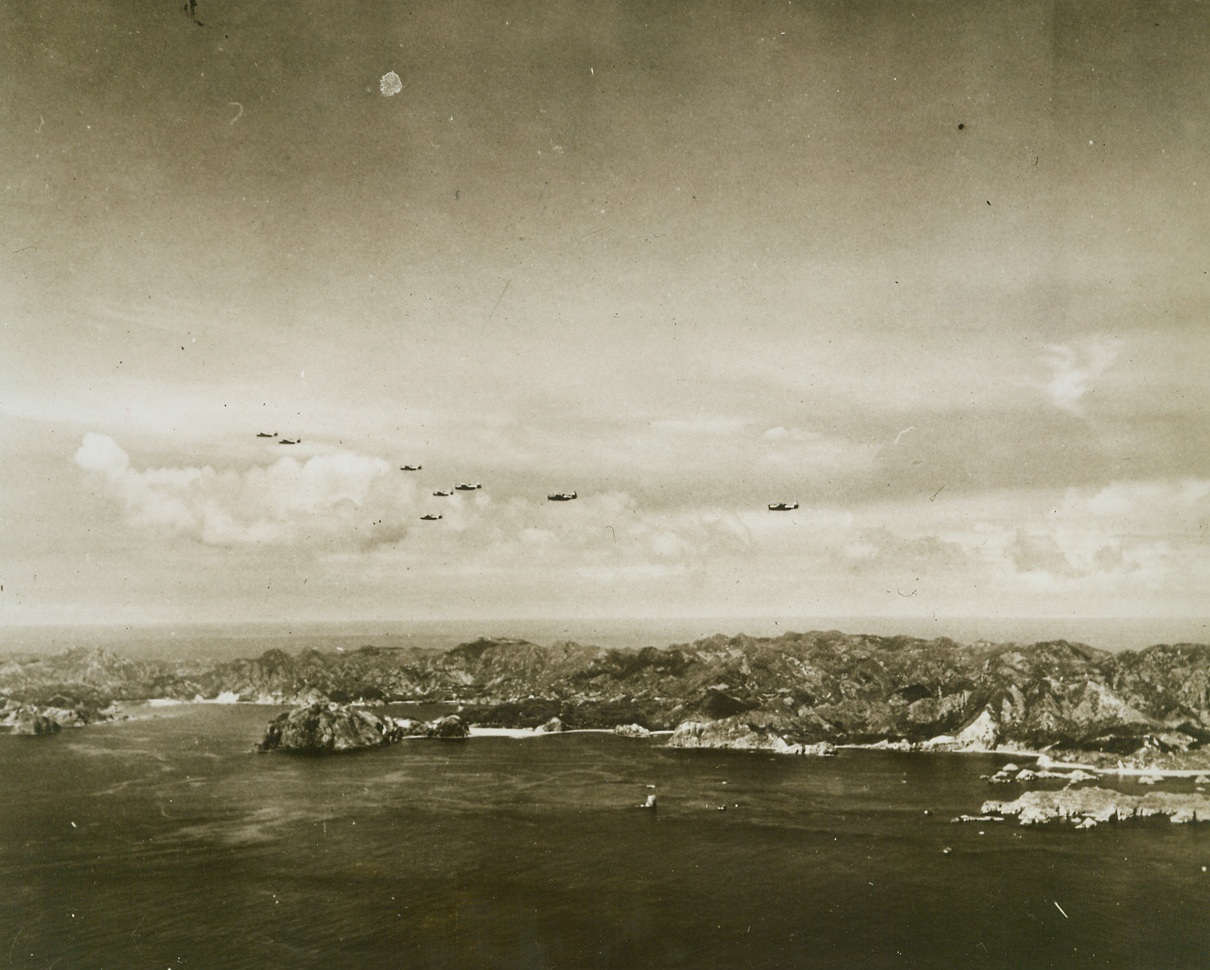
Navy Force Strikes in Bonins, 8/9/1944. BONIN ISLAND – Swift and deadly, eight Grumman Avengers of a hard-hitting Pacific fleet task force glide over the gnarled shoreline of Chichi Jima in the Bonin Islands, only 600 miles south of Tokyo. Our planes destroyed 13 Jap ships and 32 planes; they damaged more than 20 ships and 96 planes. Credit: Official U.S. Navy photo from ACME;

Only 600 Miles from Tokyo, 8/9/1944. BONIN ISLANDS – With smoke rising from the ruins of four ships at Haha Jima below them, five helldivers of a Pacific Fleet task force slip back into formation to return to their carriers. In attacks on Haha Jima and Chichi Jima, both in the Bonin group, 600 miles south of Tokyo, our planes sank at least 13 Jap ships and damaged more than 20. Thirty-two enemy planes were shot down and 96 were damaged. Credit: Official U.S. Navy photo from ACME;

Cart Wounded from Burma Front, 8/19/1944. BURMA – On ox-drawn carts, wounded men arrive at the airport at Myitkyina, Burma, where they await transportation by hospital plane. Men were brought from the front five and one-half miles away over terrain as sodden as this air strip. Credit: U.S. Army photo from ACME;
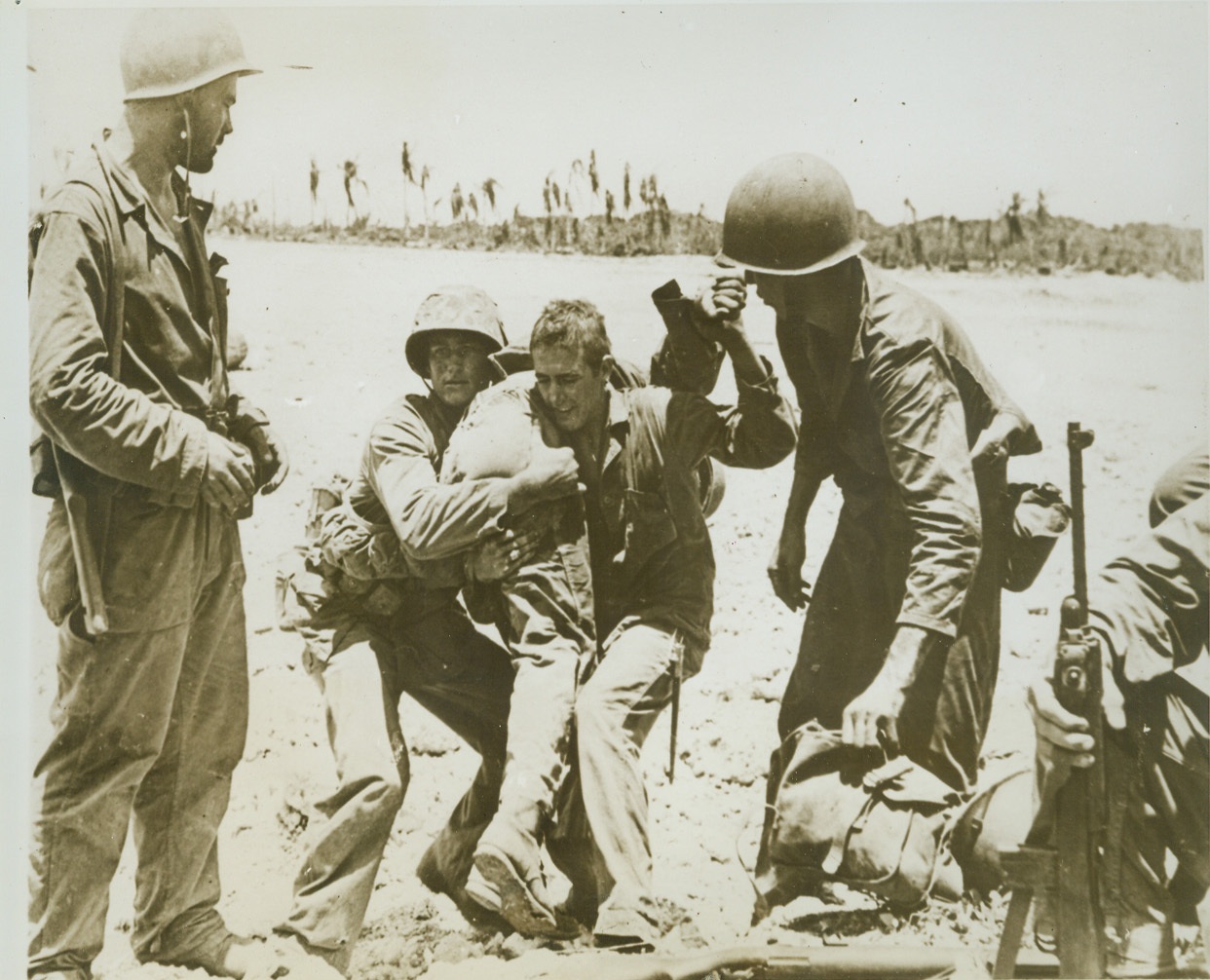
His Buddies to the Rescue, 8/6/1944. GUAM -- A Leatherneck swings a fellow Marine, who was hit by a Jap bullet in fierce fighting for an airstrip near Orote, to his shoulder and other Marines clear the way for him as they carry the wounded man back to an emergency station. Credit (ACME) (WP);
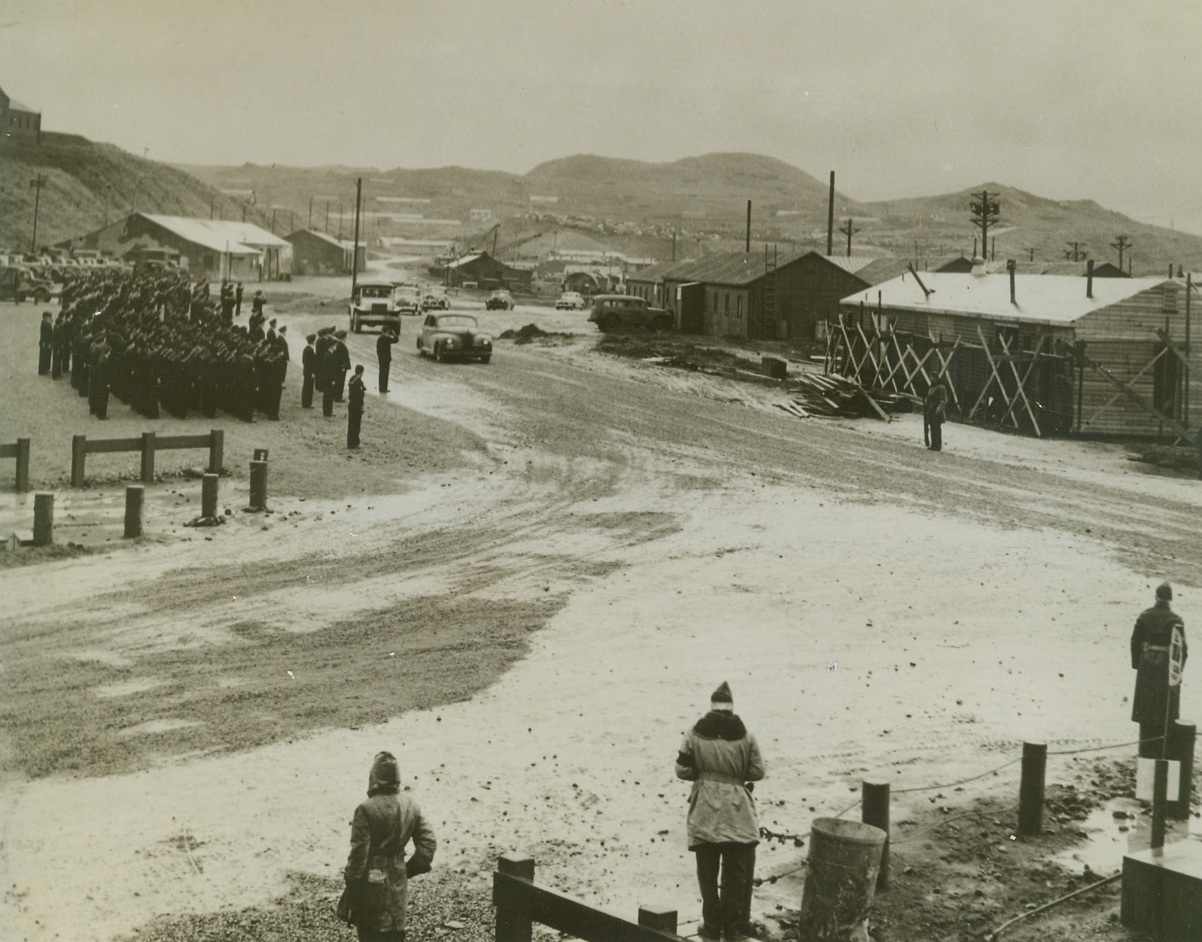
Roosevelt Sees Aleutian Bases, 8/11/1944. A guard of honor salutes the presidential car as it rolls through the mist and rain on an inspection tour of bases in the Aleutian islands. The president visited this Northern outpost after meeting with military and naval leaders at Pearl Harbor during his tour of Pacific bases. Credit (U.S. Army photo from ACME);
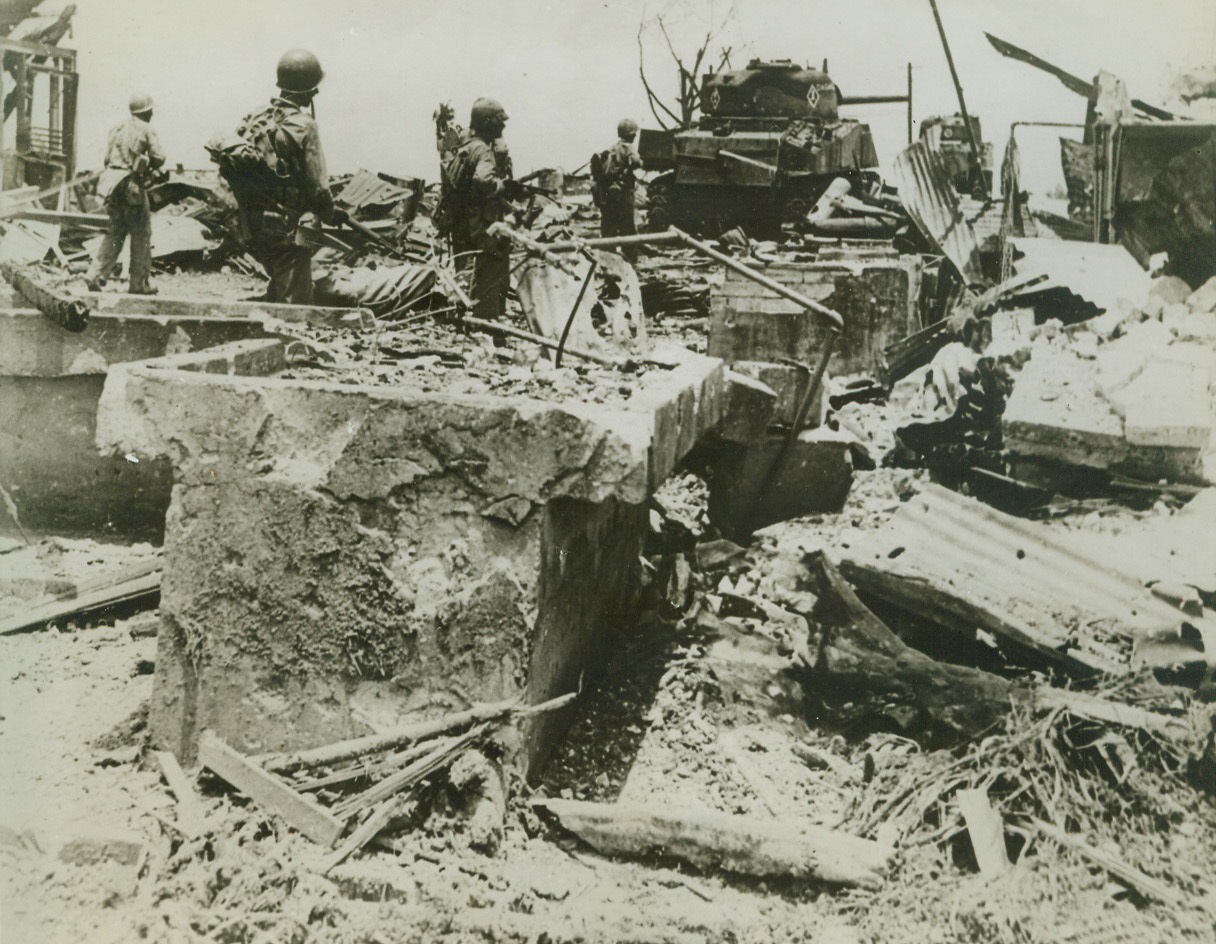
Leathernecks Enter Former Marine Barracks, 8/6/1944. Guam – US Marines hold their guns cocked as they look for signs of Japs hiding amidst the ruins of the old Marine barracks on Guam. Moving in without opposition, they are the first men and tanks to enter the site, which has been almost completely destroyed by aerial and naval bombardment. Credit (ACME);
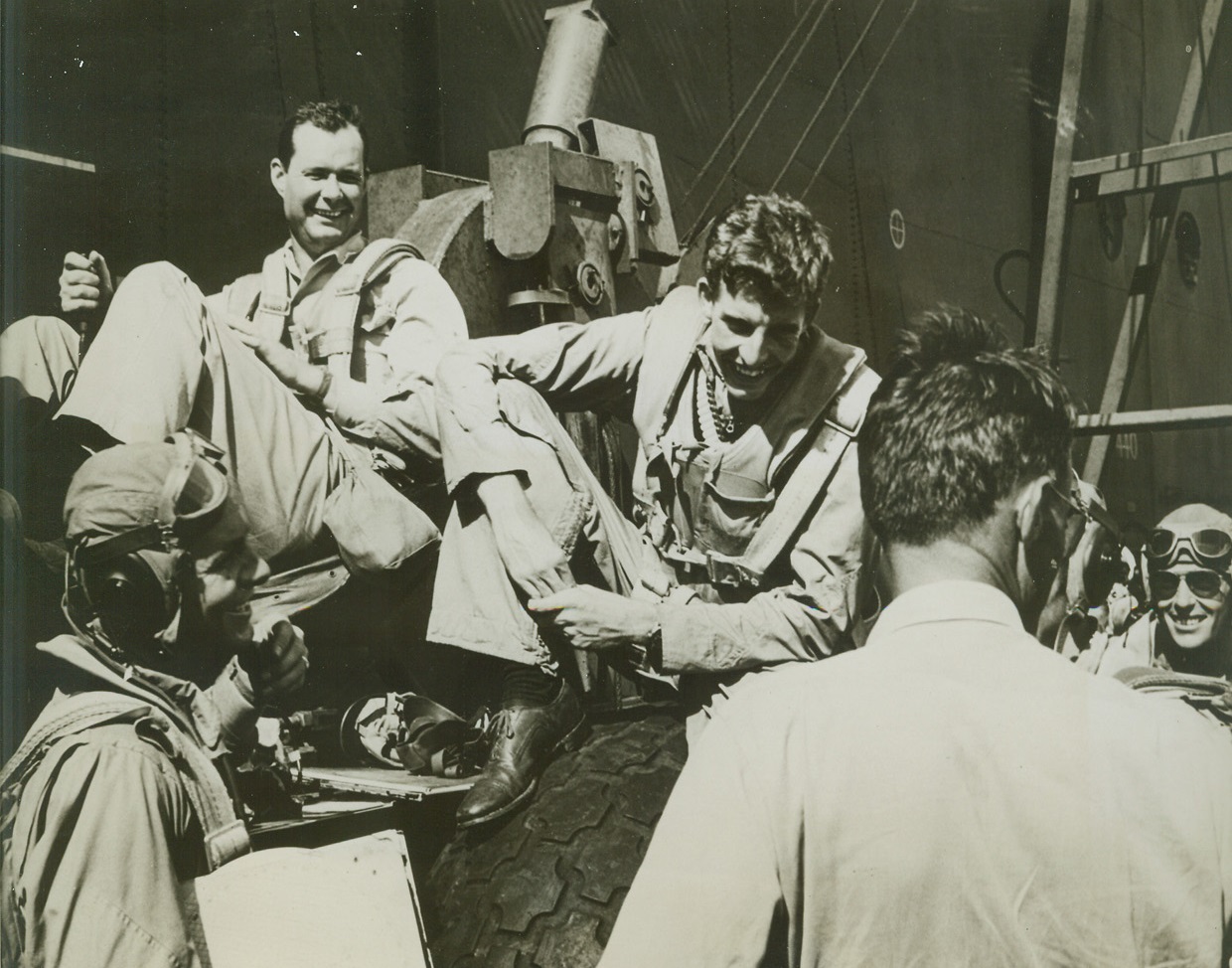
Rehashing Victory, 8/23/1944. At Sea – Relieved grins light the faces of air group 16 pilots as they discuss a victorious clash with Jap planes, after their return to their carrier. Seated (top) are; (left to right) Comdr. P.D. Buie of Nashville, GA; and Ensign W.J. Seyfferle, Cincinnati, O. Lower left: Ensign Edward G. Wendorf, West (co), Texas. With back toward camera: Comdr. L.B. Southerland, USN. Extreme right: Lt. (jg) Frances M. Fleming, Portland, Ore. Credit line (official U.S. Navy photo from ACME);

Jap Bomber Comes Down, 8/23/1944. At Sea--- Speeding Westward from Saipan in its hunt for the Jap fleet, task force 58 met and mutilated 18 enemy dive and torpedo bombers in one of the greatest air and sea battles of the Pacific. The death of one of the attacking warbirds is shown in this series, as it ran the gauntlet of murderous flak and finally plunged into the ocean. Credit line (ACME);
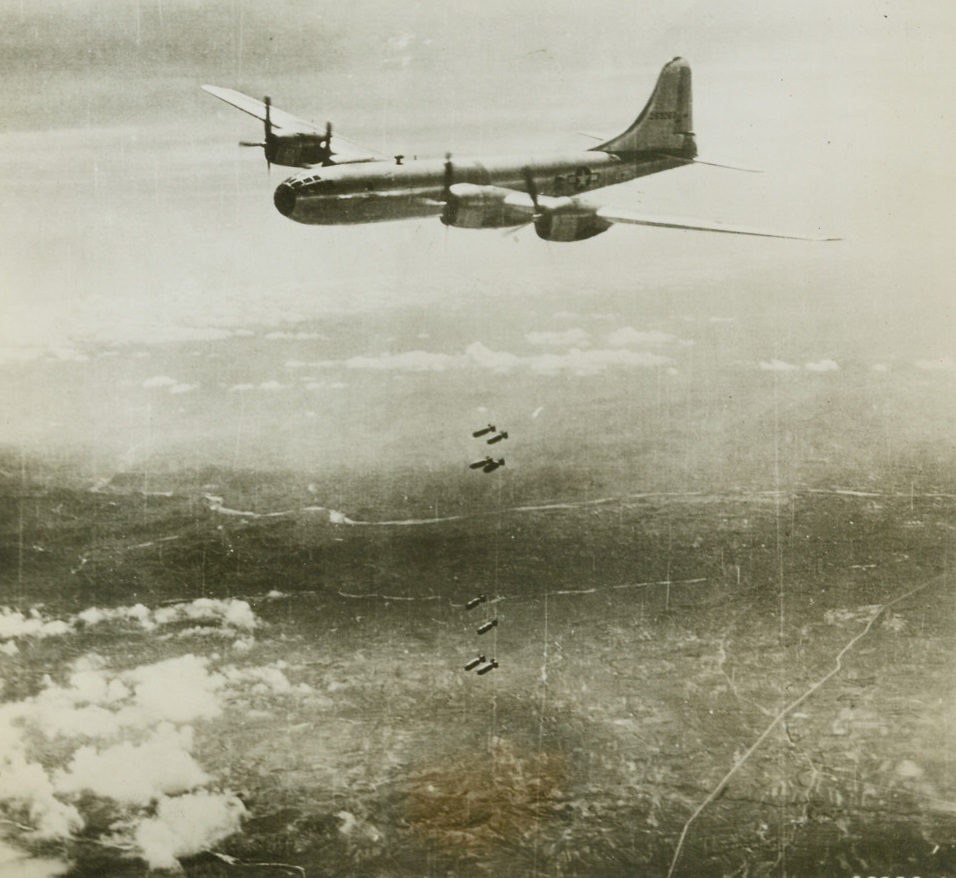
Deadly “Eggs” Drop on Jap Steel Center, 8/29/1944. Anshan, Manchuria – In this, one of the first pictures of the B-29 superfortresses in action over enemy territory, one of the bombers lets loose its load of explosives over the Showa steel works in Anshan in the July 29 raid. The Showa steel works is the second largest integrated iron and steel plant in the Japanese system, and a key unit in Japan’s industrial development of Manchuria. The results of the raid were good, with moderate enemy fighter and anti-aircraft opposition. Credit (official USAAF photo from ACME);
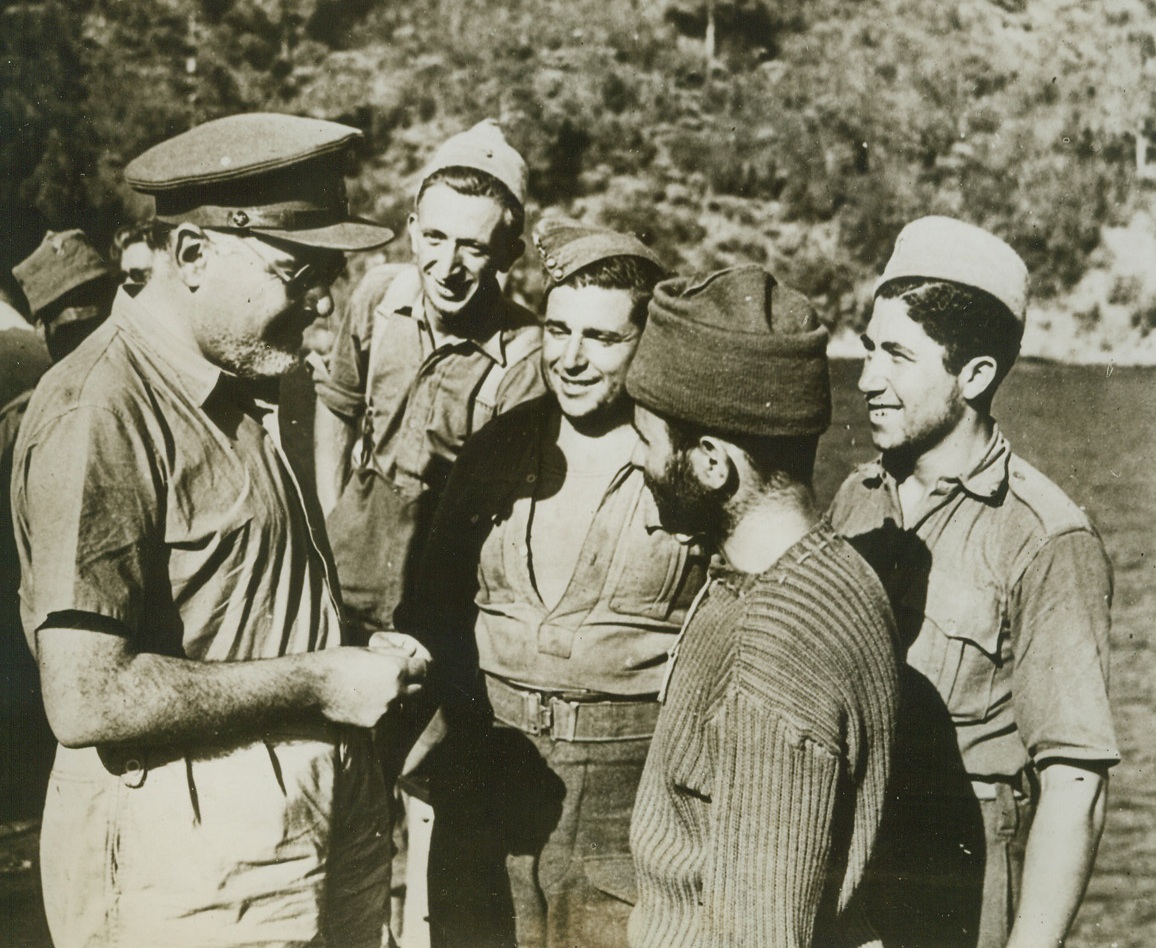
They Harass the Hun -- 1, 8/23/1944. Symi – Specially trained for their work, a small band of British and Greek troops have forced the Germans to maintain thousands of troops, many supply vessels and a large number of guns in the Aegean islands. Striking swift and deadly, patrols of this detachment have made 20 raids into the heart of the enemy-held islands. In one action they liquidated the entire garrison guarding one island. Here, greek members of a raiding unit gather about their Colonel Taigantes for briefing on the island of Symi.Credit line (British official photo from ACME);
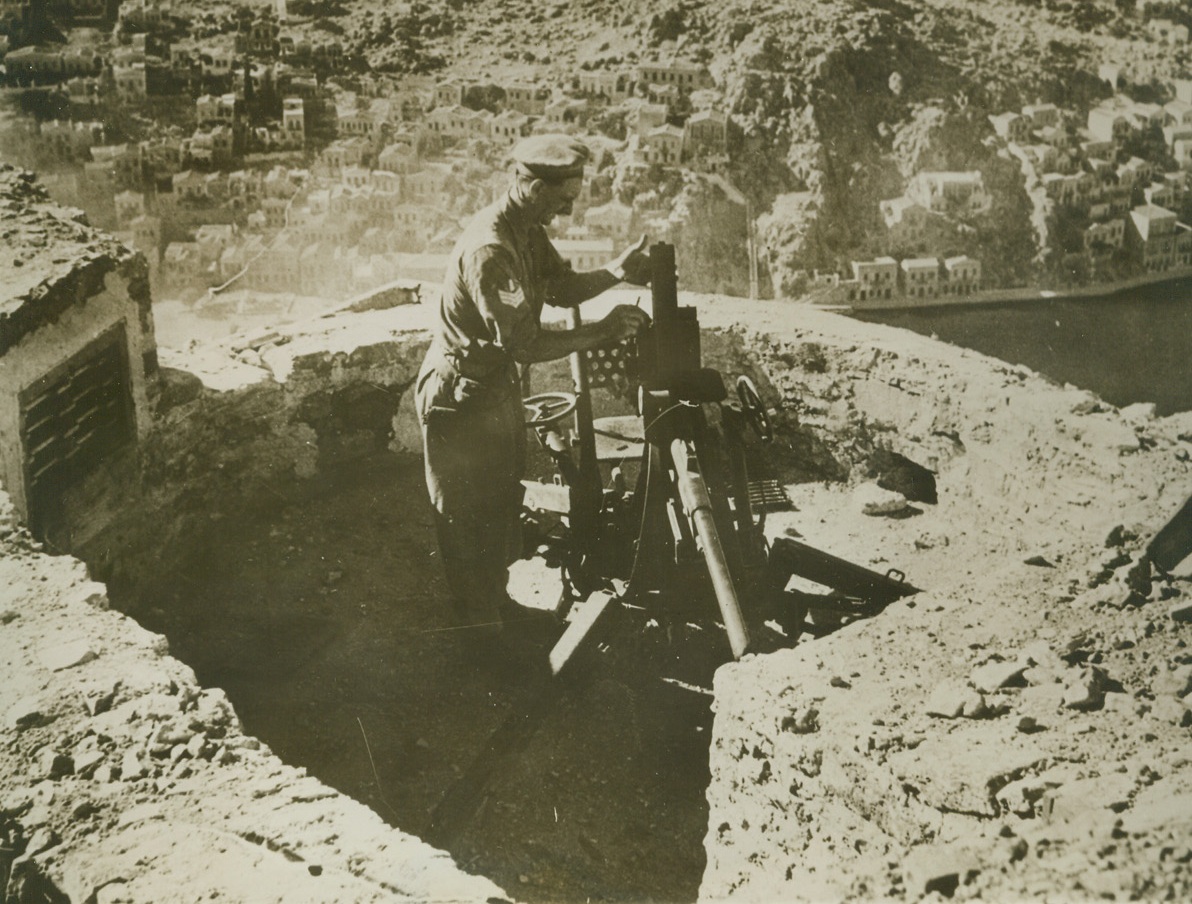
They Harass the Hun -- 2, 8/23/1944. Symi – Specially trained for their work, a small band of British and Greek troops have forced the Germans to maintain thousands of troops, many supply vessels and a large number of guns in the Aegean islands. Striking swift and deadly, patrols of this detachment have made 20 raids into the heart of the enemy-held islands. In one action they liquidated the entire garrison guarding one island. In this gun position overlooking Symi harbor, a sergeant sets his charge. A few moments after photo was made nothing remained of the Nazi position.Credit (British official photo from ACME);
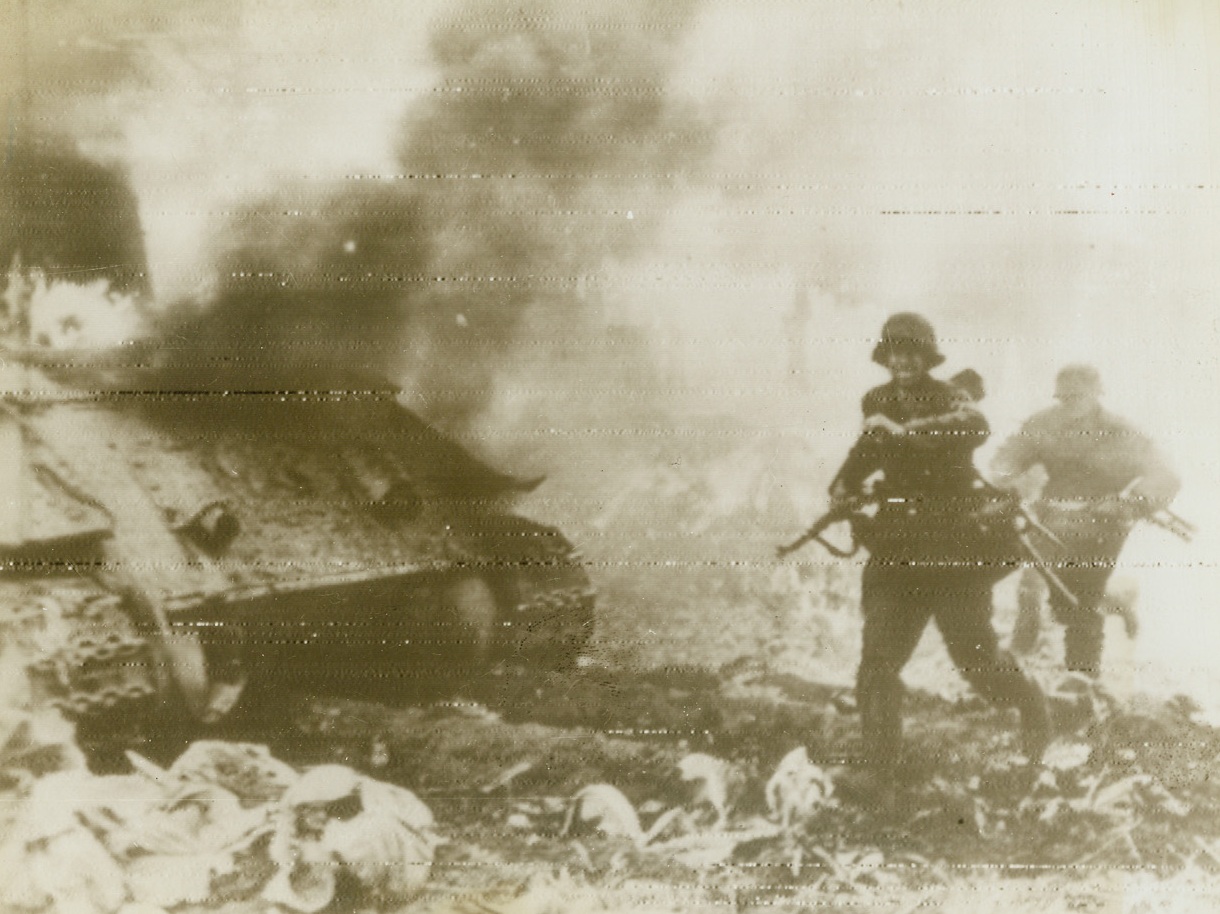
In the Midst of Battle, 8/23/1944. On the Russian Front—A German Panzer Grenadier dashes past a flaming tank during bitter fighting on the Eastern front. The tank was blasted by Russian trench mortar fire. Photo radioed to New York today (8/23) from Stockholm. Credit: ACME radiophoto.;
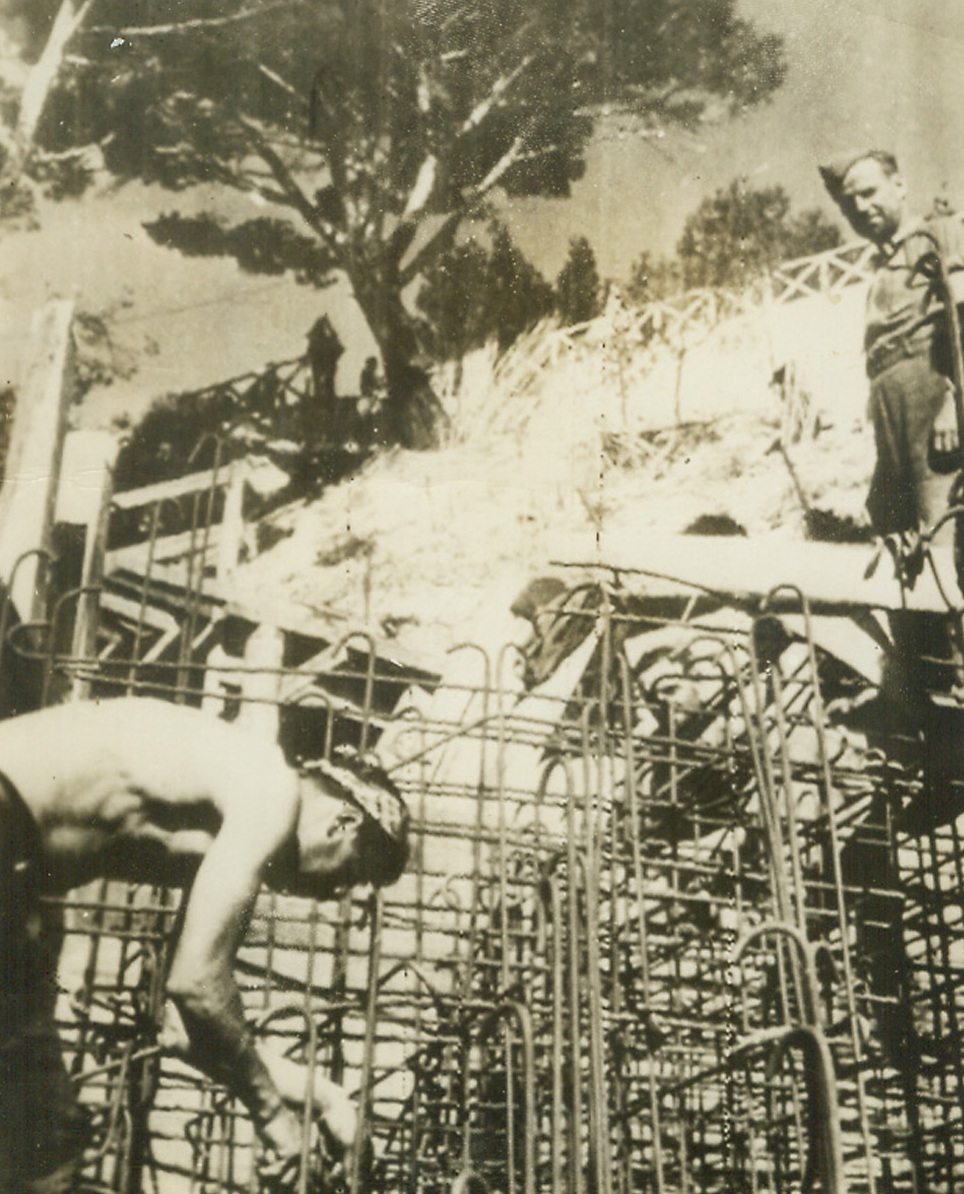
Defenses That Failed, 8/16/1944. France—The German caption describes this photo as “men working on partially completed Nazi defenses along the French Mediterranean coast” where Allied forces staged their surprise landings on August 15th, meeting no united resistance. Photo was radioed toNew York from Sweden today. Credit: ACME radiophoto.;
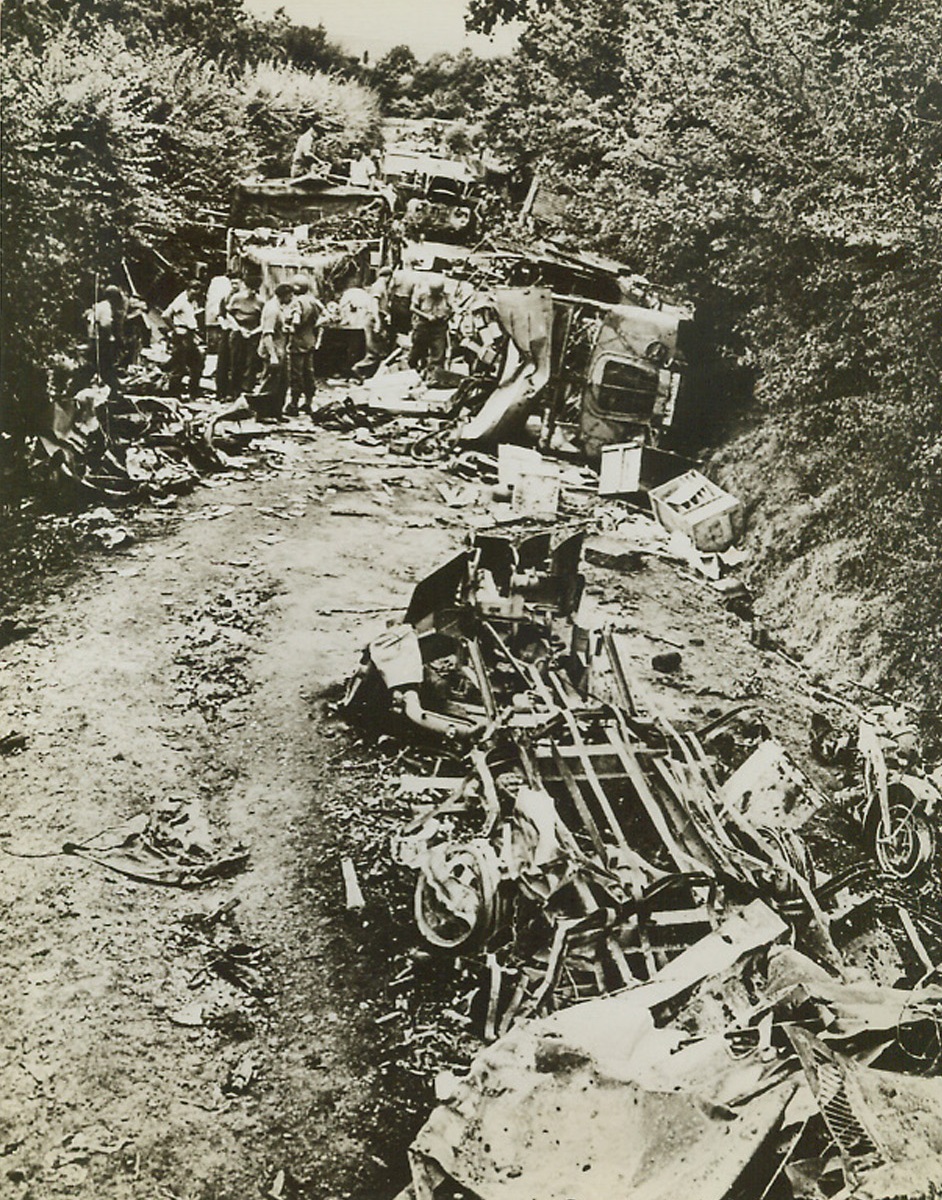
No Title. 8/30/1944.
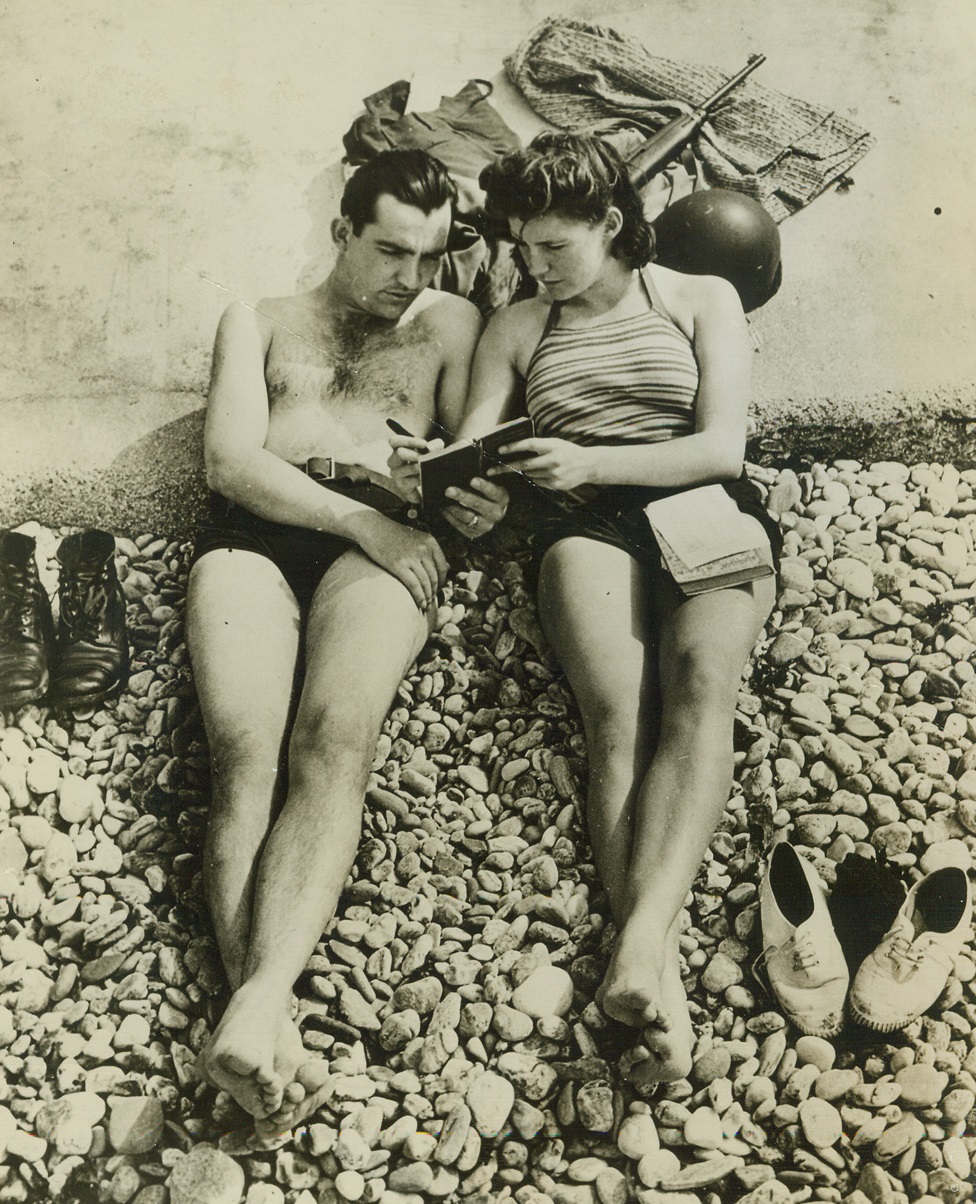
The Mamselle Gives a French Lesson, 8/12/1944. Cherbourg, France – On the rocky beach at Cherbourg, a 17-year-old French girl, Paule Marie Truffert, gives a French lesson to Sgt. Edward Watson, Terre Haute, Indiana, a member of the American forces who captured Cherbourg. Paule, who lived with her family in Cherbourg before the occupation, was sent to Valognes in May 1943 to live with her grandmother. When Yanks recaptured the port city she returned via an American jeep. Paule is a great friend of the GI’s, and now seeks a position as interpreter for the Civil Affairs Committee. She wants to start a 7-year medical course in Paris this fall. Credit: ACME;
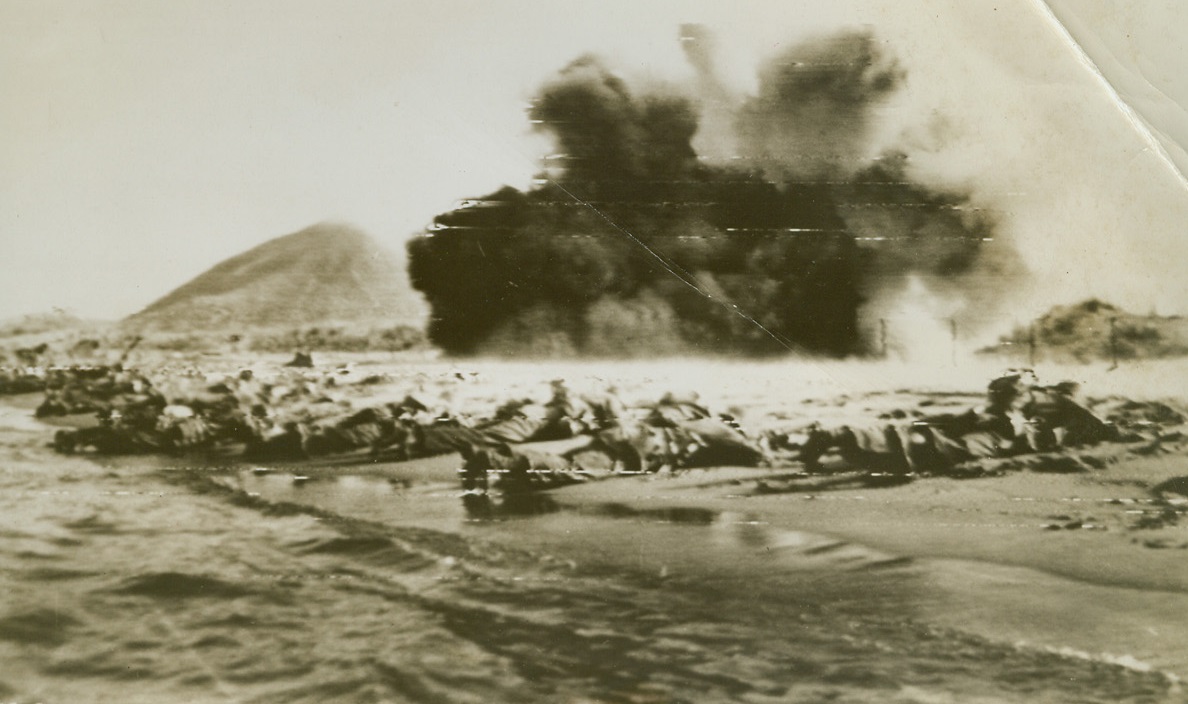
Invasion Practice for Yanks, 8/15/1944. U.S. Infantrymen lie flat on their faces in the sand, as their Bangalore torpedoes explode, shredding “enemy” barbed wire barriers along this “invasion” beach. This scene was, and is being reenacted along the shore of Southern France, as Allied forces pour ashore to establish the fourth front. Credit: Army radiotelephoto from ACME.;
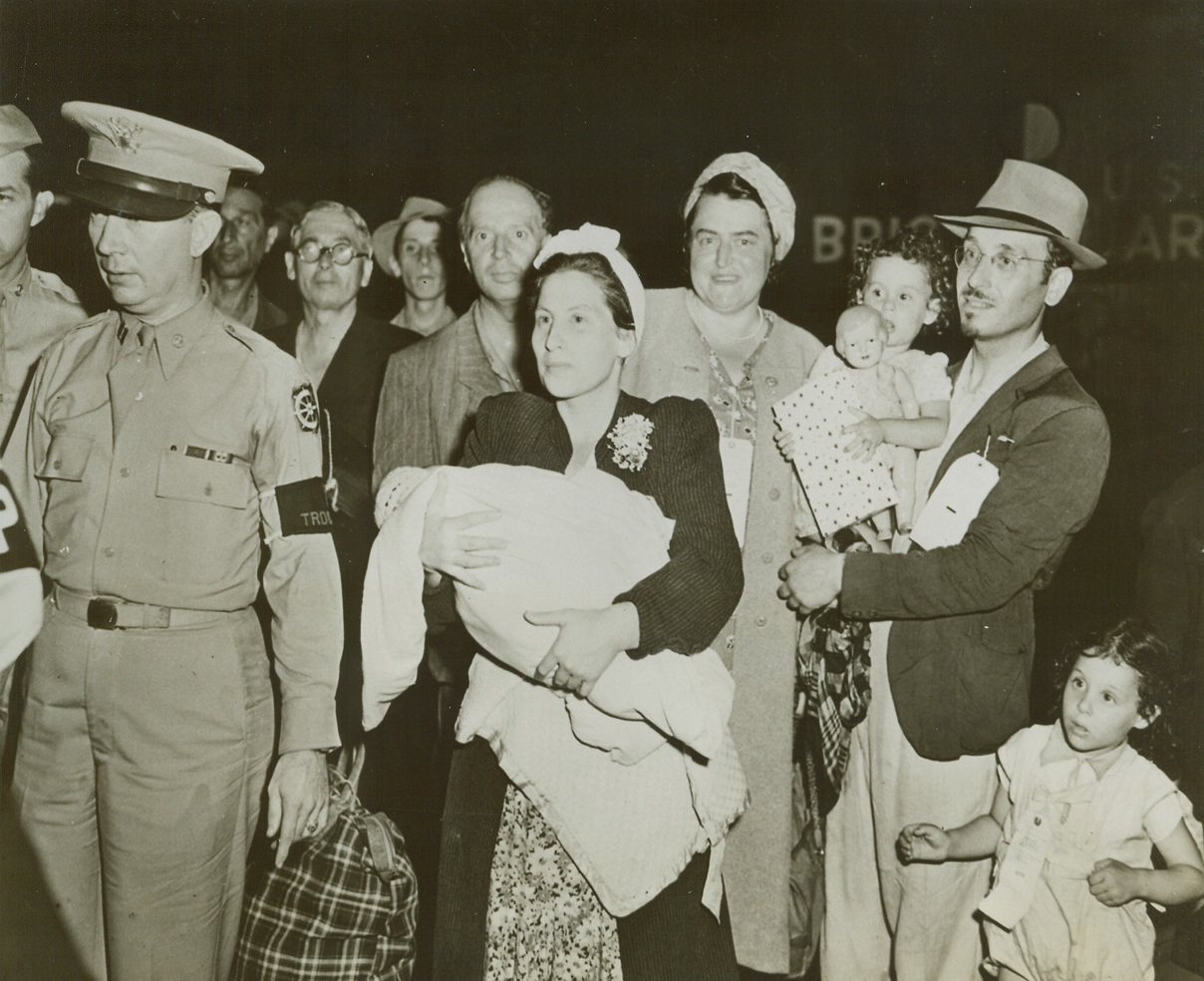
Free and Happy, 8/4/1944. Hoboken, New Jersey -- Headed for the train that is to carry them to Fort Ontario near Oswego, New York, is this family, part of almost 1,000 refugees from Italy who will remain in this country for the duration of the war. They are (left to right): Mrs. Netta Rothchild, holding her four-weeks old daughter Gratzia; and Mr. Isreal Rothchild, carrying his daughter Reneta as another daughter, Fanny, walks beside him. Credit: ACME;
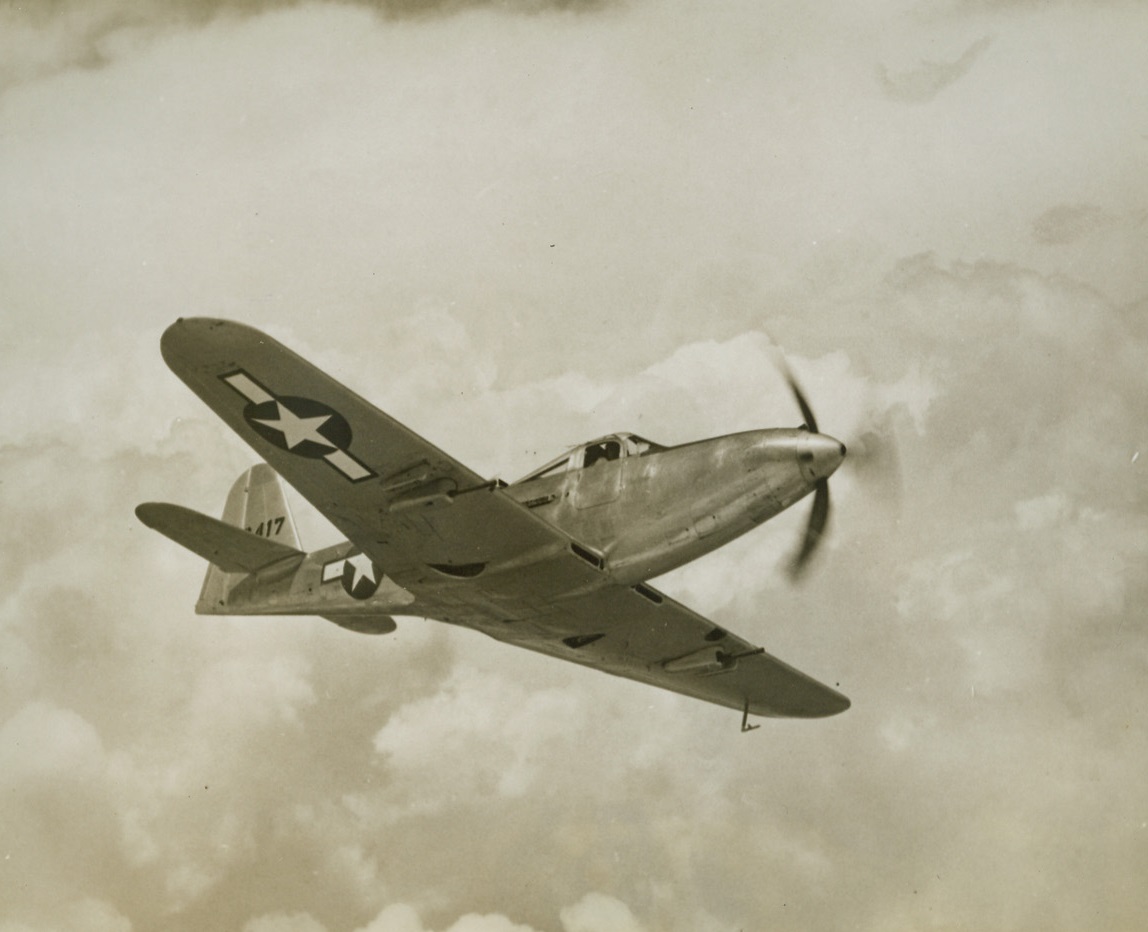
King Cobra of the Sky, 8/3/1944. Buffalo, New York -- Most recently announced addition to Allied air might is the P-63 King Cobra, manufactured by Bell Aircraft Corporation at Buffalo, New York. With a speed considerably in excess of that of its predecessor, the P-39 Airacobra, the sleek new plane pictured above has an official combat radius that is expected to permit it to range far over Axis territory. Mounting a hard-hitting 37mm. cannon and two .50 caliber machine guns in the nose as well as two additional .50 caliber machine guns in the wings, the P-63 is powered with a 1500 horsepower engine to give it increased speed and efficiency at high altitude. Credit: ACME;
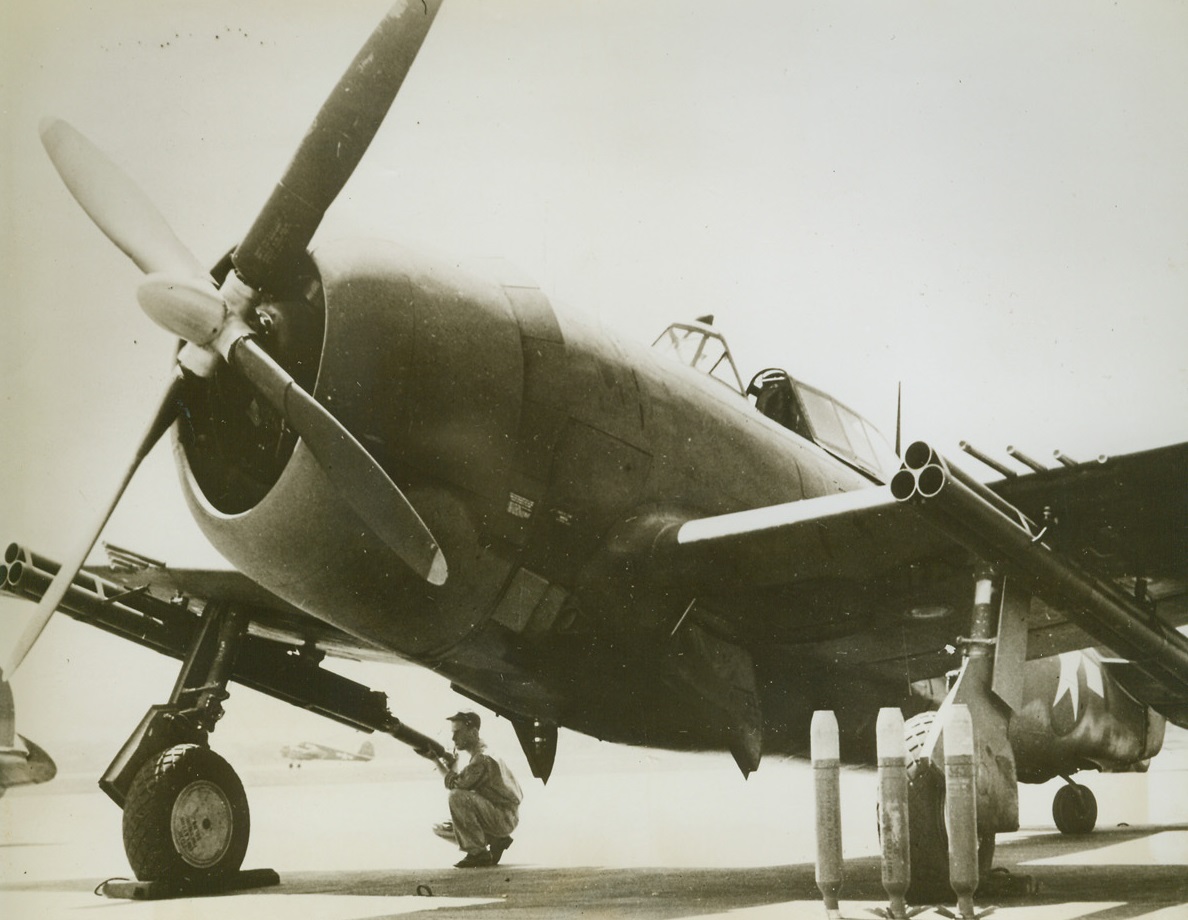
Thunderbolt Bristles with Guns, 8/1/1944. A soldier loads a projectile into the rocket armament of the far wing of a P-47 Thunderbolt. This plane is a deadly weapon of war with its eight .50 caliber machine guns and new rocket armament. Here is a closeup of the plane with its machine guns and the rocket gun armament under both wings. Three of the rockets are standing on end before a wheel of the plane. Credit: USAAF photo from ACME;
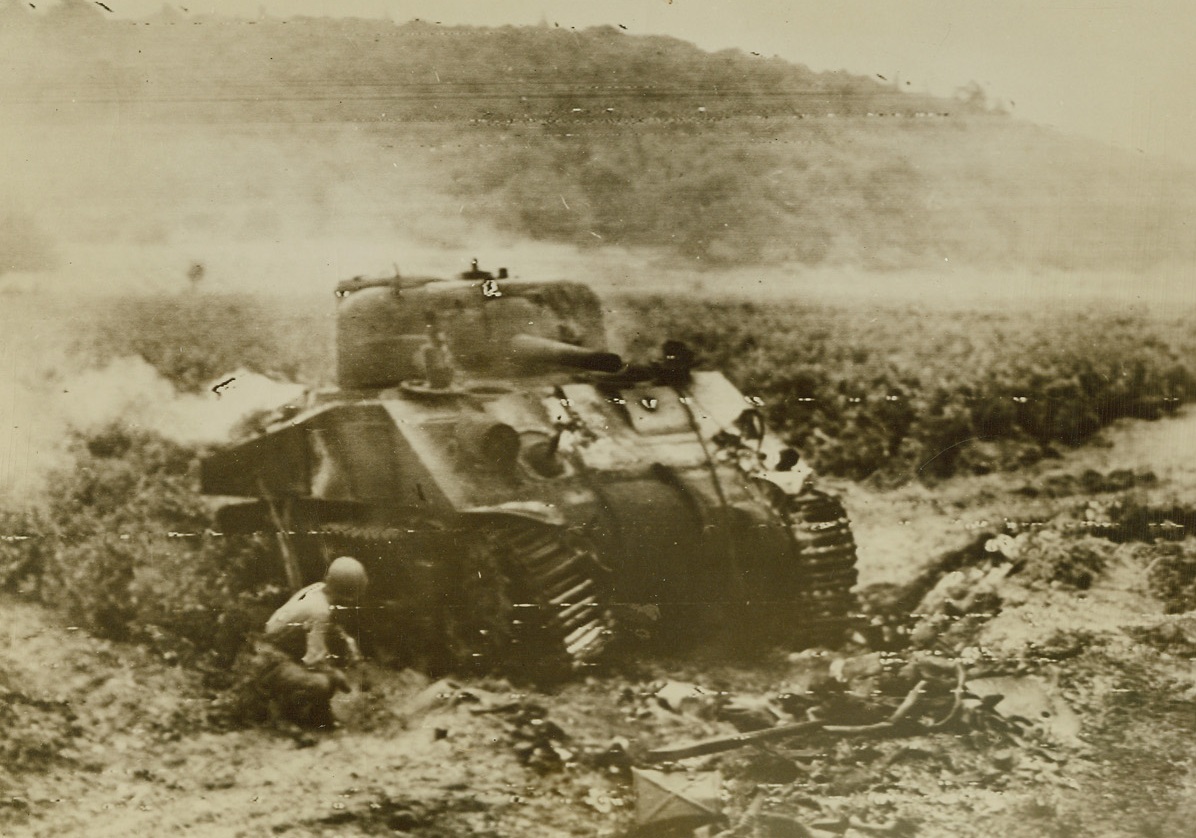
Almost a Rarity, 8/20/1944. Southern France -- A Sherman tank, which has been knocked out by a German 88, burns in a field near a town in Southern France. A U.S. soldier seeks cover beside the smoking hulk. Credit: US Army photo from ACME;

Enroute to Pincer the Germans, 8/20/1944. Flers, France -- Townspeople in the bomb-wrecked, shell-ridden town of Flers line the streets to cheer British soldiers who move on in their “General Sherman” tanks to close the gap at Falaise and trap the German forces fleeing toward Paris. This is a British War Office photo. Credit: US Army photo from ACME;

BOMBS HIT TOULON, 8/23/1944. FRANCE – Bombs from B-25 Mitchells of the tactical air force strike their targets below in the Toulon harbor, France. Direct hits were scored on the German battleship “Strasbourg,” sank a submarine and severely damaged a cruiser.Credit: Acme;
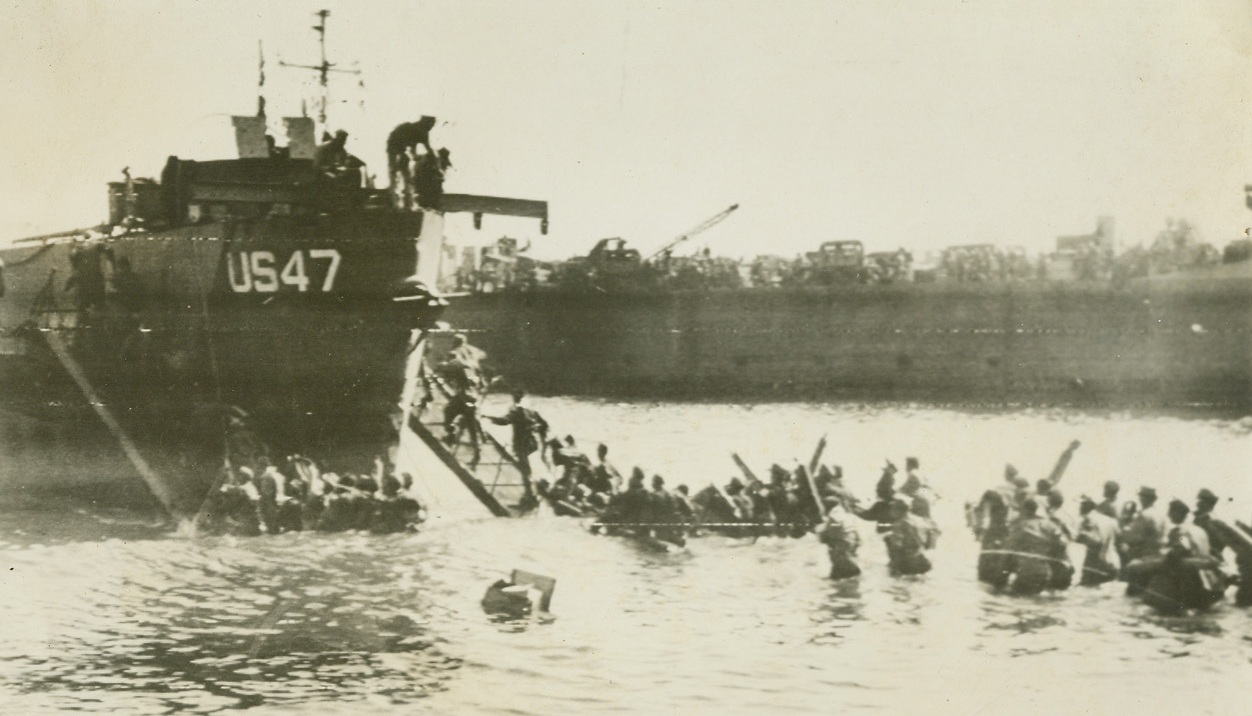
EVACUATE NAZI PRISONERS FROM S. FRANCE, 8/18/1944. FRANCE – Wading waist deep in water, long lines of Nazi prisoners are herded onto landing craft for the trip to Allied prison compounds. They are part of the 7,000 Nazis captured in the first few days of the invasion of Southern France.;
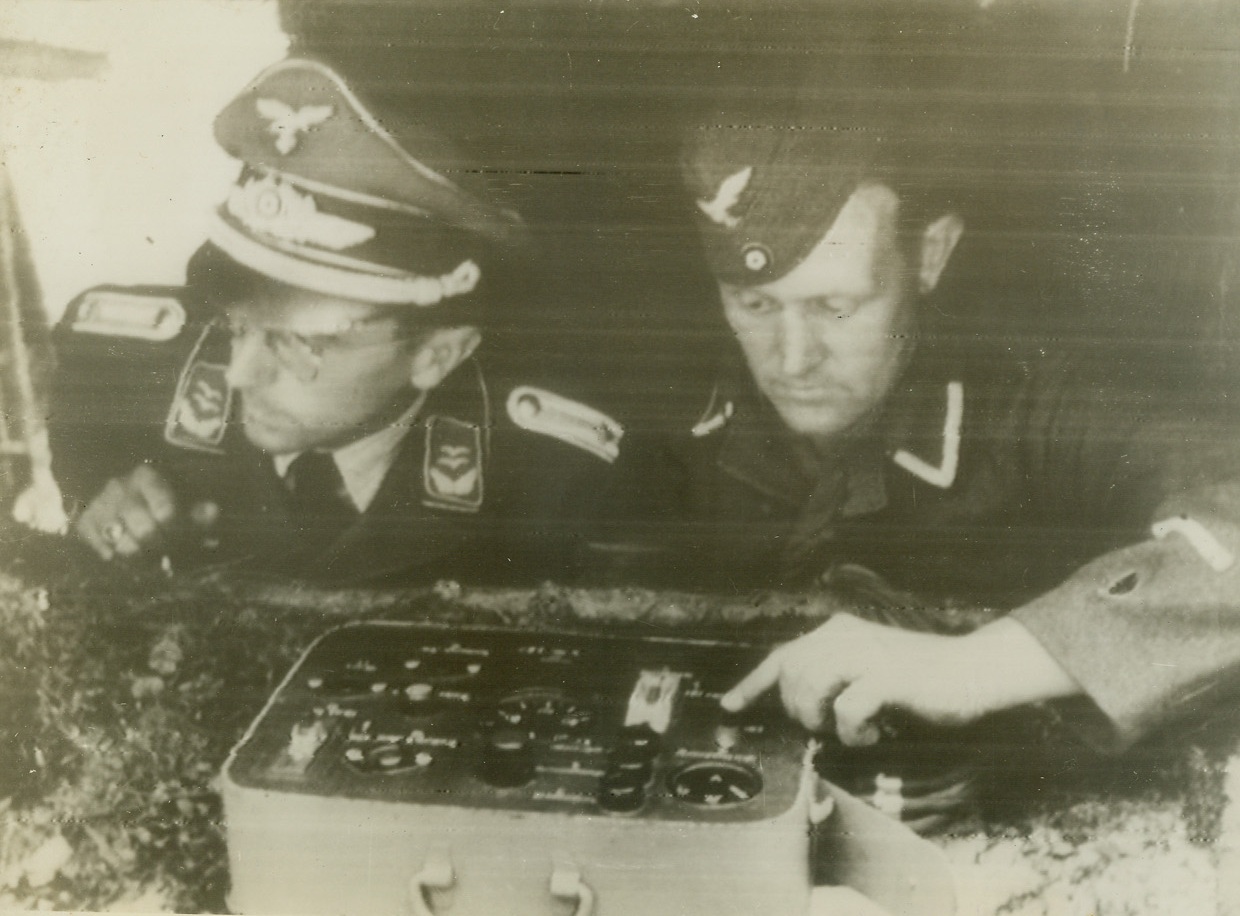
THE MEN BEHIND THE BOMBS, 8/17/1944. FRANCE – In this photo, radioed from Stockholm today (August 17), two Nazi soldiers, one with his finger on the button, are operating the switchboard which releases the flying bombs somewhere in France. According to the German caption, the bombs are being directed against London.Credit: Acme;
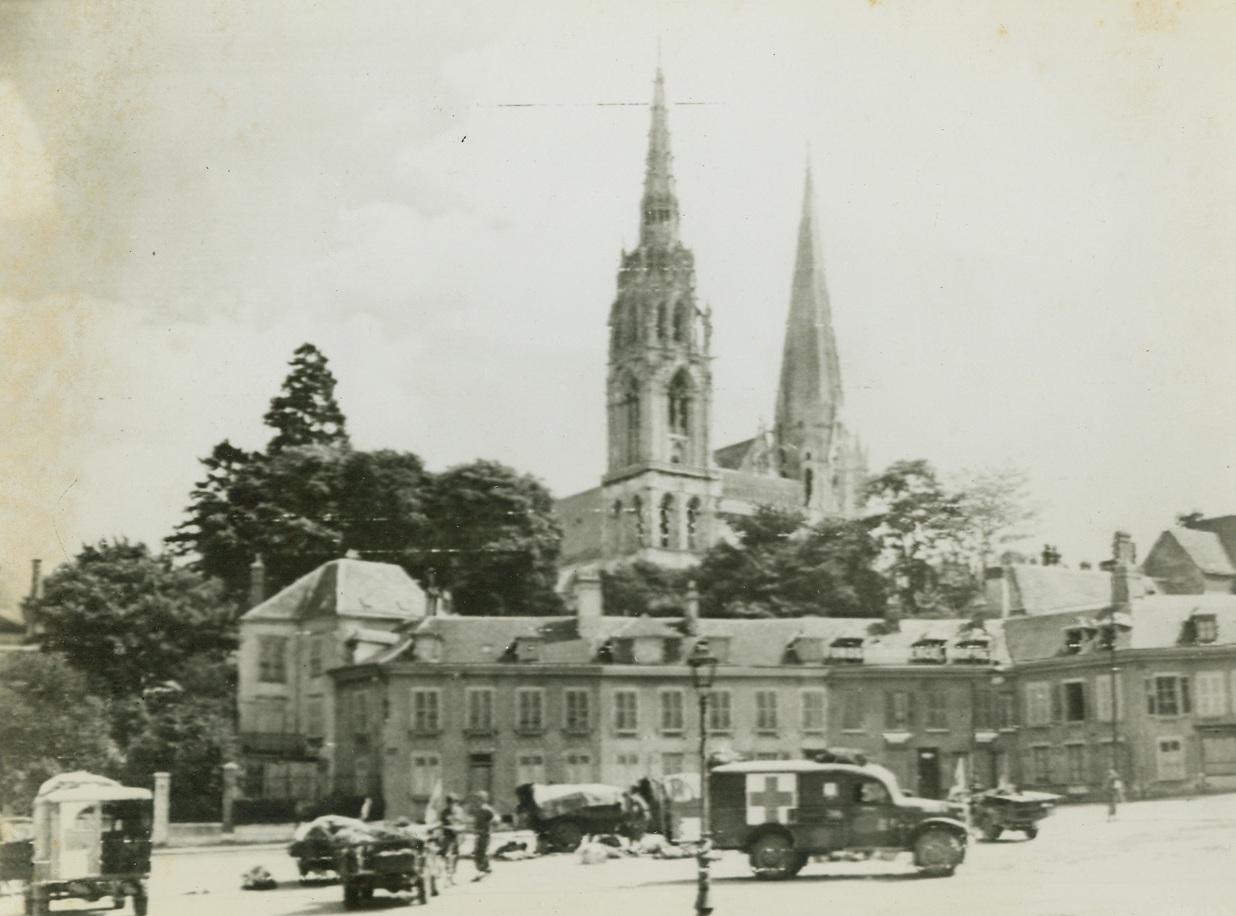
YANK MEDICS AT WORK IN CHARTRES, 8/22/1944. FRANCE - - Working in the shadow, of the famous 12th century Cathedral in Chartres, Yank medics give aid to wounded before continuing the push Eastward toward and beyond the Seine. Credit: Army Radio telephoto from Acme;
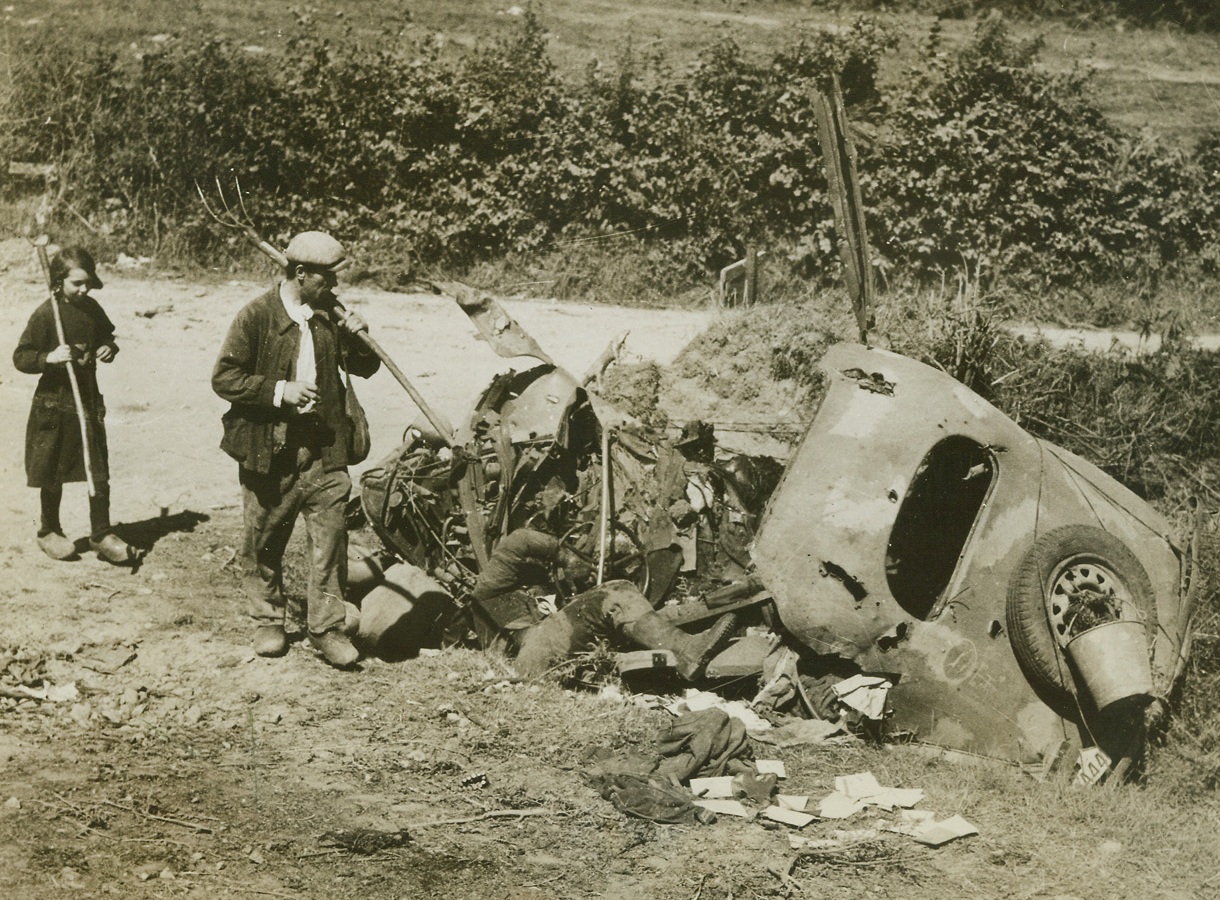
GRIM REMINDER OF WAR, 8/22/1944. MORTAIN, FRANCE – On their way to the fields this French peasant and his little girl pass a Nazi staff car and its dead driver, caught by shell fire at a crossroads near Mortain. Accustomed to such sights, the two give it only a passing glance.Credit: Signal Corps photo from Acme;
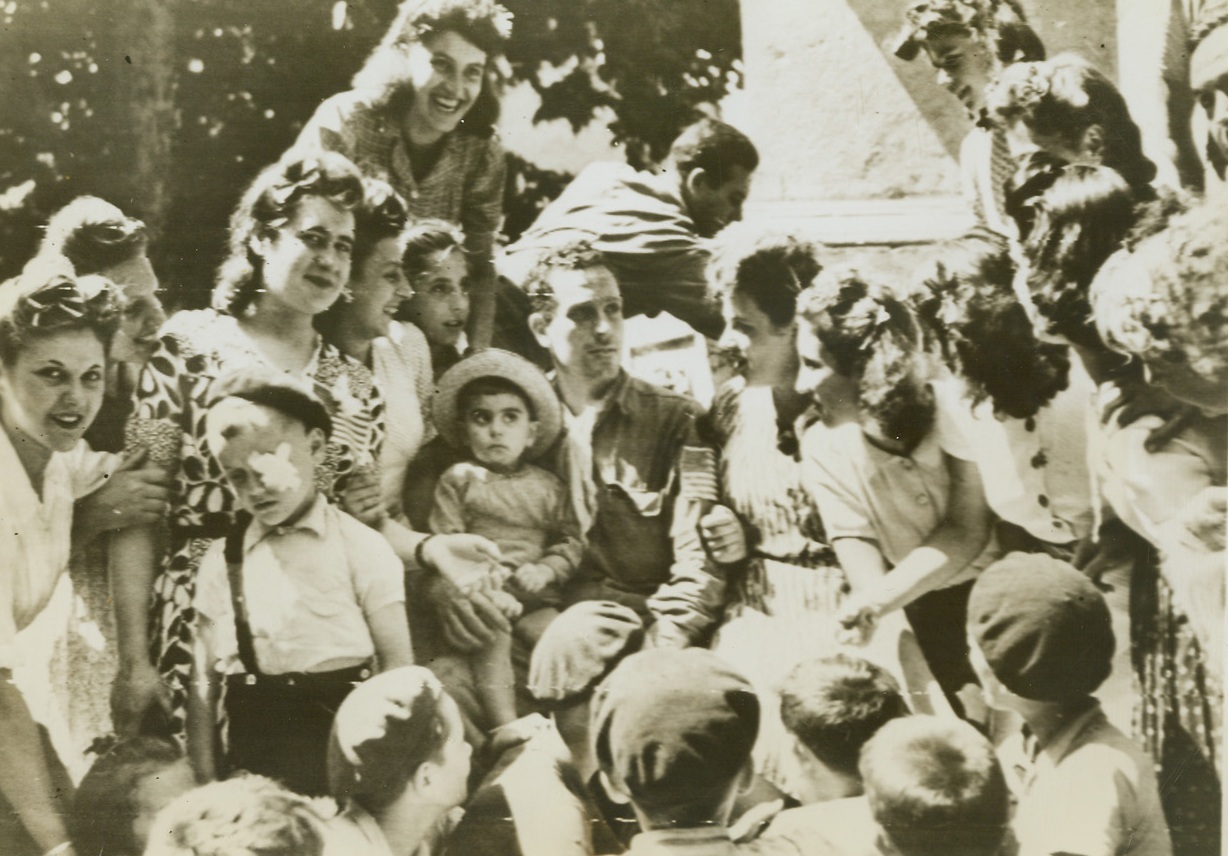
A RIGHT WELCOME WELCOME, 8/22/1944. FRANCE – Completely surrounded by lovely girls and curious French tots, an American soldier seems embarrassed? At the situation he is in. Scene took place far inland from the South coast of France at Riez, where the entire population greeting passing American troops driving Northward beyond the city.Credit: Army radio telephoto from Acme;
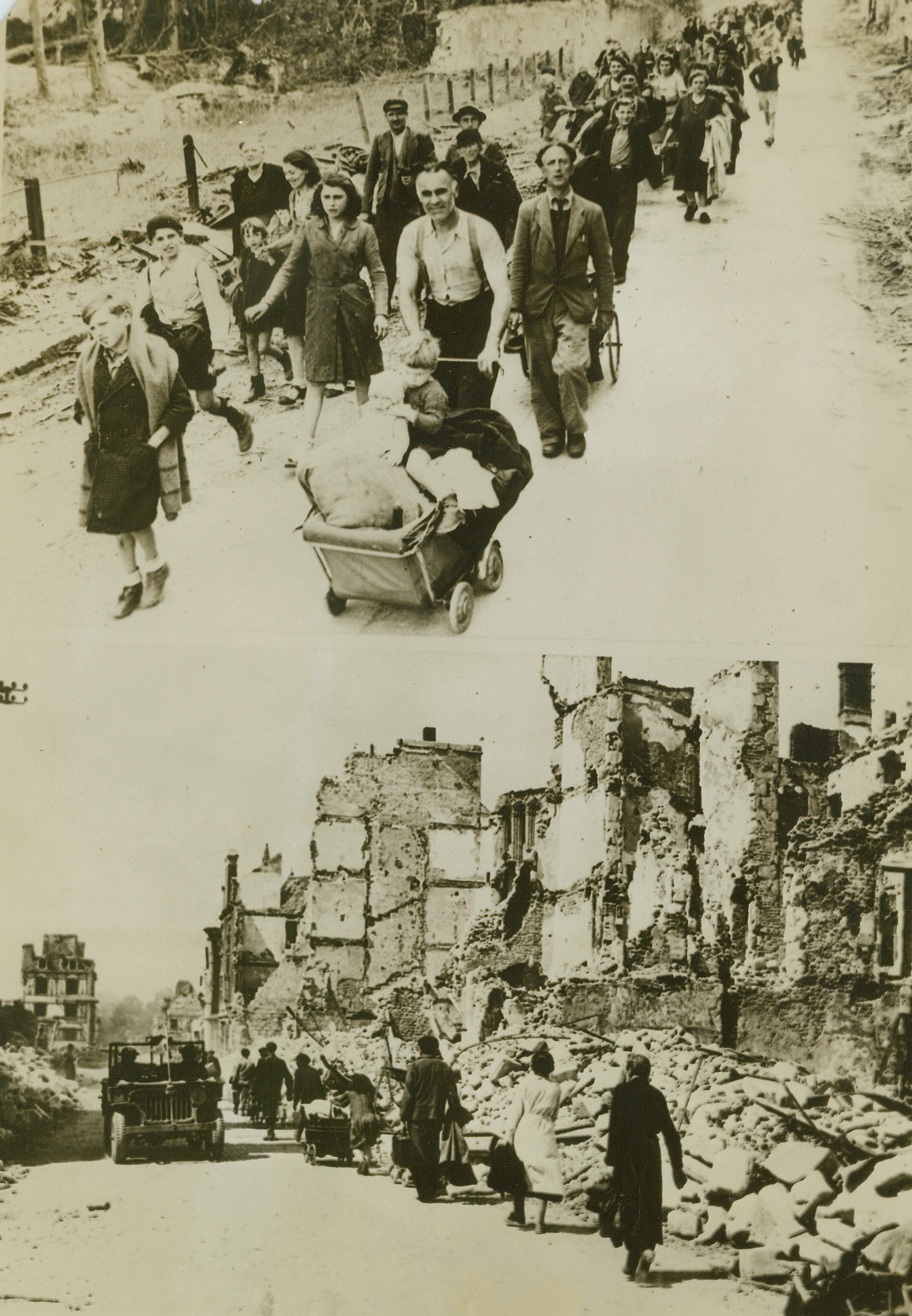
THE HAPPY ROAD HOME, 8/23/1944. FALAISE, FRANCE - - Although they know that their homes will probably be in ruins, these residents of Falaise are nevertheless happy to return to the liberated town. At top, the line of returning refugees stretches as far as the eye can see. At bottom, the innocent victims trudge past bomb-torn buildings.Credit: Acme;
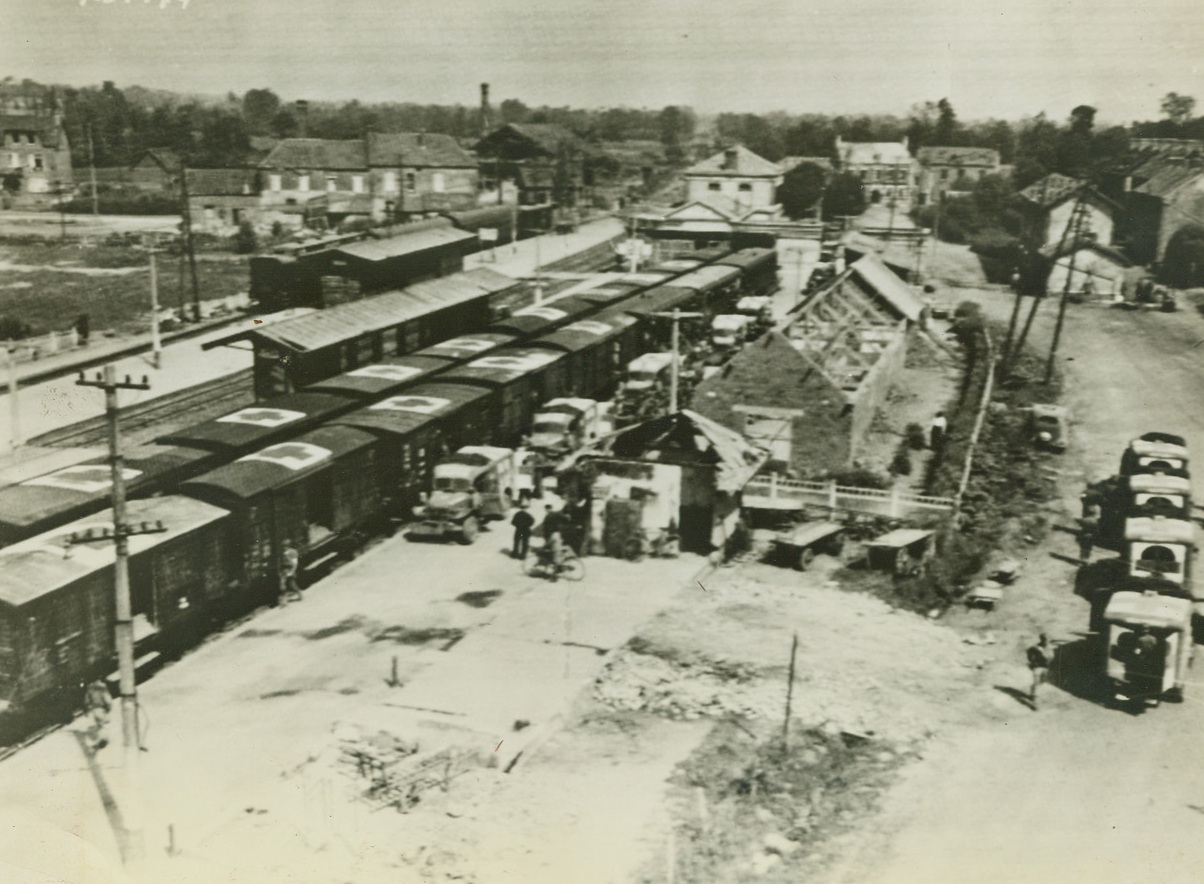
LOADING FIRST HOSPITAL TRAIN, 8/8/1944. FRANCE – The first allied hospital train to operate in France since D-day, is loaded with wounded from ambulances, at Lison. The train is made up of boxcars left by fleeing Germans. Wounded are taken to Cherbourg on their way to England. Credit: Army radio telephoto from Acme;
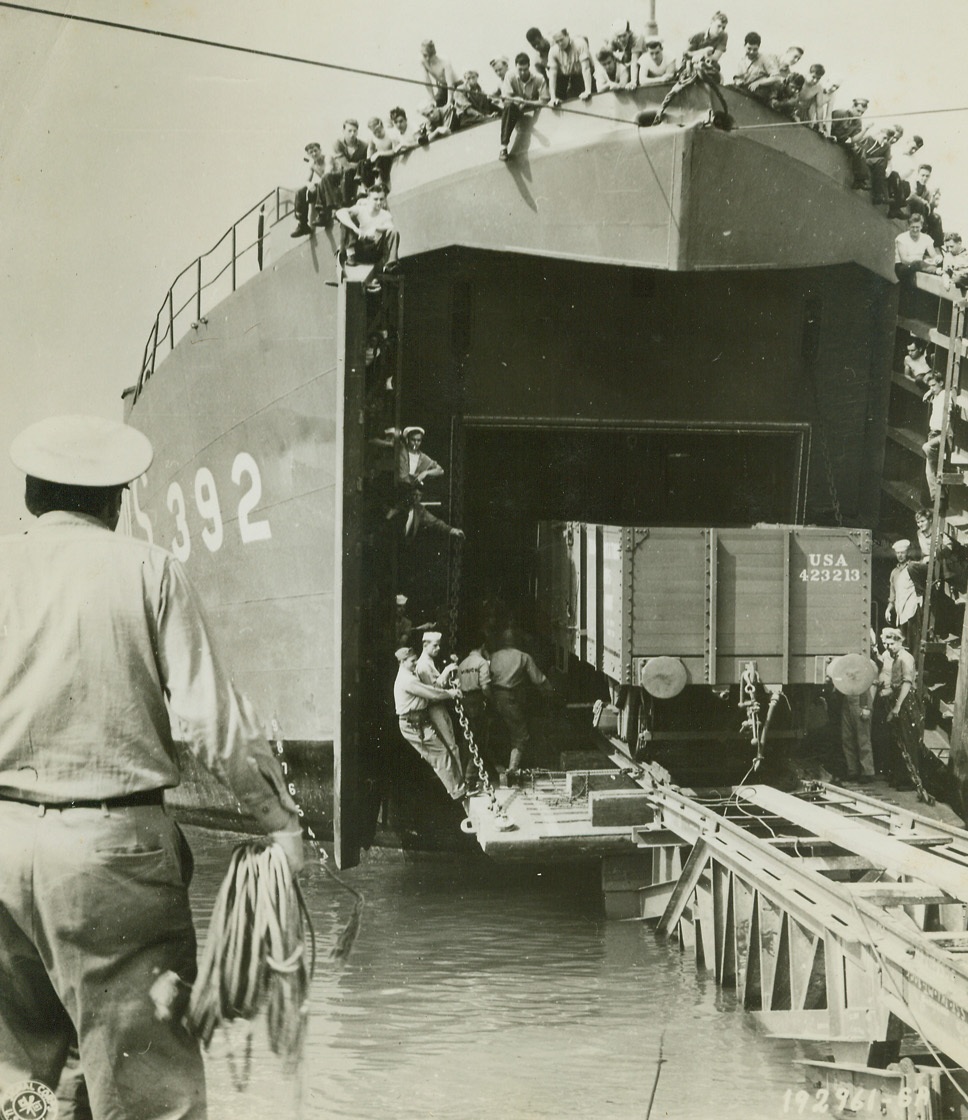
TAKE A TRAIN FROM A BOAT, 8/29/1944. FRANCE – In the first such attempt ever made, freight cars are brought ashore at Cherbourg harbor from an LST. A specially constructed ramp made of railway tracks, facilitates the job. Credit: Signal Corps photo from Acme;

POLISH TROOPS JOIN ALLIES IN FRANCE, 8/15/1944. FRANCE – This photo, the first of its kind, shows Polish troops in action with the British and Canadian soldiers on the Normandy front. Sgt. McVay (2nd from left), shares a joke with Polish comrades before setting off to join the attack South of Caen. Credit: British War office photo via army radio telephoto from Acme;
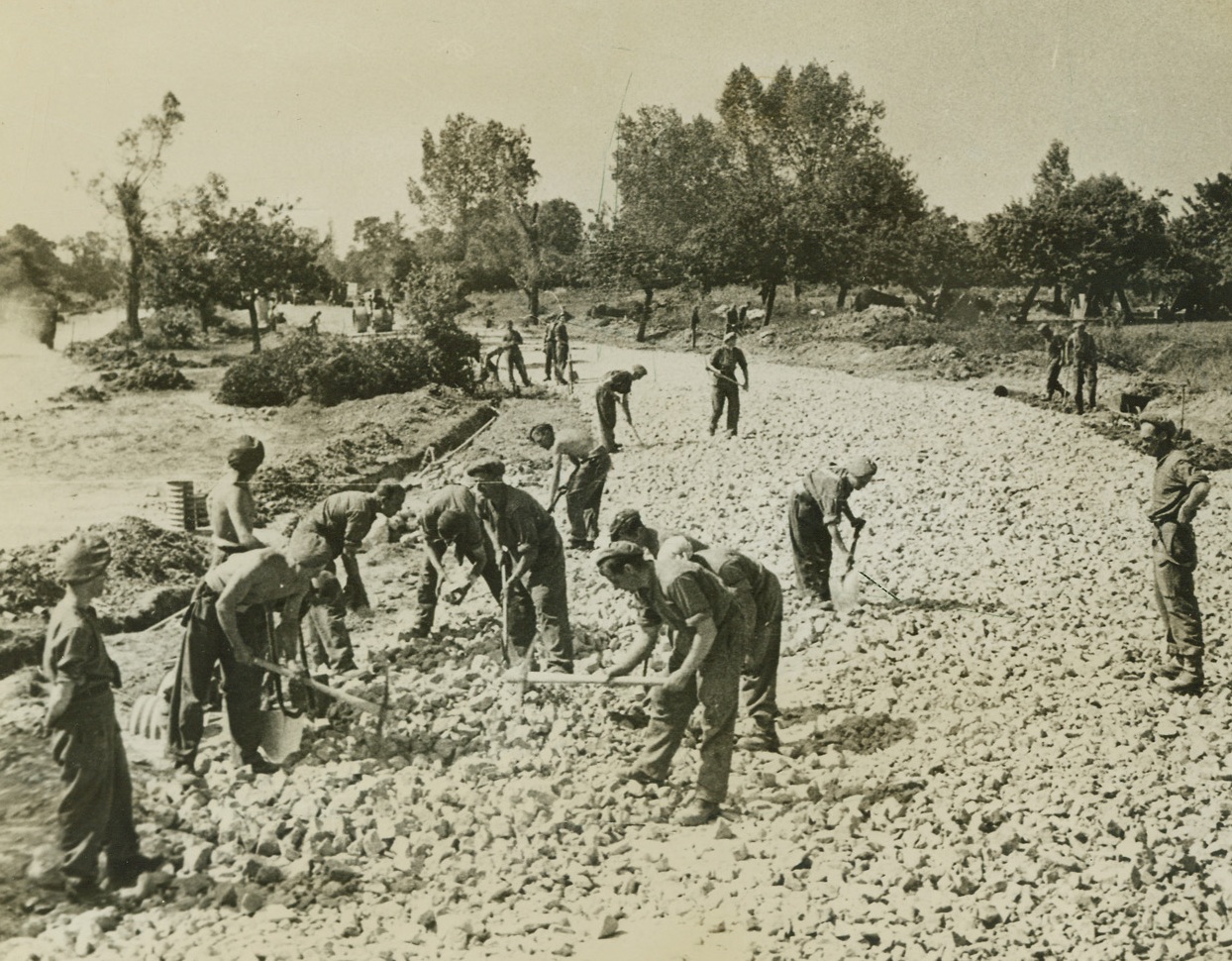
TO KEEP ‘EM ROLLING, 8/15/1944. FRANCE – British Royal Engineers, using stone from damaged buildings and flint limestone from the stock of a former German factory near Colombelles, repair a stretch of road near that city. Credit: British official photo from Acme;
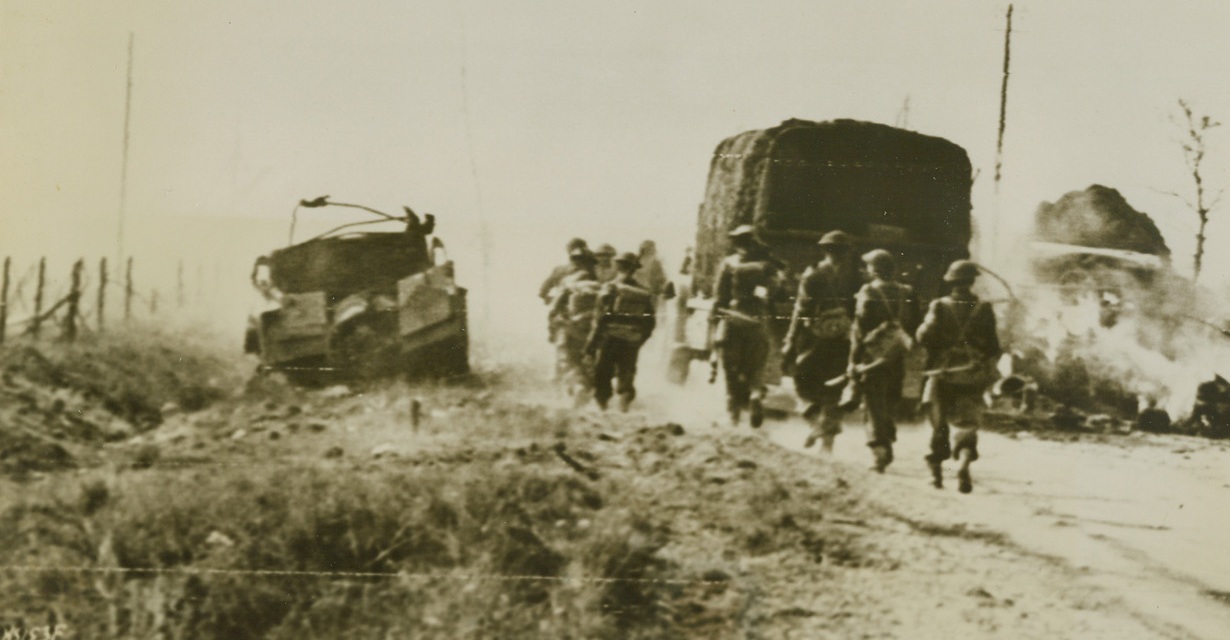
SOUTH TO FALAISE, 8/12/1944. FRANCE – Canadian infantrymen and army vehicles circle around a vehicle which has been knocked out by the side of the road, as the Canadian Army advances South on the road to Falaise. Credit: Canadian official photo via Signal Corps radio telephoto from Acme;
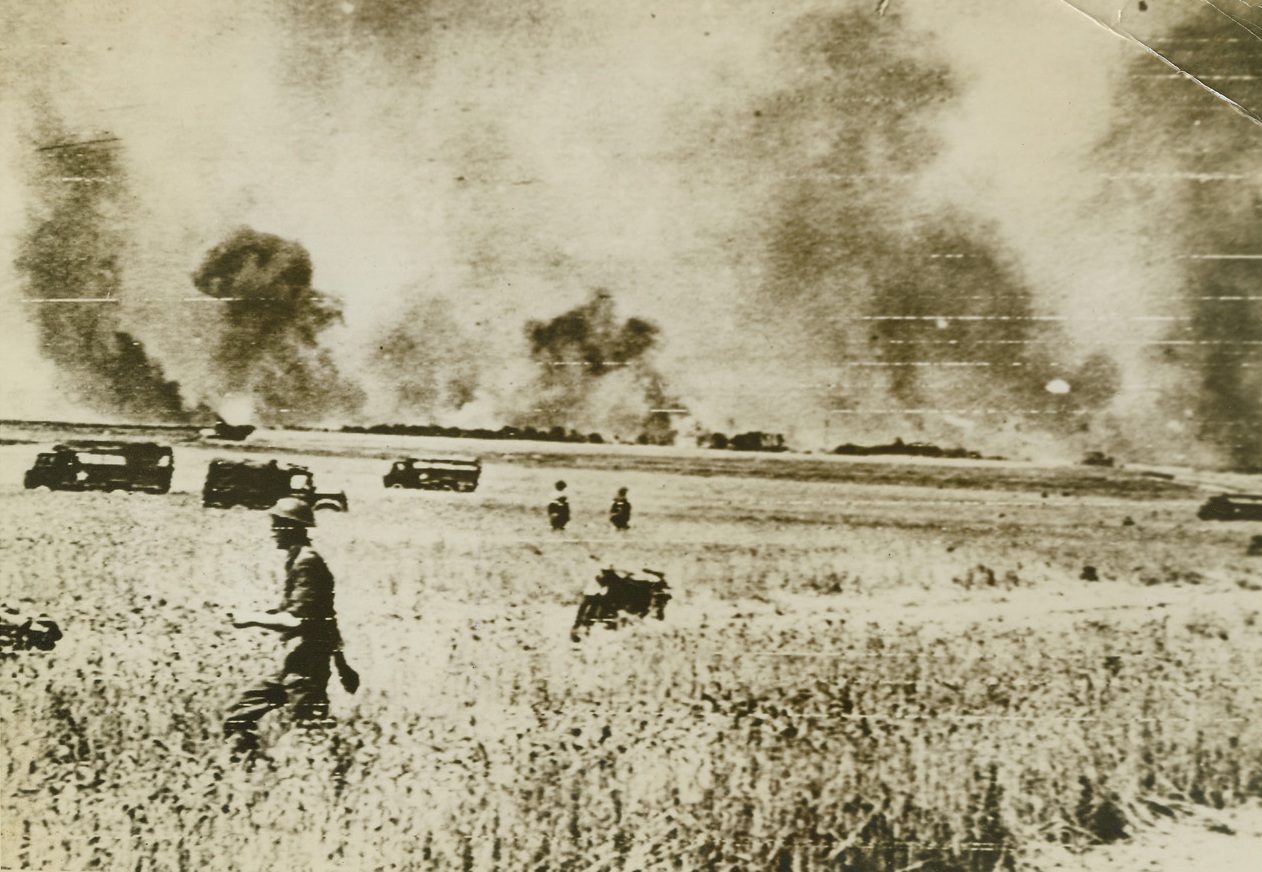
AIR SUPPORT FOR ADVANCING ALLIES, 8/12/1944. CAEN, FRANCE – Bombs burst on German positions South of Caen as fortresses attack after the great RAF raids which softened up the enemy for attack by British and Canadian forces advancing on land. Credit: British official photo via Signal Corps radio telephoto from Acme;
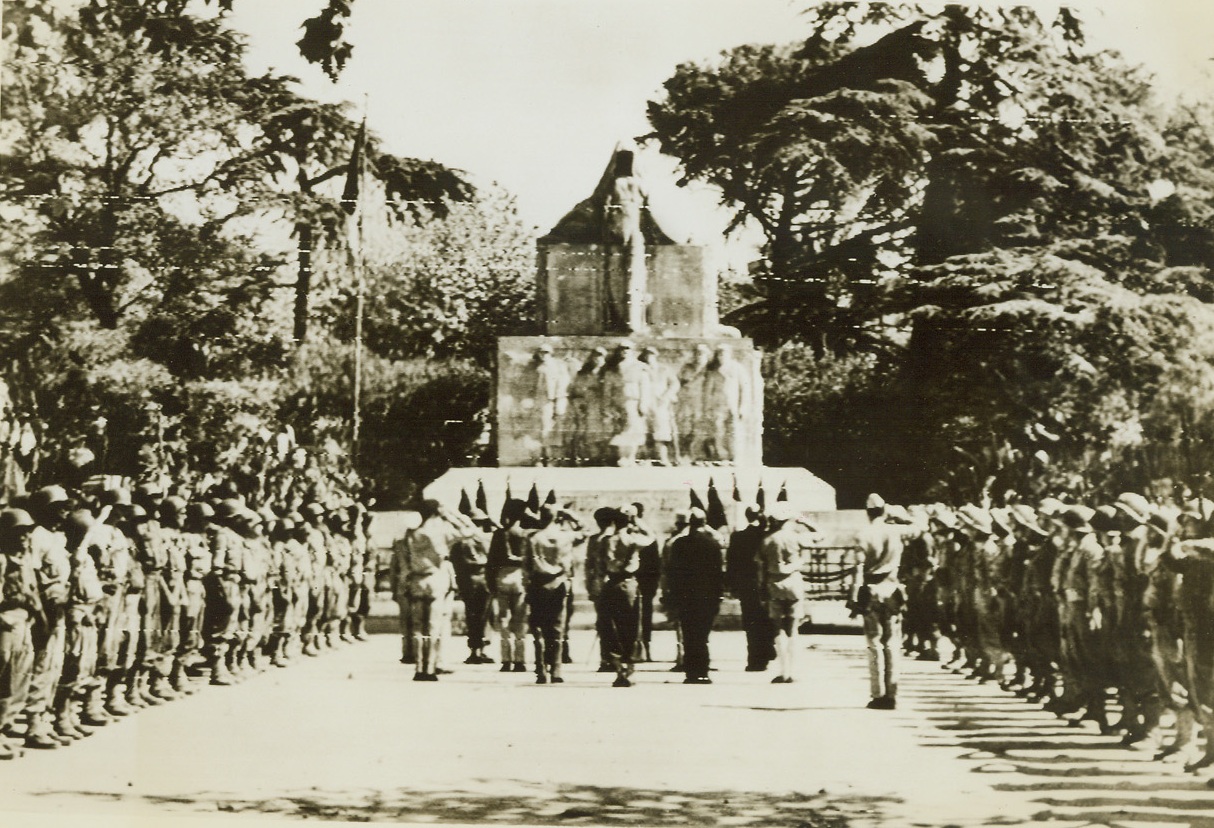
CELEBRATE LIBERATION OF TOULON, 8/31/1944. FRANCE – Highlight of the French military parade commemorating the liberation of Toulon came when General De Latre De Tassigny and his staff paid tribute to the soldiers of World War I at Toulon’s memorial monument in Marechal Foch Square. Credit: Army radio telephoto from Acme;

RESULTS OF YANK BREAKTHROUGH IN BRITTANY, 8/5/1944. FRANCE—Hundreds of German prisoners are marched to the rear after being captured during the initial stages of the current Yank offensive in Brittany.;
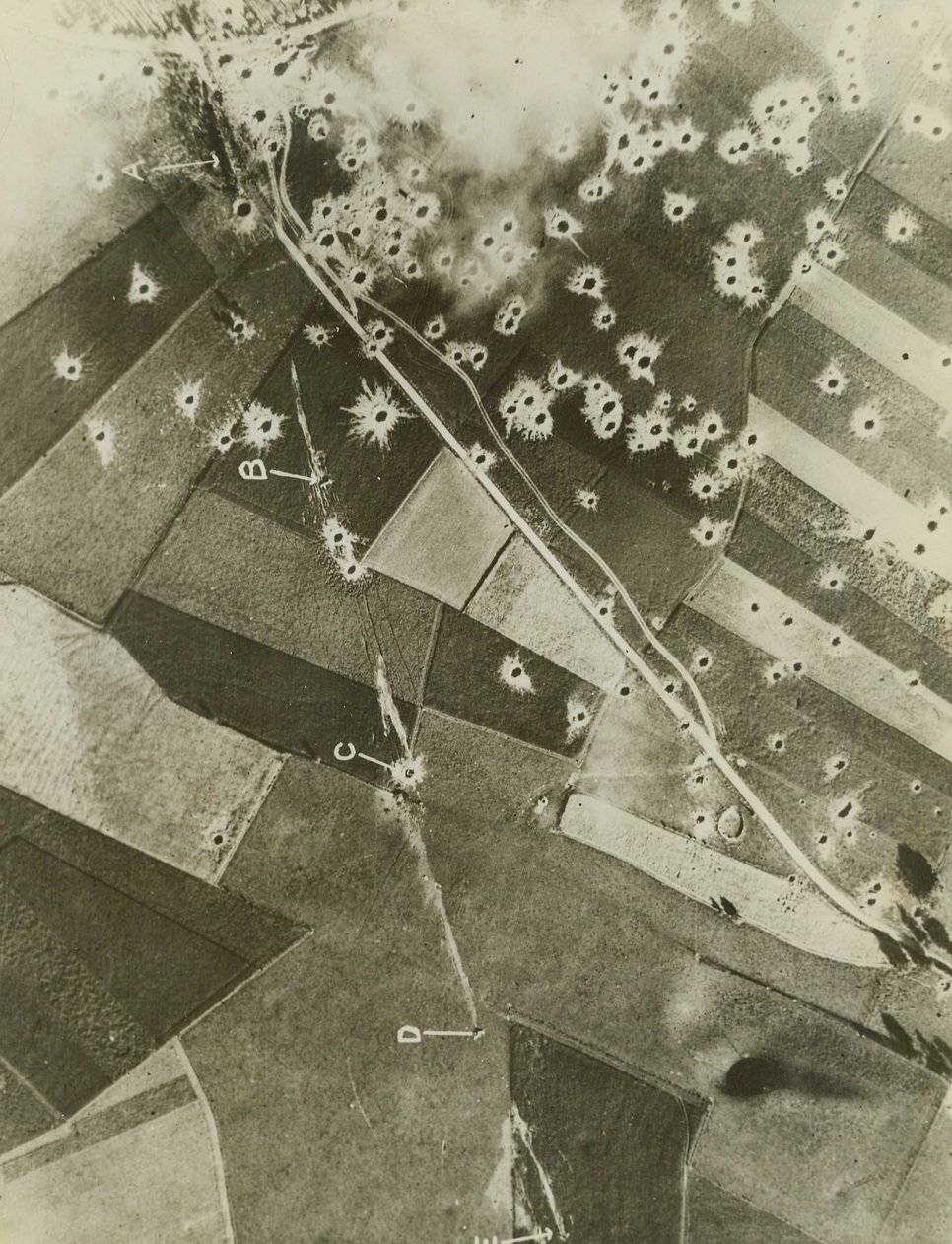
FLYING BOMB SITE BLASTED, 8/15/1944. FRANCE—A reconnaissance photo of a German Robot flying bomb site in the Pas de Calais area which has been attacked by Allied aircraft. Letter A, shows the launching platform surrounded by bomb craters. B,C,D, and E are flying bombs which have crashed on launching. Credit Line (British Official Photo from ACME);

U.S. TANKS CROSS THE ALPS, 8/25/1944. FRANCE—Tank reinforcements push over the French Alps on their way to reinforce an American spearhead which forced a deep wedge into Nazi territory in Southern France. Credit – WP—(ACME Photo by Staff Photographer , War correspondent, via Army Radiotelephoto.);
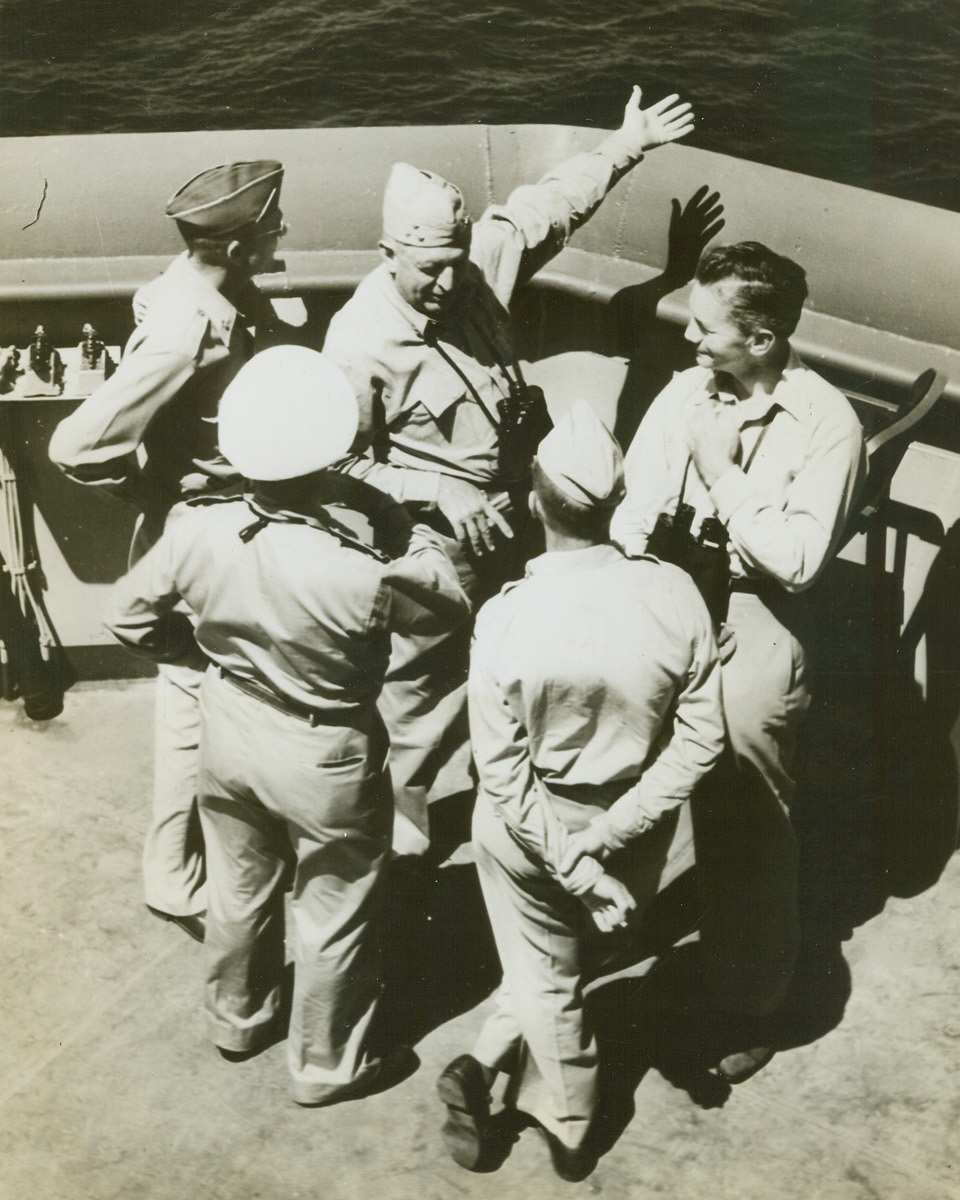
FORRESTAL SEES INVASION OF S FRANCE, 8/24/1944. Getting a first hand account of the workings of an invasion, Sec. of the Navy James Forrestal accompanied the Allied force which landed in Southern France. In this photo the secretary listens as Vice-Adm. H. Kent Hewitt, who was in command of the landing operations, gestures towards the objective while discussing tactics with (left to right) Maj. Gen. A.M. Patch, Jr. Commanding General, 7th Army; Contre Admiral (Rear Adm.) Andre Lemonnier, Commander, French Navel Forces, Mediterranean; and Brig. Gen. G.P. Saville, Commanding General, 12th Tactical Air Command; and Mr. Forrestal. Credit (U.S. Navy Photo from ACME);
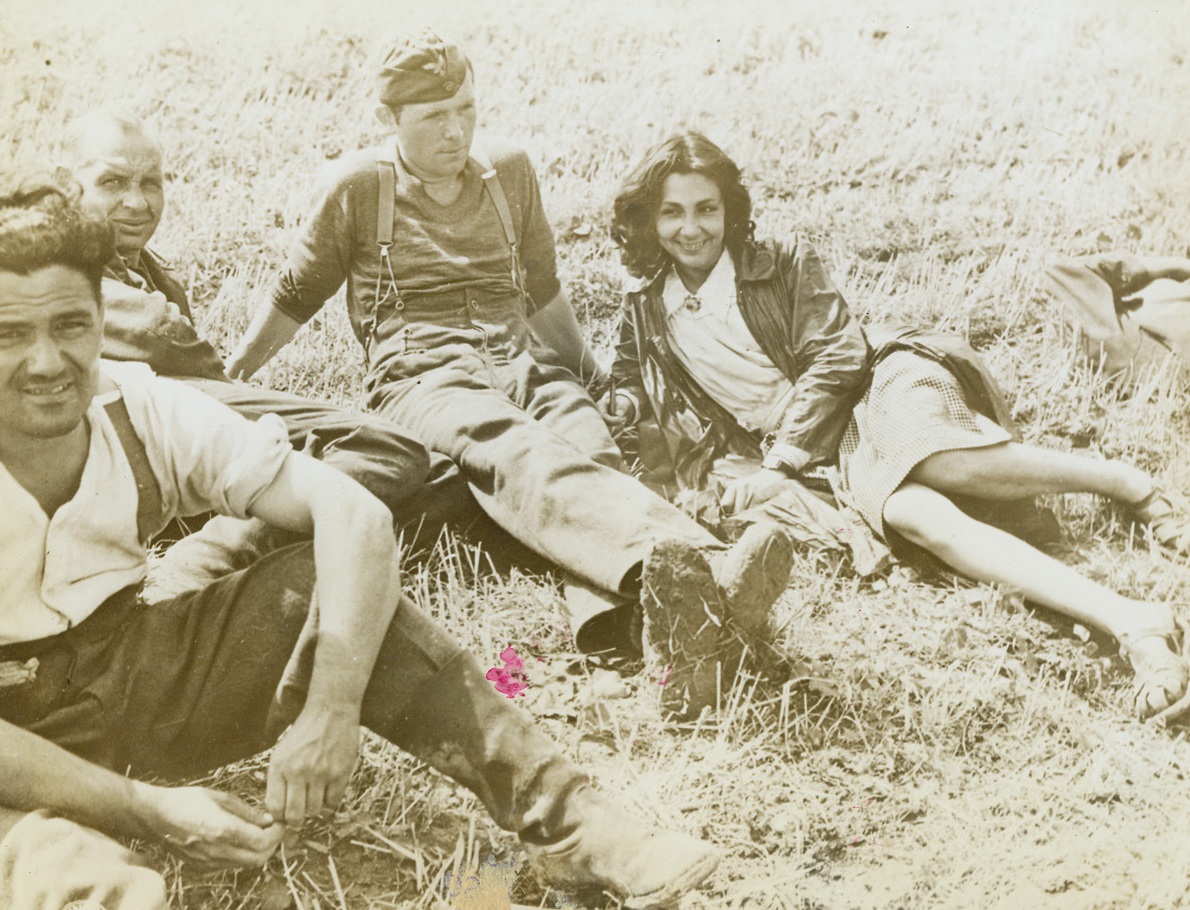
FORRESTAL SEES INVASION OF S FRANCE, 8/24/1944. Getting a first hand account of the workings of an invasion, Sec. of the Navy James Forrestal accompanied the Allied force which landed in Southern France. In this photo the secretary listens as Vice-Adm. H. Kent Hewitt, who was in command of the landing operations, gestures towards the objective while discussing tactics with (left to right) Maj. Gen. A.M. Patch, Jr. Commanding General, 7th Army; Contre Admiral (Rear Adm.) Andre Lemonnier, Commander, French Navel Forces, Mediterranean; and Brig. Gen. G.P. Saville, Commanding General, 12th Tactical Air Command; and Mr. Forrestal. Credit (U.S. Navy Photo from ACME);
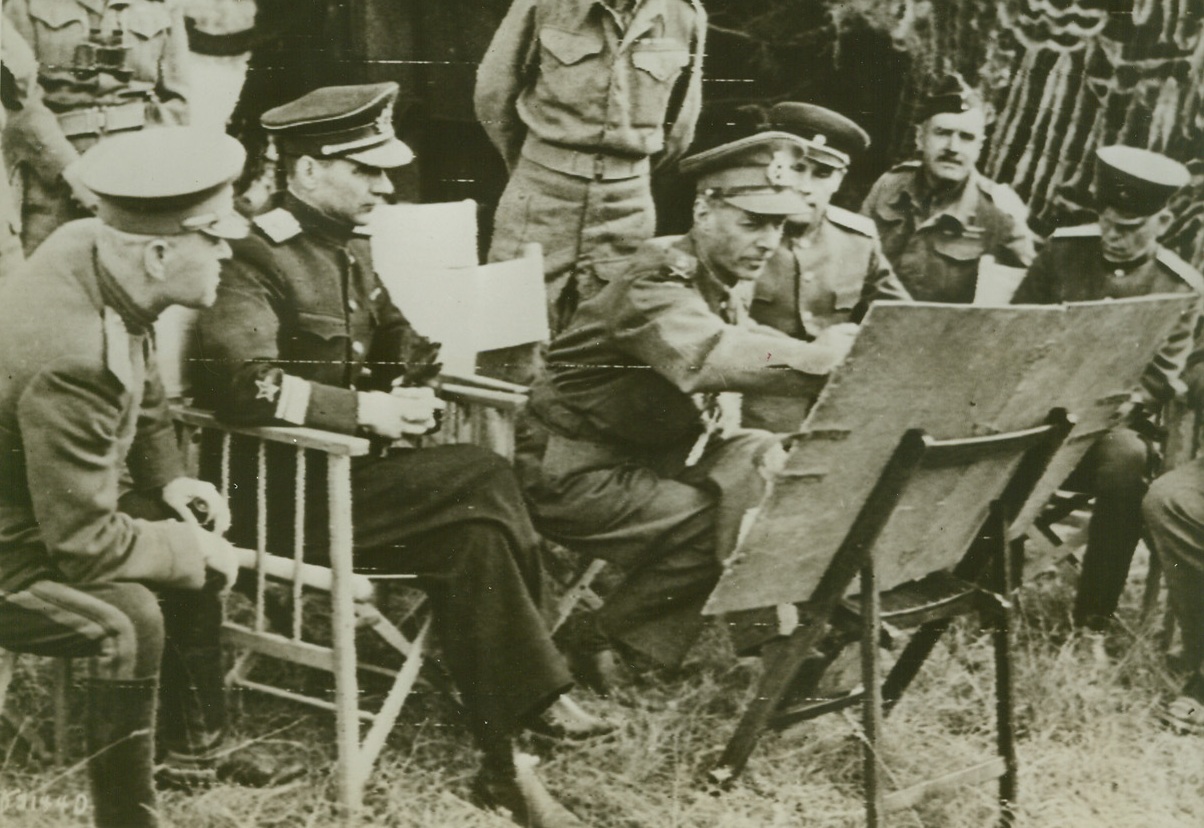
RUSSIAN MISSION VISITS BRITISH FRONT, 8/4/1944. FRANCE—A Russian Military Mission recently visited the British front in Normandy to get a first hand view of how the battles against the Nazis in the west are getting on. Seated as they hear an explanation of battle plans are (left to right): Col. Jorbarov; Vice Adm. Kharlamov; Lt. Gen. Dempsey, commander, British 2nd Army; Maj. Gen. Sklyarov; and Maj. Gen. Vasiliev. Credit (British Official Photo Via Army Radiotelephoto from ACME);
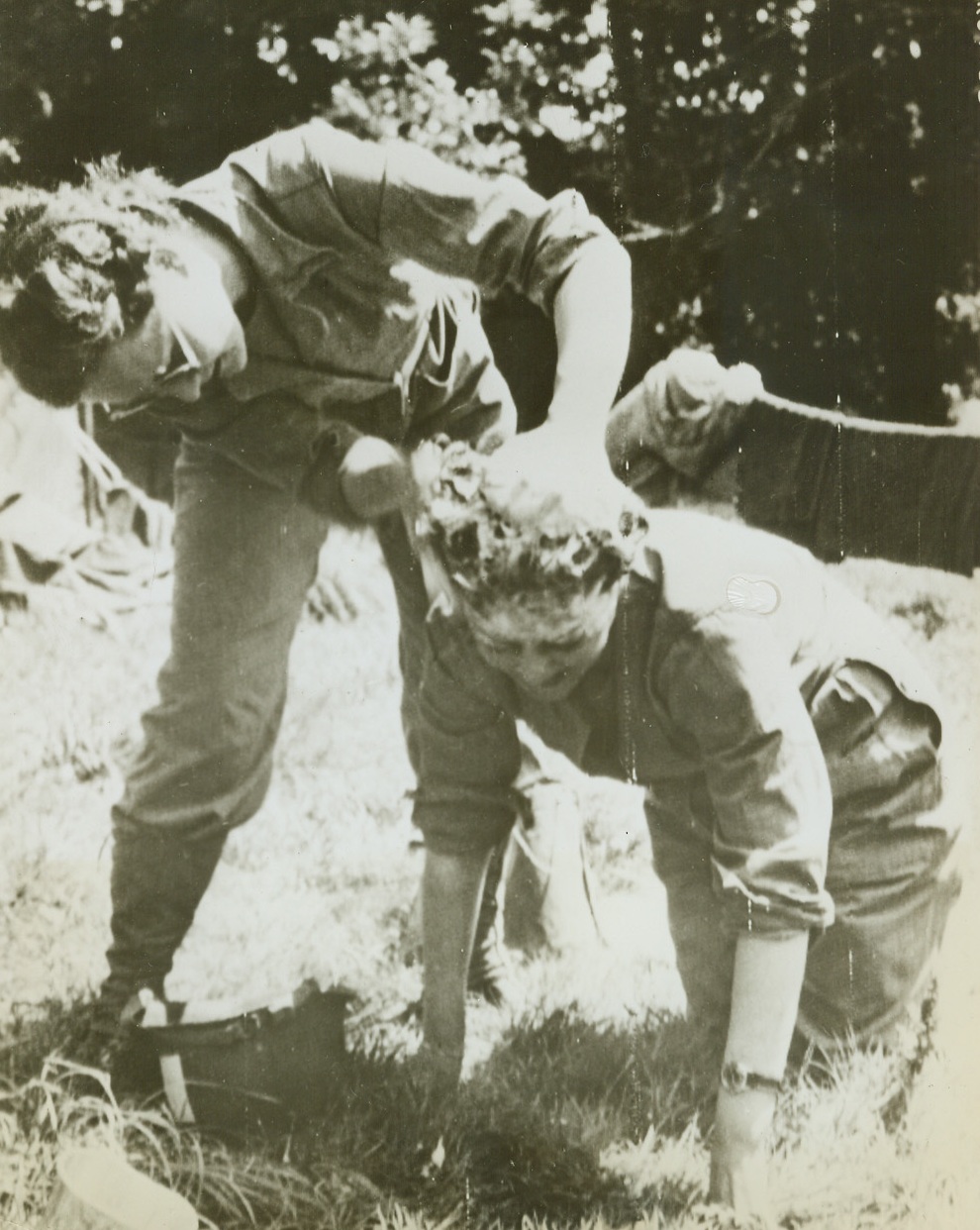
“SISTERS OF THE SUDS”, 8/3/1944. FRANCE—Two WACS take turns washing each other’s hair, with a GI helmet serving as a basin. They are: Pvt. Claire Dickman, of San Francisco, Calif. (left), and Selma Herfor, of New York City. Credit Line (Army Radiotelephoto from ACME);

NUN GIVES YANKS INFORMATION, 8/2/1944. FRANCE—A French nun gives information about retreating German forces to Yanks, who pause on their way to the Avaranches front. Credit (Signal Corps Radiotelephoto from ACME);
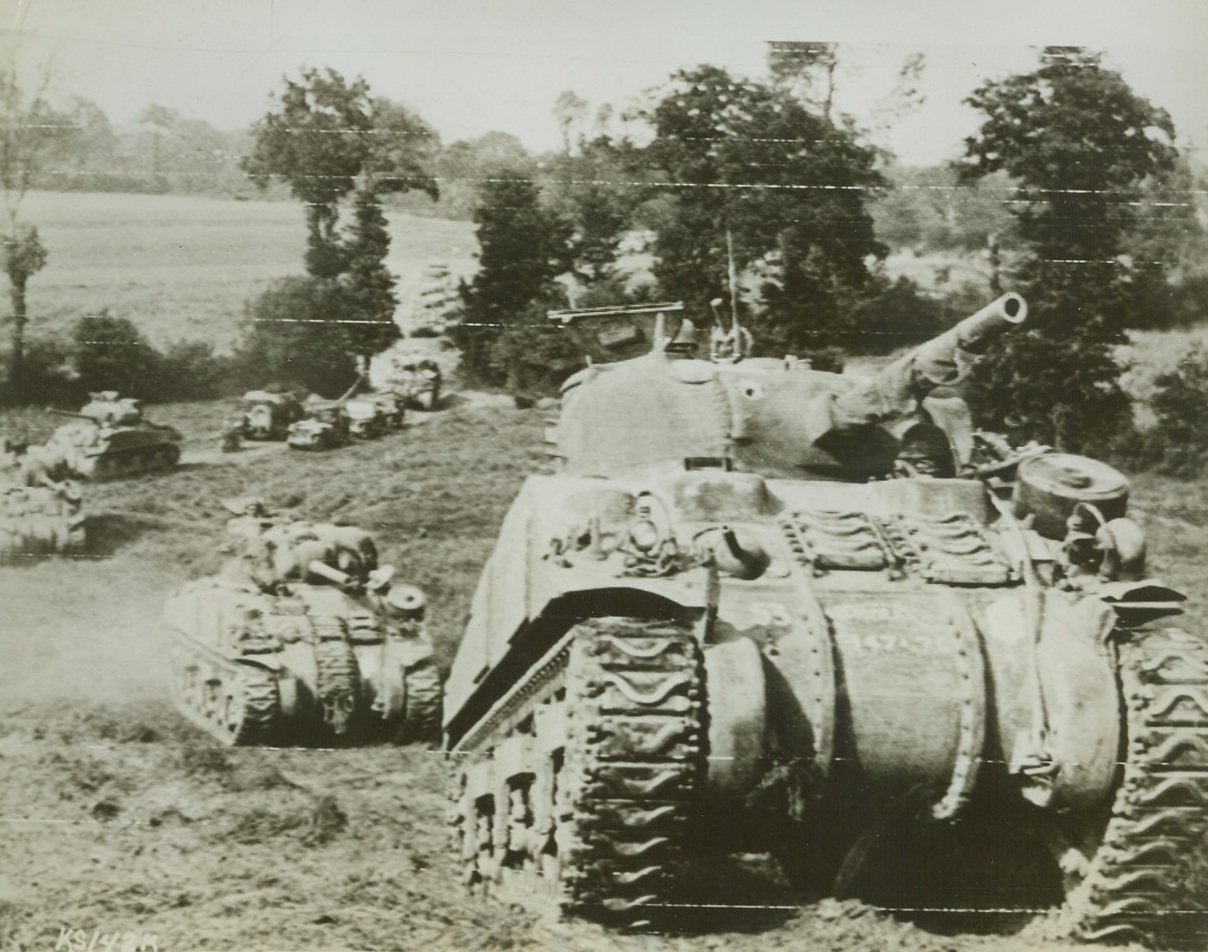
BRITISH TANKS MOVE UP TO FRONT, 8/2/1944.CAUMONT, FRANCE—A column of British-manned Sherman tanks move forward through a wooded area south of Caumont to take part in the heavy British offensive against the Germans in this section. Credit (British Official Photo via US Army Radiotelephoto from ACME);
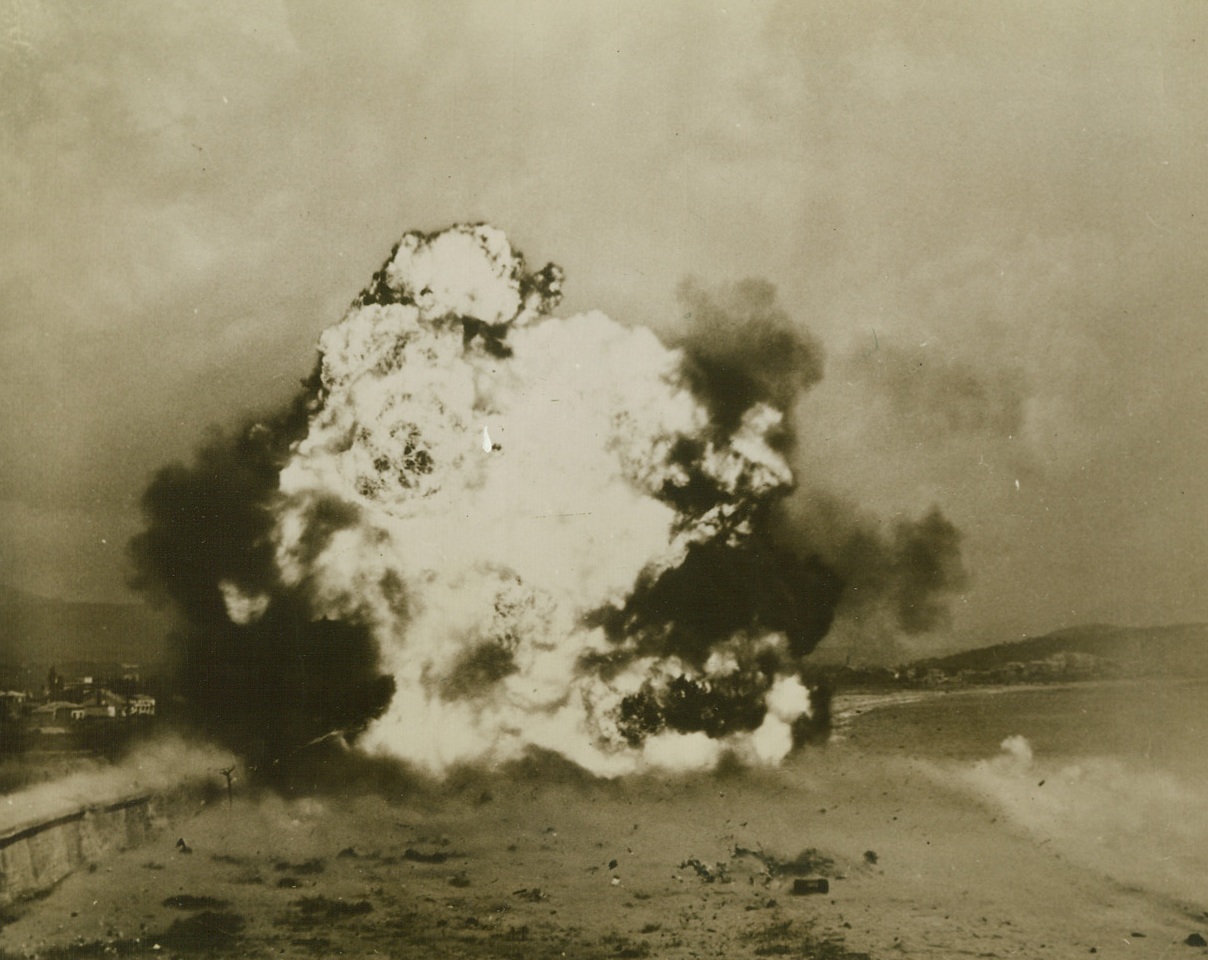
Open Way For Allied Advance, 8/31/1944. France - Blocked by an anti-tank wall, the Allied advance in Southern France was halted - but just fleetingly. Engineers of a demolition squad set to work with teller mines and blasted open a clear path for relentlessly advancing forces. The flash of explosion is seen as the mines go off. St. Raphael is in the background. Credit: Signal Corps photo from ACME;

Welcome to the Liberating Americans, 8/28/1944. Paris – United States soldiers are shown being joyfully greeted by French women in the shadow of Notre Dame Cathedral. They dance – and one girl may be pulling a soldier from the truck. Credit: ACME photo by Bert Brandt for the War Picture Pool;

ACME Photog Gets Hugs And Kisses, 8/30/1944. France – Wildly enthusiastic French girls greet ACME Newspictures Photographer Bert Brandt with hugs and kisses as he entered Paris with the first group of liberating forces. Brandt’s pictures of the freeing of the French capital, along with other ACME photographers’ photos, were the first to reach the United States. Credit: ACME photo by Bert Brandt, War Pool Correspondent;
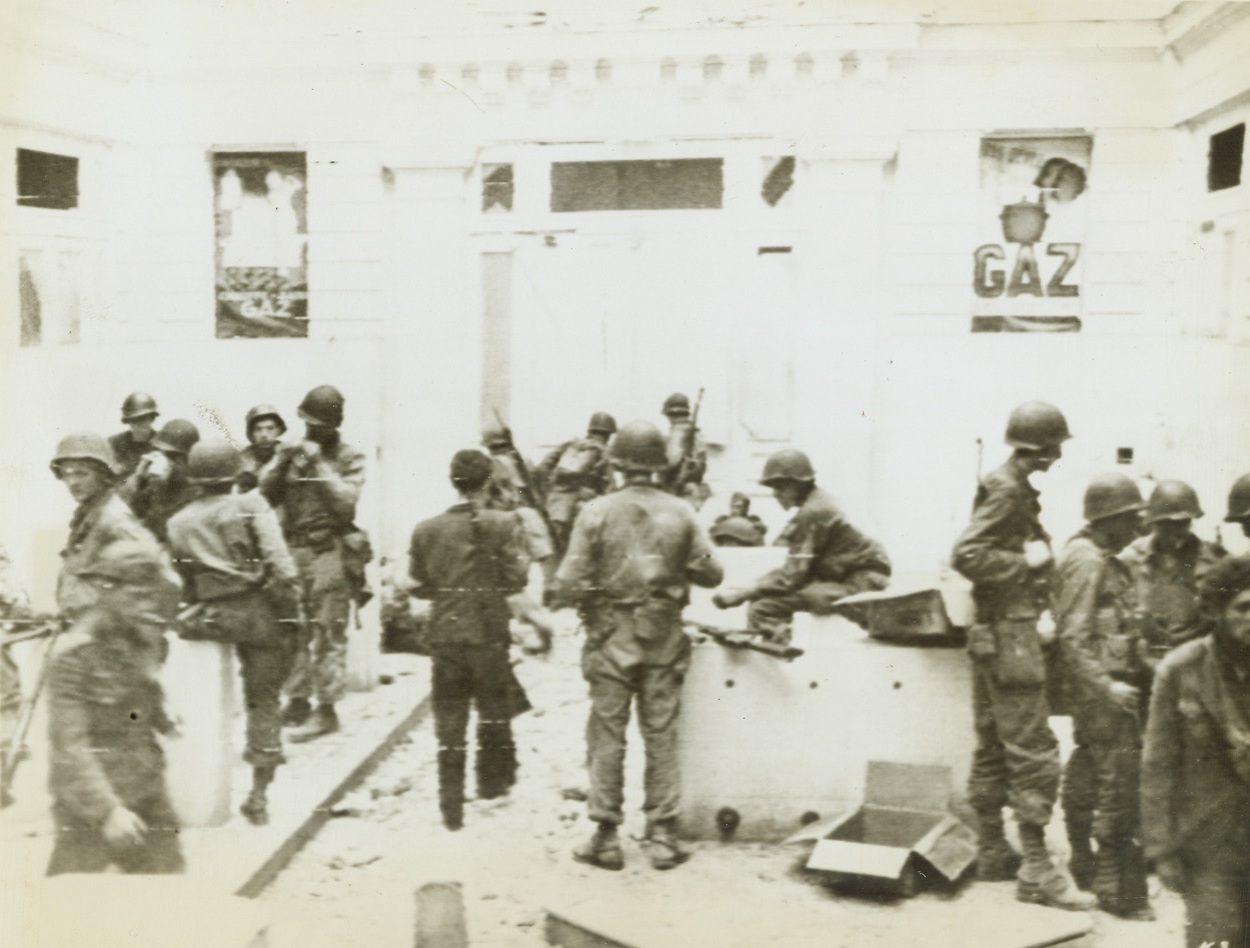
“Soup’s On” in St. Malo, 8/17/1944. France – Americans gather in an empty store in the Breton town of St. Malo for chow. In the background, German prisoners are seated on the curb. In left foreground and just to left of center are two Spanish Loyalists (former leaders) now fighting with the Yanks. Credit: Army Radiotelephoto from ACME;
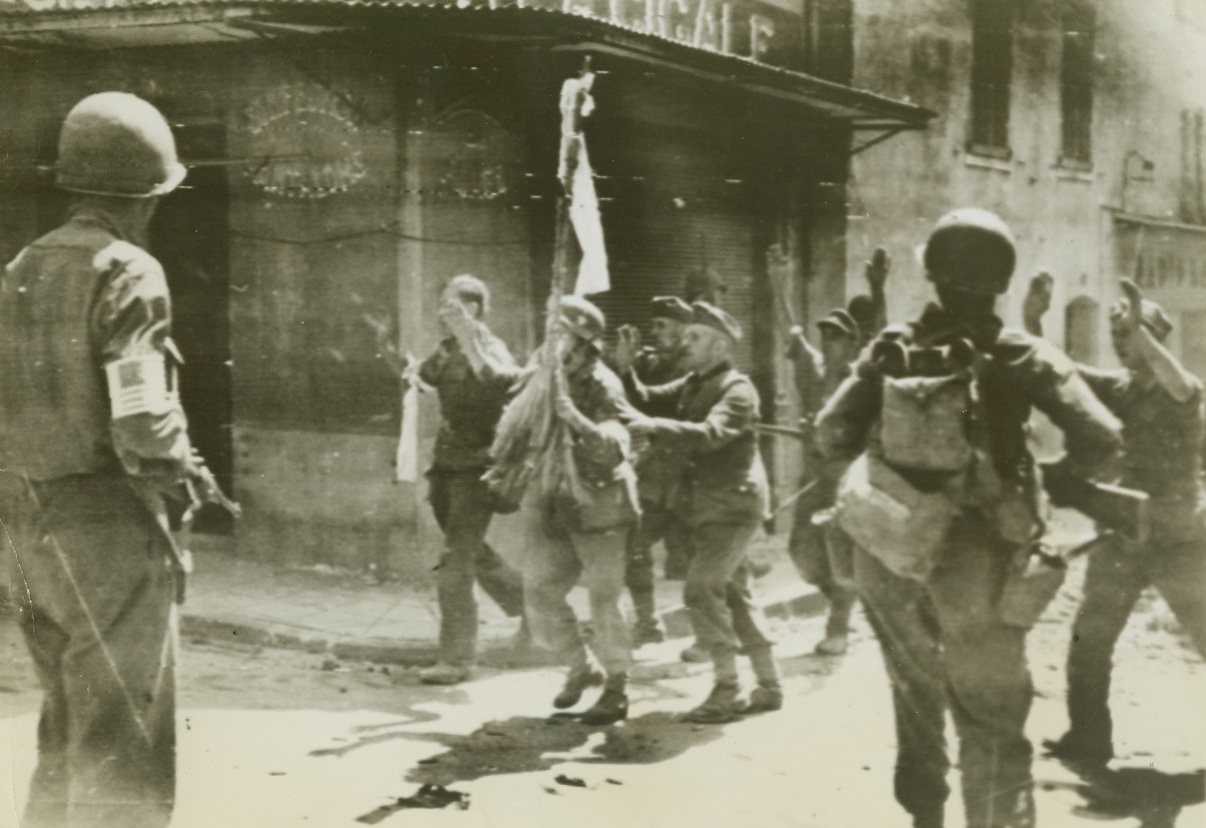
New Nazi’s “Standard”, 8/17/1944. France – While one of their number holds the white flag of surrender aloft, Germans rush out to give themselves up to American troops at a street corner in a little town east of Toulon. Note how two of the Nazis hide themselves behind the flag bearer – as though they expected to feel lead from Yank guns at any moment. (Passed by Censors) Credit: ACME photo by Sherman Montrose for War Picture Pool;
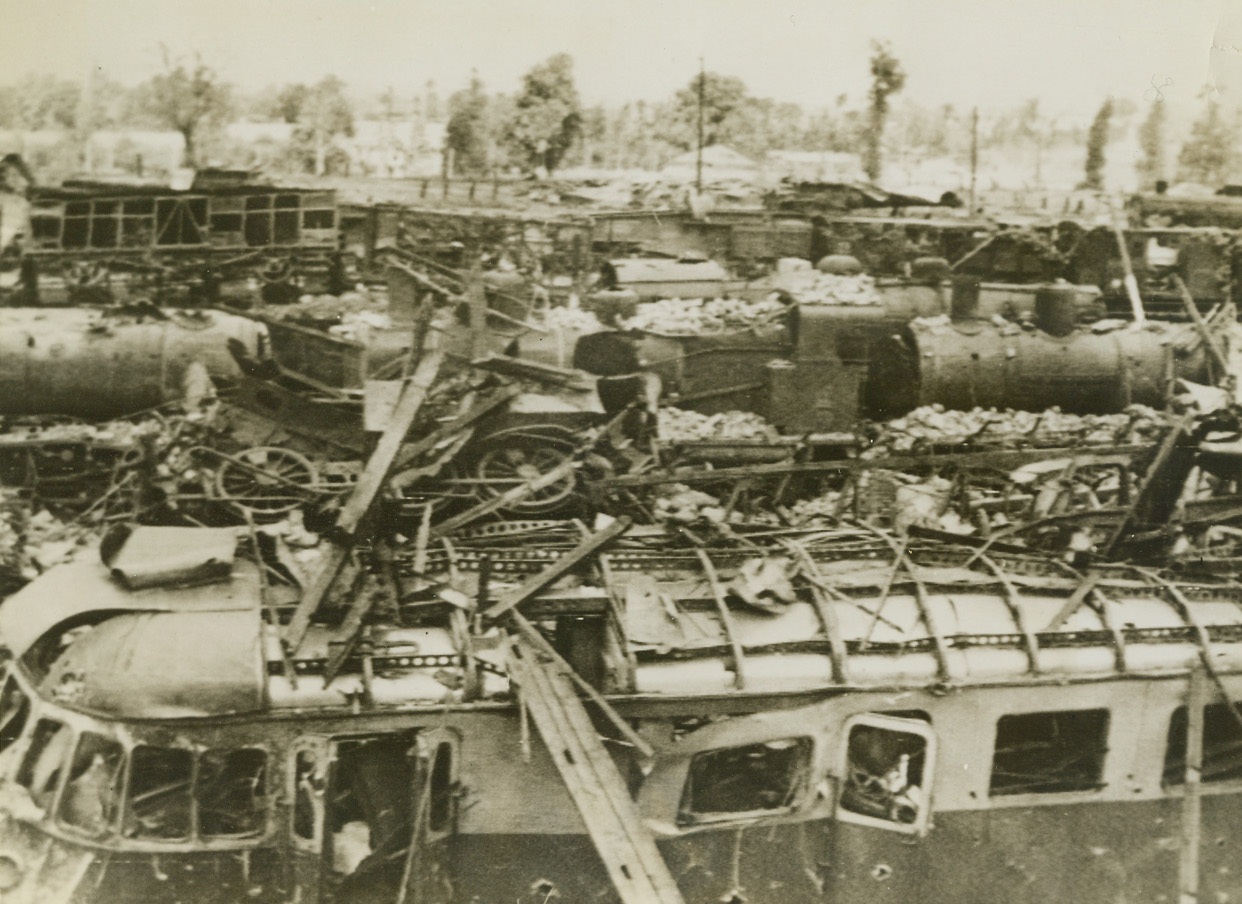
Another Nazi Communication Line Destroyed, 8/14/1944. Vire, France – Rolling stock and tracks in the Vire Railyard lie in shattered ruins after Allied Bombings which preceded the occupation of the city on August 7. Credit: British Official Photo via Signal Corps Radiotelephoto from ACME;
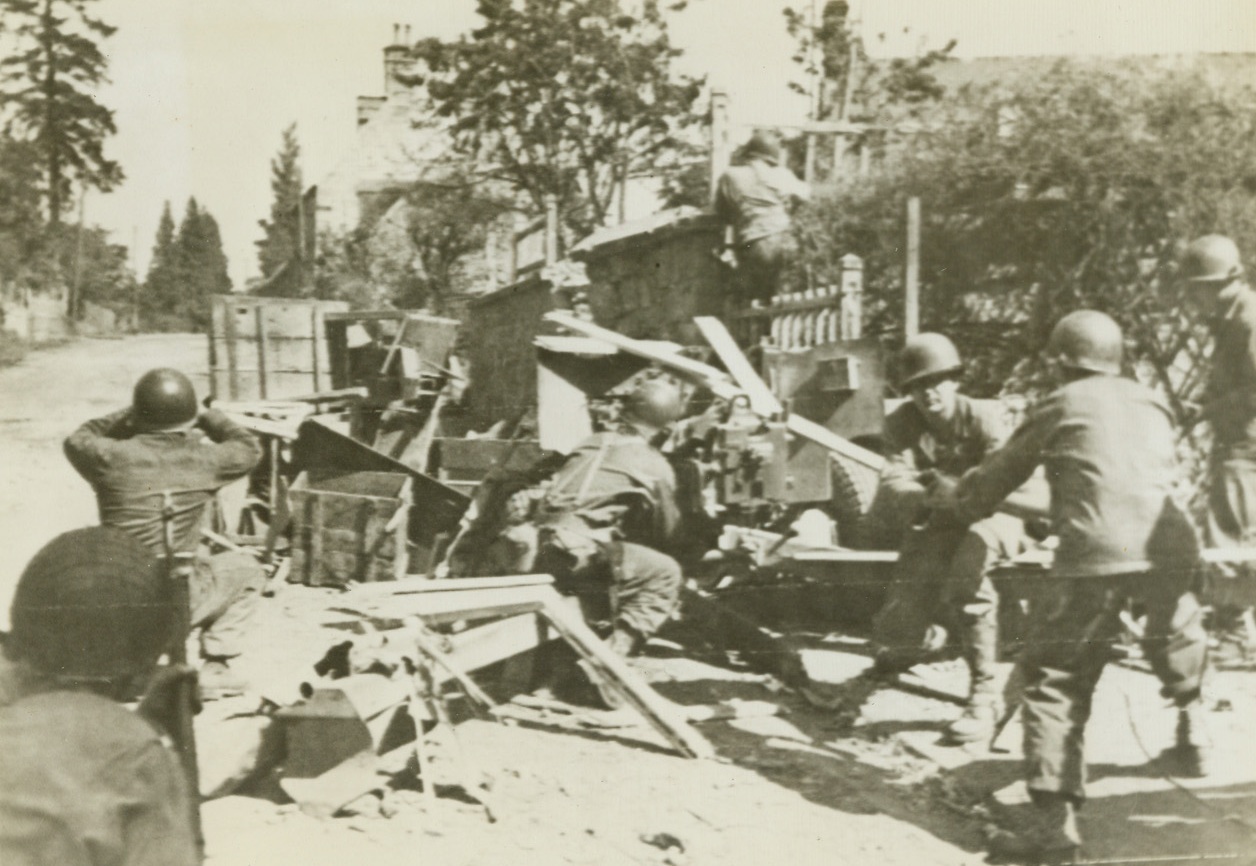
Awaiting Counter-Attack, 8/12/1944. France – Their anti-tank gun camouflaged with crates and boxes, this Allied gun crew stands ready on the outskirts of recently occupied Cherence Le Roussel, silently awaiting Nazi counter-attack. Credit: Signal Corps Radiotelephoto from ACME;
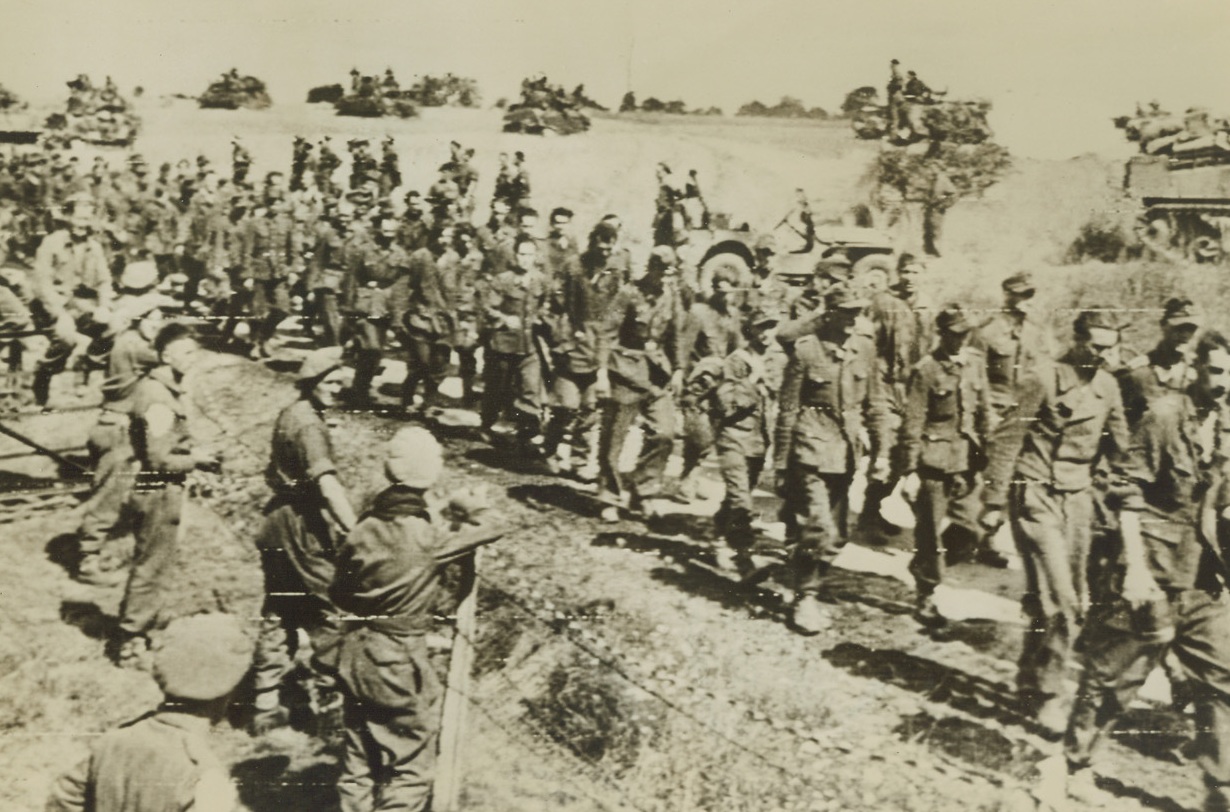
Two-Way Traffic, 8/23/1944. France – Past a long column of dejected German prisoners being marched to the rear, British armored vehicles rumble ahead toward the front. Nazis were taken when the Falaise-Argentan Gap was closed by Allied Forces cutting off any possible escape route for an estimated 100,000 Germans. Credit: British War Office photo via Army Radiotelephoto from ACME;
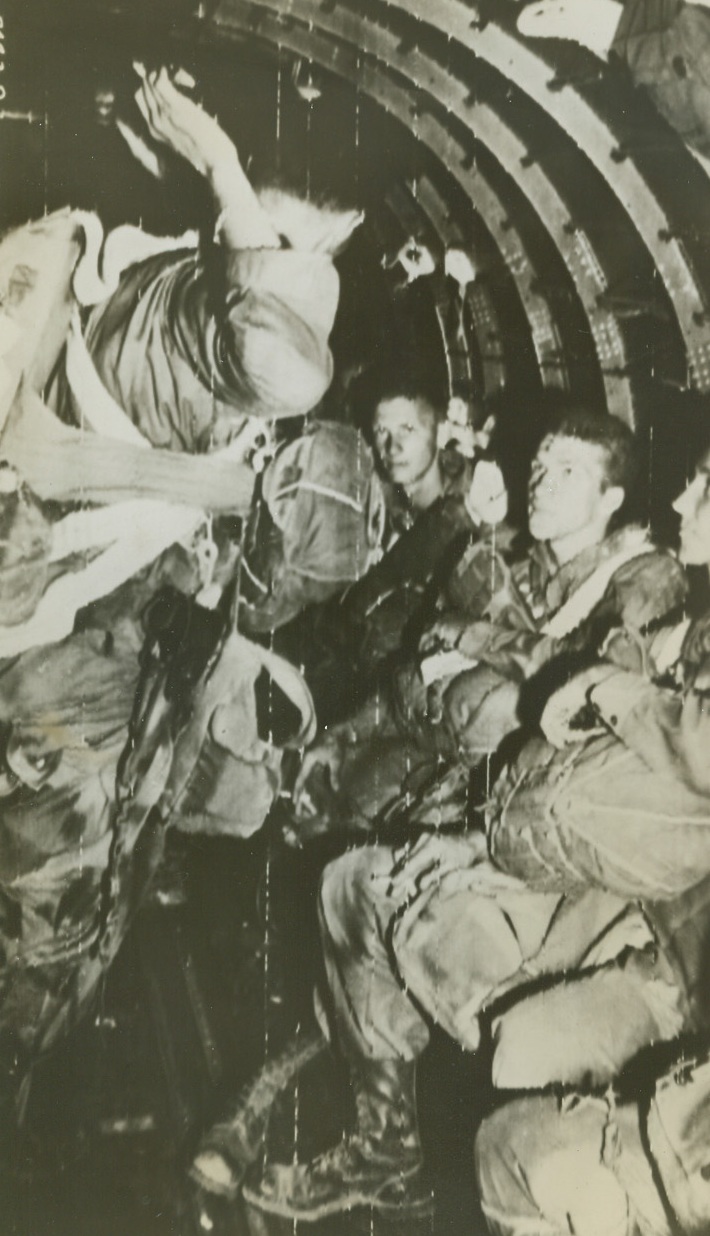
To Leap Into France, 8/15/1944. Hard and rugged Paratroopers listen intently to the Jumpmaster (standing) as he gives last minute instructions while their C-47, part of the Troop Carrier Air Division of the 12th Air Force, heads toward the dropping zone in southern France. Credit: Army Radiotelephoto from ACME;
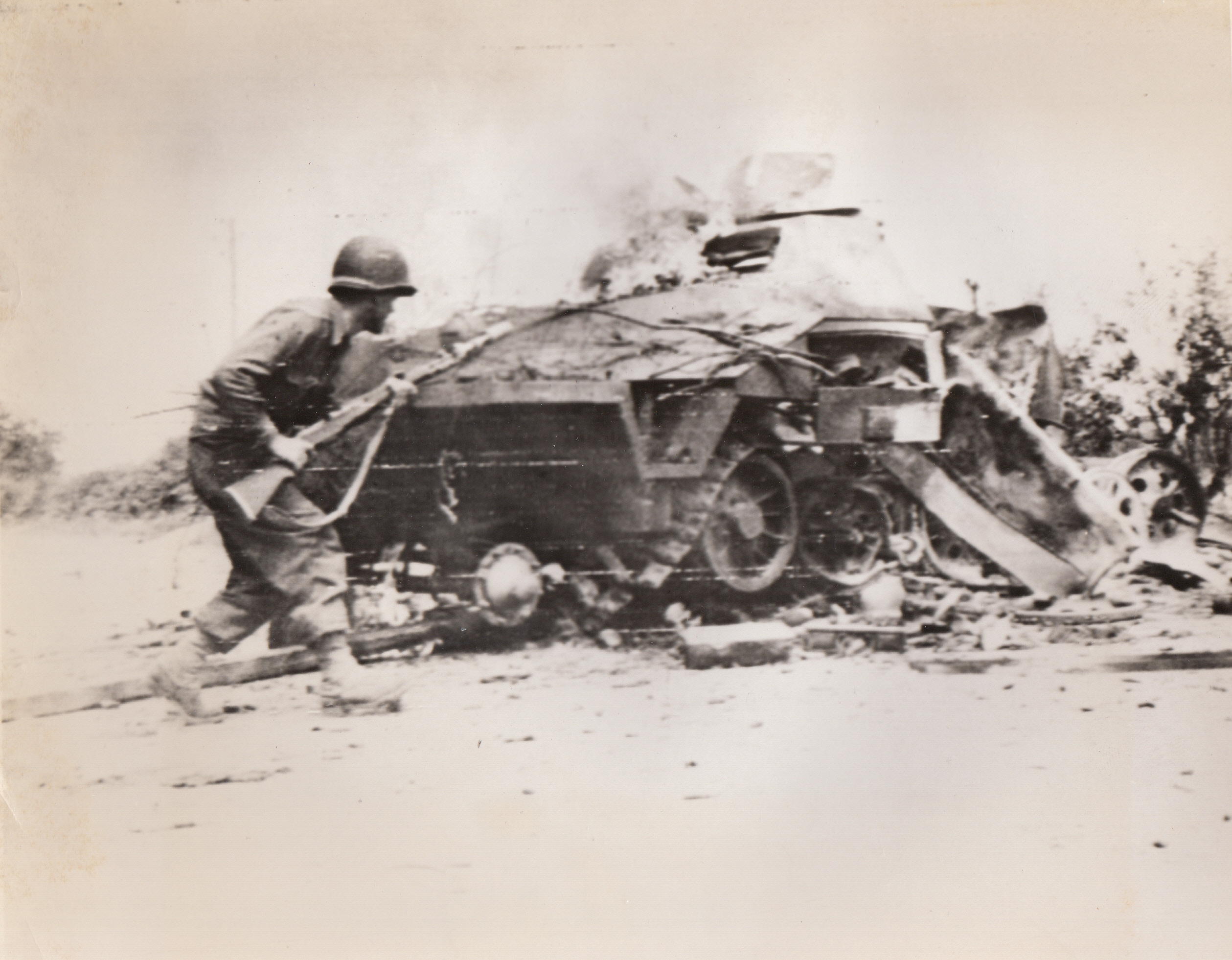
Lesson In Caution, 8/14/1944. France – With cautious step, Sgt. Andrew Harding, Bridgeport Conn., approaches a burning Nazi armored car. The vehicle had been knocked out on the road to La Mont by an American three-inch shell.;

A Frenchman Returns To His Wife, 8/15/1944. Coutinville, France – Lt. Nonet-Raisin, of the 2nd French Armored Division, which once more is fighting in its homeland, happily embraces his wife at the door of their home, from which he fled in 1943 to join the Free French. Credit: U.S. Signal Corps photo from ACME;
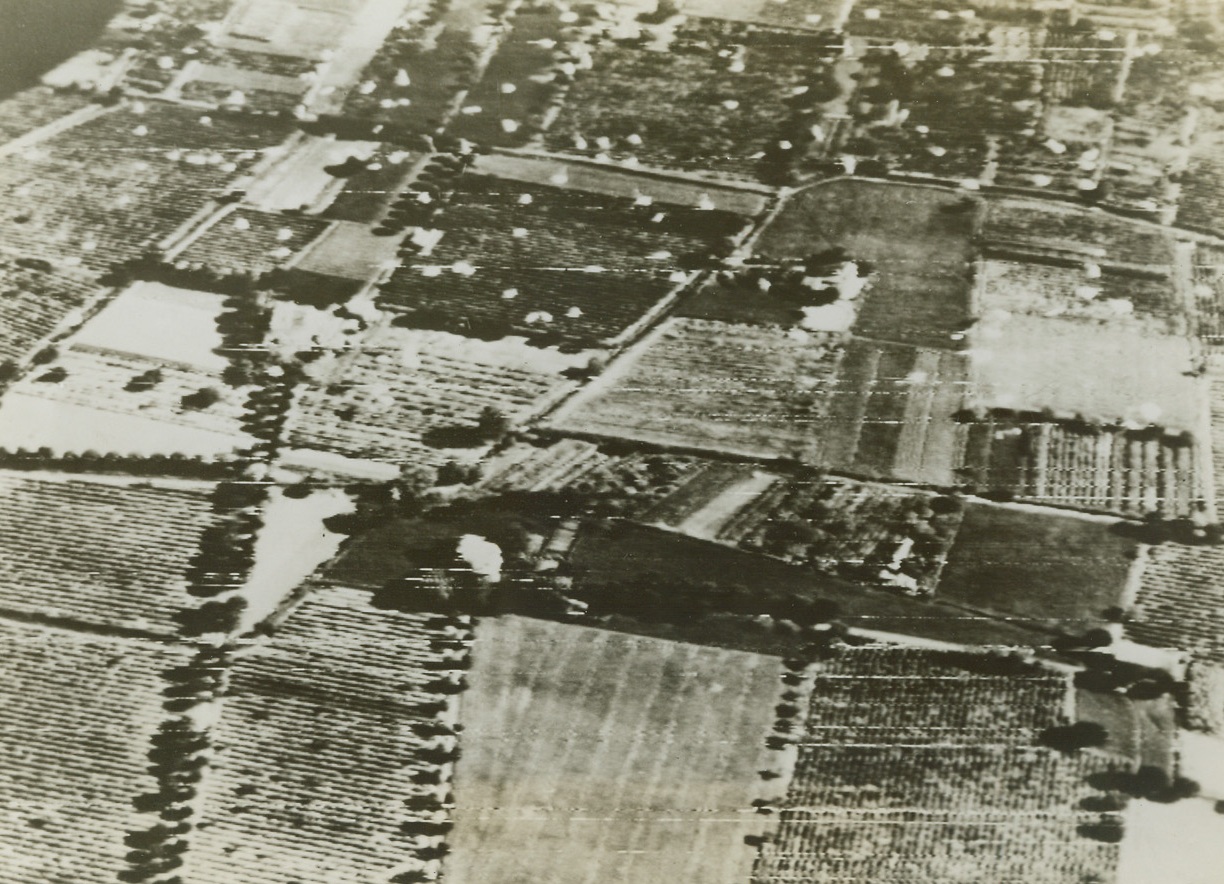
Invading Southern France – First Photo, 8/15/1944. Parachutes, left behind by Paratroopers who stuck out for their objectives in enemy territory after landing, are seen in this aerial view dotting the ground for miles around in southern France. Credit: ACME photo by Charles Seawood for the War Picture Pool via Army Radiotelephoto;
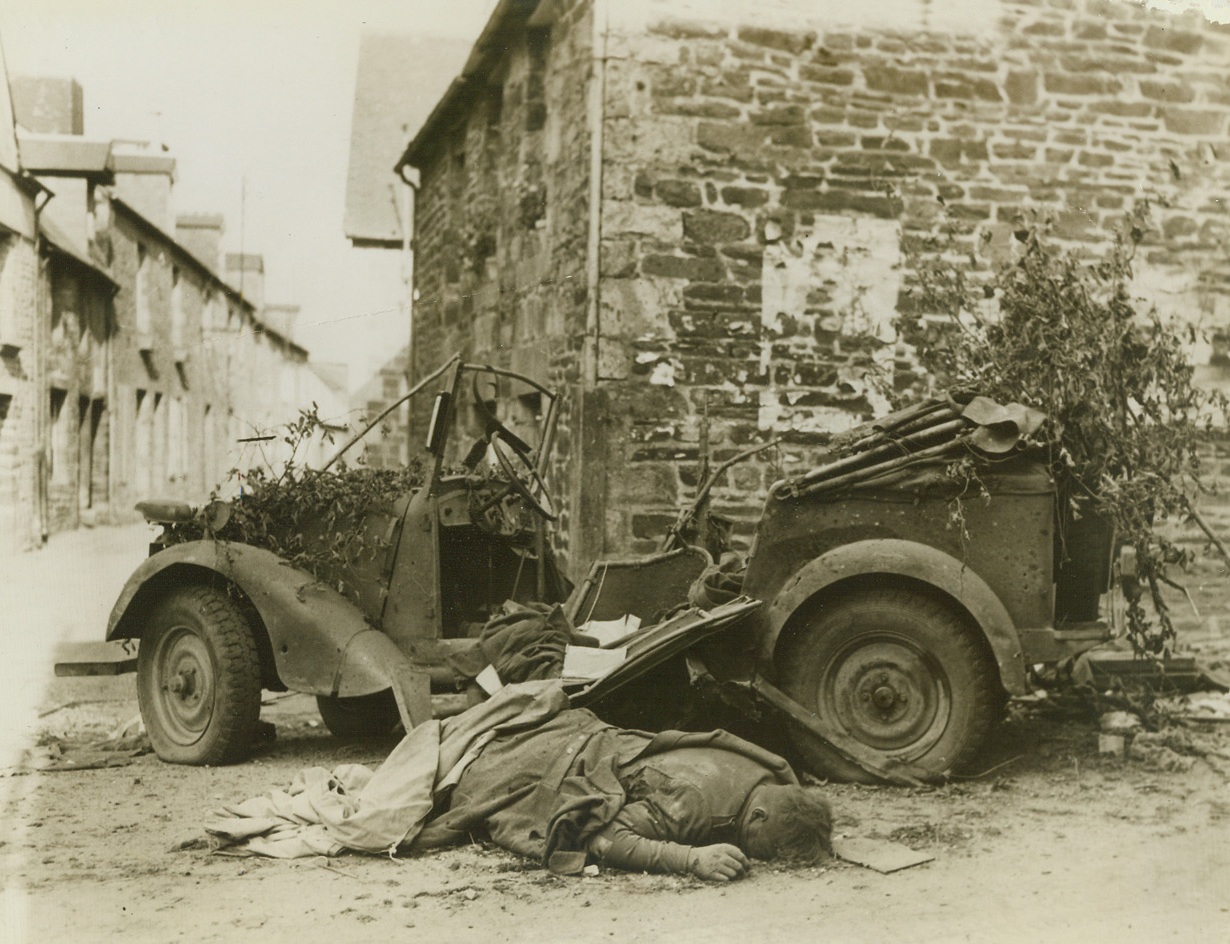
Nazi Reaches End of Journey, 8/15/1944. France – Face down in the dust of a road, a German soldier lies dead beside his Volkswagon in Barenton, France. Marks of blood line his face. American troops took the town in latest drive through France. Credit: Signal Corps photo from ACME;
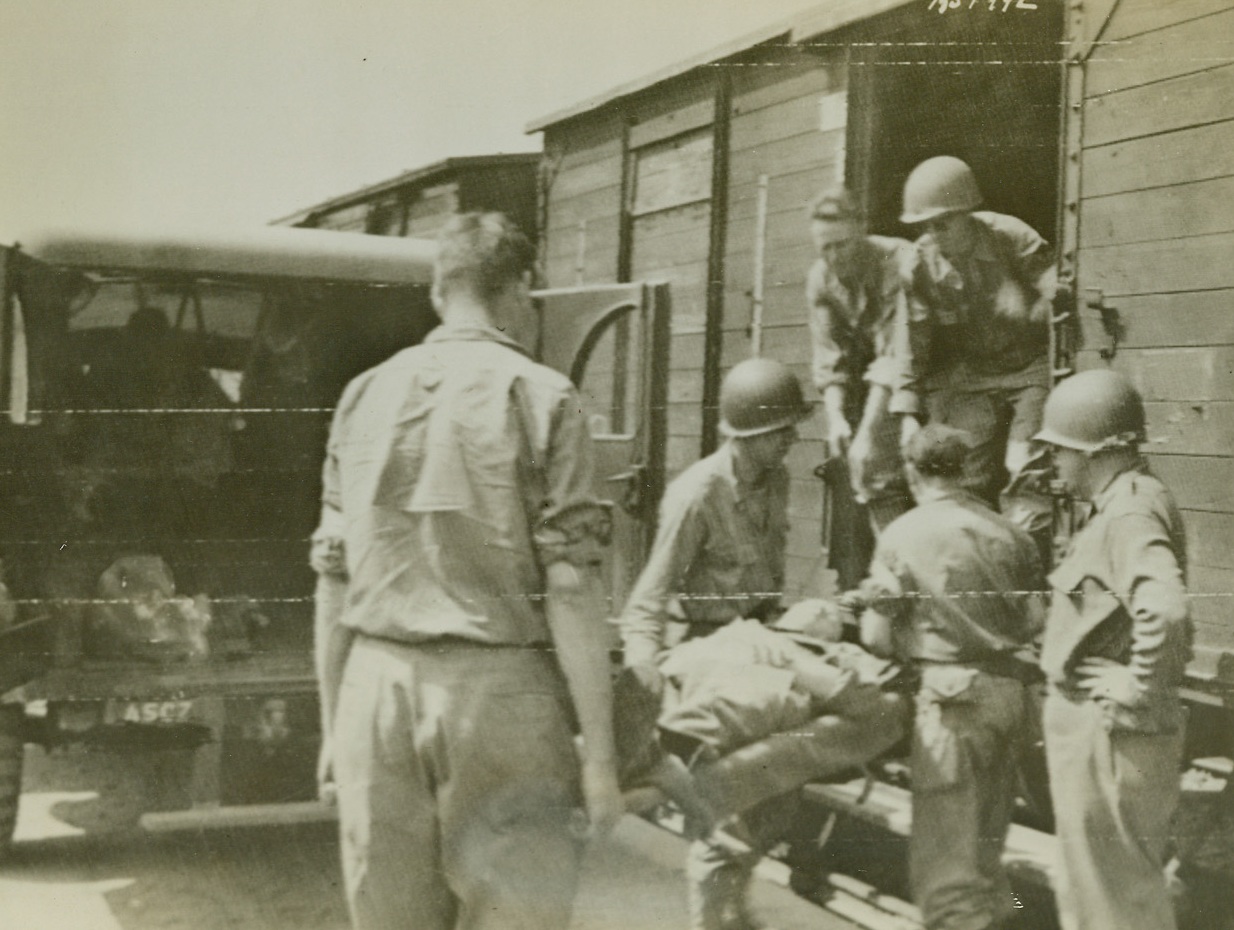
Load First Hospital Train, 8/8/1944. France – Wounded men are loaded aboard the first Allied hospital train to operate in France since D-Day, on a siding at Lison. They will be taken to Cherbourg on their way to England. Credit: Army photo from ACME;
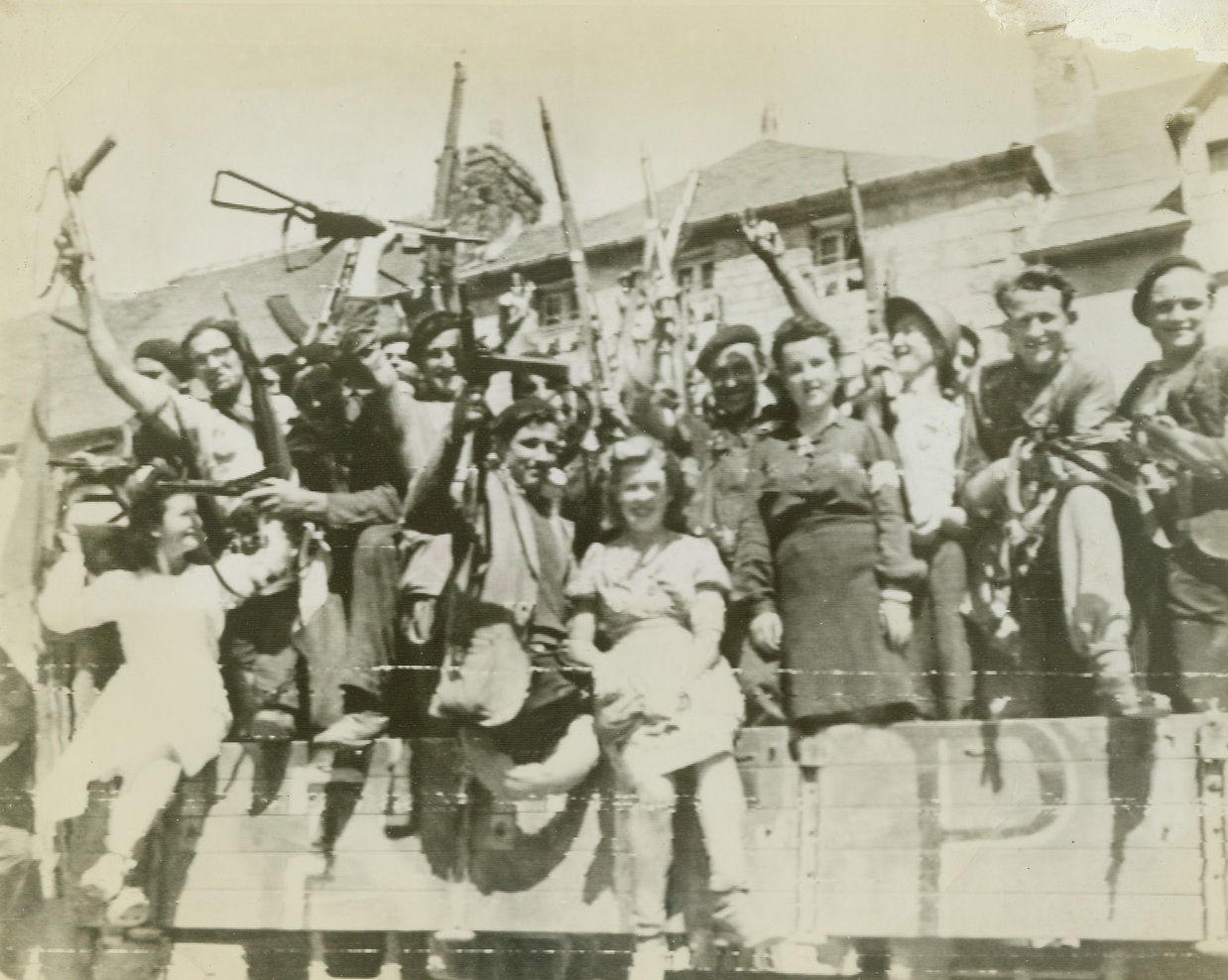
Hunting Party Searches Nazis, 8/18/1944. France – Waving captured German guns enthusiastically, these fighting Frenchmen and women of the town of Rostrenen ride off to round up stray Nazis in the vicinity after the Yanks had wiped out most of the resistance. Credit: Army photo from ACME;
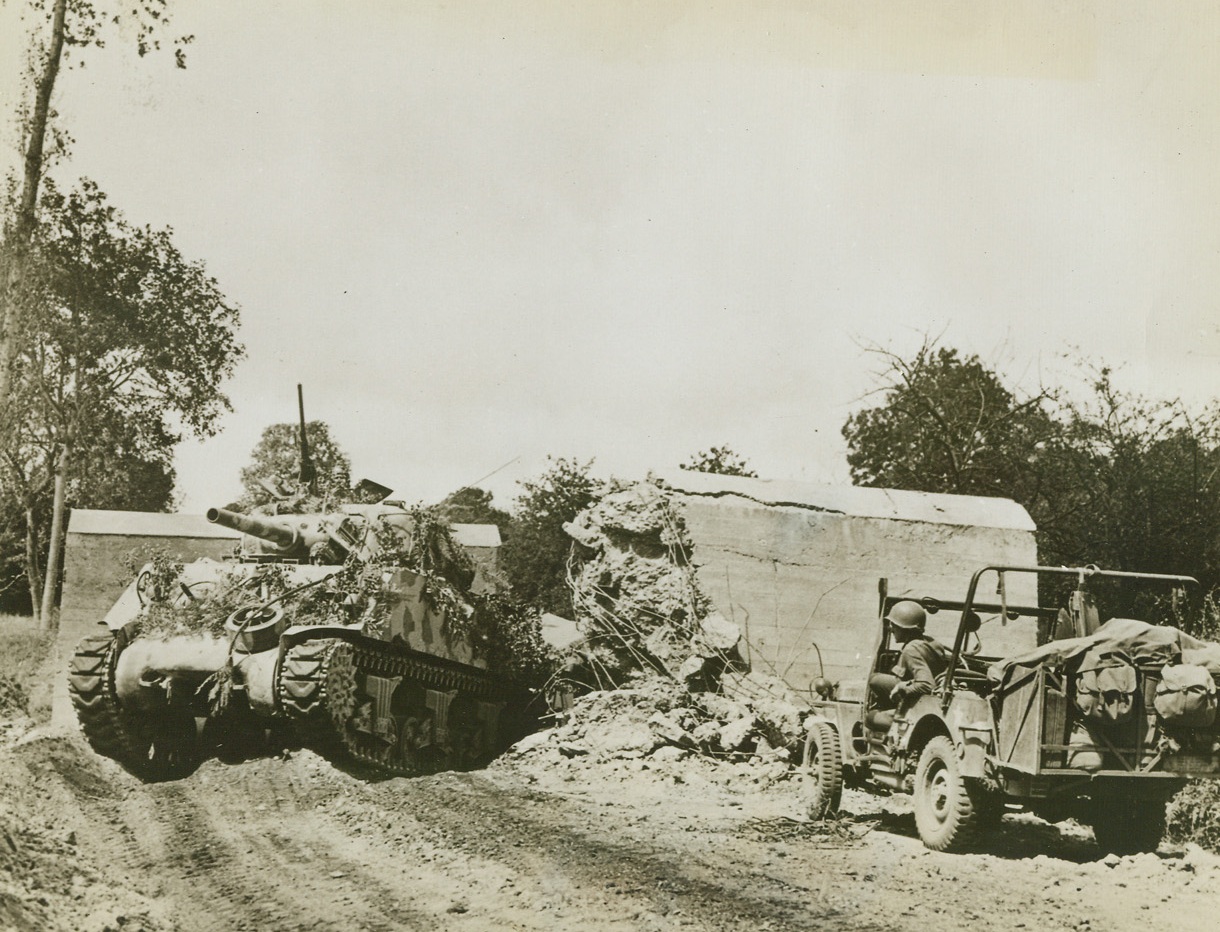
Road Block No Obstacle, 8/5/1944. France – An American tank smashes through a road block on its way to join the American lightning attack on the Avranches sector during the current offensive in Brittany. Tank is camouflaged with twigs and paint. Note how the so-called block is completely demolished. Credit: ACME;
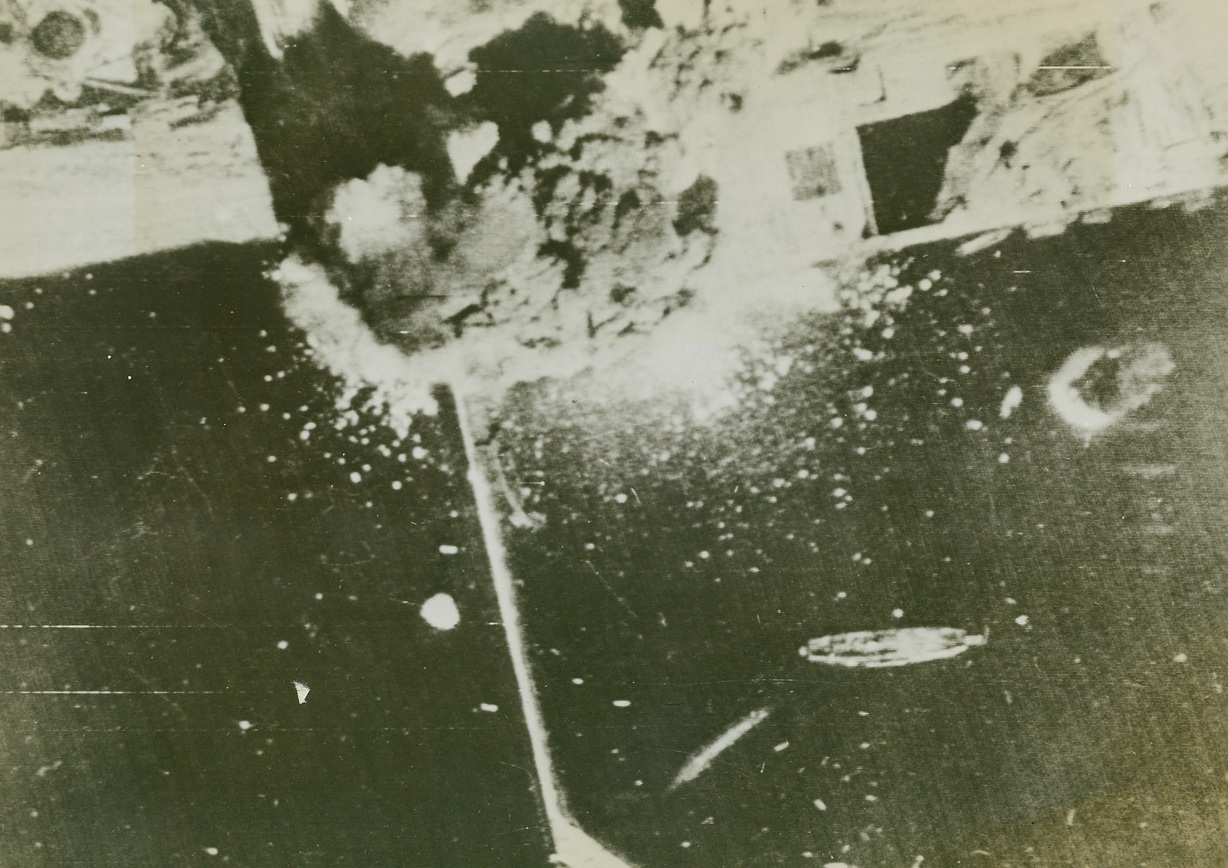
British Bomb Brest, 8/7/1944. Brest, France – Here’s a bomber’s-eye-view of the U-boat pens at Brest as RAF airmen strike heavily at their target. A direct hit is scored by a six-ton bomb on some of the concrete pens. Credit: British official photo via US Signal Corps from ACME;

Medics to the Rescue, 8/7/1944. Somewhere in France – Working feverishly with their shovels, medical men attached to an infantry unit serving in France dig out some of their men who were buried beneath an avalanche of dirt when enemy shells struck. Credit: US Army photo from ACME;
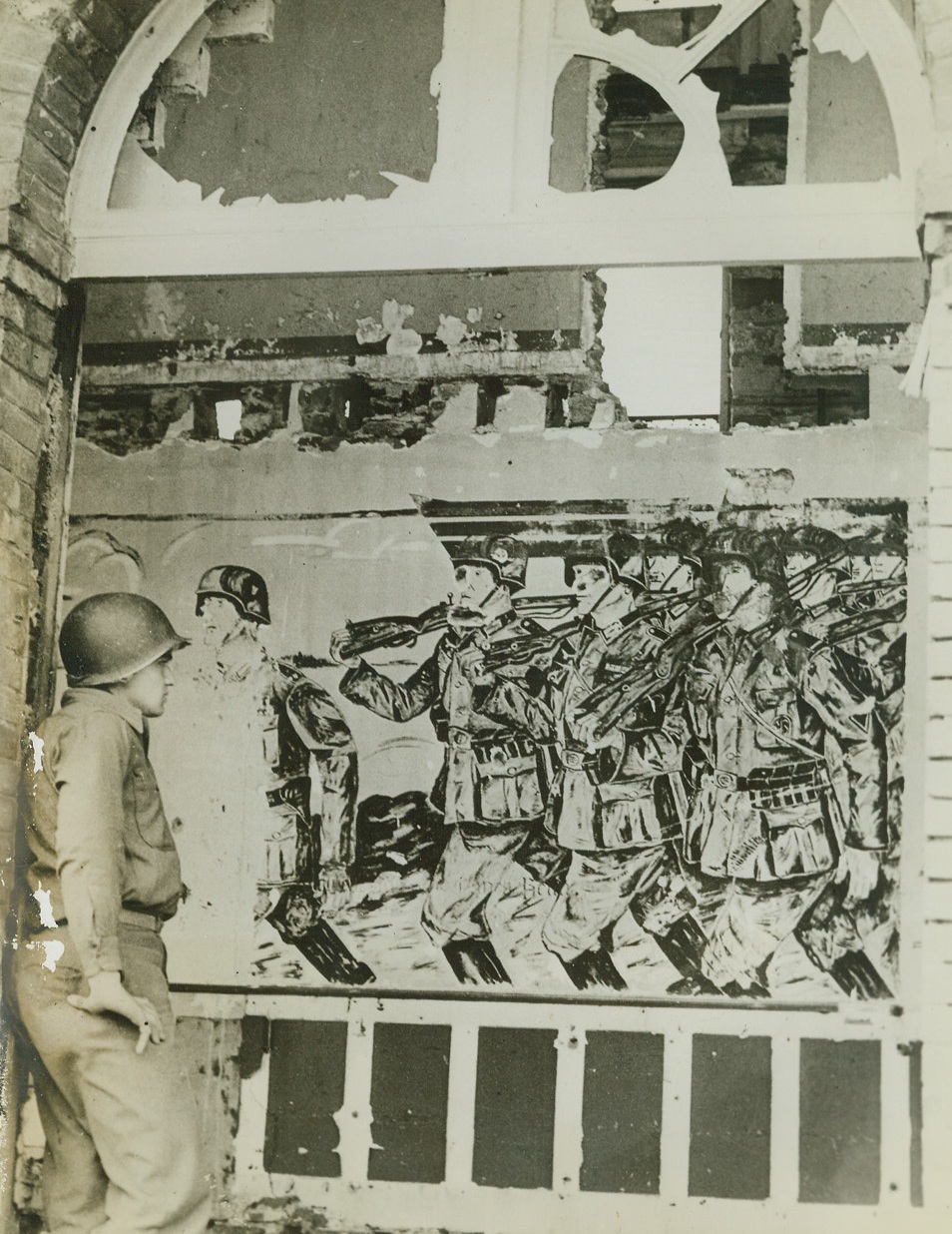
Nazi Victory Painting Premature, 8/4/1944. France – In a captured German headquarters in France an American soldier examines with interest an unfinished painting of German troops marching in victory. Nazis did not have time to complete it before evacuating before the relentless drive of the Allies. Shell fire has knocked holes in the mural. Credit: ACME;

Shattered Nazi Rail Linem, 8/5/1944.France – Twisted steel is all that remains of this Nazi locomotive after an American dive bomber let loose its load of destruction. Continual hammering at Nazi rails has considerably hampered their movement of supplies and troops. Credit: Army photo from ACME;

Target For RAF “Heavies”, 8/1/1944. Pas De Calais, France – This concrete dome structure, topping German underground installations in the Pas De Calais area, which are believed to have something to do with the enemy’s threatened use of long-range rockets, was undermined by RAF “heavies” which attacked the area on July 17 and again on July 20. The 12,000-pound bombs tore out a great deal of the cliff supporting the dome, closed up tunnel entrances, and disrupted rail lines. Although this photo was taken before either of these raids, the damaged condition of the area around the dome shows that it had evidently been the target on previous raids. For pictures taken after the RAF July 17 and July 20 attacks, see ACME photo #732304. Credit: British Official Photo from ACME;
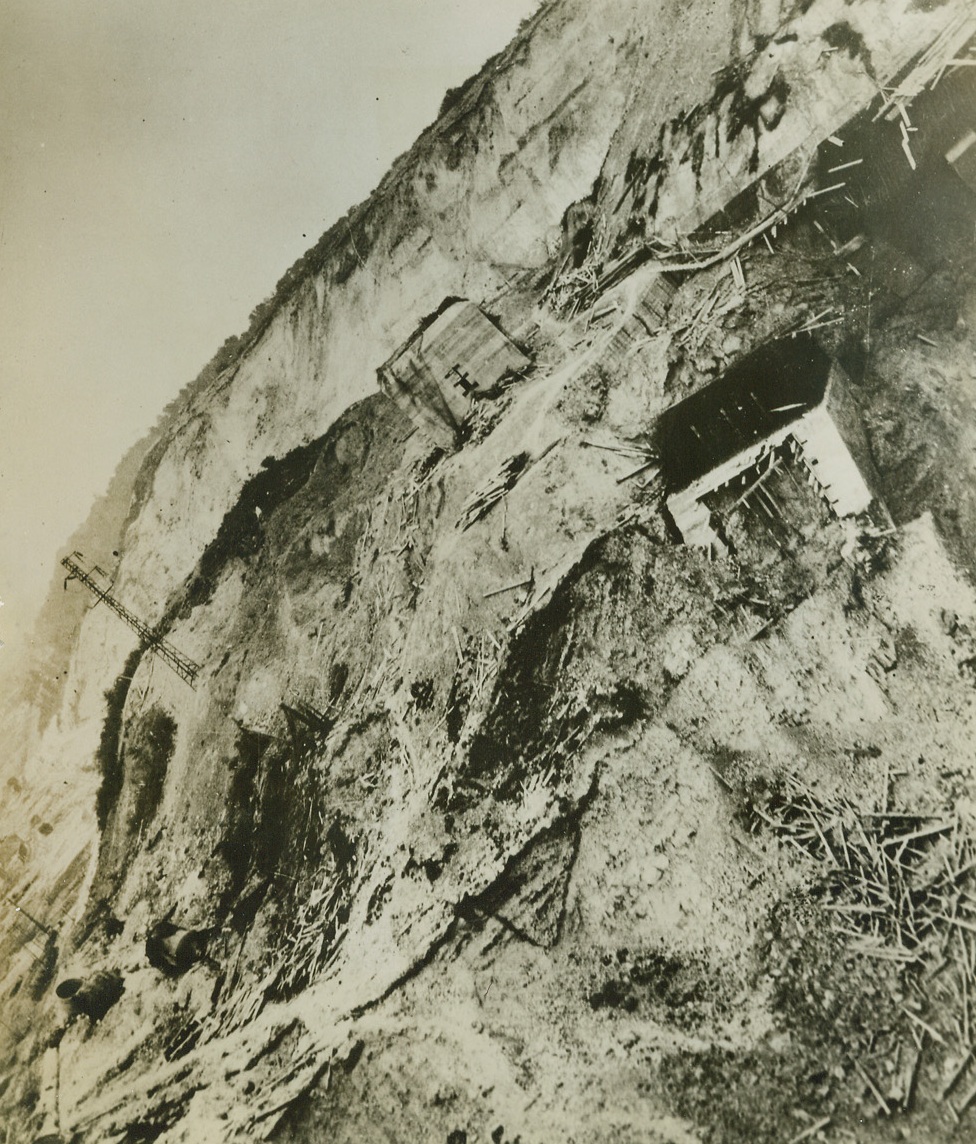
RAF Scores Double Hit On Underground Target, 8/1/1944. Pas De Calais, France – Hidden in a quarry in the Pas De Calais area, German underground installations reputed to be connected with their long-range rocket planes, were attacked by the RAF “heavies” in successive raids on July 17 and July 20. In between the two raids, TODT organization workers sought to repair the damage from the first, but this photo, taken after both attacks, shows timber props used in reconstruction work scattered in all directions. The concrete dome situated on the cliff has a huge gap in the ground supporting it, and other concrete structures have been torn away by the 12,000-pound bombs. For photo of the dome before the raid, see ACME photo # BP 732303. Credit: British Official photo from ACME;
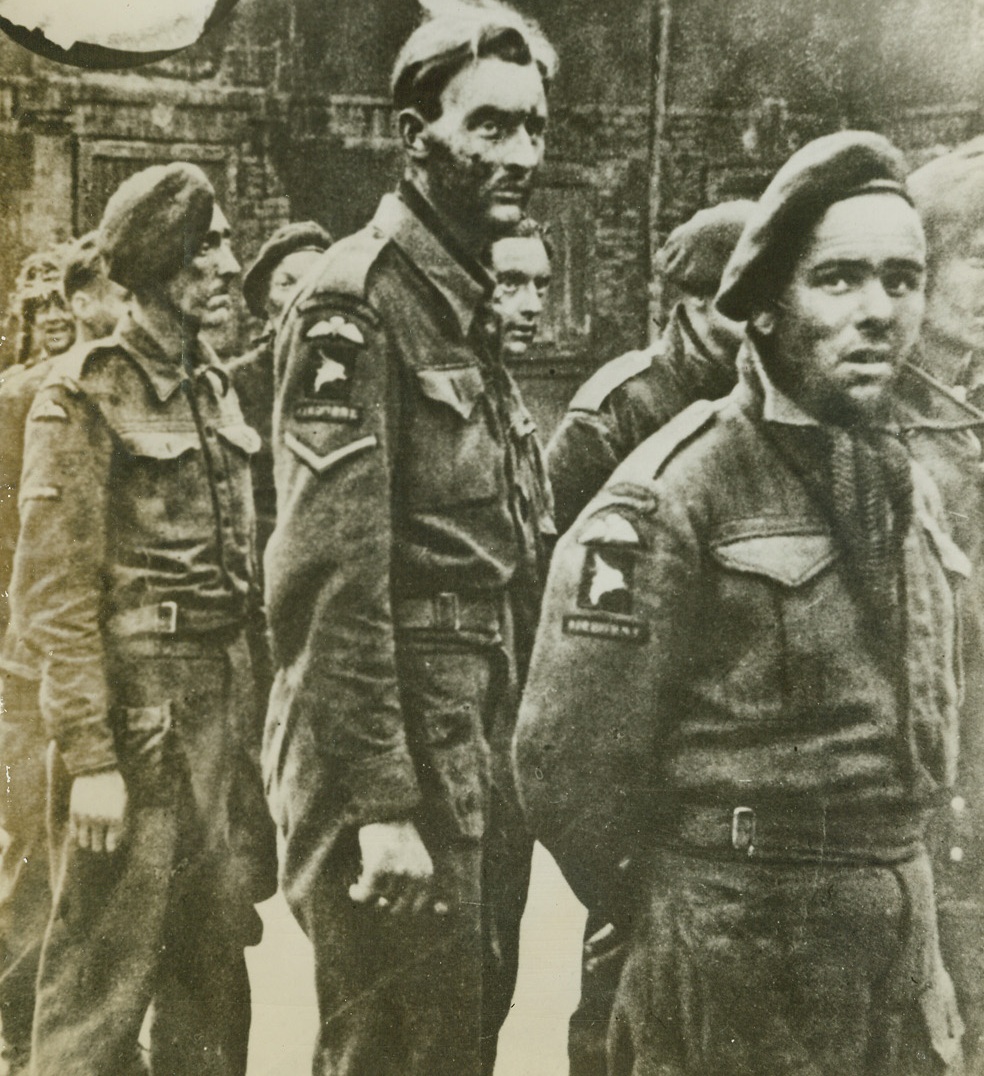
British Soldiers Captured in Normandy, 8/1/1944. Normandy, France – According to the German caption accompanying this photo received in London from a neutral source, these men are British soldiers who have been captured by the Germans in Normandy. Credit: ACME;
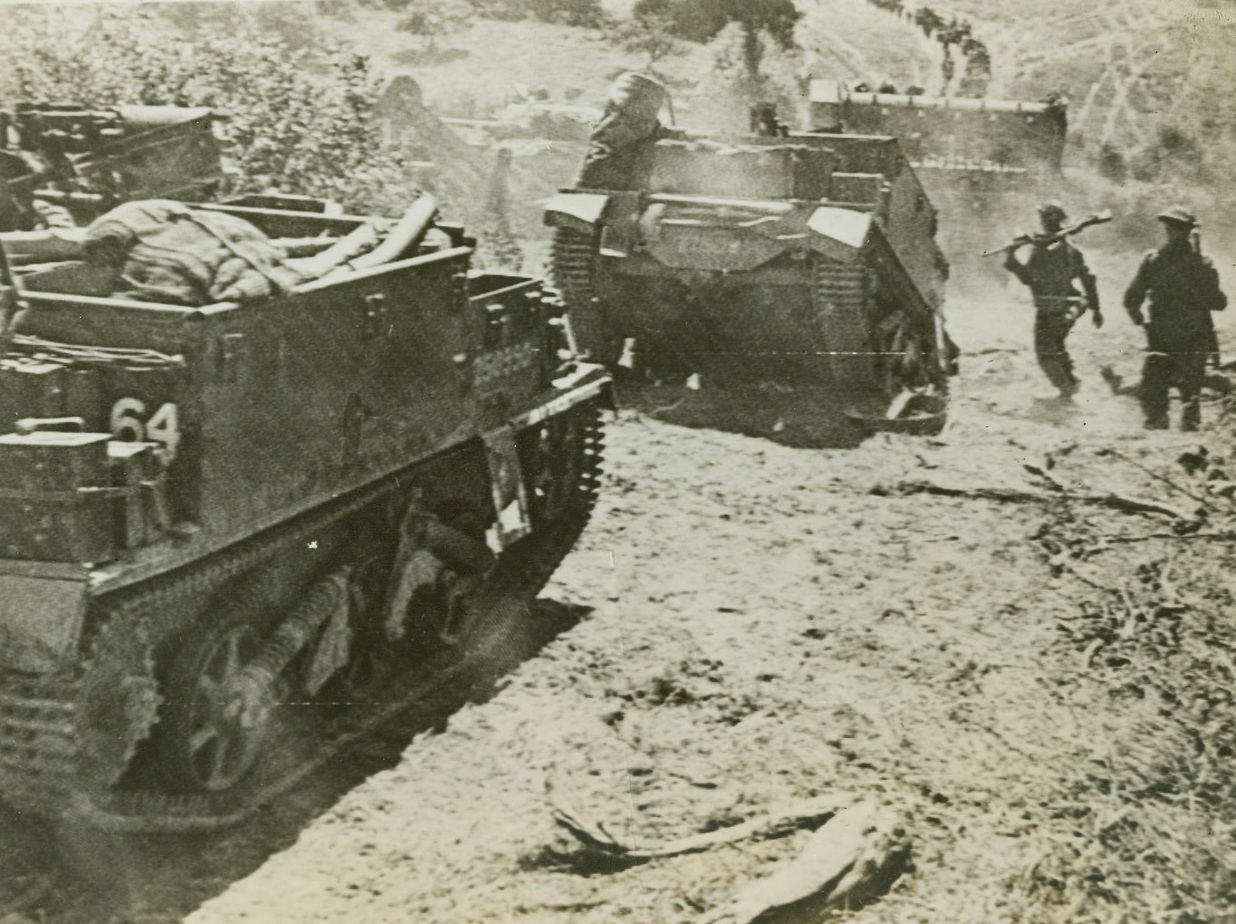
Forward On The Victory Road, 8/1/1944. Caumont, France – During a British attack on the Caumont area, infantry and armored vehicles move forward to the front lines, as the British offensive continues to advance. Credit: British Official Photo via US Army Radiotelephoto from ACME;

Going Home Again, 8/1/1944. France – A long line of French Evacuees on the Coutances-St. Giles road return with their belongings to their homes. Those in the background are not so fortunate as to have wagons. Credit: US Army Radiotelephoto from ACME;
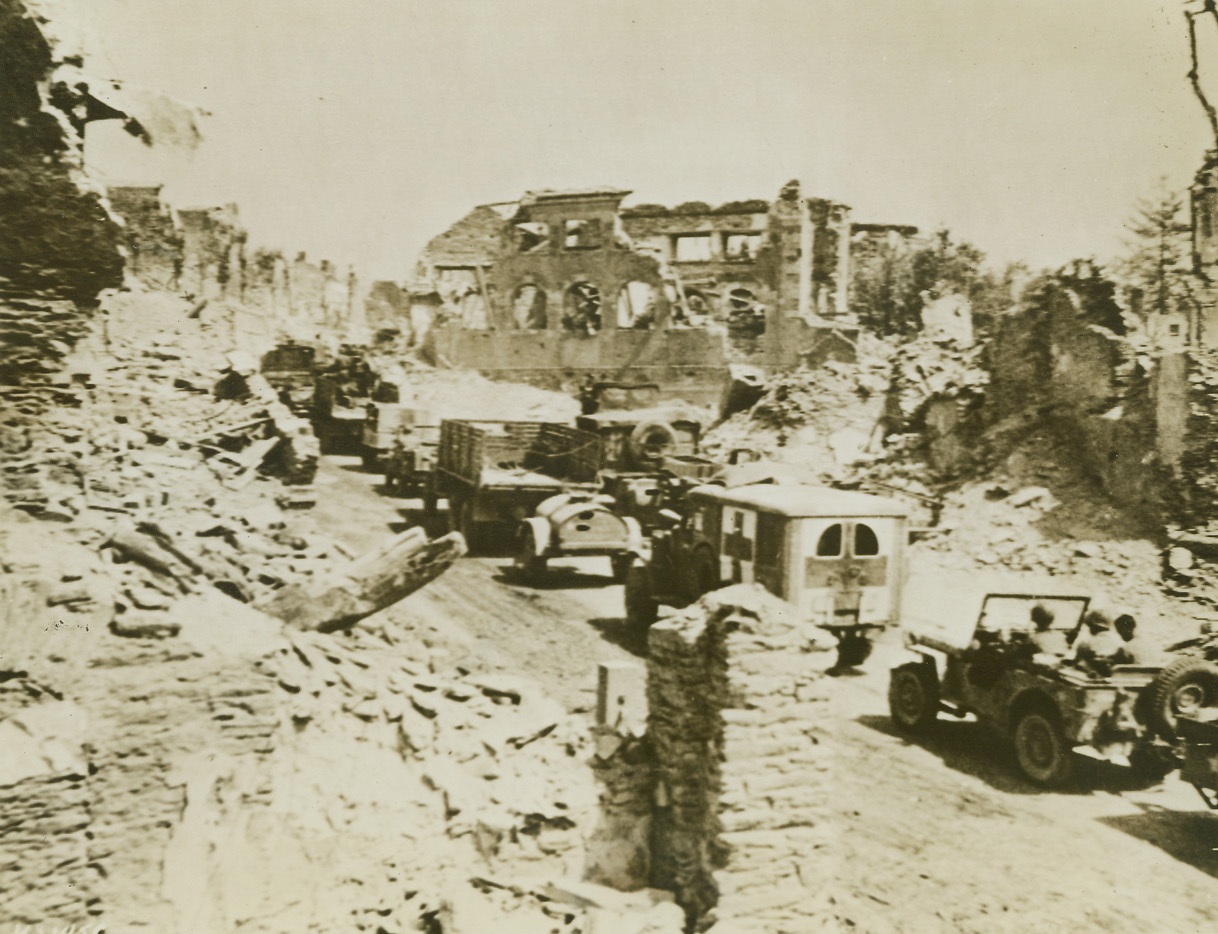
St. Lo Now at Yank Rear, 8/5/1944. France – Military traffic streams through devastated St. Lo, just a little while back the scene of terrific battles, but now far behind the fighting front. Yank advance through Brittany is at a speed almost greater than that achieved by any army in World War II. Credit: Army photo from ACME;
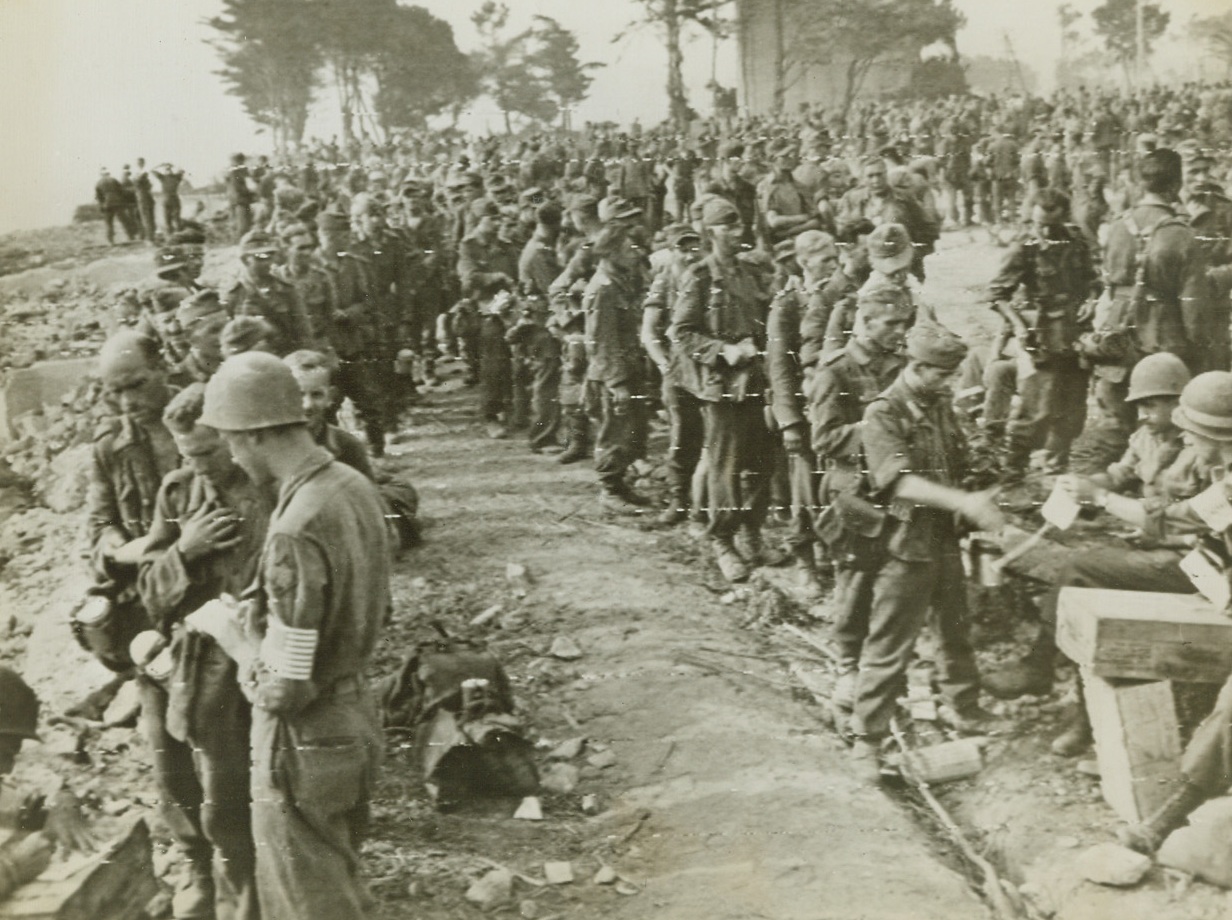
France – Military traffic streams through devastated St. Lo, just a little while back the scene of terrific battles, but now far behind the fighting front. Yank advance through Brittany is at a speed almost greater than that achieved by any army in World War II. Credit: Army photo from ACME; , 8/22/1944. St. Tropez, France – Yanks in the rear lines are kept busy tabulating the war prisoners that come in by the thousands. Here American Military Police keep track of the droves of Nazi prisoners near St. Tropez, France, following their capture by Allies pushing northward from the southern France beachhead. Credit: US Army Radiotelephoto from ACME;
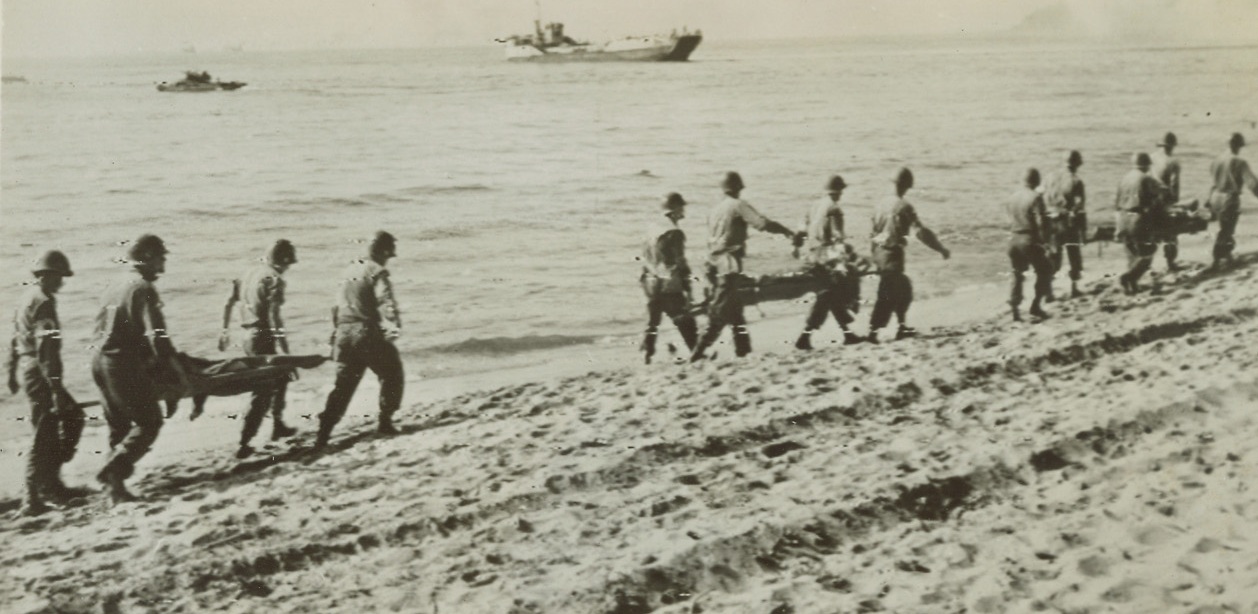
Yank Casualties Leave Southern France, 8/18/1944. France – Litter crews carry American casualties down the coast of Southern France to the waiting Hospital Ships that will evacuate them. These wounded were among the first troops to hit the beach during the initial assault. Credit: Army Radiotelephoto from ACME;
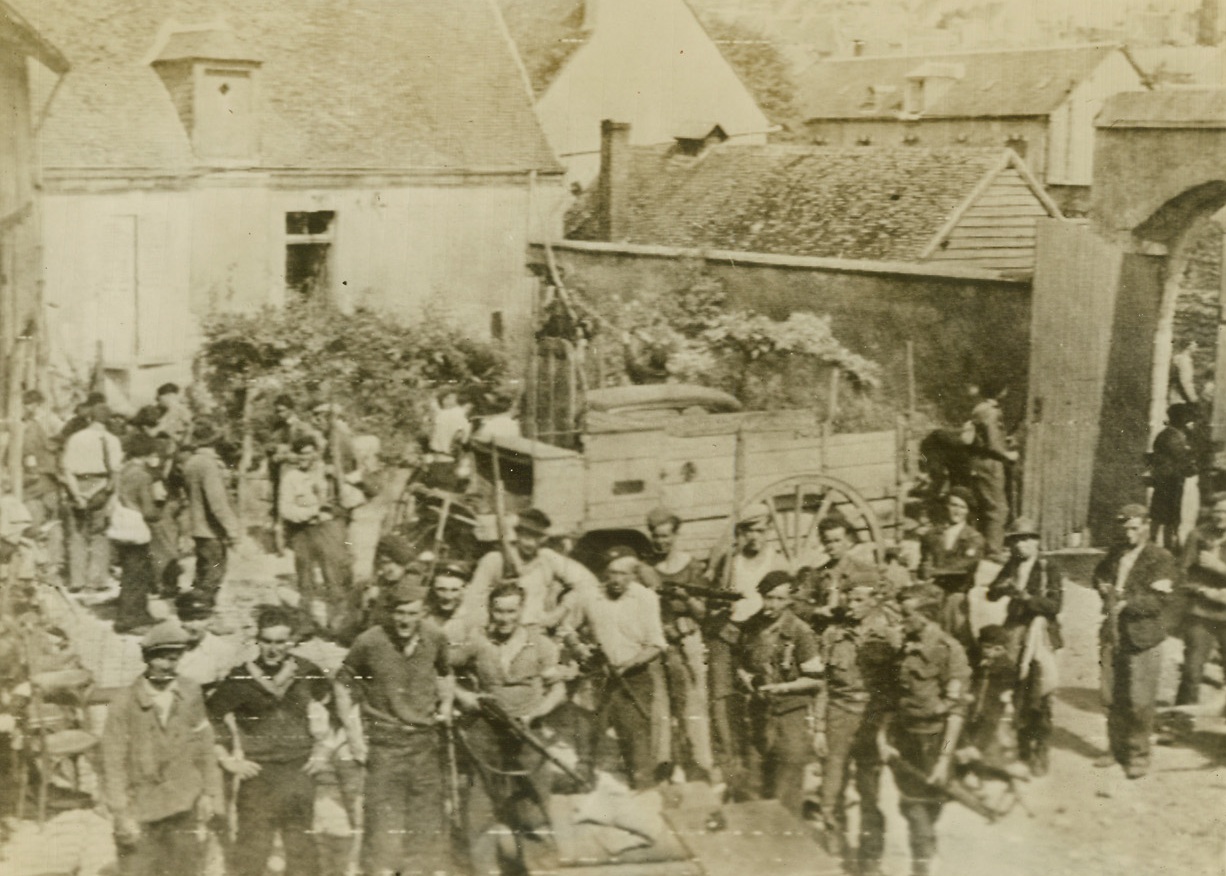
French Patriots Get Guns, 8/23/1944. France – In the yard of a farmhouse near Chateaudun, French patriots collect guns and ammunition and await orders to move on the fleeting Germans. Most of the arms were dropped to the patriots by Allied Airmen. Men like those gathered here were among the French Forces of the Interior, uniformed and not, who today freed Paris from Nazi rule. Credit: Army Radiotelephoto from ACME;
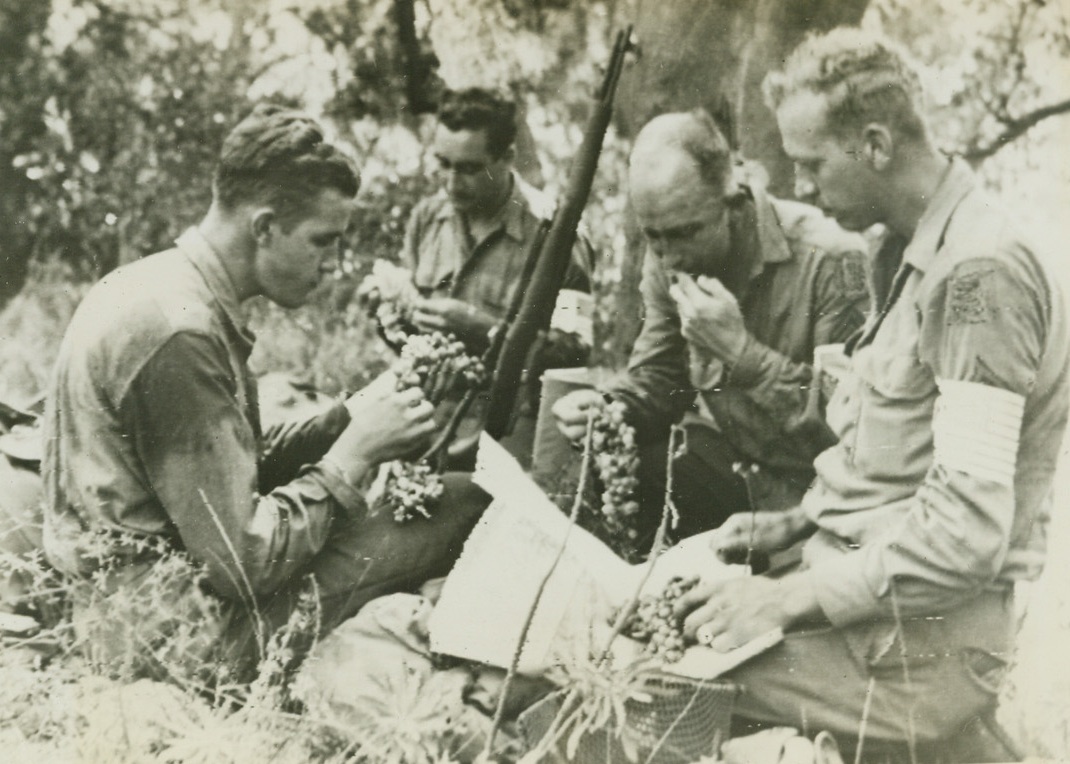
Grapes In Southern France Not Sour, 8/18/1944. France – Four American soldiers relax after storming the beaches of Southern France and dig into some of the famed French grapes found along the Riviera. Eating with relish are (left to right): Pvt. Donal Cheperka, Elgin, Ill.; Sgt. Antonio Oppio, Reno, Nev.; Cpl. William T. Pribble, Nocona, Tex.; and Cpl. John Uecker, Marshall, Minn. Cpl. Uecker studies a map while enjoying the fruit. Credit: Army Radiotelephoto from ACME;
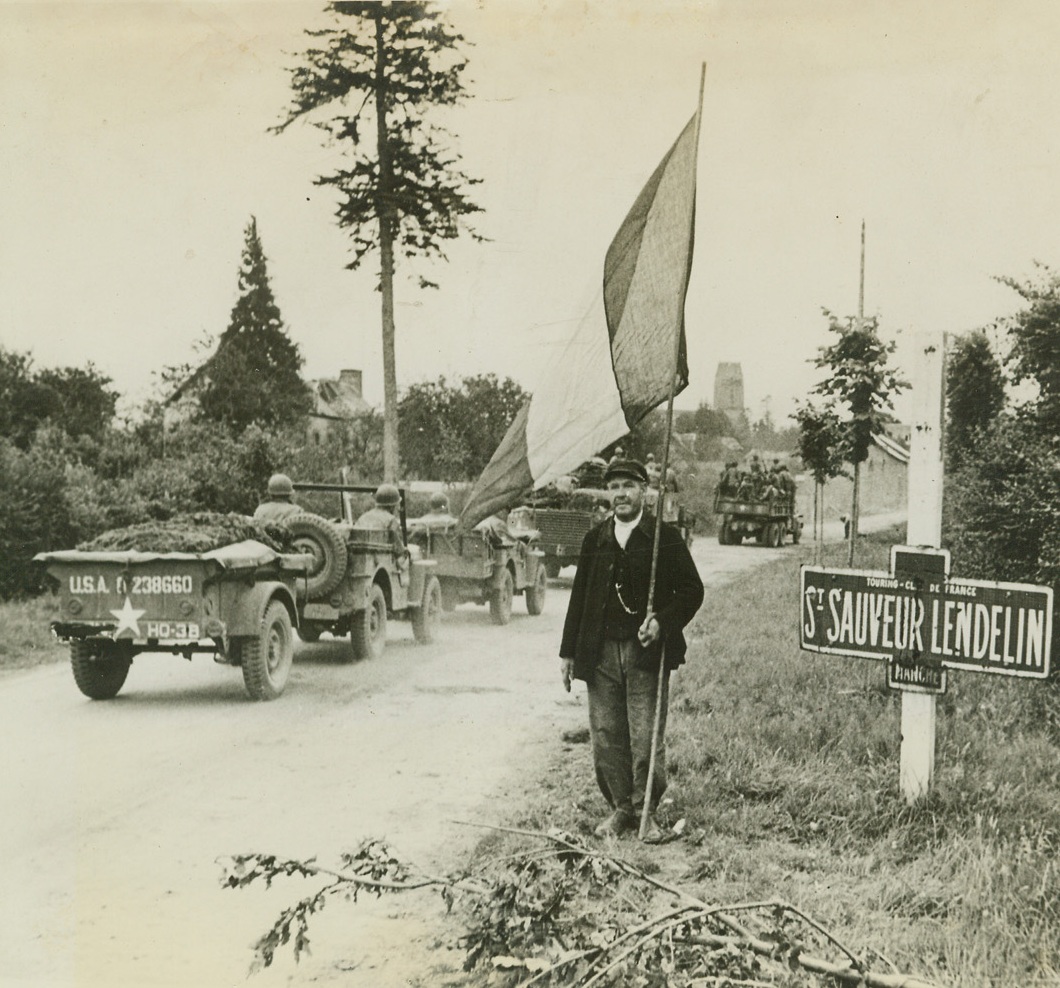
Tricolor Salute, 8/8/1944. France – An American Armored Division receives a greeting from this old French man with a Tricolor on a staff, as it rolls into St. Sauveur Lendelin. Credit: ACME;
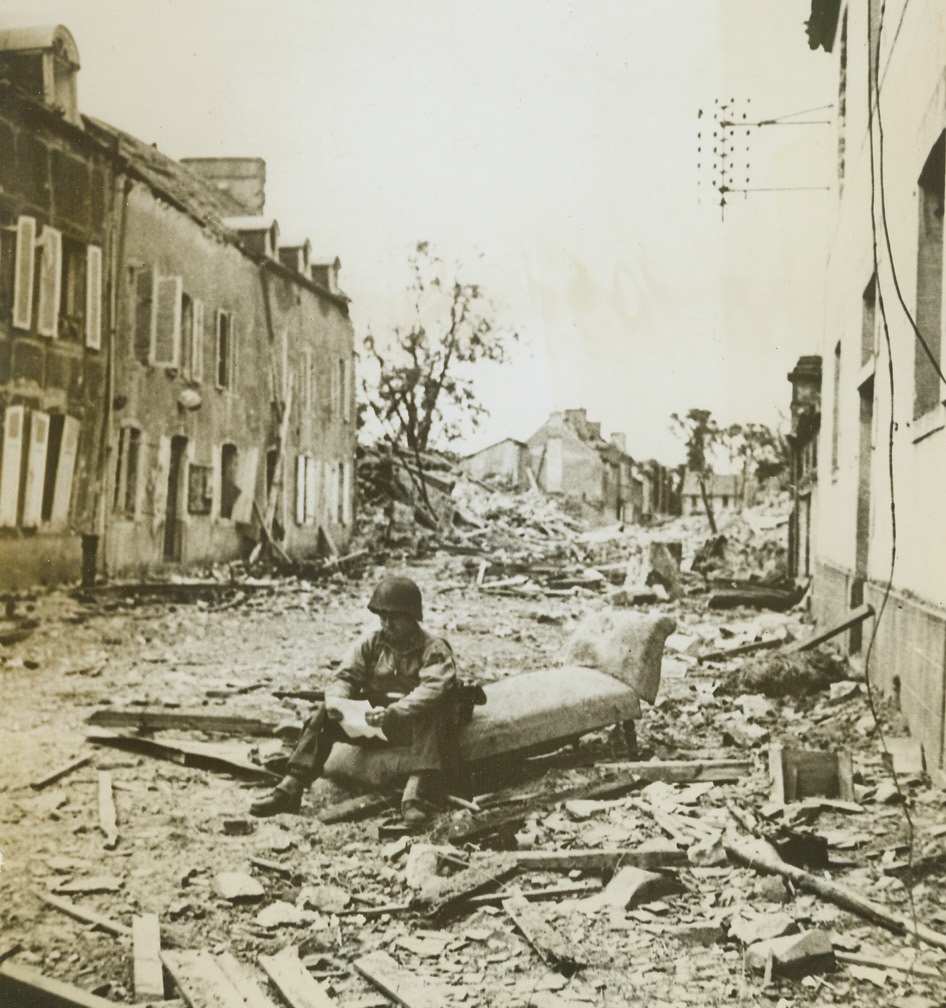
A Bit of Home in France, 8/9/1944. France – Amid the destruction and ruin of St. Sauveur Lendelin, Cpl. Floyd Davis, Nashville, Tenn., sits on an old settee and reads a letter from home. A bit of home injected into this scene of warfare makes for contrast and relief from thoughts of death, destruction, and disaster. Credit: ACME;
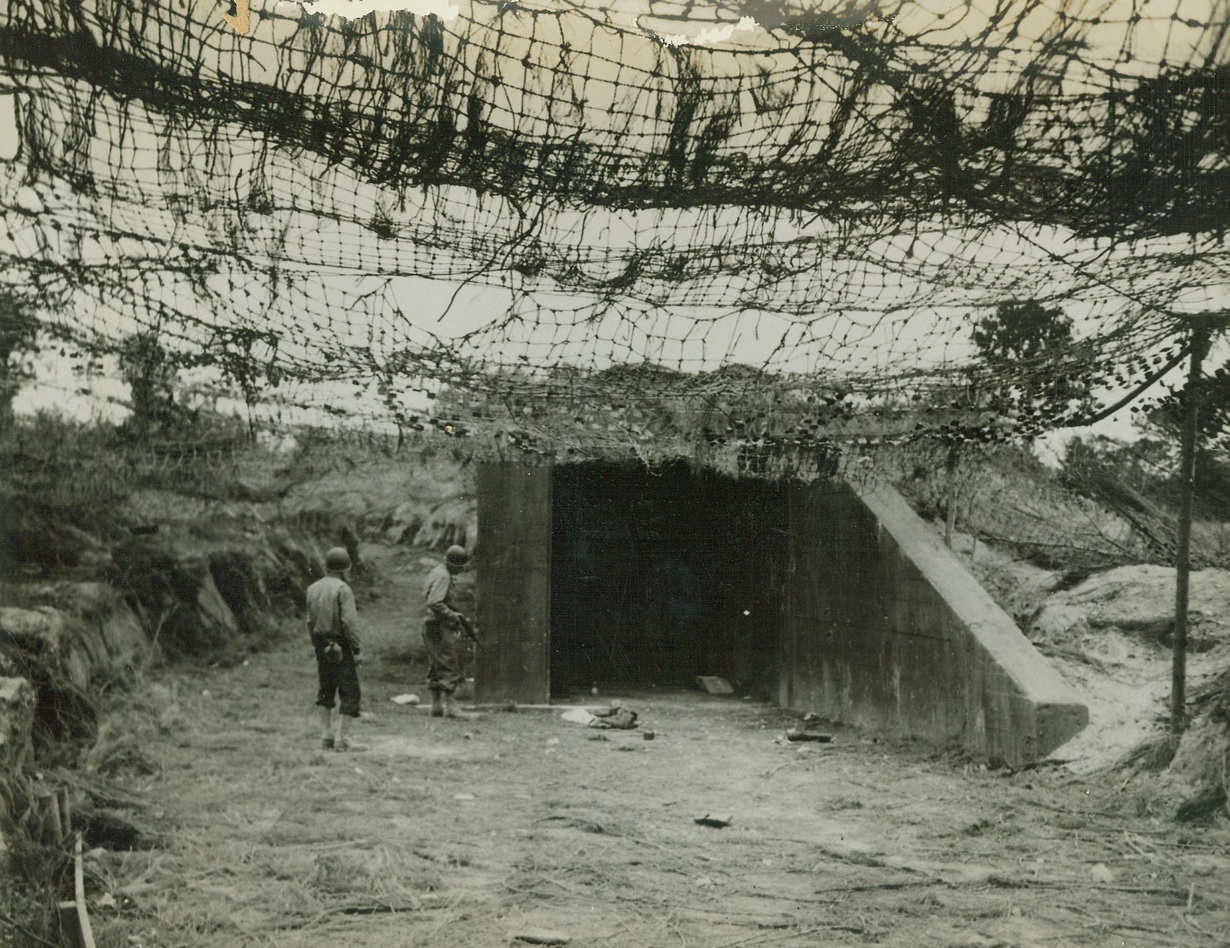
Jumping-Off Place For Robot Bombs, 8/8/1944. France – Allied soldiers examine the mouth of the ski building from which German robot bombs were to be launched for attacks on England. However, the building was left uncompleted when German workers fled in the face of the great Allied offensive drive. Credit: ACME;
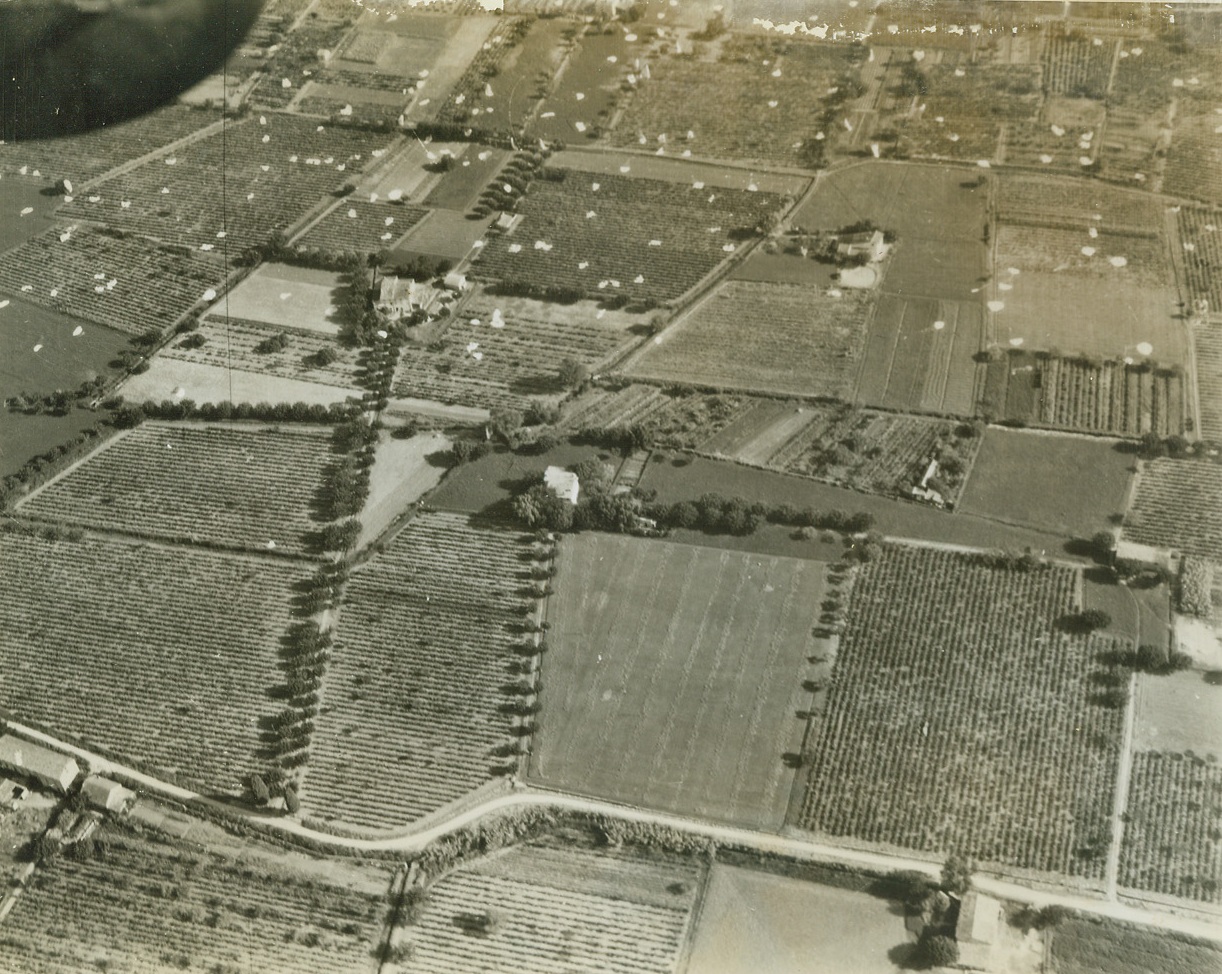
-- Left Their Tails Behind Them, 8/19/1944. Southern France – Parachutes dot the flat terrain of southern France after the early morning landings on August 15, when Allies staged a surprise airborne invasion. Soldiers quickly abandoned their ‘chutes and set out to mop up enemy resistance. Credit: ACME photo by Charles Seawood, War Pool Correspondent;

Nazi Ammo Dump Hits the Sky, 8/18/1944. France – A German ammunition dump, north of Falaise, France, blows sky high after a direct hit during a daylight attack by RAF bombers. Credit: British Ministry of Information photo via Army Radiotelephoto from ACME;

President Chats With Saipan Casualty, 8/10/1944. Hawii-- President Roosevelt (Left Background) chats with a wounded soldier (On Stretcher) at an airfield in Hawaii, during the Chief Executive's recent visit there. The wounded man, whose face has been deleted by censors, has just been flown in from Saipan. 8/10/44 (ACME);
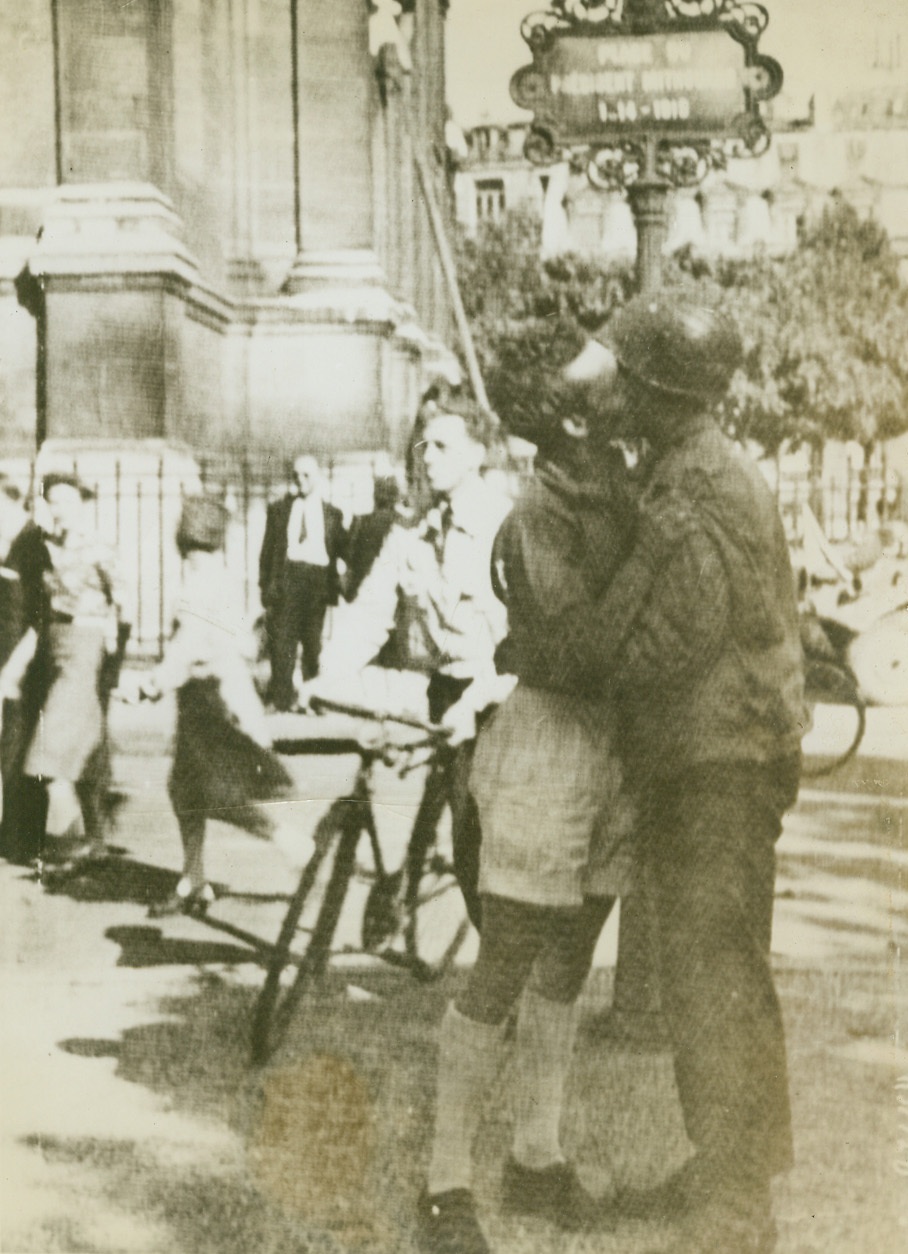
Not Amour – Gratitude, 8/28/1944. Paris – In gratitude for the liberation of his beloved capital, a French civilian gives the traditional exuberant greeting to a Maquis, a member of the French forces which drove the Germans from Paris. Civilians, accustomed to such scenes, pass by with hardly a glance. Credit: Signal Corps Radiotelephoto from ACME;
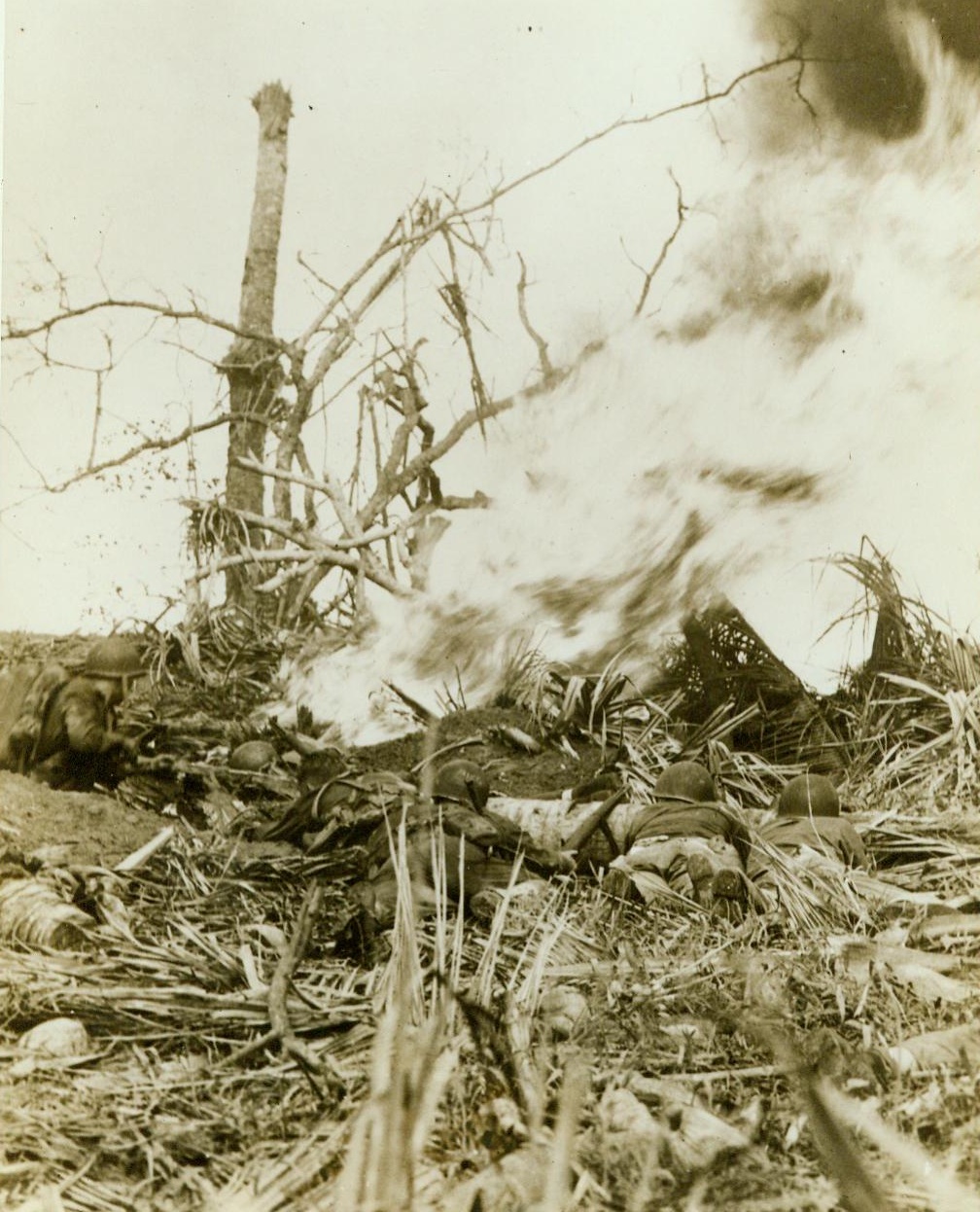
Burn Japs Out of Hiding, 8/2/1944. Guam-- While a Marine (Left) uses a flame thrower to burn the enemy out of a hidden pillbox on Guam, his buddies wait with guns poised for the Japs to show themselves. Although surrounded by leathernecks, the Japs refused to Surrender. (ACME);
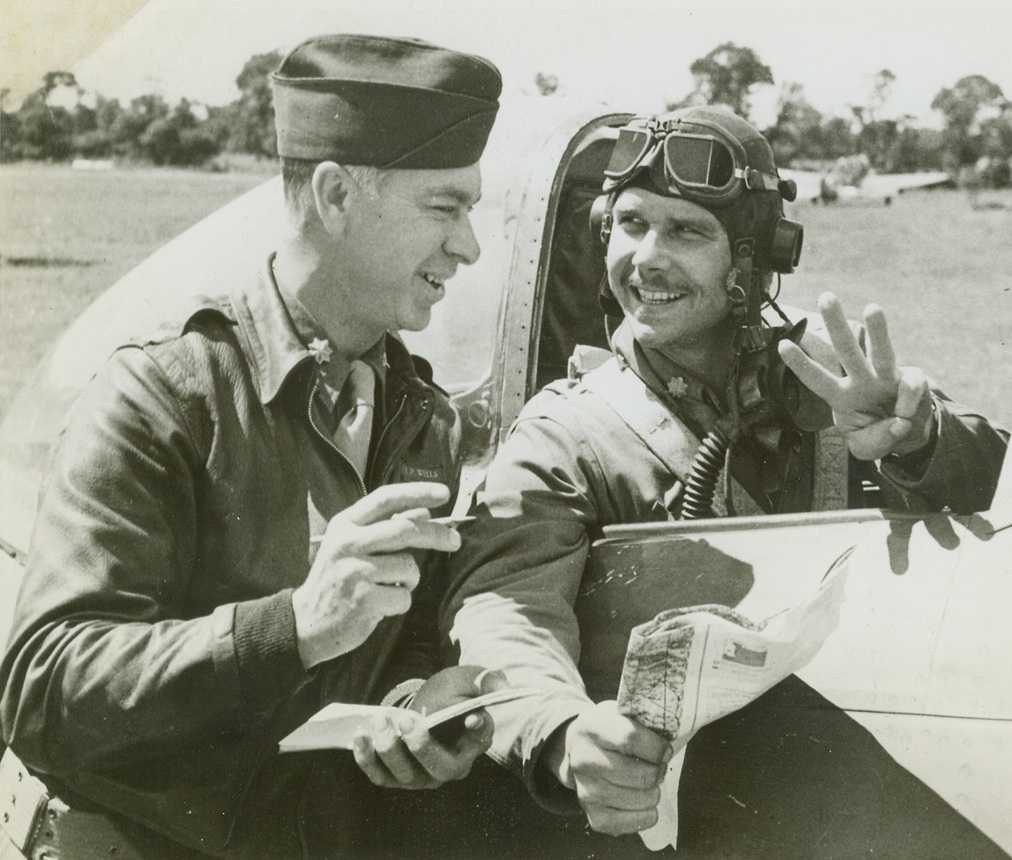
Three Planes, Sir, 8/8/1944. France – Returning from a mission in Normandy, Maj. Rockford V. Gray, Dallas, Texas, reports to Intelligence Officer Maj. Perry Wells, Chicago, Illinois, his quota of three German planes downed during the flight over British lines. These three brought Maj. Gray’s score of planes downed to seven. He has flown 102 combat missions and 182 sorties. Credit: ACME;
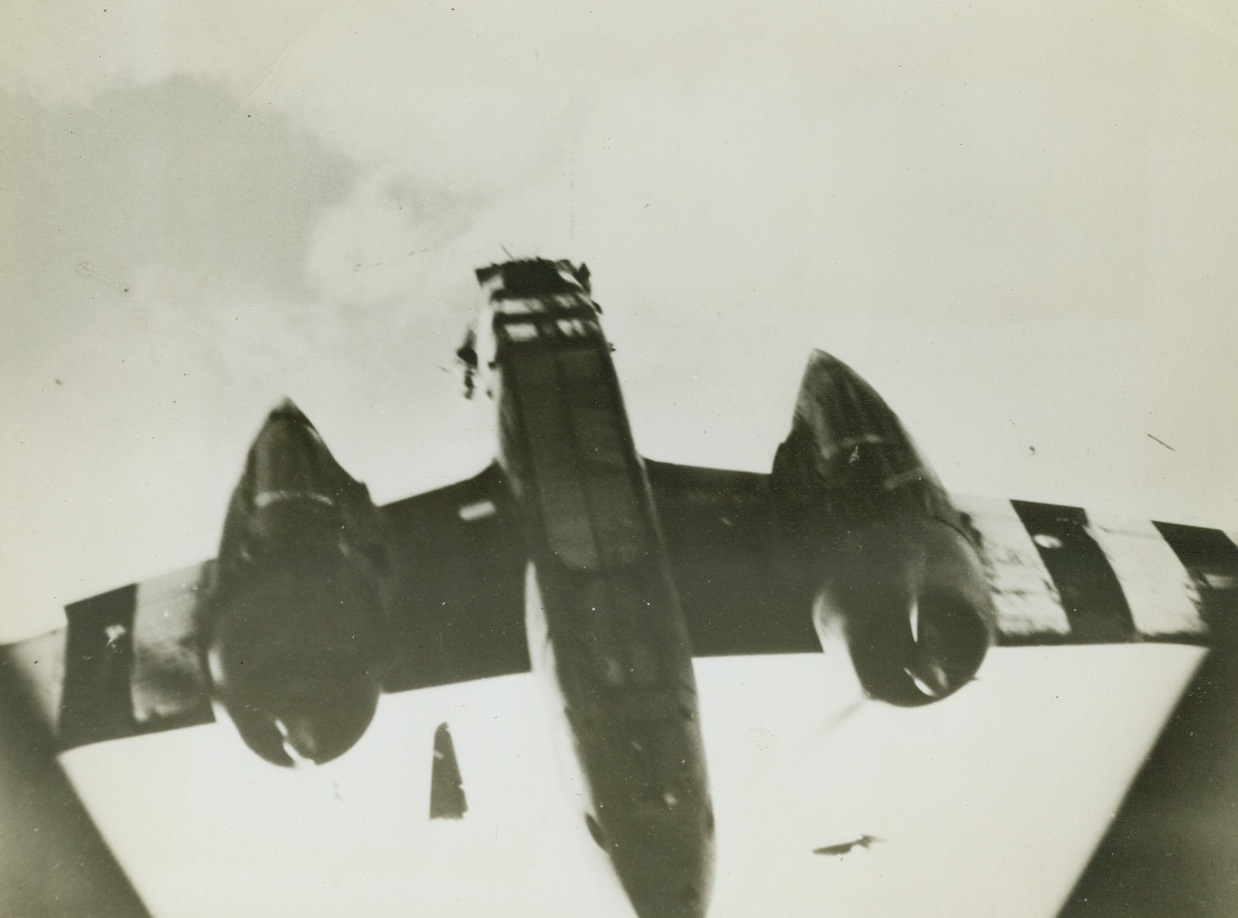
Shot to Pieces, 8/18/1944. The wreckage of the tail section of this A-20 Havoc light bomber of the 9th U.S. Air Force hurtles through the air after the plane was hit by enemy flak somewhere over France. The bomber’s rudder is in an inverted position between the fuselage and the engine at right. The plane plunged to earth just after this photo was made. Credit: USAAF photo from Acme;
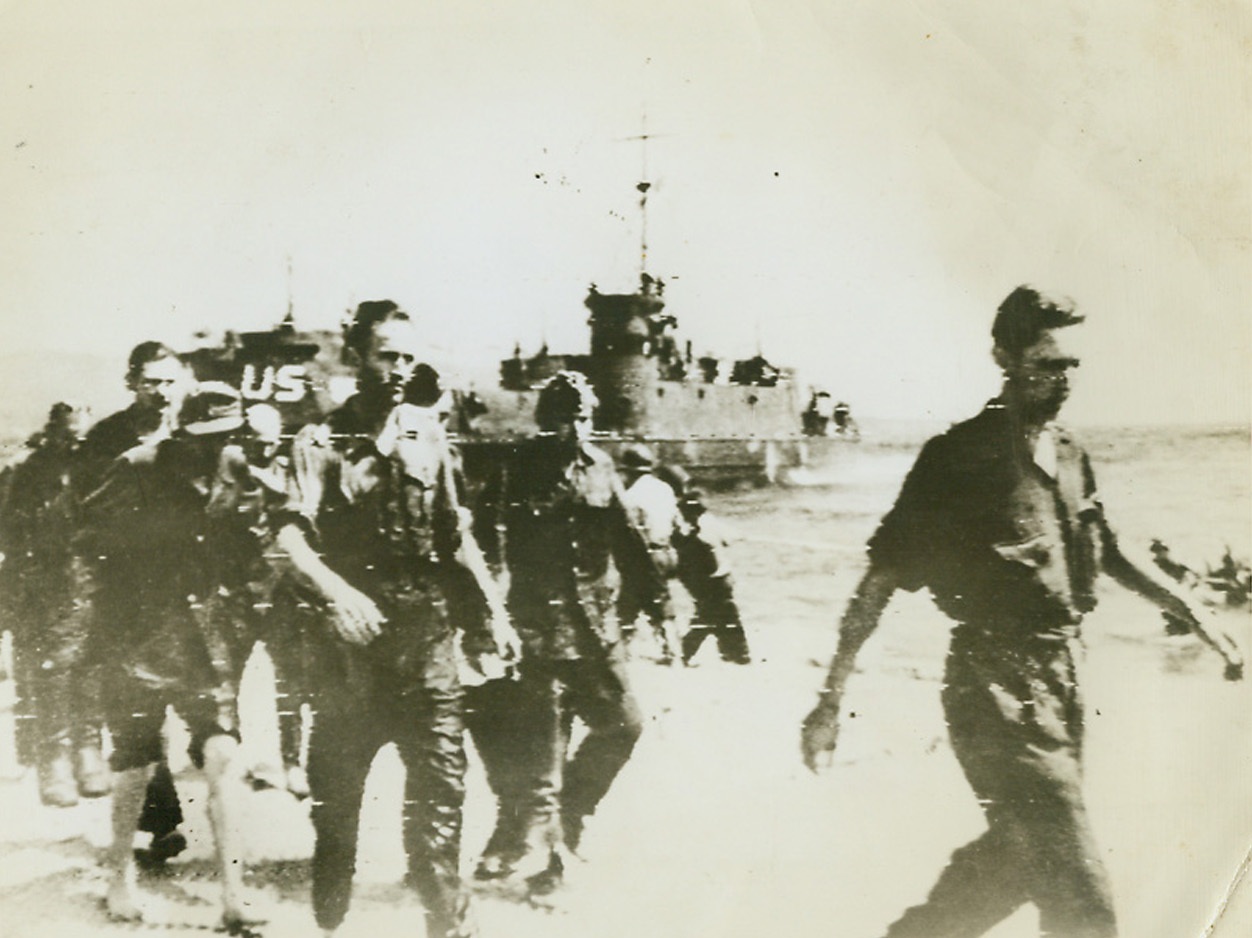
First Prisoners in New Invasion, 8/16/1944. France – As Allied troops come ashore from the LCIs in background, a group of Germans—first prisoners taken in the invasion of Southern France—march along the beach under guard. Credit: Army Radiotelephoto from ACME;
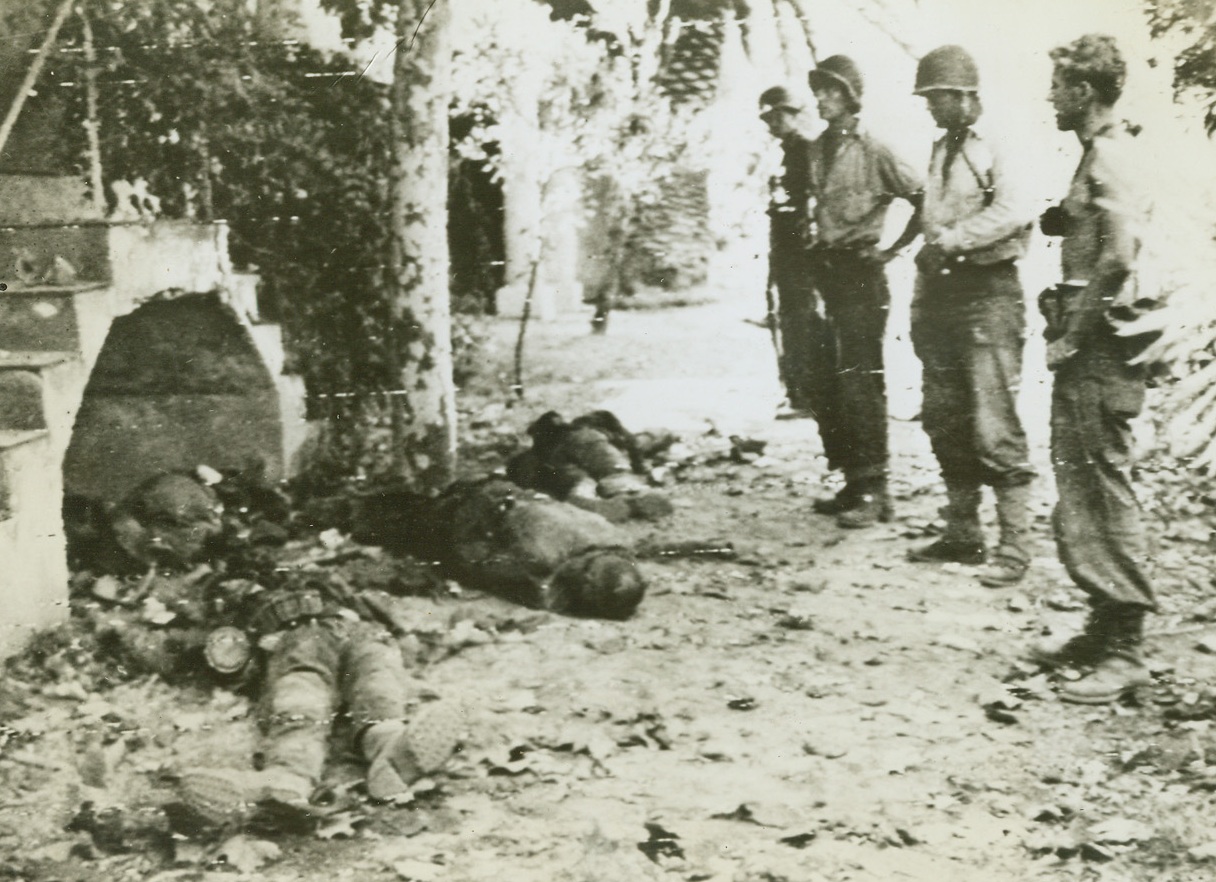
Nazis Killed in New Invasion, 8/16/1944. France – U.S. soldiers (right) solemnly view the bodies of German soldiers killed in this Allied landing east of Toulon, in Southern France. Having secured their beachhead, Allies are driving inland proceeding according to plan. Credit: Army Radiotelephoto from ACME;
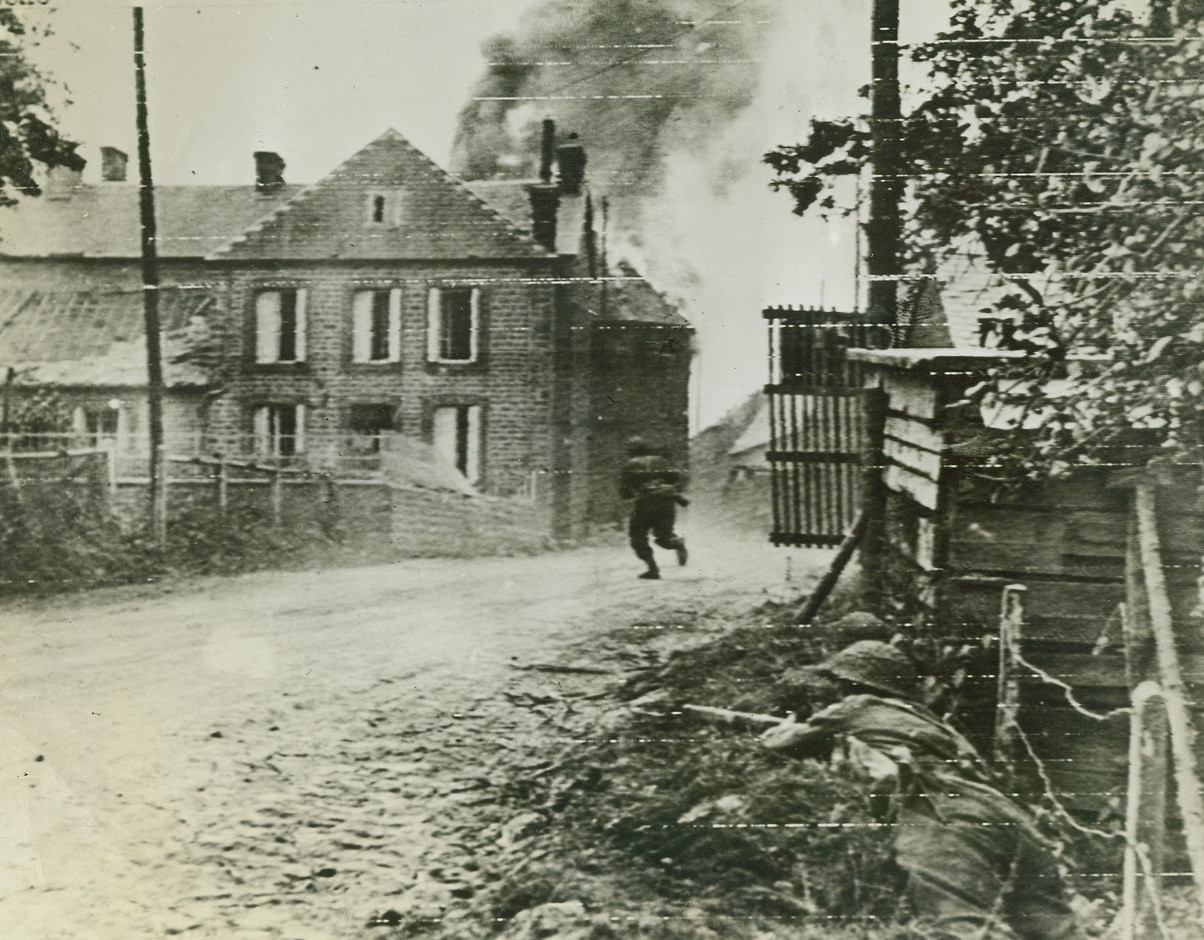
Looking for Snipers, 8/8/1944. France – A British infantryman, his gun held ready, dashes across a road in Montchauvet, while two of his buddies (right, foreground) cover him. The men are after snipers hiding in buildings in background. Credit: British War Office photo via Army Radiotelephoto from ACME;
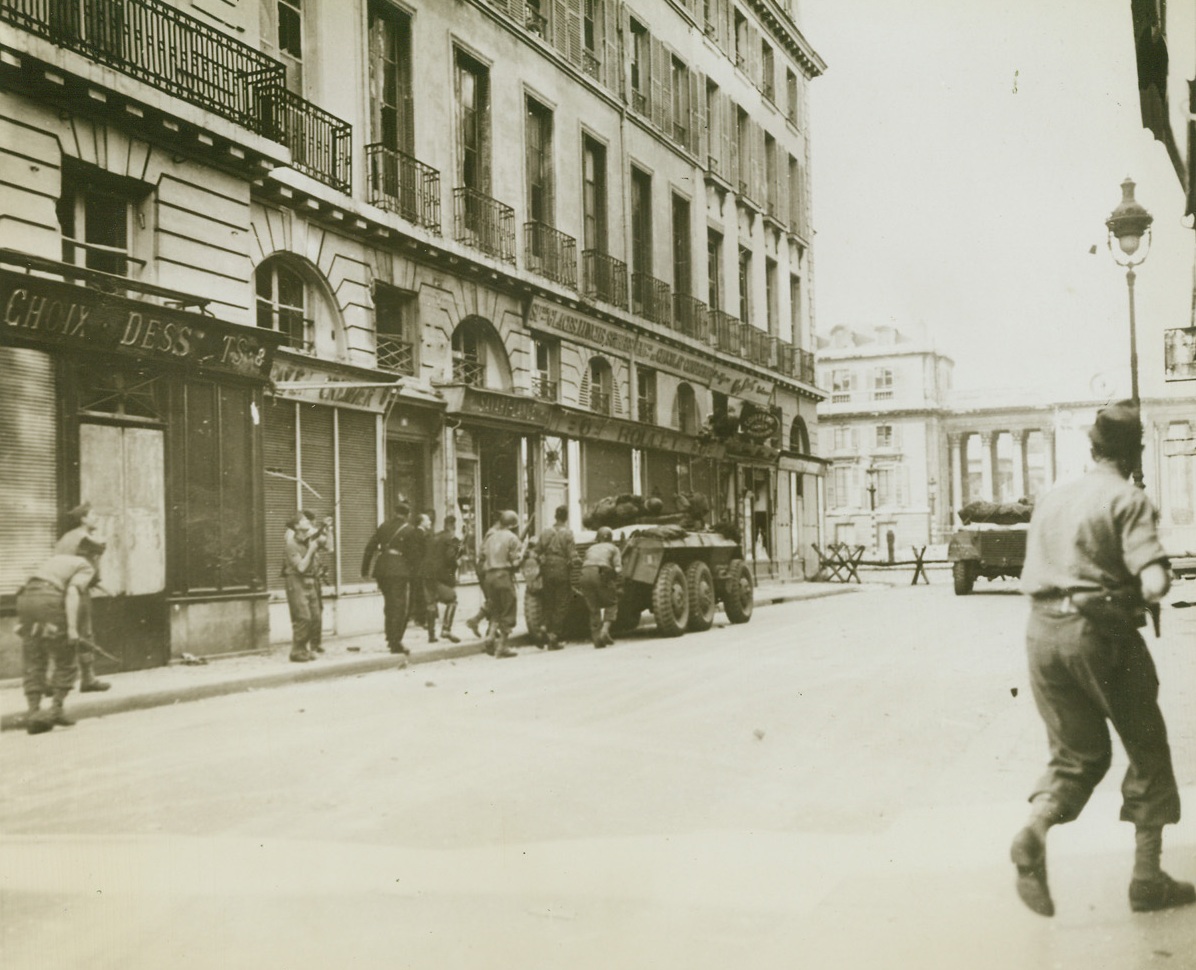
France Regains Its Chamber of Deputies, 8/30/1944. France – American and French troops deploy cautiously, taking what cover they can find behind armored vehicles, to attack a German garrison of some 400 men barricaded in the famous Chamber of Deputies in Paris. The Chamber is at the foot of this street. Credit: ACME;
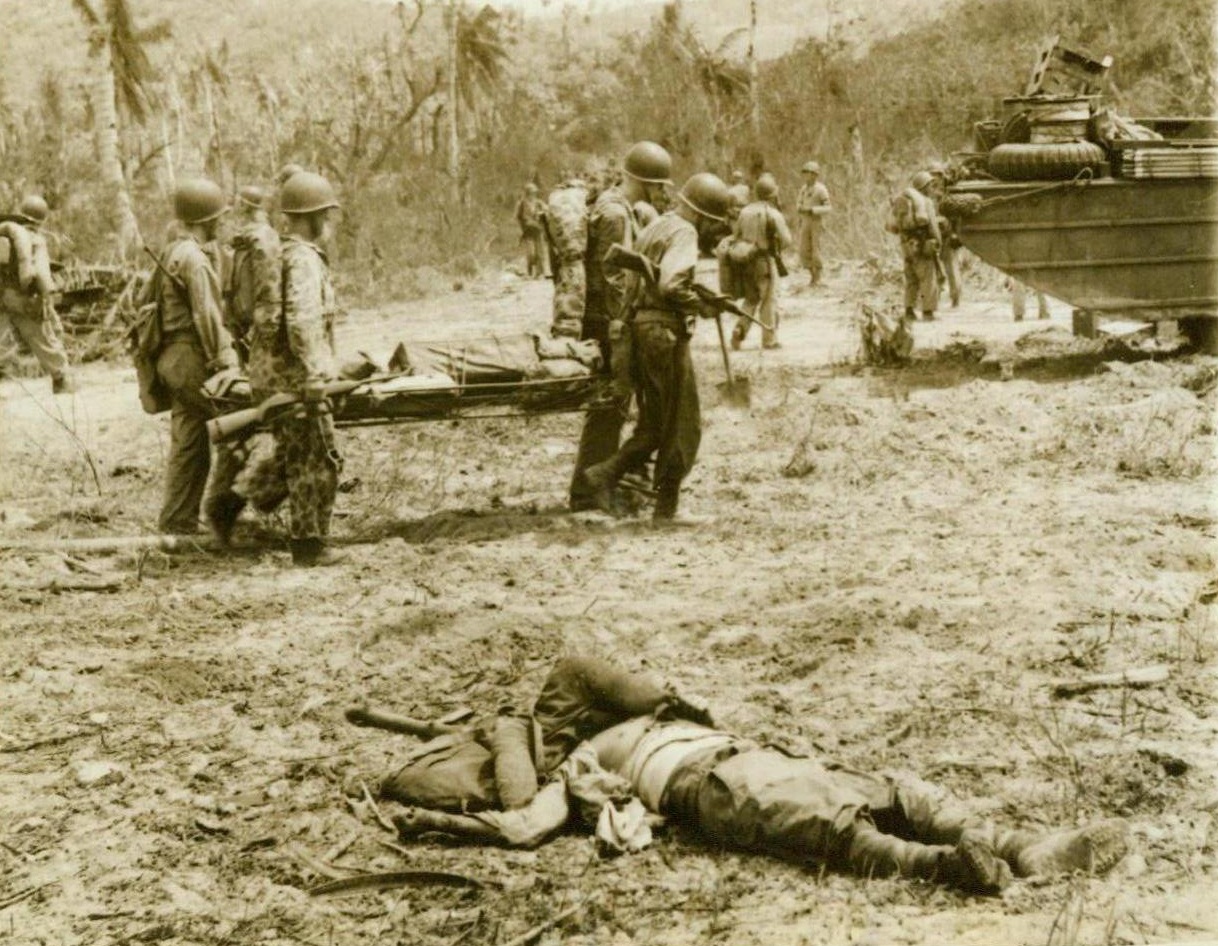
One of Many, 8/4/1944. Guam—US Marines move forward near Asan Point, carrying a litter of supplies to their forward troops. In the foreground is a dead Jap, one of the 7,419 enemy dead who have been buried by the Marines since they landed on the island. Although enemy resistance has stiffened, the American forces continue to advance unchecked. 8/4/44 (ACME);
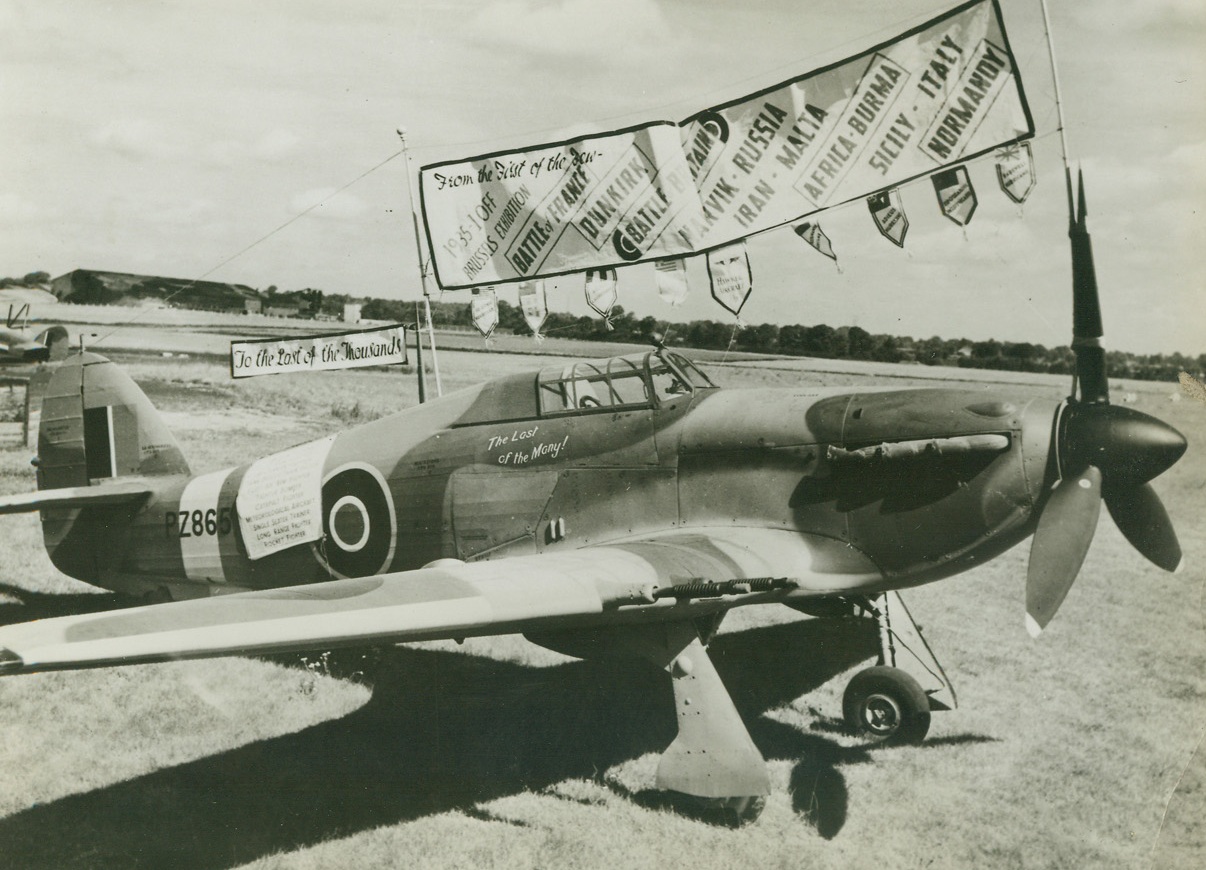
The Last of the Hurricanes, 8/22/1944. England – Fancifully decorated is this, the last Hurricane to be produced by the Hawker Aircraft Company. Banners and pennants describe the many achievements of the famous fighter. Credit: British Official Photo from ACME;

Back from Raid on Alsace Lorraine, 8/22/1944. England – American airmen return to their base in England after raiding targets in Alsace Lorraine. They are (left to right): S/Sgt. Henry L. Wolf, Coahoma, Texas; Sgt. Burdette E. Bonner, Galesburg, Illinois; S/Sgt. Robert B. Linnemann (stooping), Cincinnati, Ohio; 2nd Lt. Burnett L. Deyerle, Roanoke, Virginia; Joseph R. Lyons, Wooster, Massachusetts; 2nd Lt. Lorne R. Marlatt, Brooklyn, New York; and 1st Lt. Neil A. Daniels, Oak Park, Illinois. Credit: ACME;

Hitler’s V-1 Goes Kaput, 8/22/1944. England – These photos taken with an automatic camera fitted to a fighter plane flying over England show the death of one of Hitler’s flying bombs—the V-1. At upper left the bomb, in full flight, tears toward its target at four miles a minute. Hit in a vital spot, as shown in upper right, the flying bomb falters and slows down. Smoke pours from its jet mechanism and fuselage. At lower left the weapon is in its death throes. Black clouds of smoke stream and almost completely envelope it. The fire spreads to the explosive war-head and in the last photo of this series, lower right, the bomb explodes harmlessly in a huge glare of light in mid-air. Credit: British Official Photo from ACME;

Marking Liberation of Paris, 8/23/1944. London – By way of celebration of the Liberation of Paris, Londoners hoisted a flag bearing the Cross of Lorraine to wave over the British capital. In the background is St. Paul’s Cathedral. Credit: ACME Radiophoto;
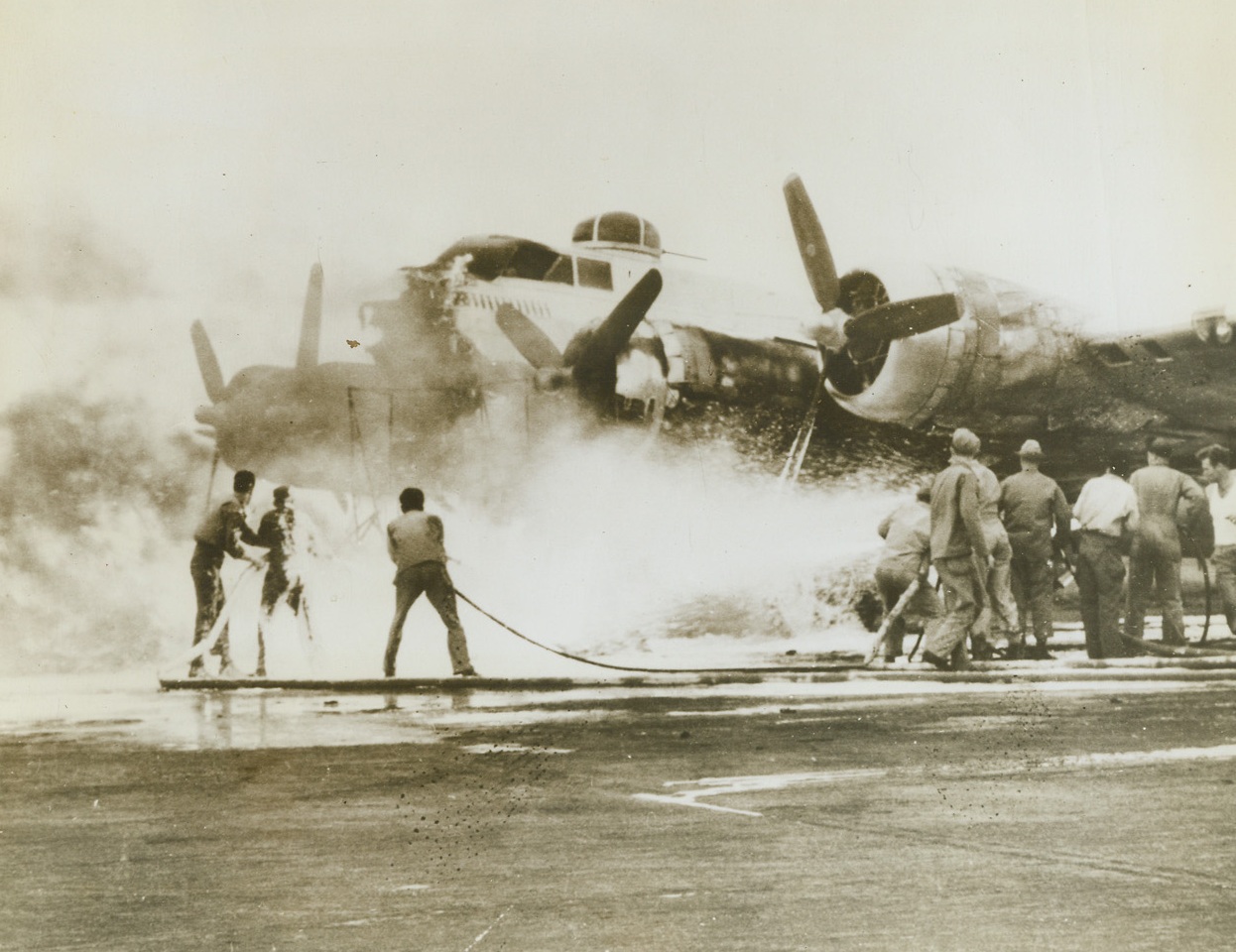
Work on Fired B-17, 8/30/1944. England – An Engineer Aviation Fire Fighting Platoon works hard to put out a fire on a B-17 Flying Fortress at a base in England. Fortresses carry a heavy load of gasoline and often have a full bomb load when fire breaks out. Credit: USAAF photo from ACME;
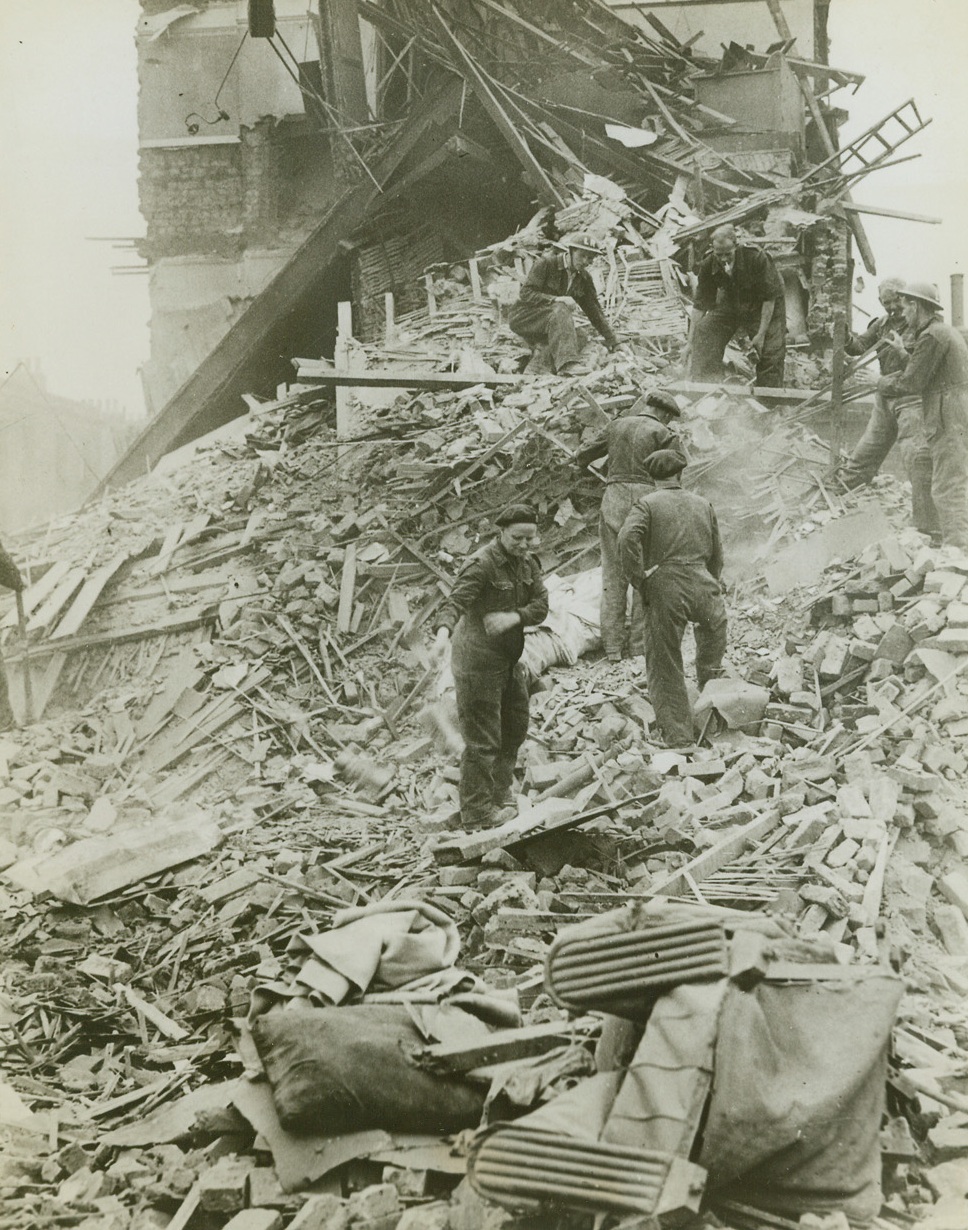
Robot Bombs Devastate Southern England, 8/7/1944. Southern England – While falling concrete and plaster raise a smoky haze, workmen search through the wreckage of homes for victims of the raid. A direct hit from one of the bombs has completely razed this house and only a wall of the one in the background remains standing. Credit: ACME;
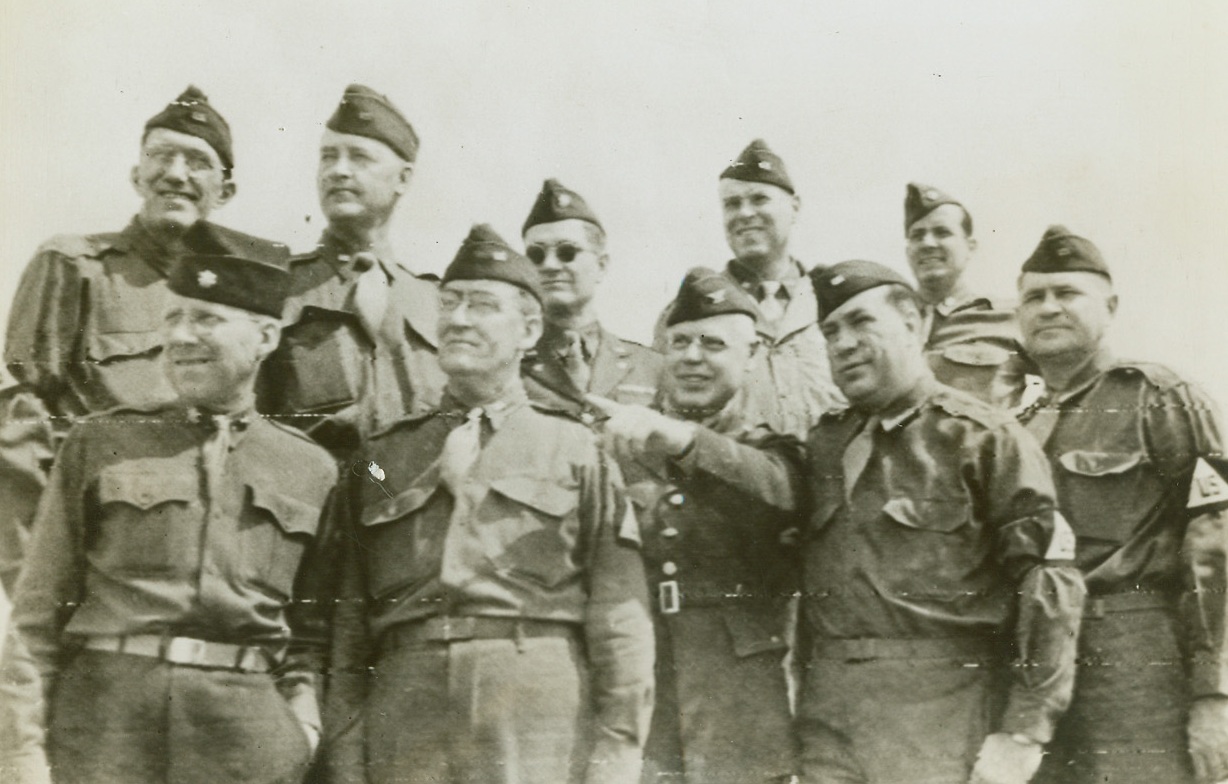
Inspect Yank Equipment in England, 8/19/1944. England – Labor leaders, accompanied by Army officers, tour England to inspect American equipment, and see the use to which it is being put by the A.E.F. In the picture are Lt. Col. Dillman A. Rash, Sherman N. Dalrymple, Col. B.H. Connors, R.J. Thomas, Albert L. Wegener, Eric Peterson, Lt. Col. John B. Watkins, David J. McDonald, and Lt. Col. De Lessers S. Morrison. Credit: Signal Corps Radiotelephoto from ACME;
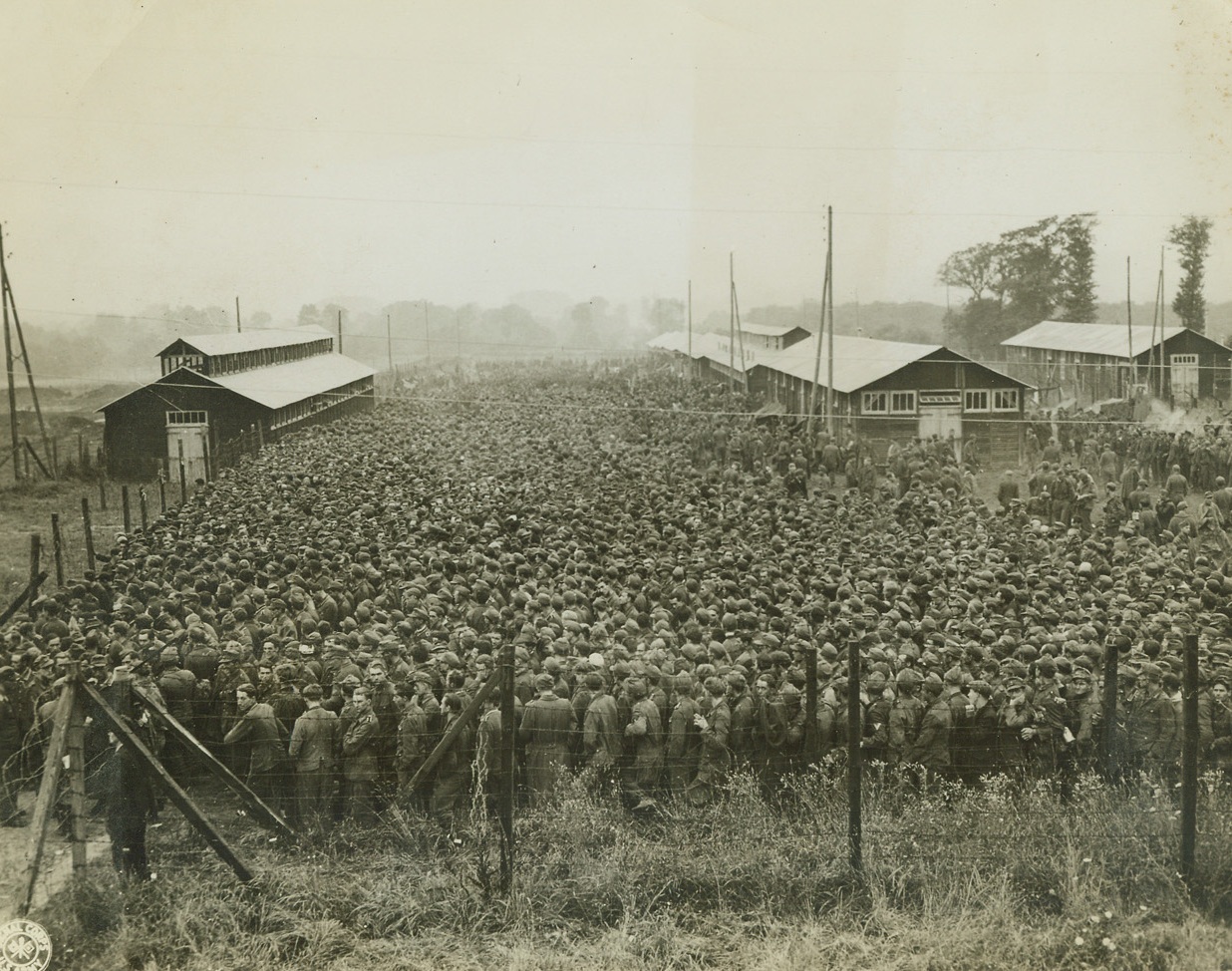
Ten Thousand Hungry “Supermen”, 8/29/1944. France – In this compact mass, stretching far into the background, are ten thousand German prisoners, captured during the Allied drive in France. It’s “chow time” here, and they’re lining up for their lunch in their stockade somewhere in France. Credit: Signal Corps Photo from ACME;
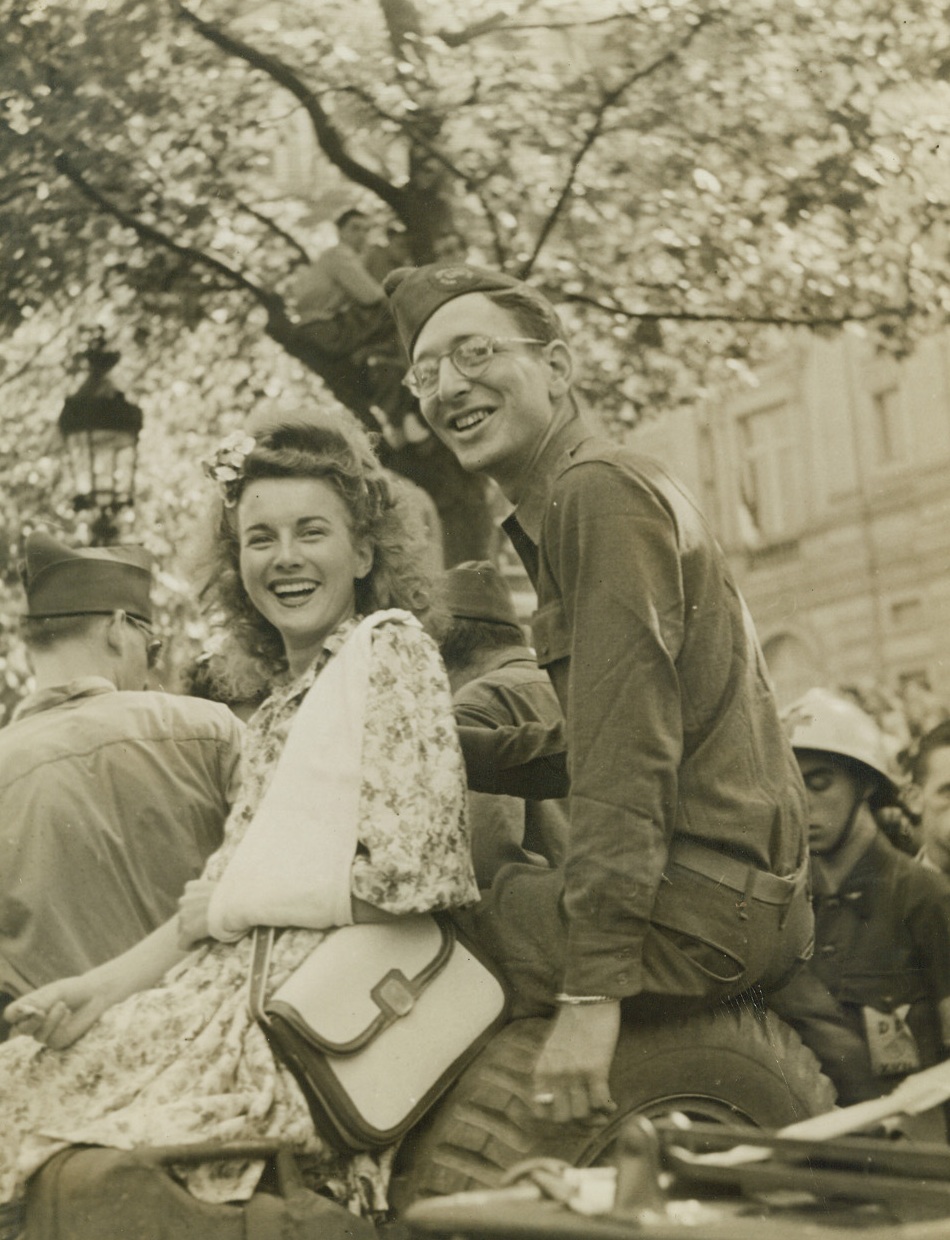
NEA Correspondent Does Himself Proud, 8/30/1944. France – Tom Wolf, NEA war correspondent, sits with his arm around a very beautiful French lassie whose heart he probably captured by offering her a lift in his jeep as liberating forces entered Paris. The blonde-haired beauty has her arm in a sling. Credit: ACME Photo by Bert Brandt, War Pool Correspondent;

How About Moving Over, Bud?, 8/8/1944. GUAM - This Husky, of the War Scouting Dogs, looks like he'd like a little share of that foxhole, comfortably occupied by a U.S. Marine on Guam. Dogs are valuable scouts for the leathernecks during the daytime, and excellent outposts at night.;
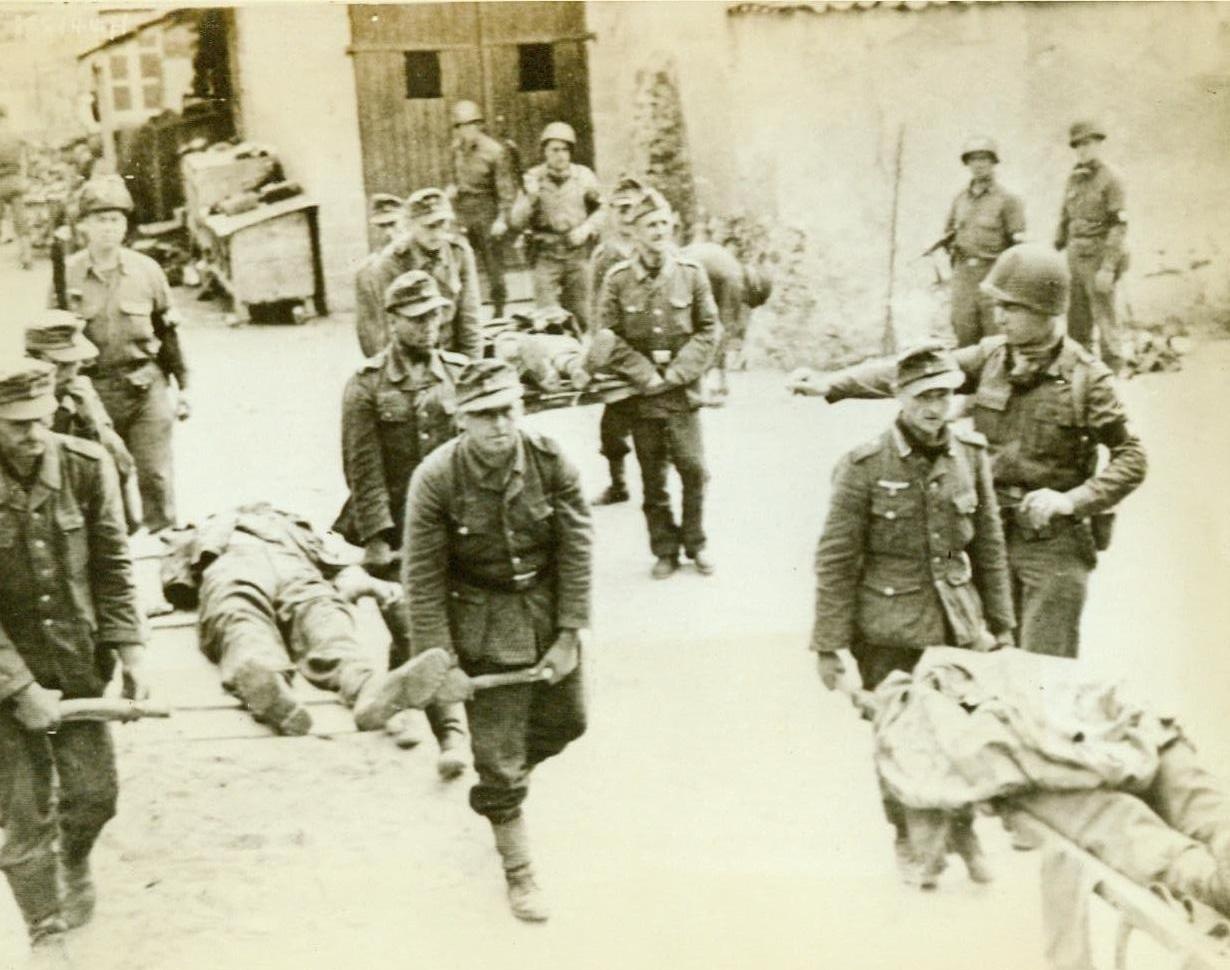
Germans Bury Their Own Dead, 8/4/1944. France—In solemn procession Germans carry their own dead for burial in a military cemetery at Brehal, France. Note the improvised litters bearing the dead Nazis. 8/4/44 (Acme RadioPhoto);
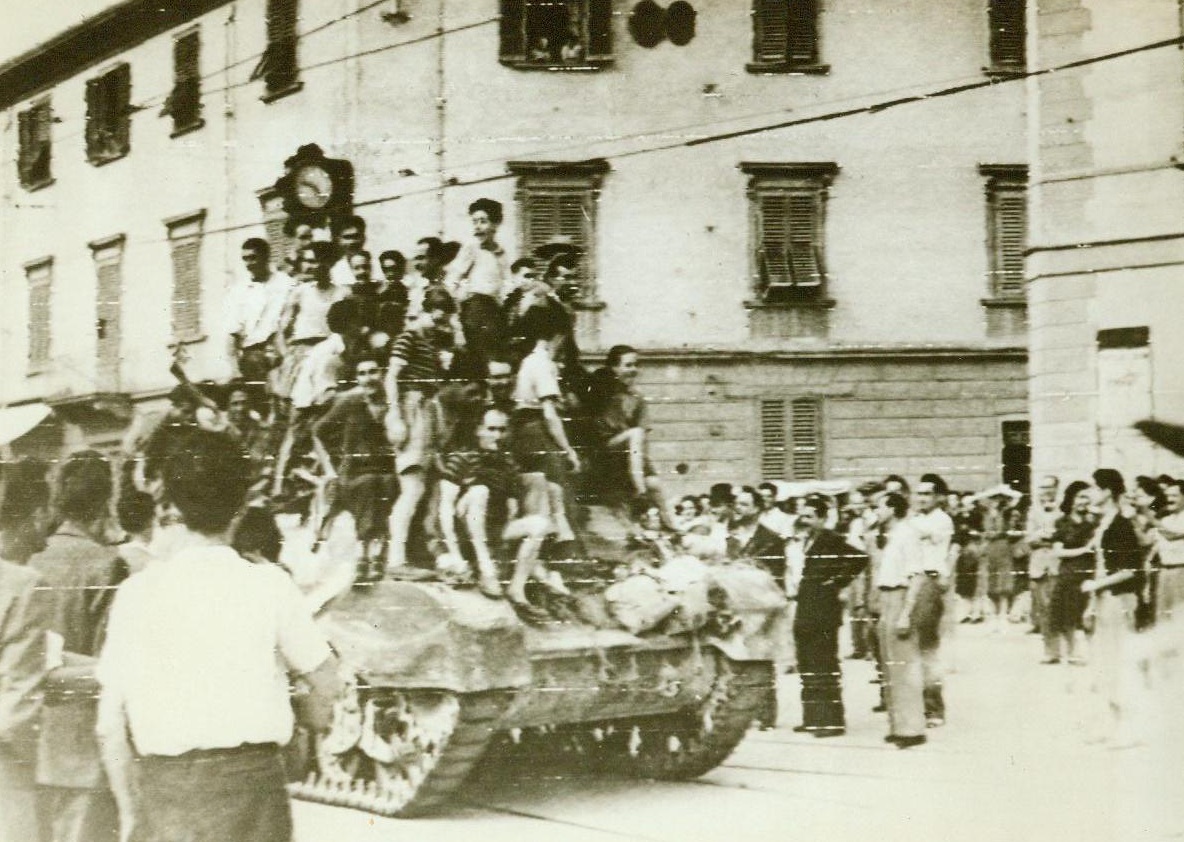
Joyous Welcome For British 8th Army, 8/14/1944. Florence, Italy—Joyous civilians jump on top this South African-manned tank as it enters Florence, while others cram the streets to watch the coming of the victors. After the British 8th Army had overcome all Nazi Resistance, AMU officials rushed in to give aid to the needy citizens. 8/14/44 Acme RadioPhoto;

Collaborator Gets His Lumps, 8/6/1944. Rennes, France --Seeking vengeance from the disloyal in their midst, French patriots were quick to round up traitors and mete out punishment when Rennes fell to Allied forces. Here a kneeling collaborationist holds up his hands to fend off blows delivered by enraged patriots 8/6/44 (ACME);
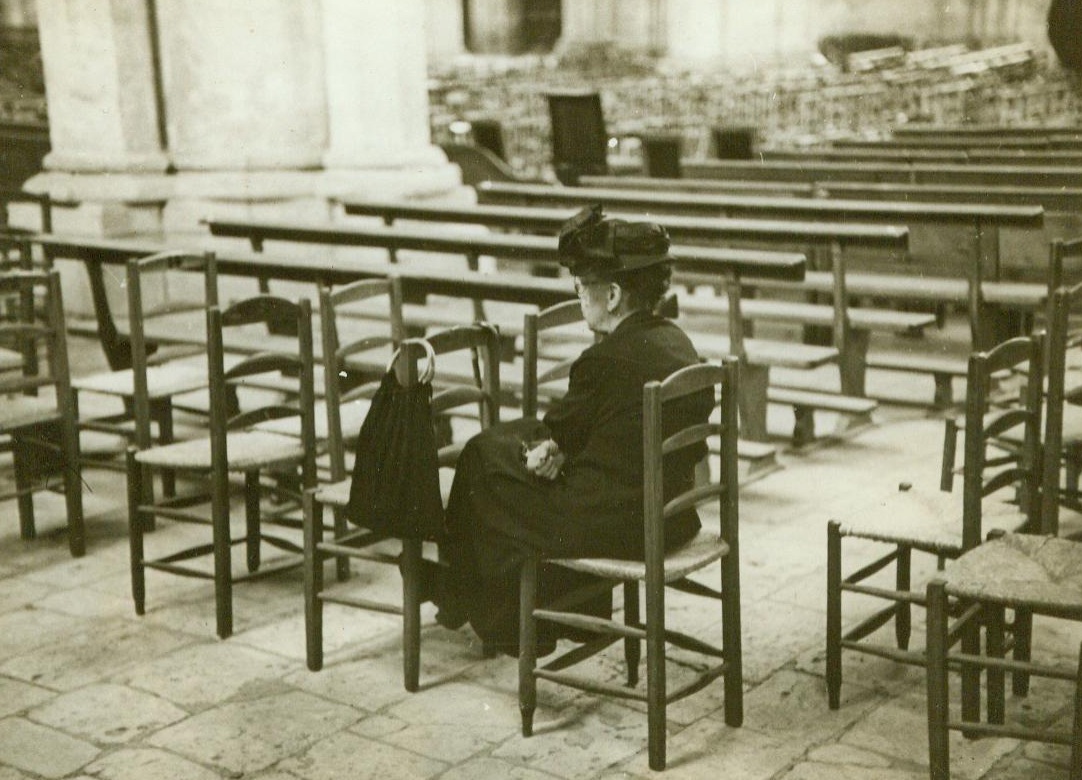
Giving Thanks In Her Way, 8/26/1944. Chartres, France -- While the streets outside are filled with crowds wildly cheering the liberation of Chartres by Yank Forces, this lone French woman sits quietly in the Cathedral giving thanks in her own way. Later the Cathedral will be filled as the townspeople gather for Thanksgiving services. 8/26/44 (ACME);
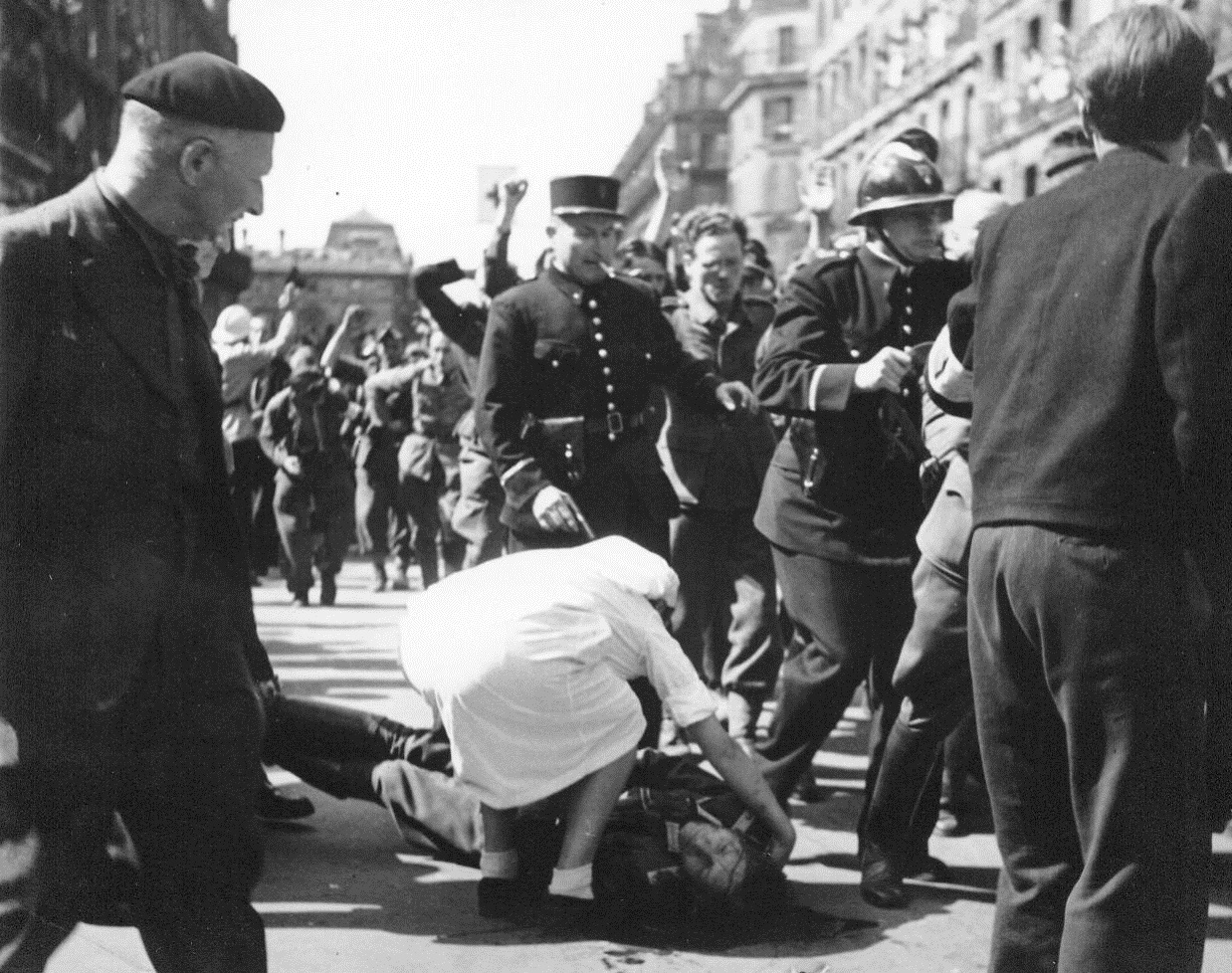
Resistance Roundup, 8/28/1944. Paris -- Lying wounded in the street, a German Officer gets the attention of a Red Cross worker as French patriots round up Nazis and collaborators after street fighting in liberated Paris. Resistance snipers still terrorize the populace of the French capital. The allies have left the job of restoring order in Paris to the French. 8/28/44 (ACME);
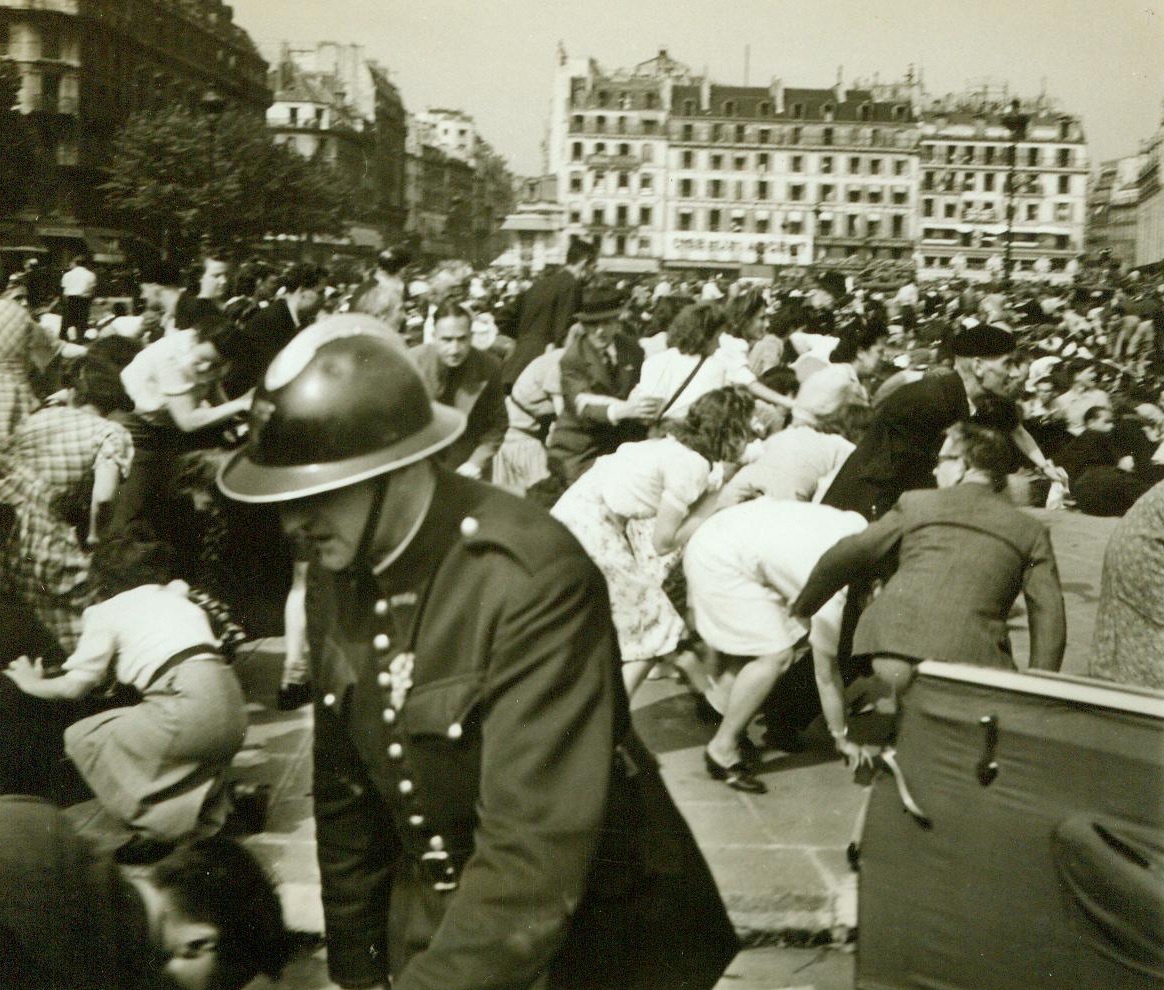
Panic In Paris, 8/28/1944. Paris -- Bending low and scurrying for cover, frightened Parisians try to escape the bullet whistling down from rooftop sniper nests. Panic reigned as street fighting broke up the official reception of General Charles De Gaulle in the French capital. 8/28/44 (ACME);
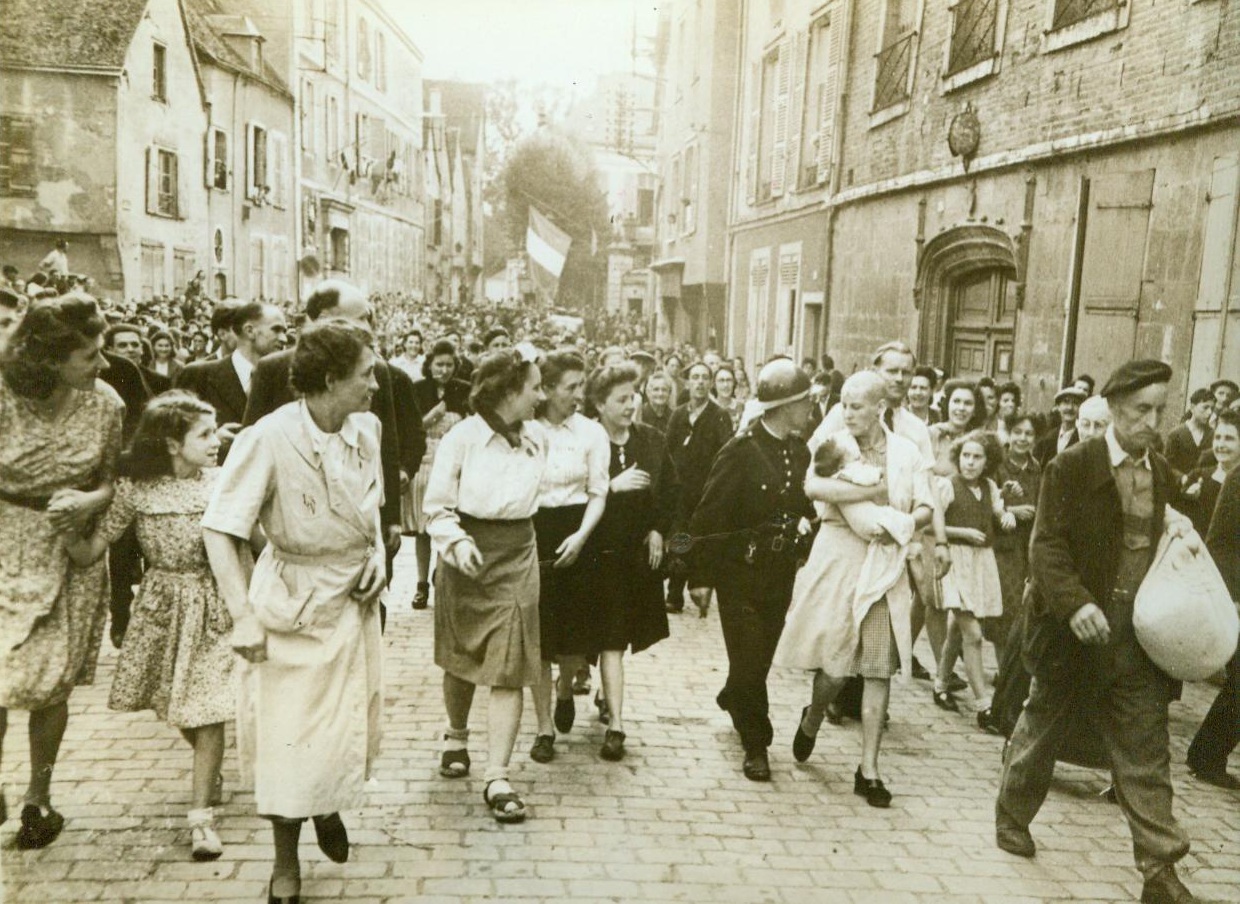
Collaborationist Is Scorned By Her People, 8/26/1944. Chartres, France -- Followed by jeering townspeople, a woman collaborator is led back to her home after having her hair shaved off. The shorn woman carries a German baby. The French Tricolour (Background) flies from the middle of the street and American flags are hung out of windows as French people celebrate the liberation of Chartres by the Yanks. 8/26/44 (ACME);

Cringing Before His Judges, 8/12/1944. Rennes, France -- The day of judgment has arrived for this collaborator in Rennes, as he cringes on his knees before the wrath of French citizens. One man (with head bandage) holds a small revolver, while others take swiping blows at the traitor. The frightened man, who cooperated with the Nazis during their occupation of the city, was made to say "Vive De Gaulle" and "Viva La France" over and over again. 8/12/44 (ACME);
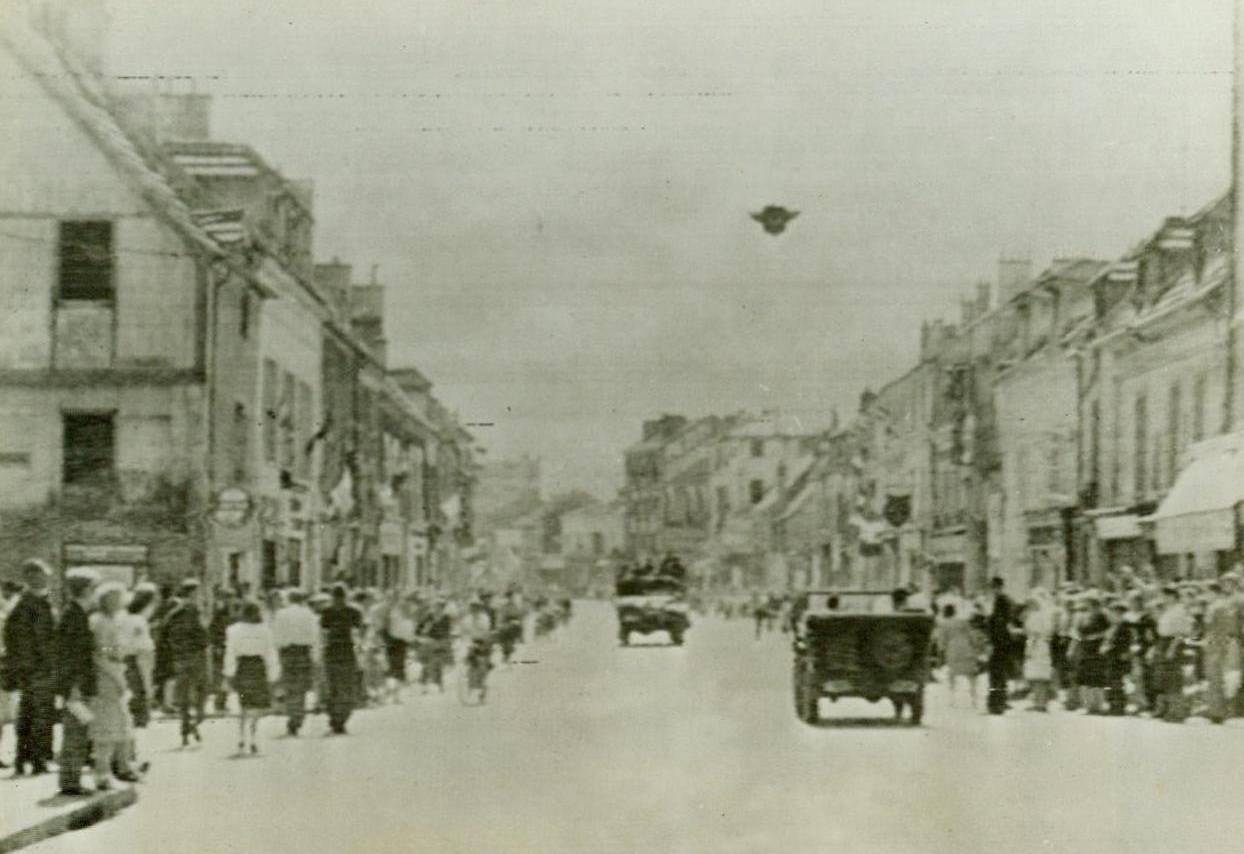
American Vehicles Enter Paris, 8/25/1944. American vehicles trickle through Nazi defenses surrounding Paris as the battle rages on in other sections of the city. 8/25/44 (ACME);
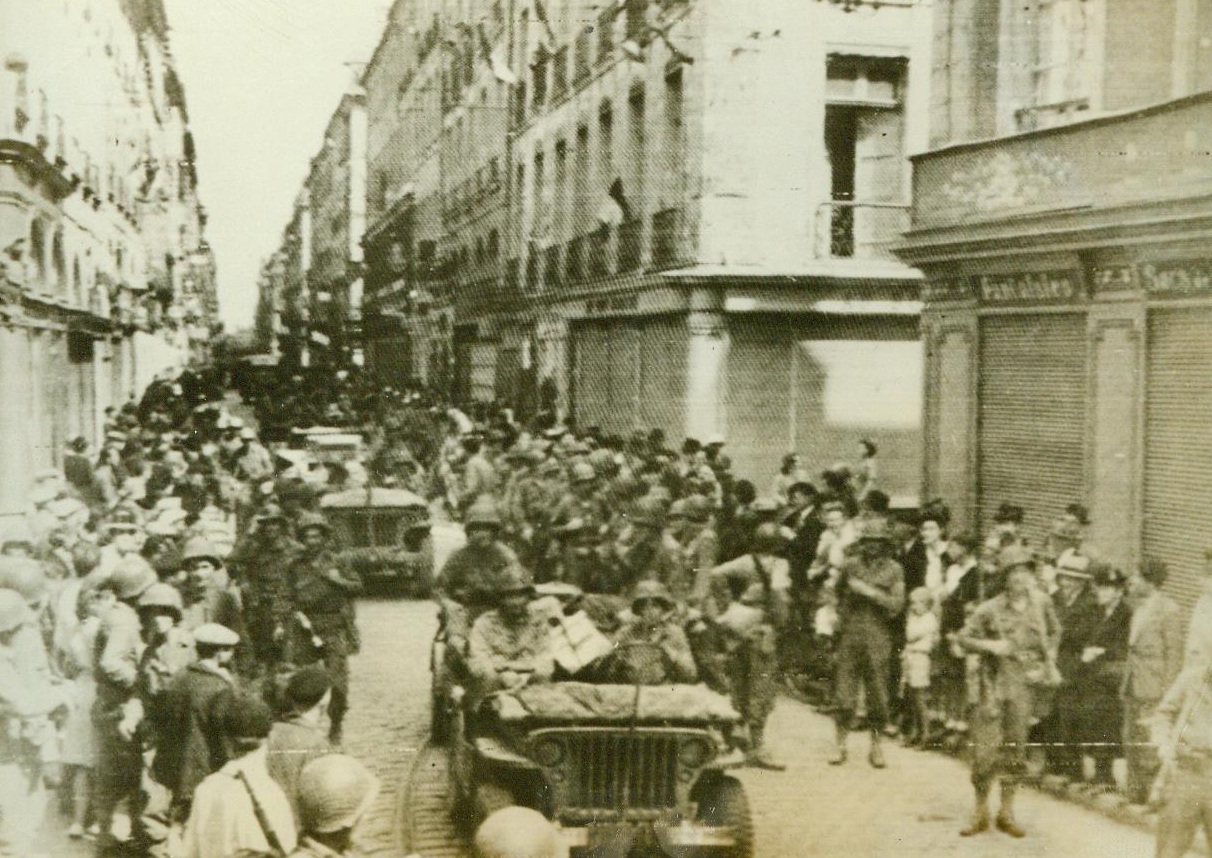
Cheering Patriots Line The Road, 8/6/1944. Rennes, France -- Natives of rennes, both young and old, line the sides of this street in the liberated city, raising their voices to cheer the victorious Yanks. Our warriors returned the cheers as they marched or rode through the heart of the Breton capital. 8/6/44 (ACME);

"Maid Of Orleans" Welcomes Yanks, 8/20/1944. Rennes, France -- Natives of rennes, both young and old, line the sides of this street in the liberated city, raising their voices to cheer the victorious Yanks. Our warriors returned the cheers as they marched or rode through the heart of the Breton capital. 8/6/44 (ACME);
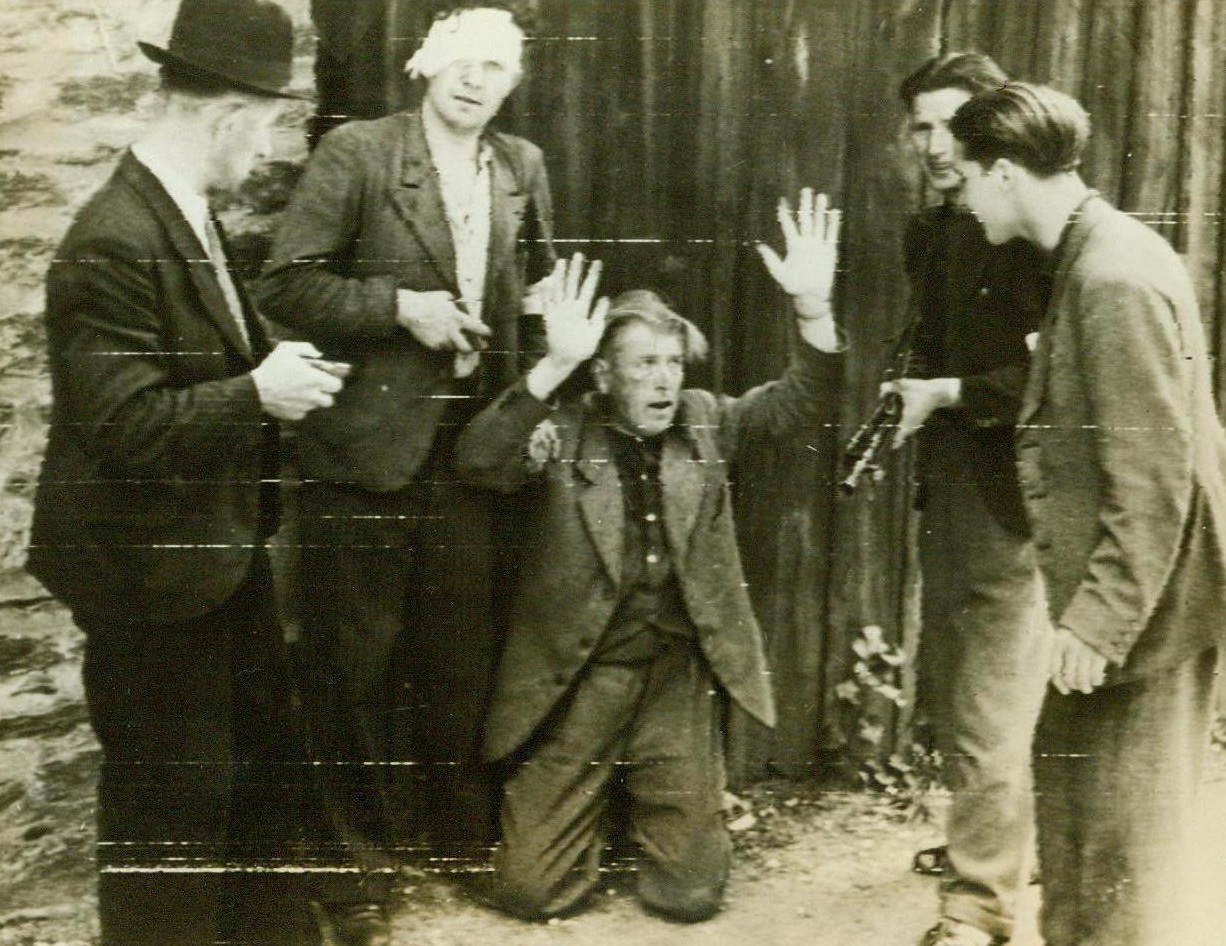
Collaborators Punishment, 8/6/1944. Rennes, France -- In partial payment for his crime of collaborating with the Nazis who dominated Rennes, this traitor is forced to kneel and shout the praises of De Gaulle and Churchill. He looks fearfully at patriots who rounded up disloyal Frenchmen as soon as the capital of Brittany fell to the Allies. 8/6/44 (ACME);
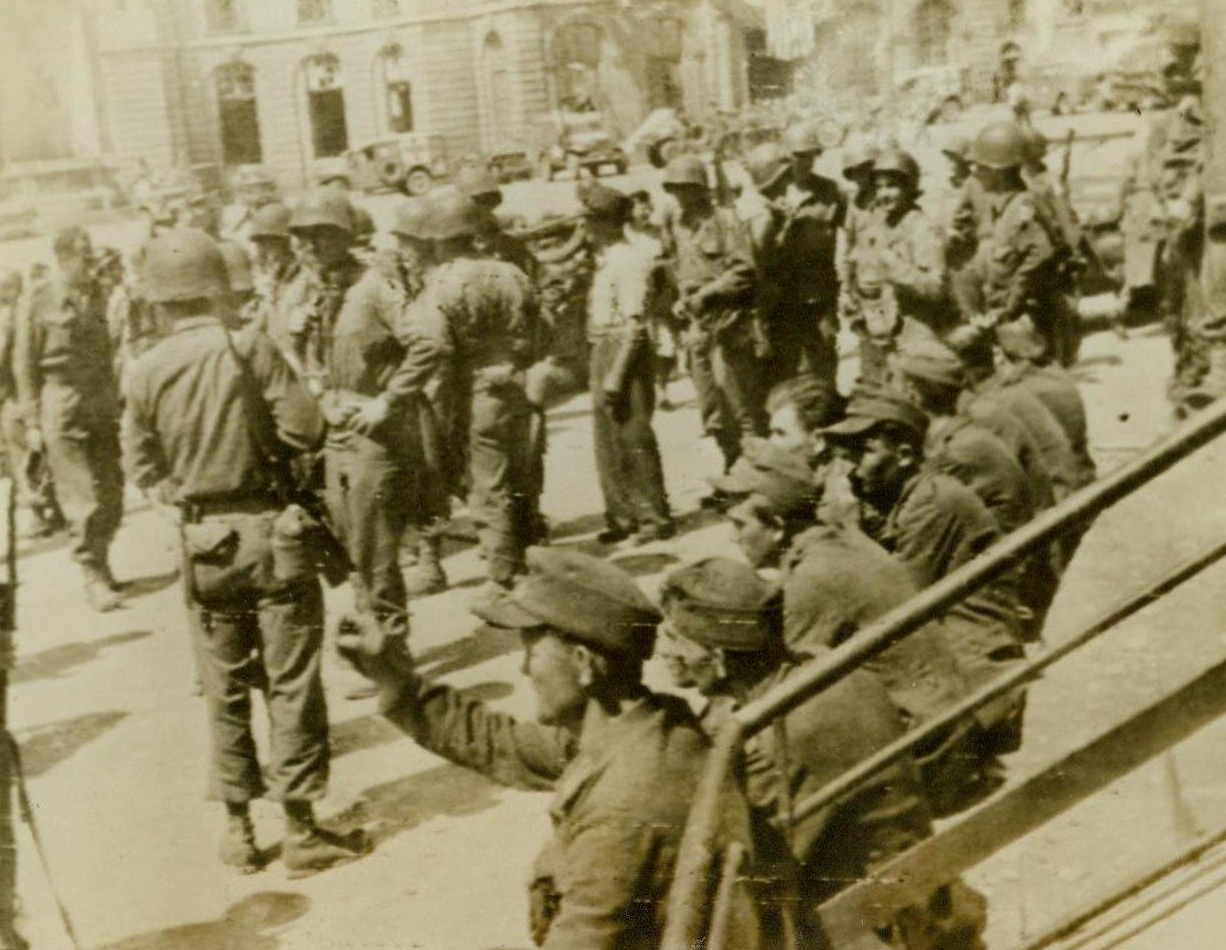
The Defeated, 8/6/1944. Rennes, France -- The liberation of Rennes, largest city to fall to the armies of liberation since the invasion of France, meant captivity for this handful of German prisoners. The beaten Nazis are shown outside Rennes City Hall. 8/6/44 (ACME);
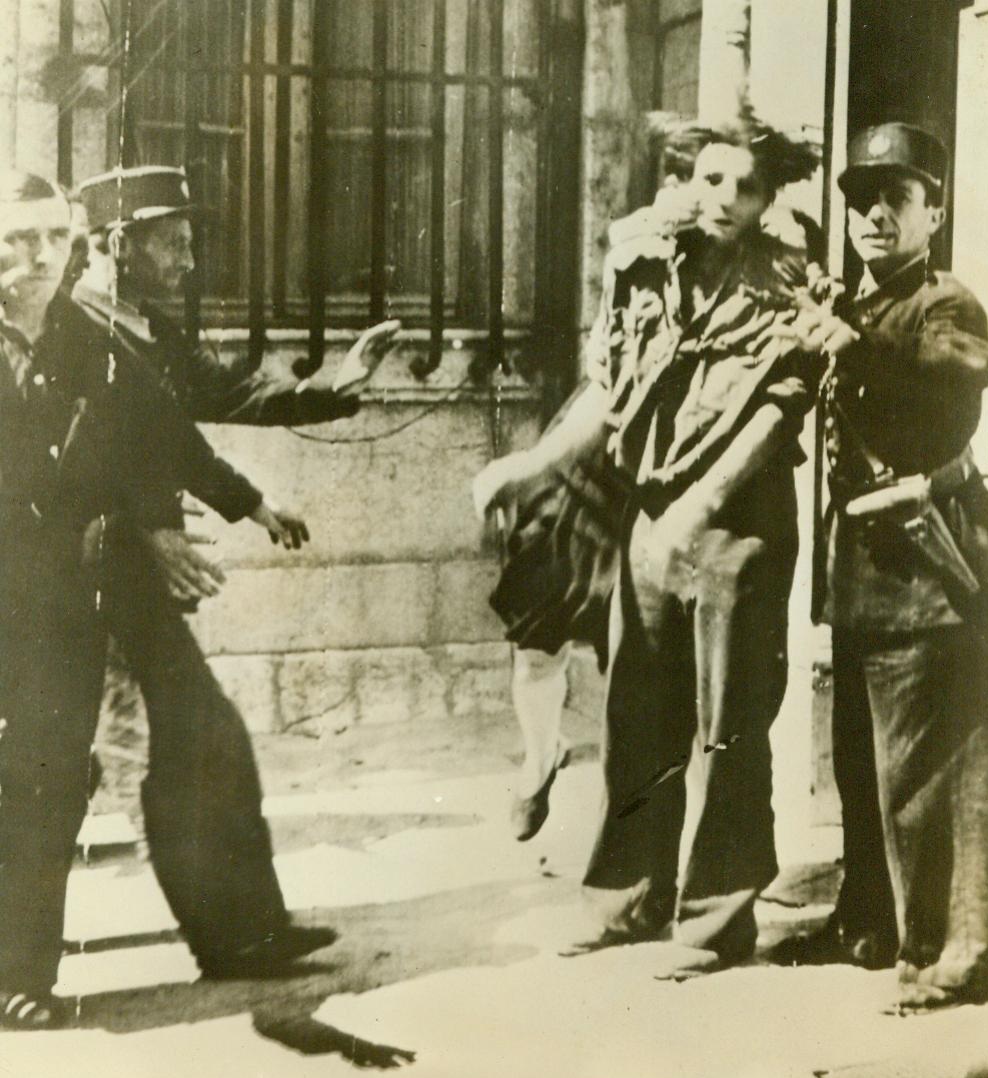
Aroused Avenger Gets Even, 8/22/1944. France -- An enraged woman (rear) tears at a captured Gestapo agent as Gendarmes attempt to placate her. The Gestapo man was responsible for the mutilation of her husband when the Nazis occupied the town of Brignoles, in Southern France. 8/22/44 (ACME);
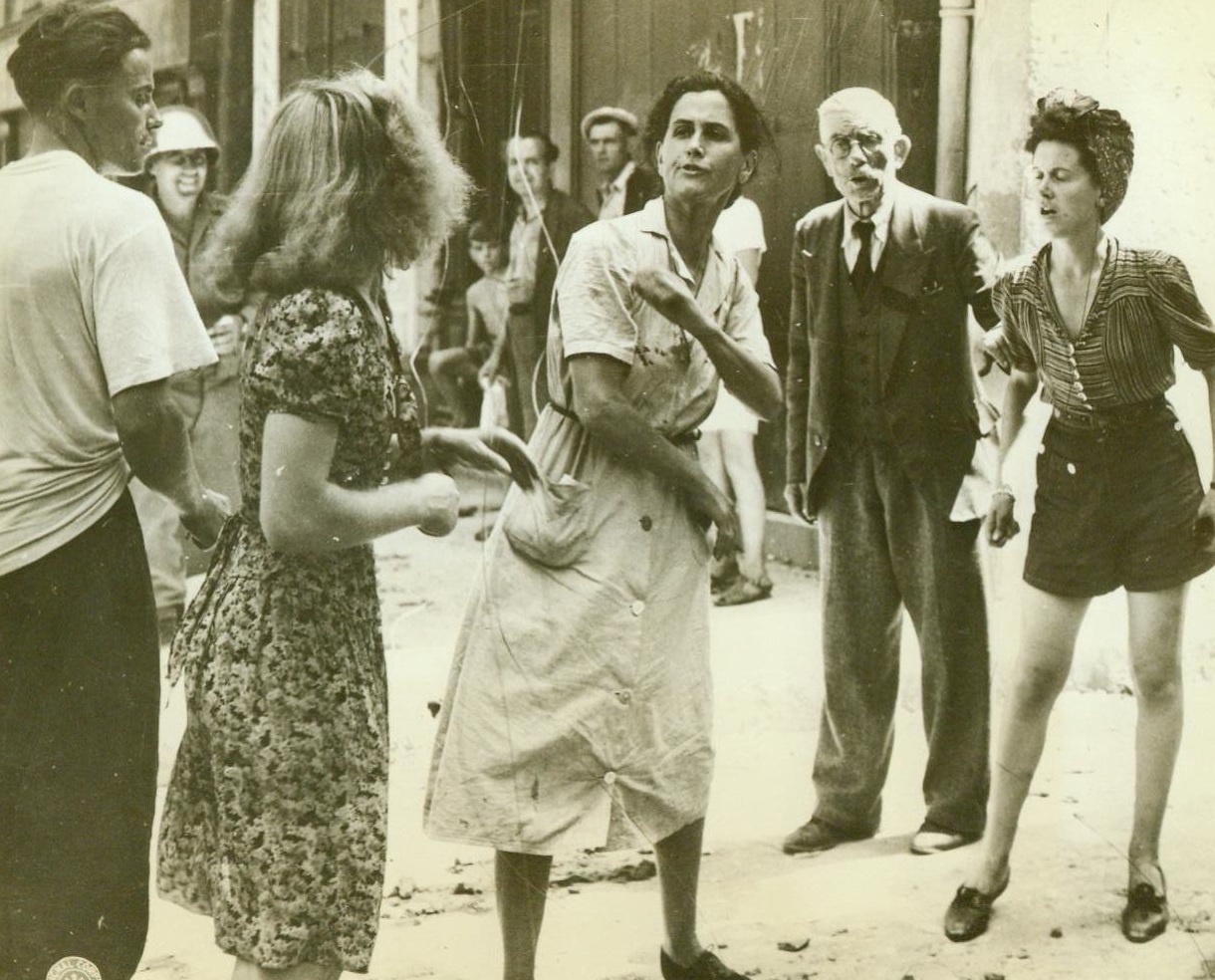
French Women Have It Out, 8/31/1944. France -- Two women, one a pro-Nazi, the other a patriot, engage in a street bout in a town in Southern France. A girl in shorts verbally blasts the Nazi-lover and an old man standing aside adds his thoughts of hatred into the fray. Women in center is object of derisive side glances from all who pass. With the liberation of this town, Brignoles, many of the men and women who were Nazi sympathizers were immediately rounded up by the Free French Partisans. 8/21/44 (ACME);
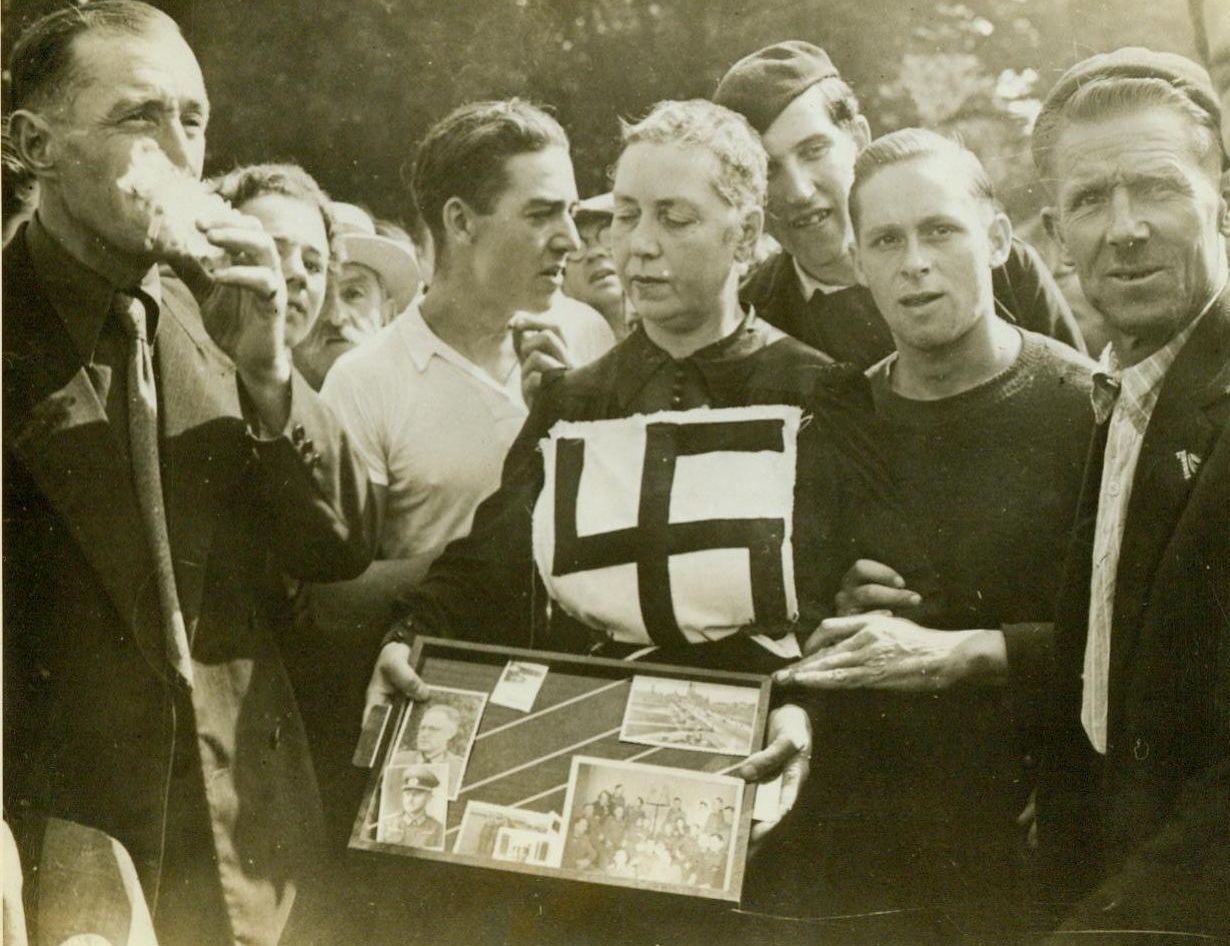
Traitor's Shame, 8/21/1944. Laval, France -- Collecting jeers from the populace, this French girl keeps her eyes on the ground as she is led through the town of Laval by local patriots. Her shorn head and the swastika pinned to her dress mark her as one who collaborated with the Nazis. She carries evidence of her shame in a small tray. The photos of Nazi officers with whom she was friendly were evidently found in her possession. 8/21/44 (ACME);
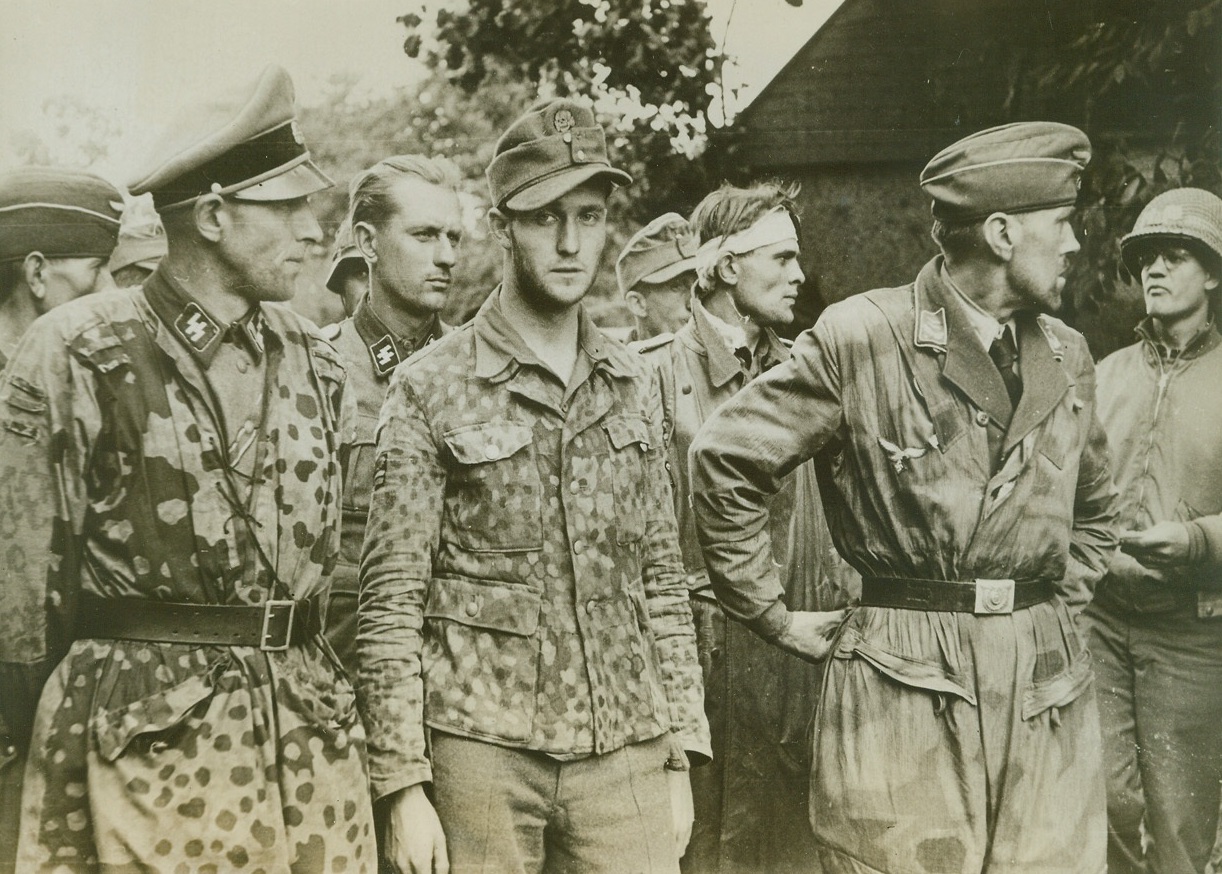
Cream of the Wehrmacht, 8/8/1944. FRANCE – Their faces hard and sullen, mirroring the determination that made their crack SS division (the Second Armored) fight almost to the last man against Allied arms, these Nazi officers of the famous “Goek von Berltchingen” regiment are lined up by their American captors, near Avranche. Credit: (ACME) (WP);
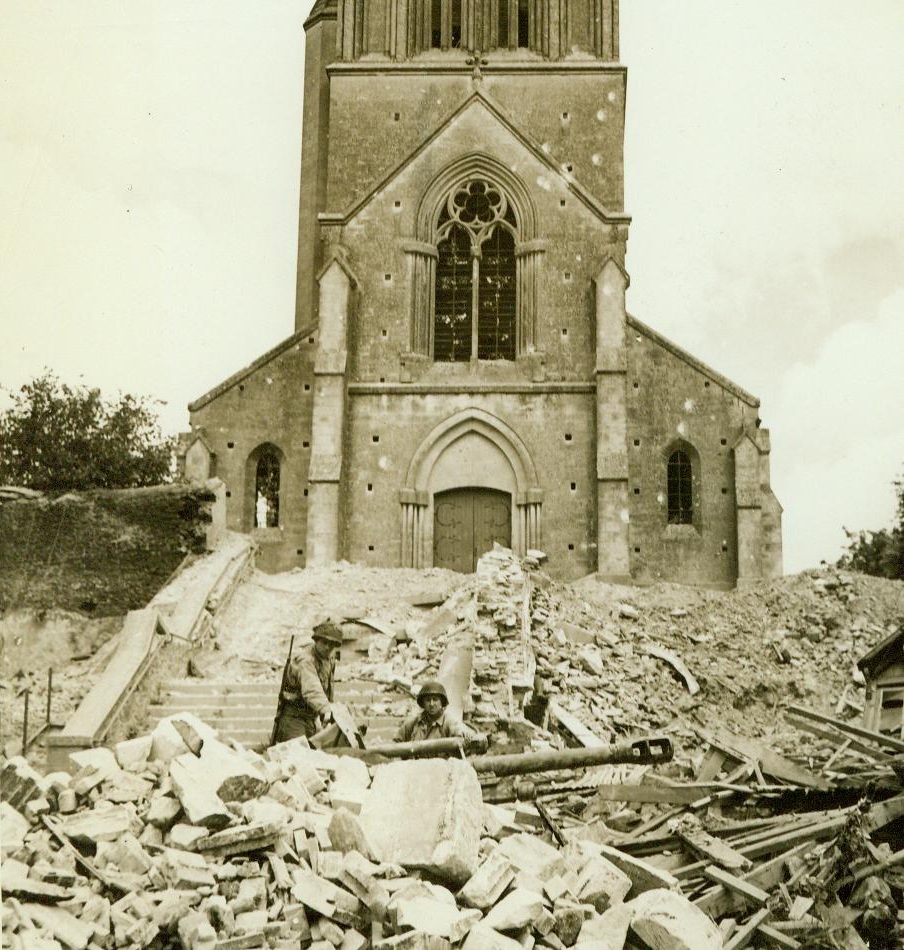
Church Is Haven For German Gun, 8/2/1944. Marigny, France – Pvt. Lowell E. Reau, Green Bay, Wisc. (left), and Cpl. Joseph Rombage, New York City, examine a knocked out German gun which they found amid the ruins of its emplacement outside the church in Marigny. 8/2/44 (ACME Photo By Andrew Lopez, War Pool Correspondent);

The Path Of War's Destruction, 8/2/1944. St. Lo, France – A French soldier and a GI stand among the ruins of St. Lo and gaze mutely at the Notre Dame Cathedral, which has been shattered throughout by the force of the battle in this key town. 8/2/44 (ACME);
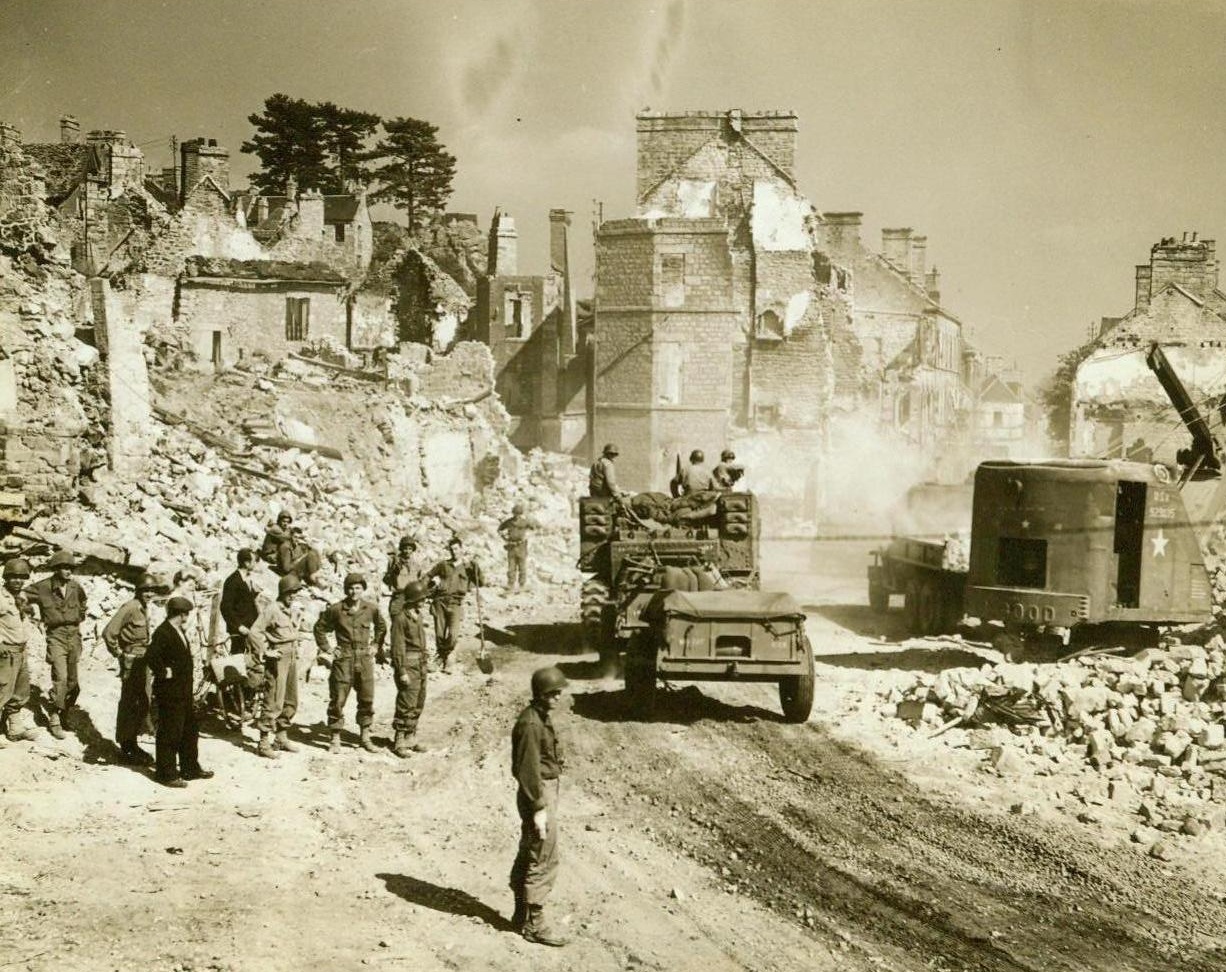
Erasing The Scars, 8/21/1944. France – As American troops race toward Paris, U.S. Army equipment begins to erase the battle scars from French towns along the way. Here a mechanical shovel clears great piles of rubble from this road in a battered town, permitting passage by heavier, front-bound vehicles 8/21/44 (ACME Photo By Bert Brandt, For The War Picture Pool);

Rebuilding As They Go, 8/21/1944. France – On the heels of rapidly advancing American forces in France, Yank engineers are quickly repairing and rebuilding roads and bridges wrecked by the retreating enemy. This prime mover pulls artillery equipment over a treadway bridge speedily erected by the Americans. 8/21/44 (ACME Photo By Bert Brandt For The War Picture Pool);
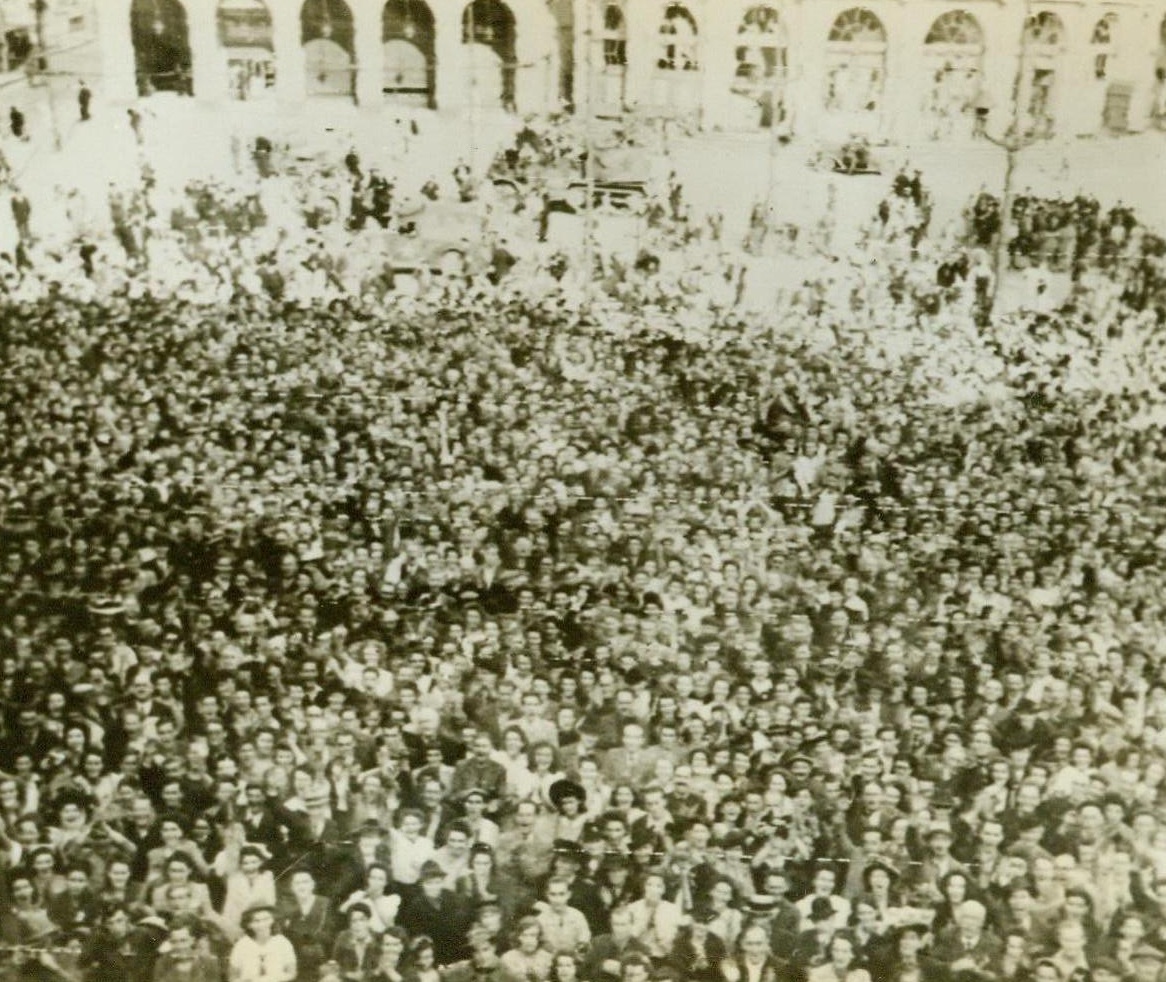
Rennes Greets Her Liberators, 8/6/1944. The population of Rennes, largest French city to fall to Allied troops to date, turns out en masse to greet the Army of Liberation. Our warriors received a tremendous ovation from the crowds as they rolled through the newly-captured city.;

Past The Ruins To Paris, 8/21/1944. France – The crumbled ruins of buildings wrecked by bombs and shells line the sides of the road to Paris. American vehicles move up past this battered town, forging ahead to support the Third Army’s lighting advance on the French capital. 8/21/44 (ACME Photo By Bert Brand For The War Picture Pool);
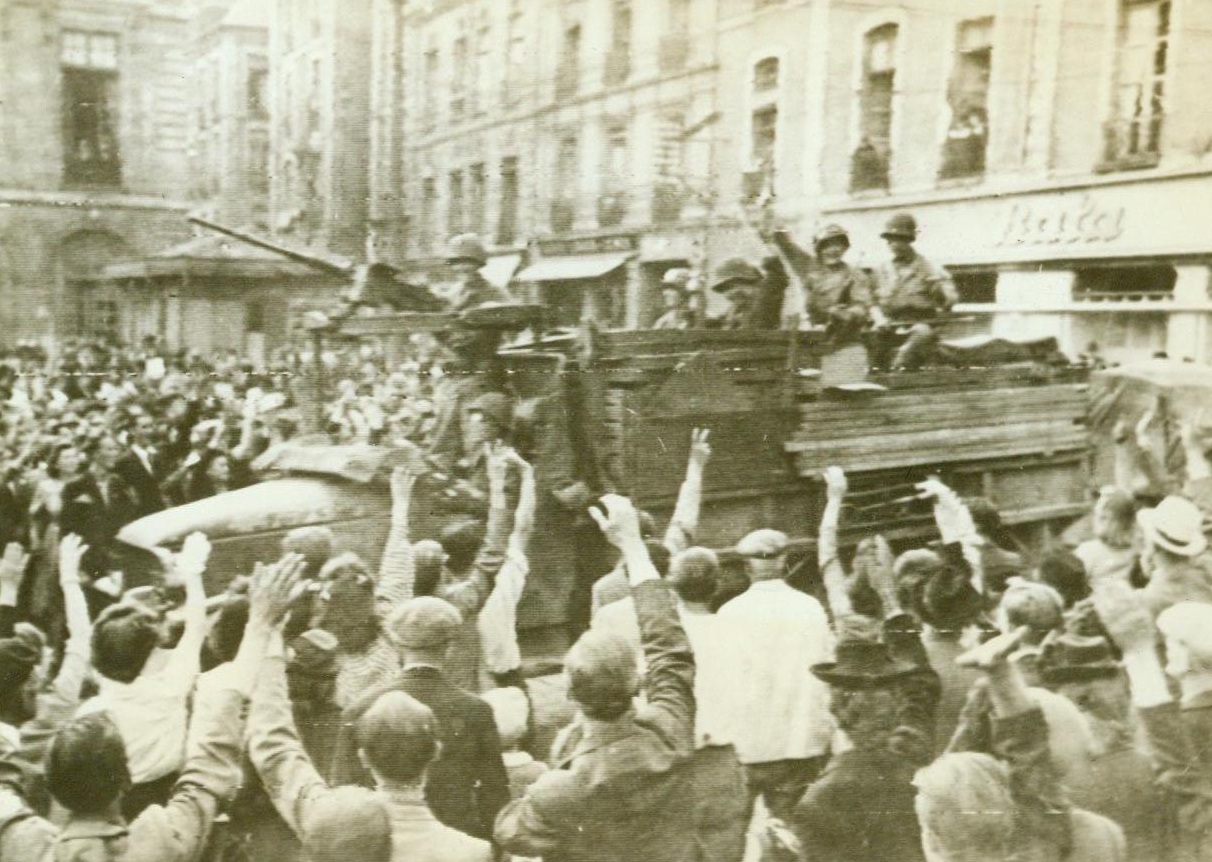
Hail The Heroes, 8/6/1944. Rennes, France – Wildly cheering, joyous natives of Rennes crowd around to welcome victorious Yanks into the liberated city. Waving and smiling from their armored vehicles, as the warriors return the greeting. 8/6/44 (Signal Corps Radiotelephoto from ACME);
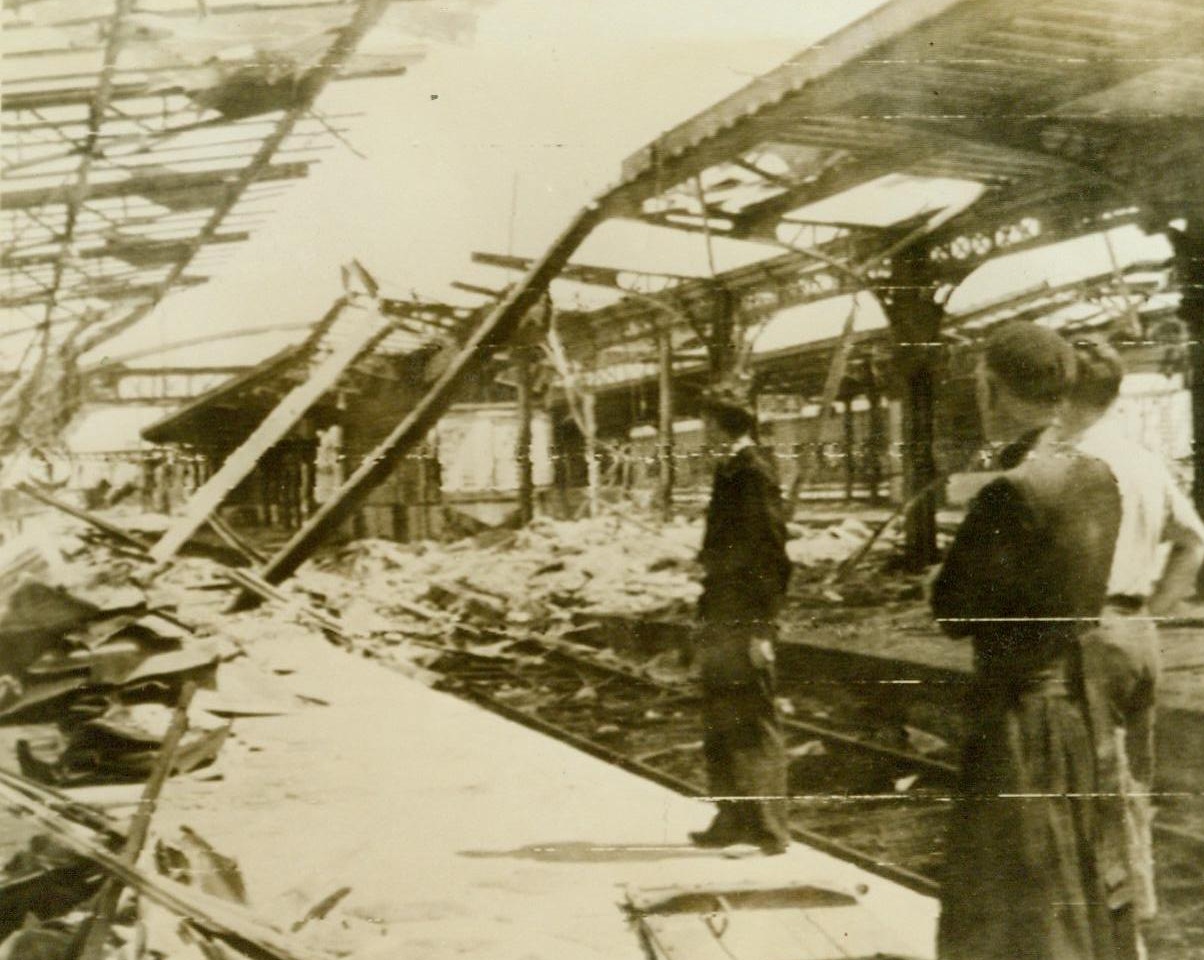
War Took Its Toll In Rennes, 8/6/1944. Rennes, France – The largest city to fall to the Yanks during the Allied march of liberation across France, Rennes was not captured without destruction. The railroad station shown above presented this mass of twisted steel and broken timbers when the Americans took over 8/6/44 (Signal Corps Radiotelephoto from ACME);
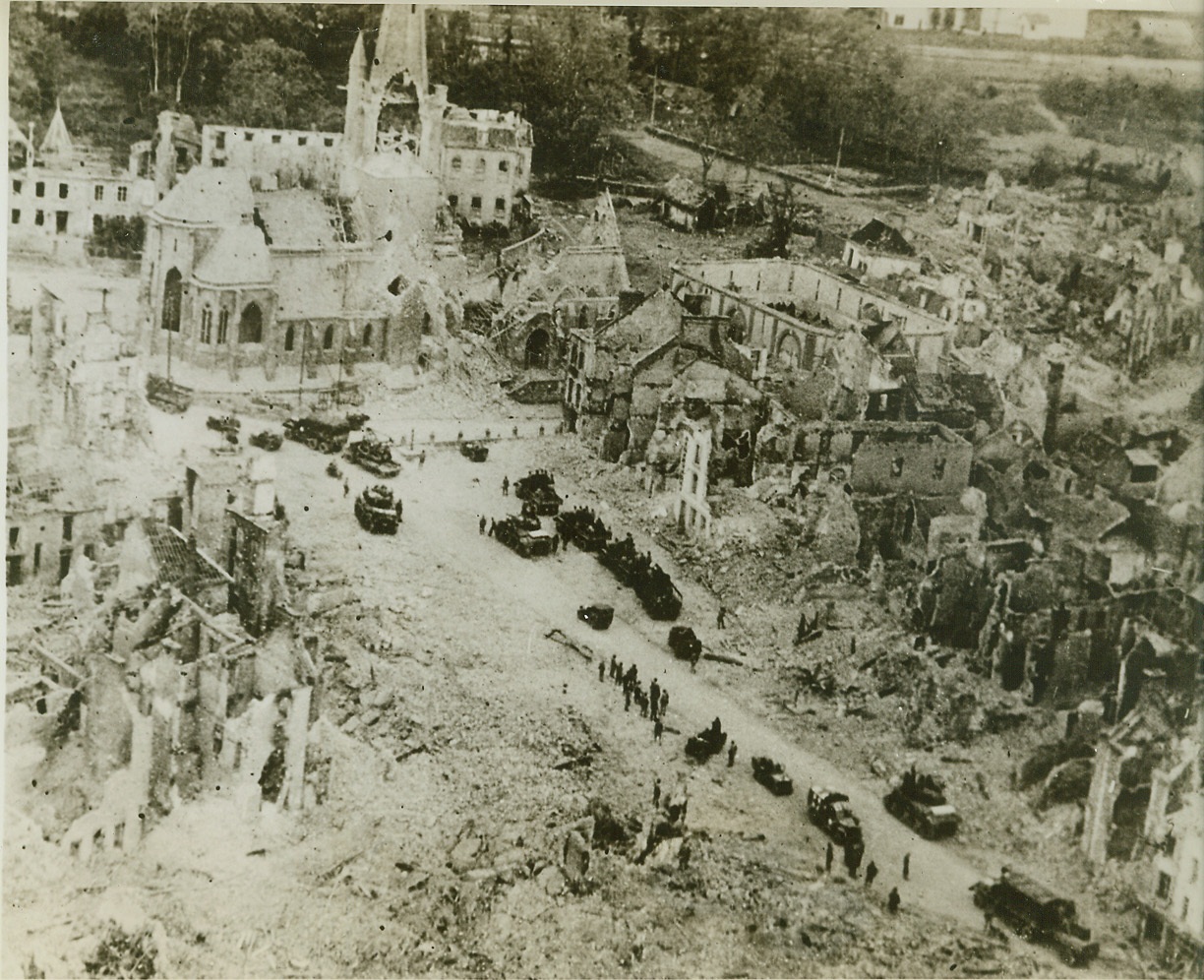
The Aftermath of Battle, 8/6/1944. PERIERS, FRANCE -- American tanks and trucks wend their way into Periers, a mass of destruction from the fierce battle that preceded its capture. American forces have stormed into Brest, France's 2nd port, completing the isolation of the Brittany Peninsula from German forces in the remainder of France. Credit (ACME) (WP);
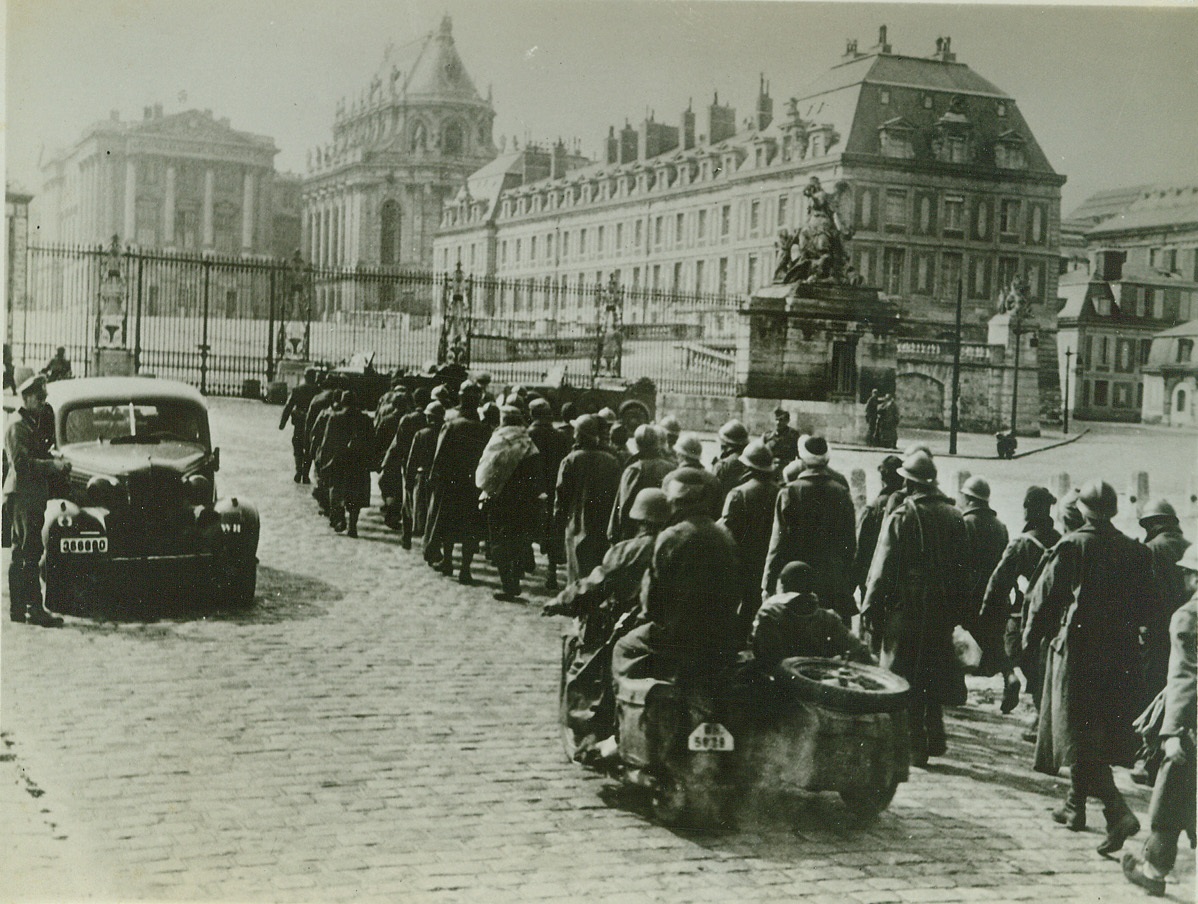
Allies Strike to Free Paris, 8/7/1944. PARIS, FRANCE -- Nazis in Paris march French prisoners past the Palace of Versailles where the Treaty, which the Germans say was the cause of the war, was signed. After four years of Nazi rule, Paris is once more a military objective as American armored columns race at terrific speed to free the French capital. EDITORS: We have prepared this art for possible use when Allied forced enter Paris. Credit: (ACME);
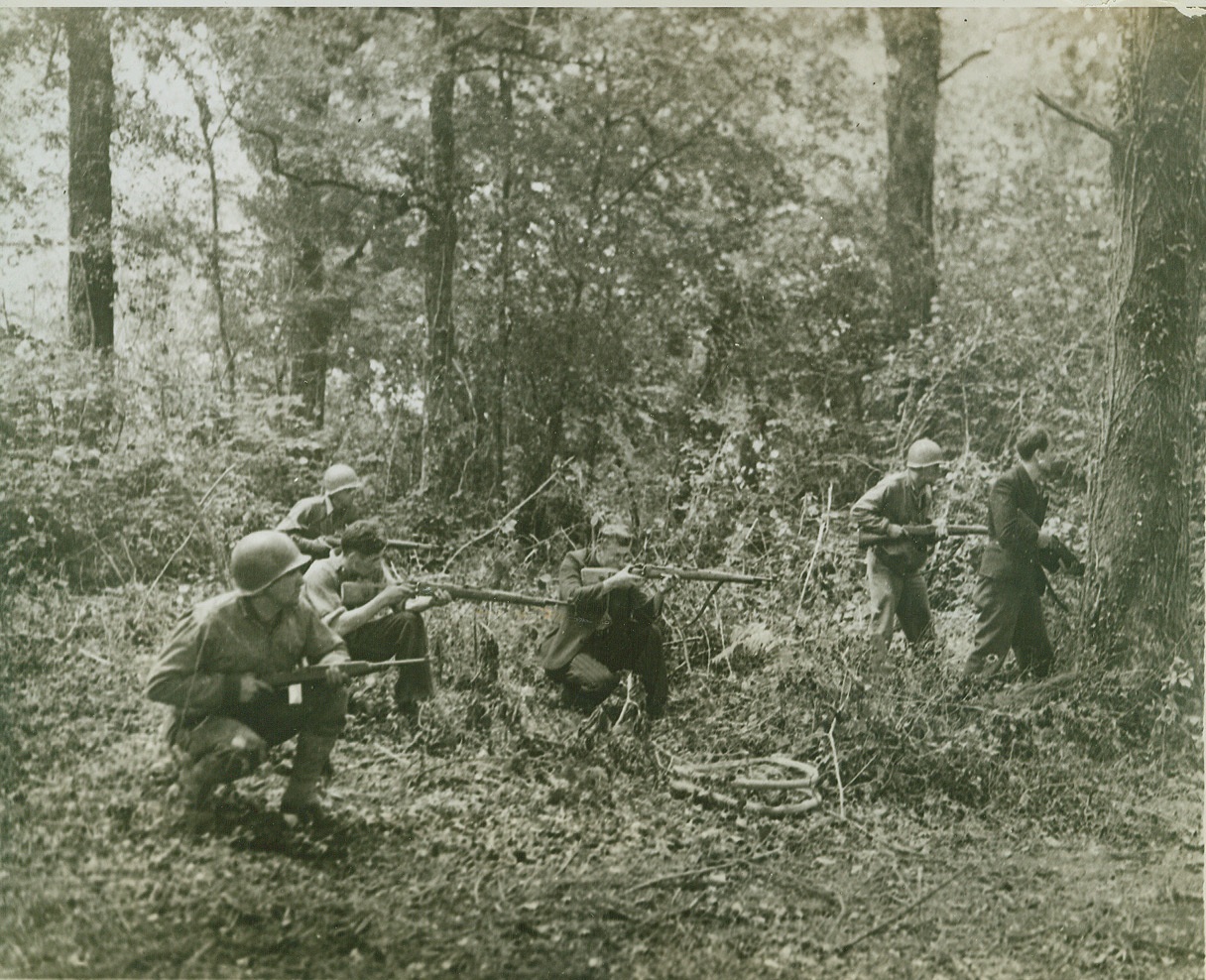
French Patriots Join Yanks, 8/5/1944. FRANCE -- American soldiers get valuable assistance from a group of French patriots in hunting down Nazi snipers during mop up operations in a wooded sector outside a town. In Brittany these patriots have given invaluable aid and are credited with being partly responsible for the great speed of the American push. Credit: (ACME);
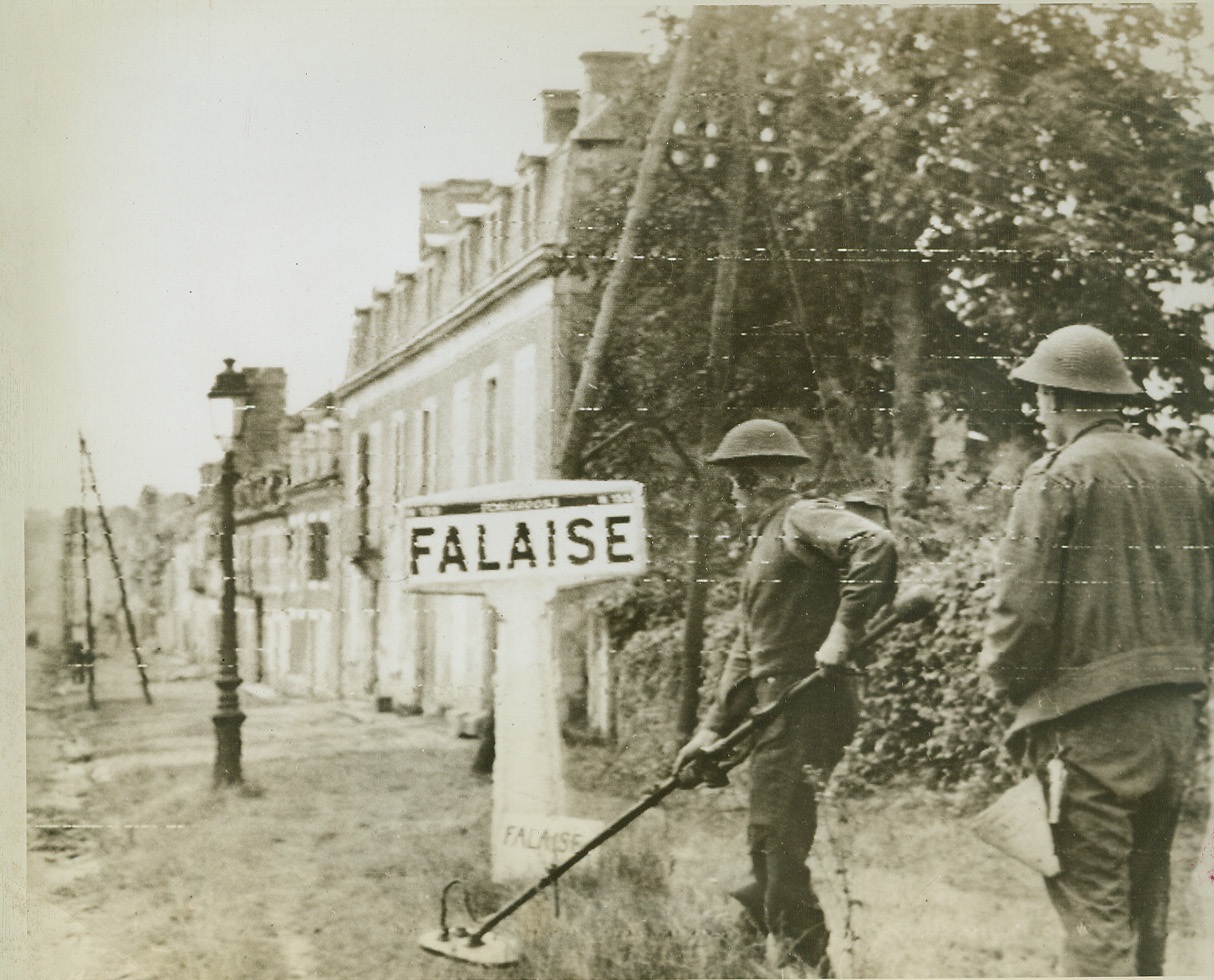
Mine Sweepers, 8/18/1944. FALAISE, FRANCE -- Canadian sappers search for mines along the grass borders lining the streets of Falaise as they enter the town taken in the drive toward Paris. Credit (Signal Corps Radiotelephoto from ACME);
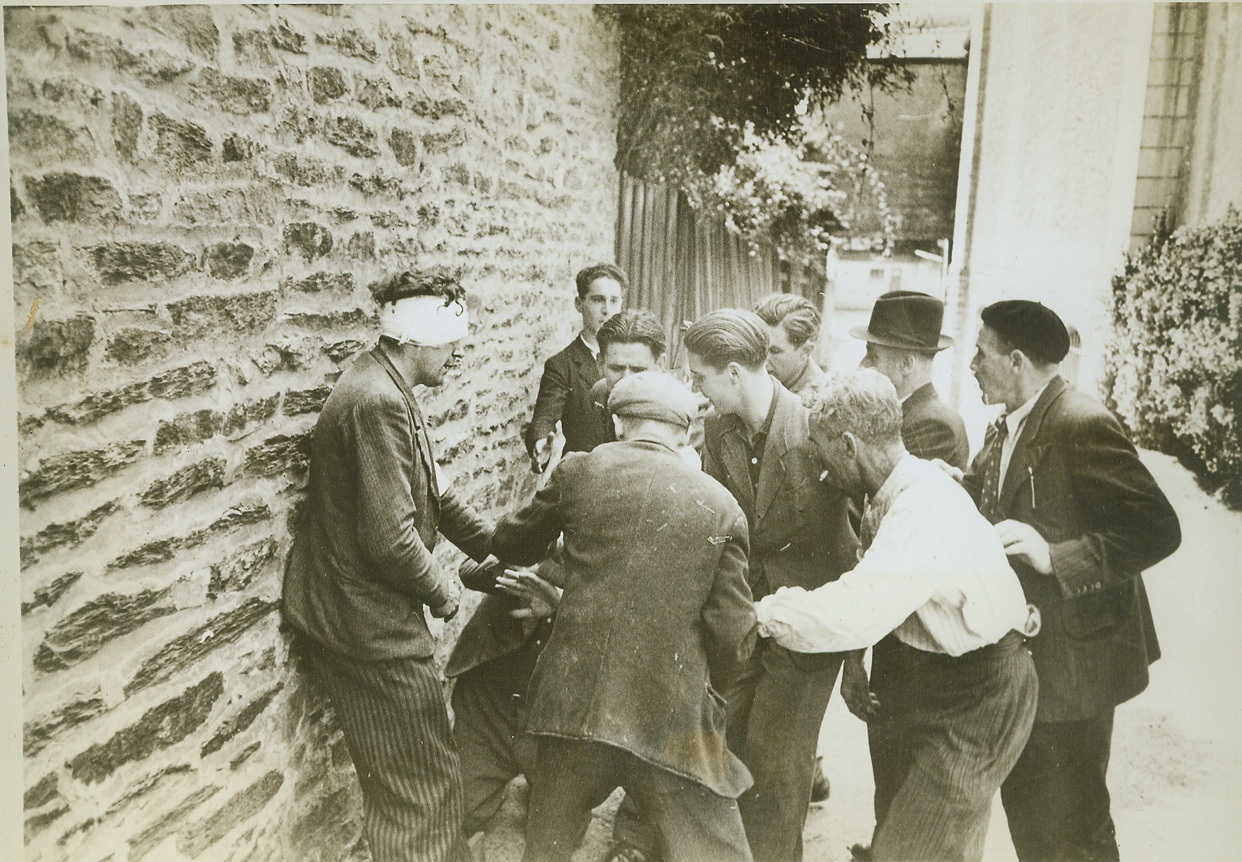
Paying for His Treachery, 8/12/1944. RENNES, FRANCE -- Angry citizens of Rennes wreak vengeance on a collaborator, captured after the Allies took the town. With his back against a wall, the traitor tries vainly to protect himself from blows of the angry people. (Man with bandage is not collaborator). Credit (ACME) (WP);
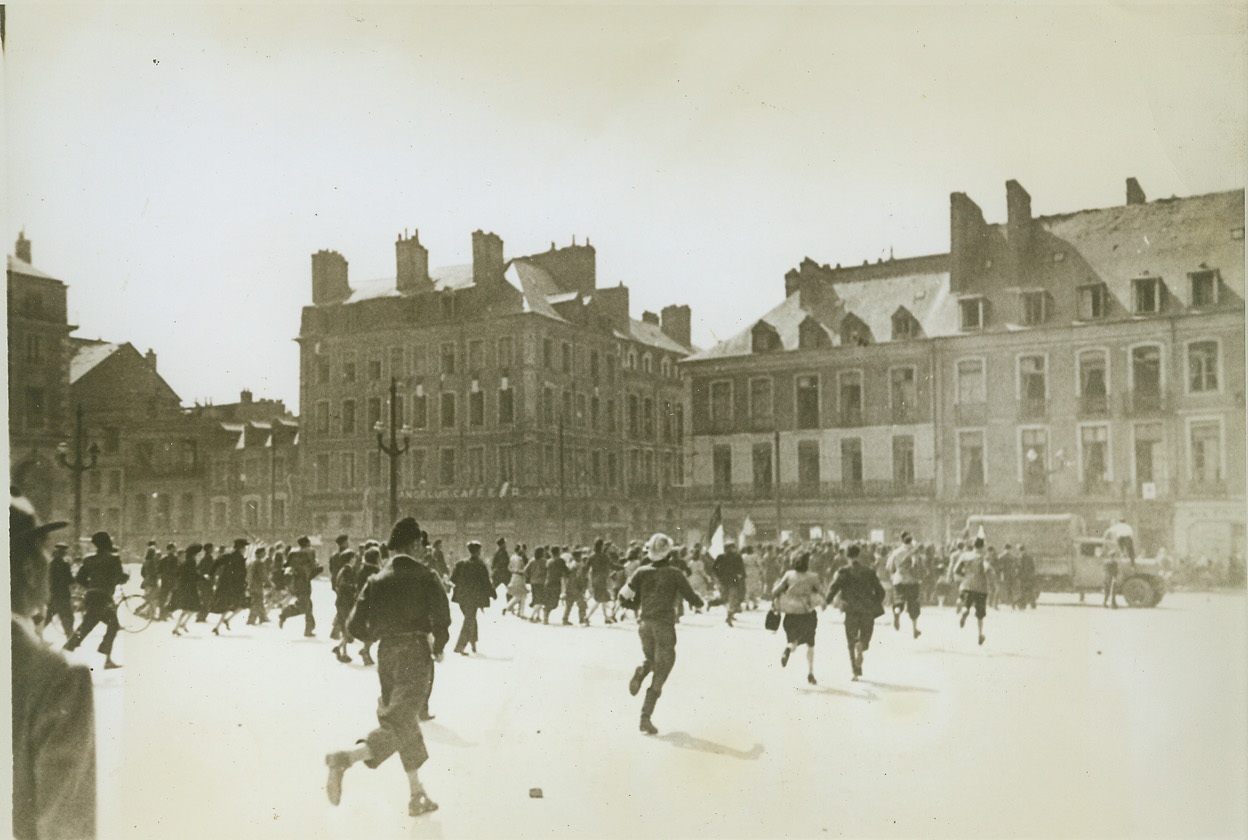
Collaborator Spotted, 8/12/1944. RENNES, FRANCE -- Citizens of Rennes, their liberation by the Allies in the town square, spot a collaborator about to be put into a captured truck on the other side of the square. Eager to get their hands on one of their people who betrayed them to the Nazis, they rush madly across the open space to catch the traitor. Credit (ACME) (WP);
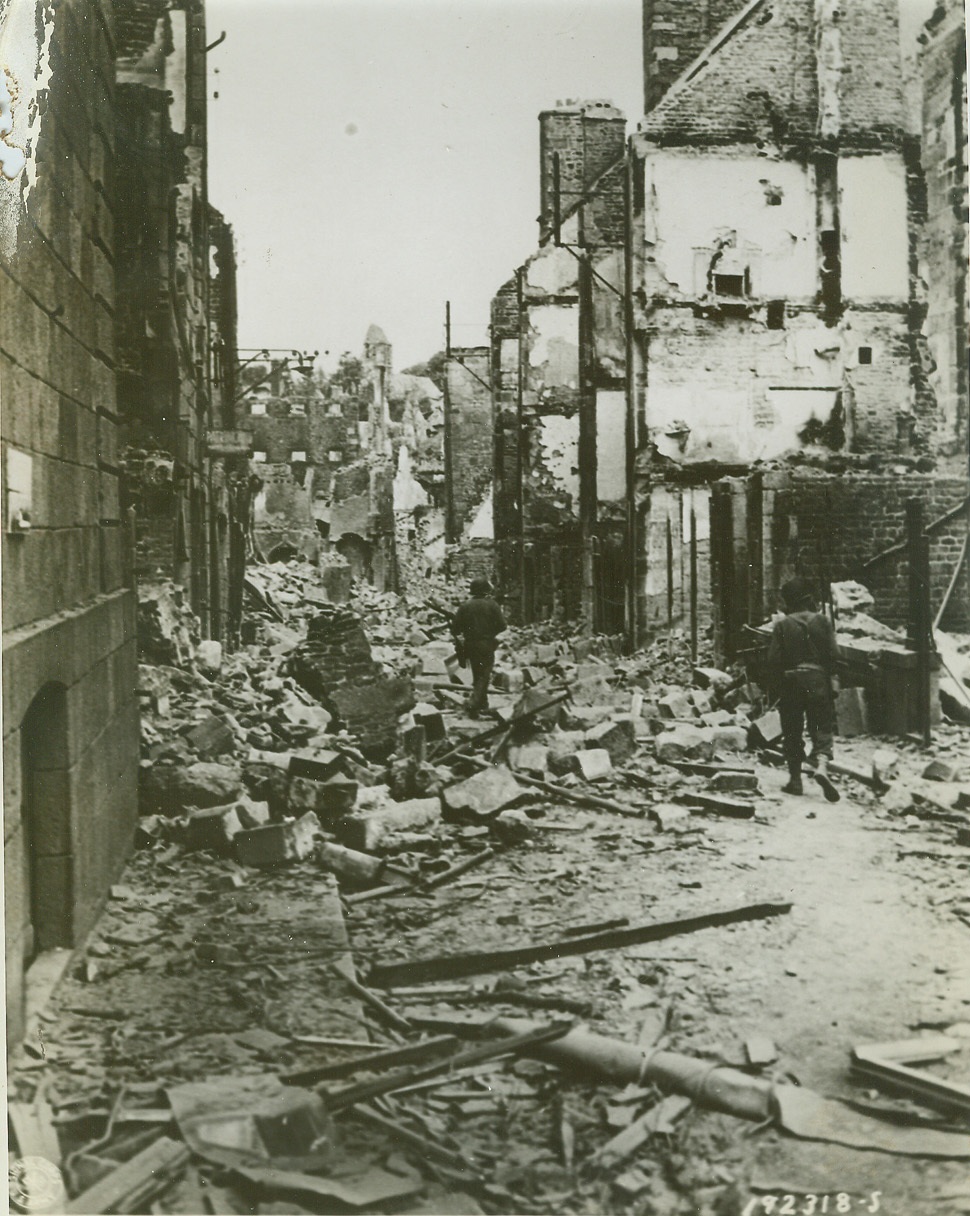
Here Lies Vire, 8/14/1944. VIRE, FRANCE -- Allied soldiers make their way through this street in Vire, scrambling over the debris which blocks their way. The French city was laid in ruins by the terrific bombardment preceding the Allied entry into the city. Credit (US Army Official Photo from ACME);
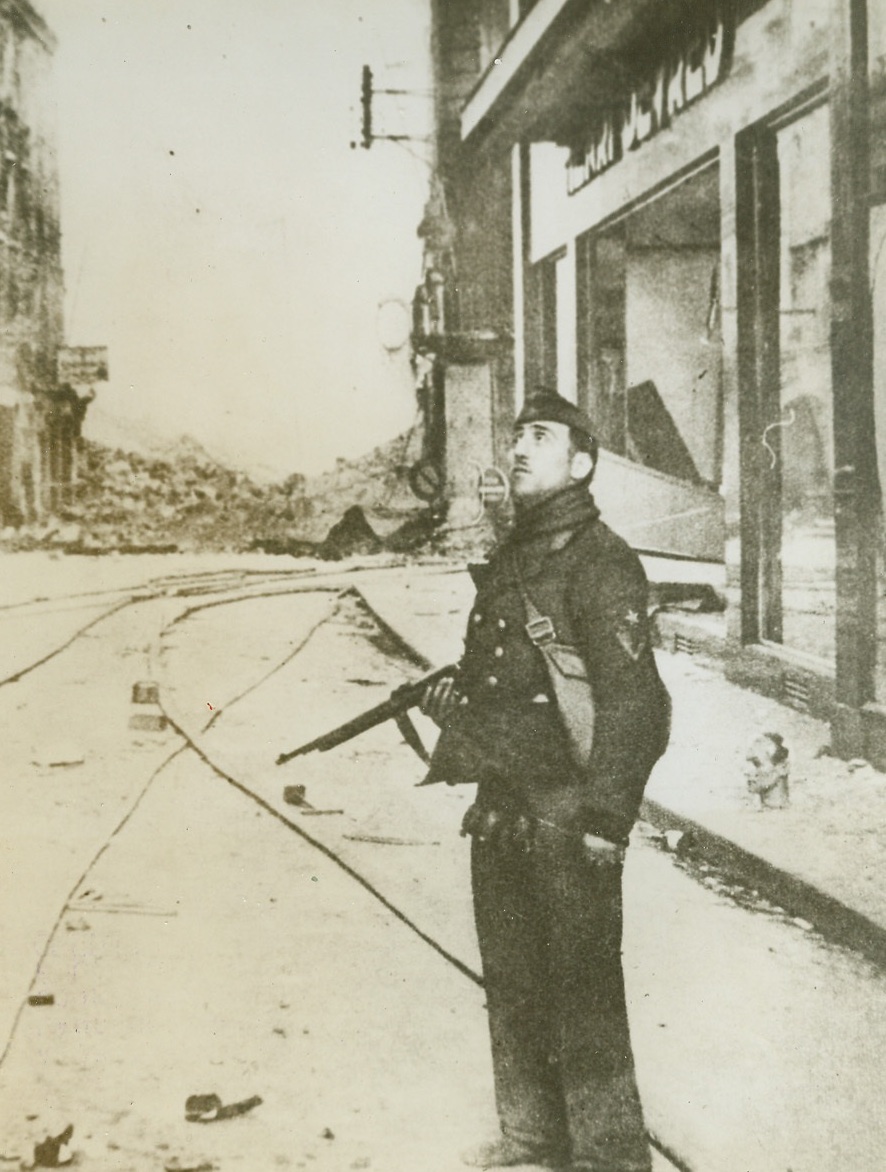
Caen During German Occupation, 8/1/1944. CAEN, FRANCE -- According to the German caption accompanying this photo received in London from a neutral source, this is a street in Caen after a British bombing attack which preceded its land onslaught on the city. A German soldier looks upward at the retreating planes. Credit (ACME);
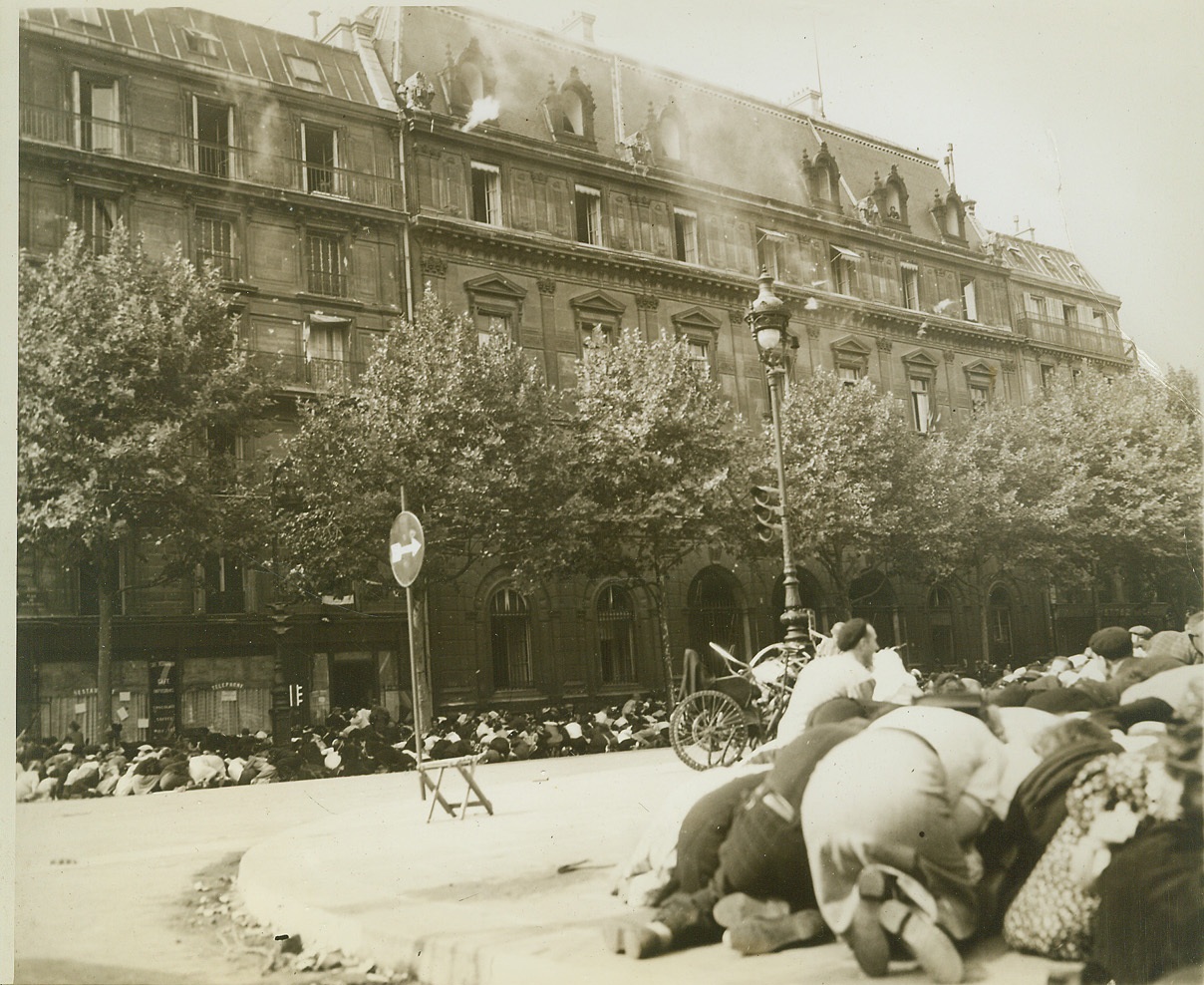
Bullets -- Unwelcome Guest at Celebration, 8/30/1944. FRANCE -- Part of the huge crowd gathered to pay tribute to Gen. Charles De Gaulle as he entered liberated Paris, crouch for cover as enemy sniper fire breaks up the celebration. Note the gun flash from the top floor, center, of the building at left and the smoke from gunfire still lingering in the air. Credit -WP-(ACME Photo by Andrew Lopez, War Pool Correspondent);
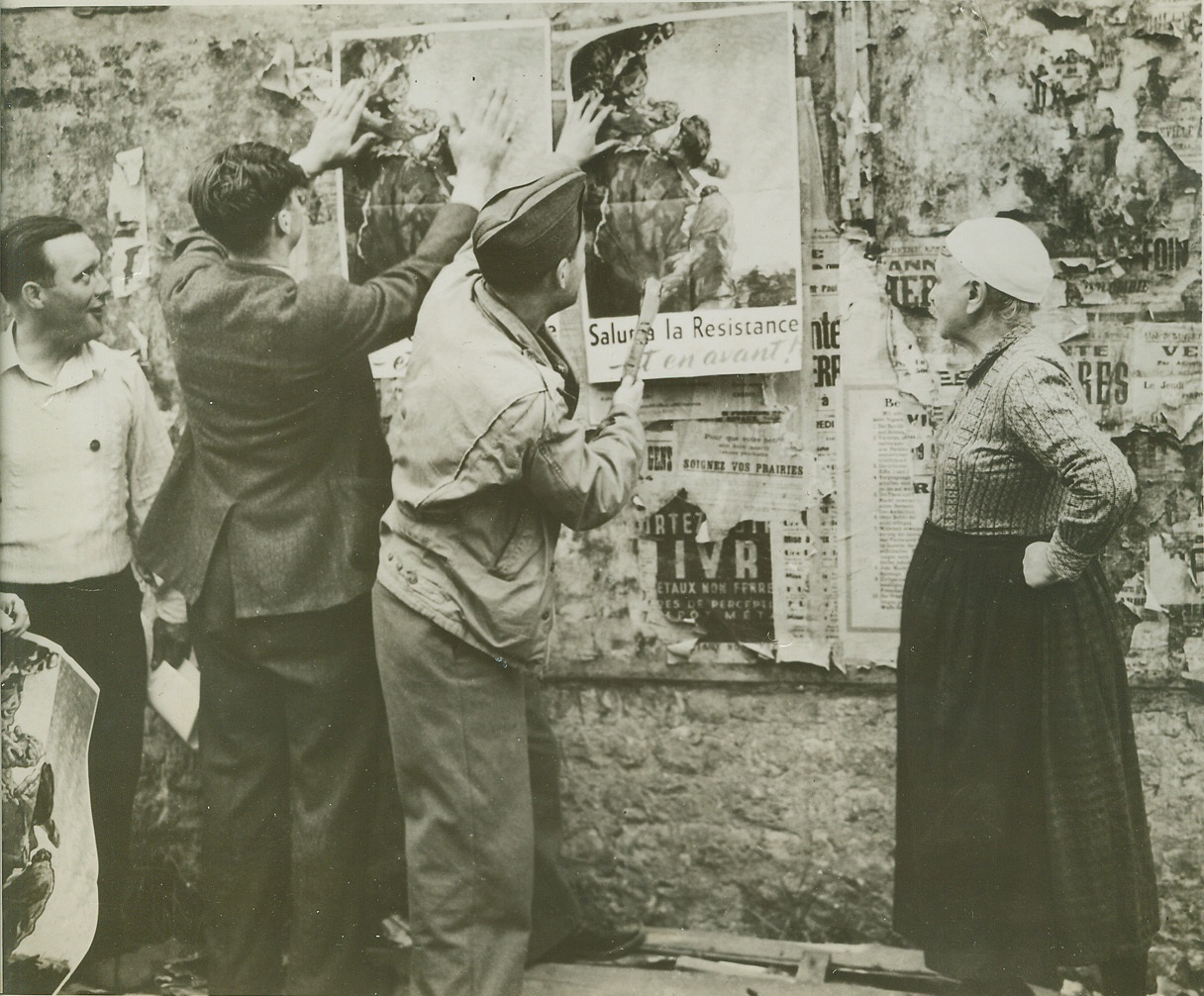
Down With the Old Up With the Free, 8/22/1944. FRANCE -- Residents of Columbierre help an American soldier cover the remnants of Nazi display propaganda with Allied posters. An elderly French woman surveys the work with satisfaction. Credit (OWI Photo from ACME);
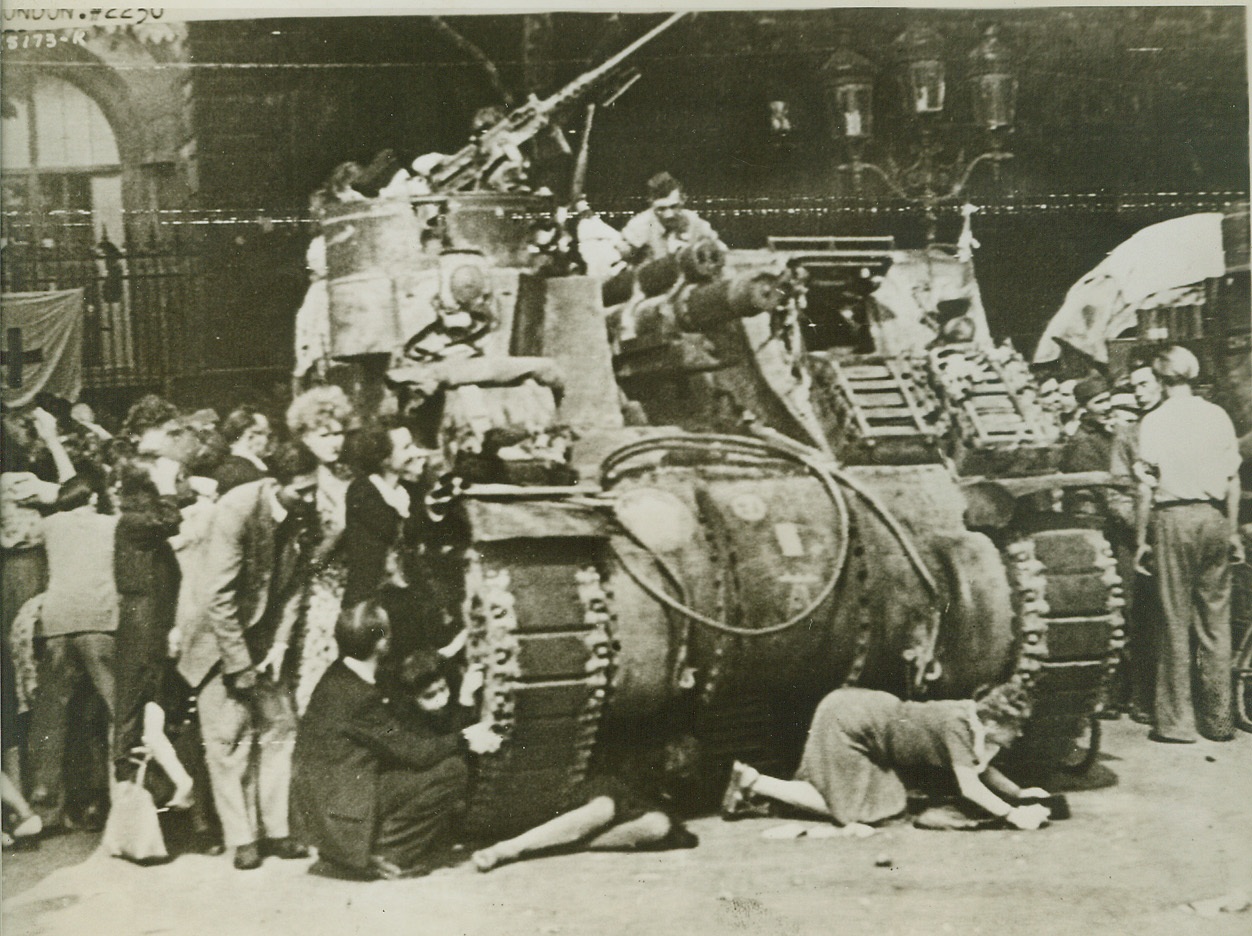
Seek Protection from Tank, 8/28/1944. PARIS -- Panic-stricken Parisians crouch close to a French armored tank for cover as snipers bullets whistle down from Notre Dame Cathedral. The terrified crowd was watching General De Gaulle enter the noted Cathedral for Thanksgiving services when the snipers attacked. British War Office Photo. Credit: (Army Radiotelephoto from ACME);
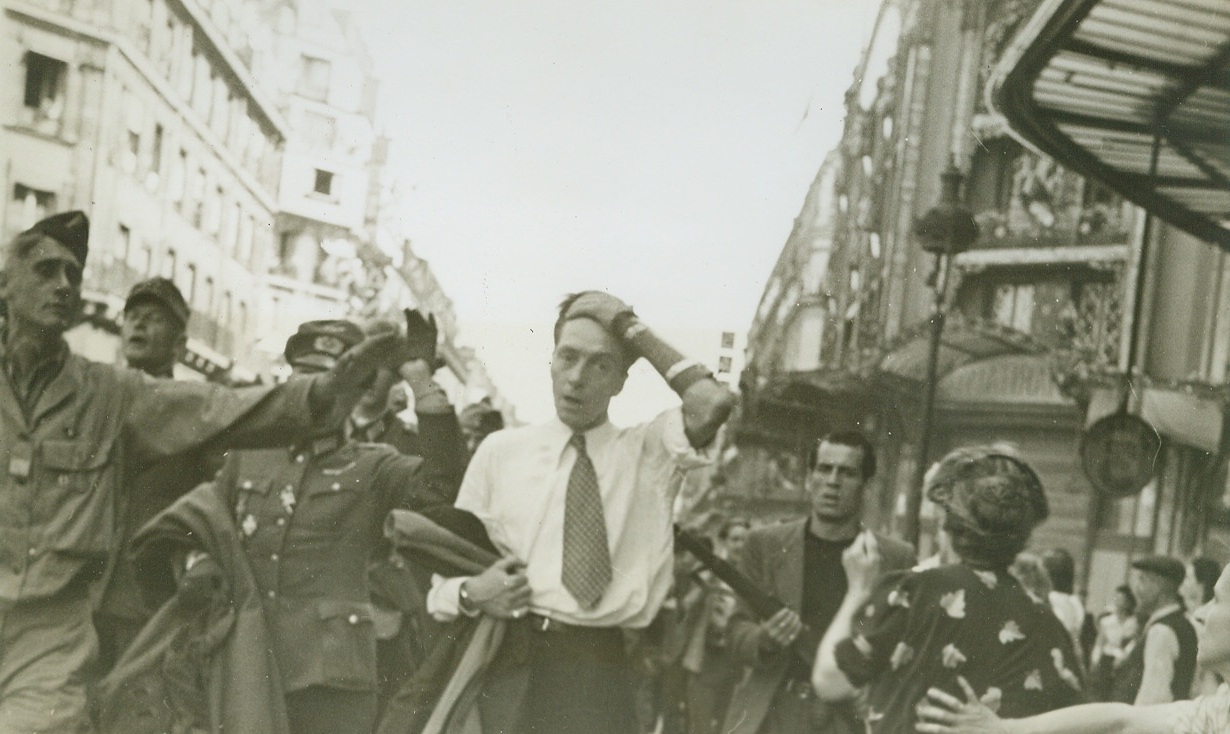
The Last Time They'll See Paris, 8/28/1944. FRANCE -- Captured Nazis are marched through Paris street under the careful and alert guard of the E.F.I. The man clasping his head is a German soldier who had dressed in civilian clothes and sniped at the French during the last days of the battle for the French capital. Credit (ACME Photo by Bert Brandt for the War Picture Pool);
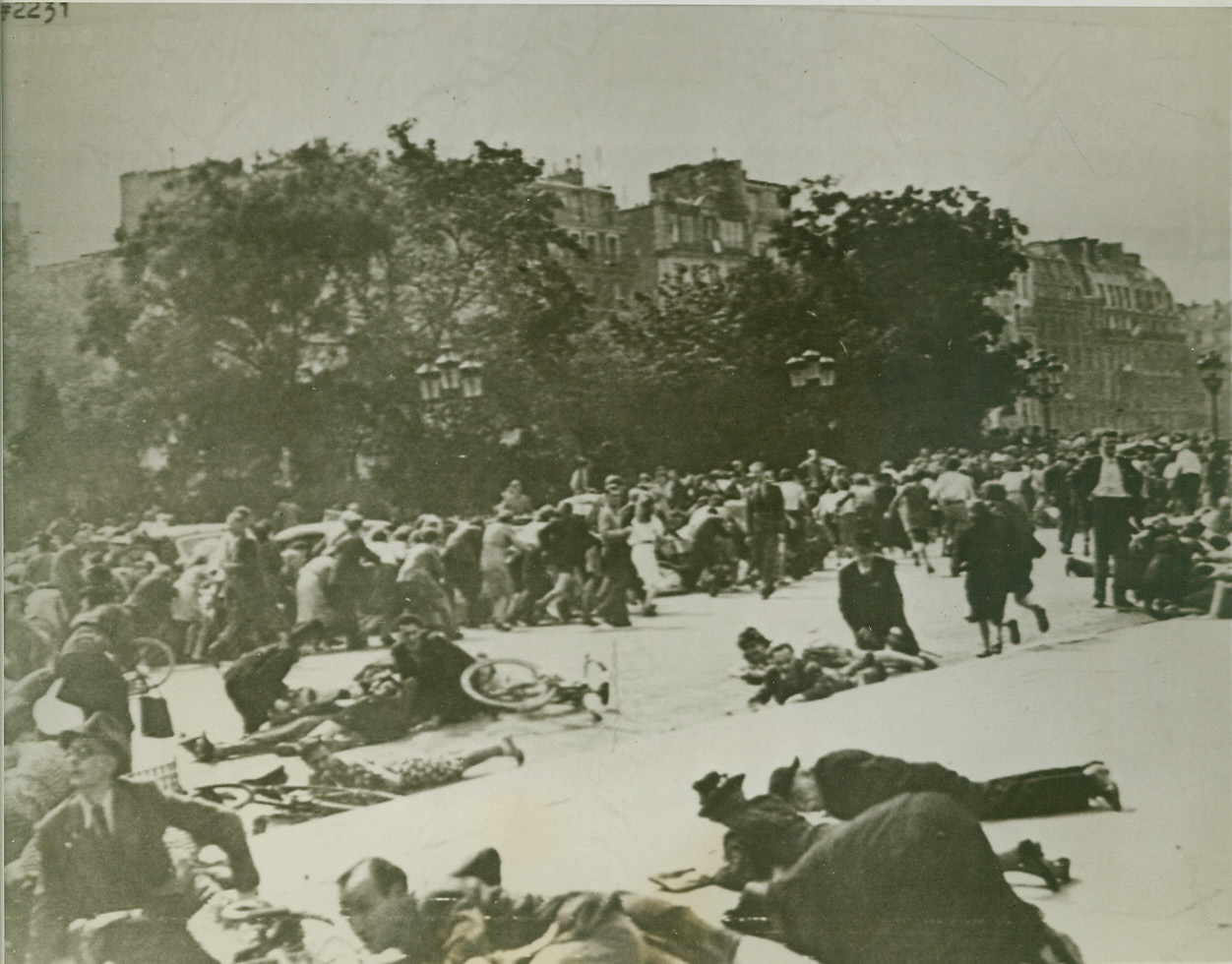
Hugging the Streets for Safety, 8/28/1944. PARIS -- Keeping their heads during the panic that ensued when German snipers fired into crowds outside Notre Dame Cathedral, Parisians stretch out on the pavement for safety. In the background, scores of frightened civilians run through the street. This is a British War Office Photo. Credit: (Army Radiotelephoto from ACME);
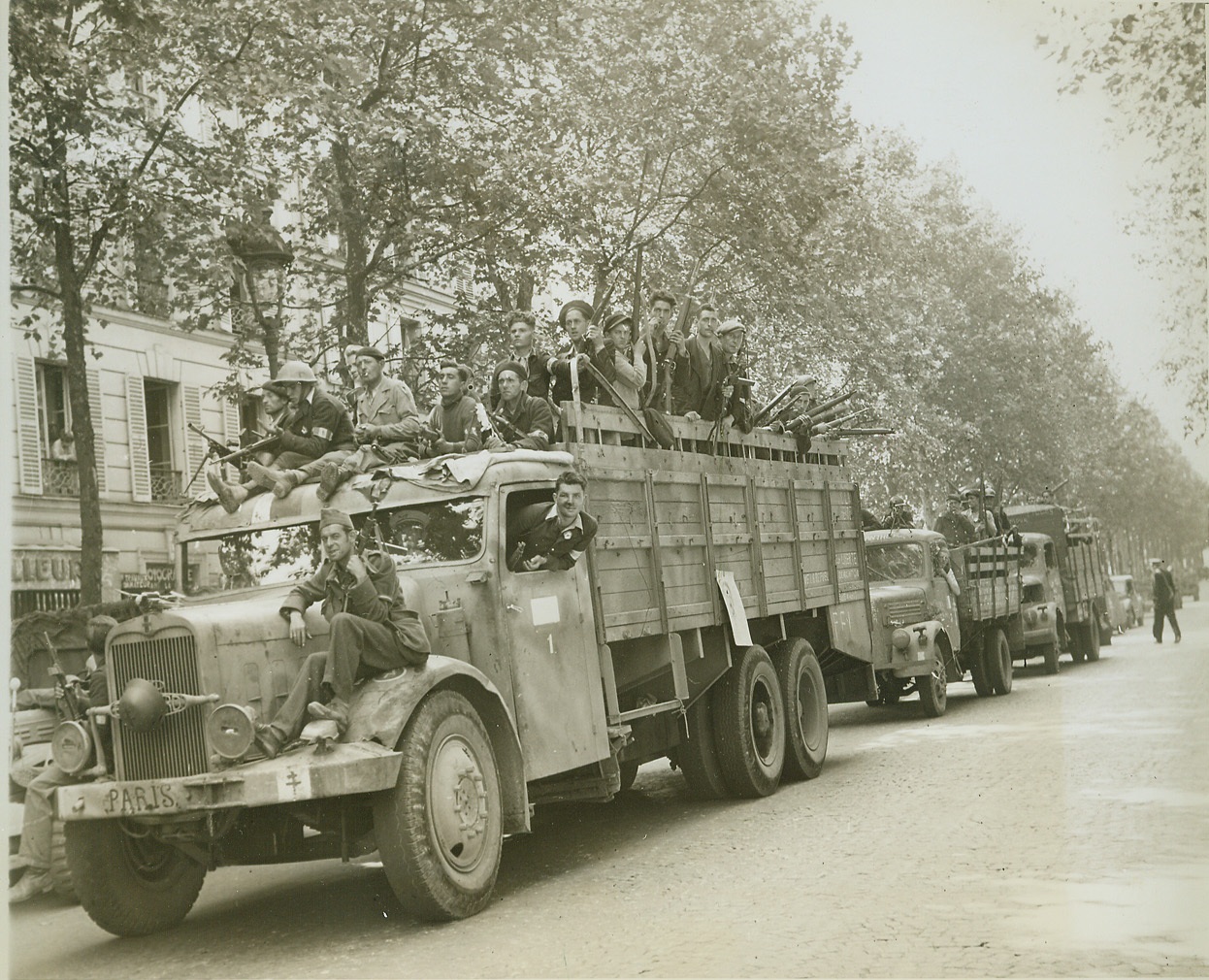
Sniper Hunt, 8/28/1944. PARIS -- Scanning streets and rooftops, FFI warriors ride through Paris in captured German vehicles, hunting German snipers and French Fascists fighting last-ditch resistance in the French capital. Note the Cross of Lorraine painted on the bumper of the captured truck in foreground. Credit: - WP- (ACME Photo by Andy Lopez for the War Picture Pool);
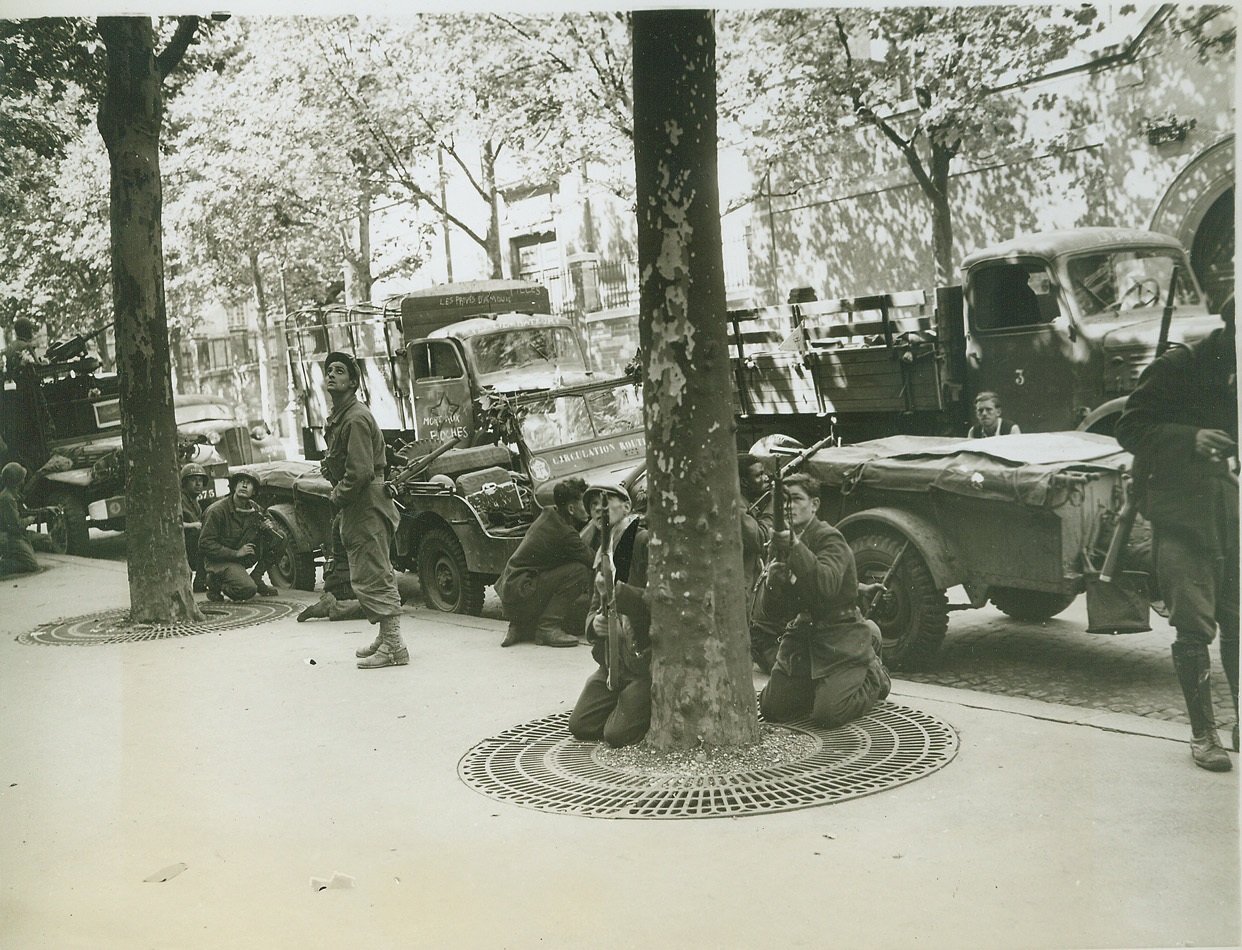
Snipers Above, 8/28/1944. PARIS -- Eyes on a rooftop where an enemy sniper has been spotted, men of the FFI and the Second French Armored Division are ready to let 'em have it during street fighting in the heart of Paris. Behind the valiant patriots are German trucks that were captured by the Maquis. Credit:-WP-(ACME Photo by Andy Lopez for the War Picture Pool);
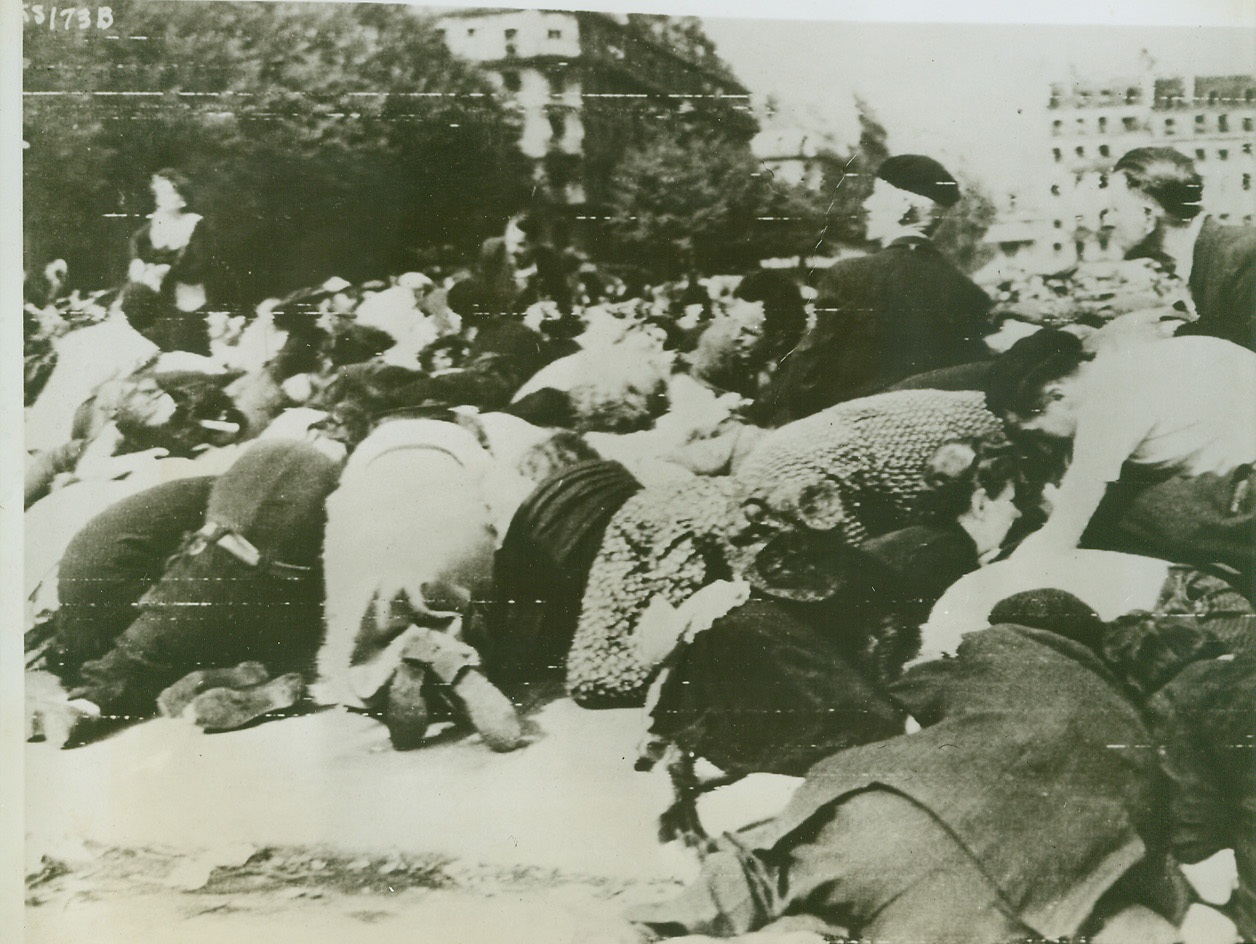
Everybody down, 8/28/1944. Paris—Civilians crouch low in the streets of panic-stricken Paris as sniper fire crackles overhead in the Place de L’Hotel de Ville. Terror reigned as gun shots rang out over the crowds watching the DeGaulle parade celebrating the liberation of Paris. Credit: ACME photo by Andrew Lopez for the War Picture Pool, transmitted via U.S. Signal Corps Radio Telephoto;
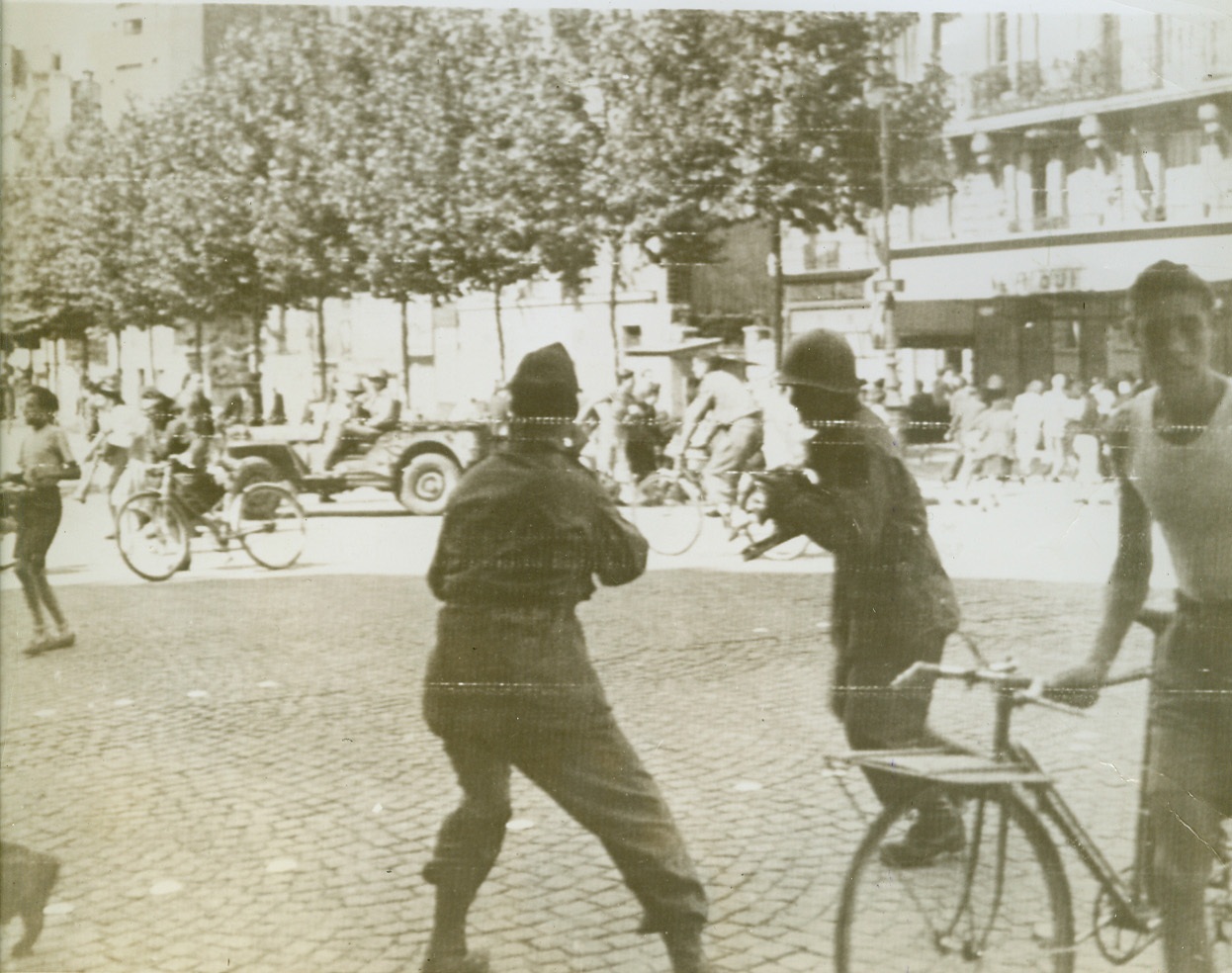
Paris Celebration Ends in Riot, 8/27/1944. Paris, France—A few minutes before the scene of a triumphal procession celebrating the liberation of Paris, this street in the vicinity of the Eiffel Tower is now filled with people scrambling to escape the rifle fire of Nazis and collaborationists quartered in nearby buildings. It was during this procession that an attempt was made on the life of Gen. de Gaulle. The photographers in the foreground, taking pictures as the people scramble for shelter, are probably war picture pool correspondents. Credit: ACME photo via Signal Corps;
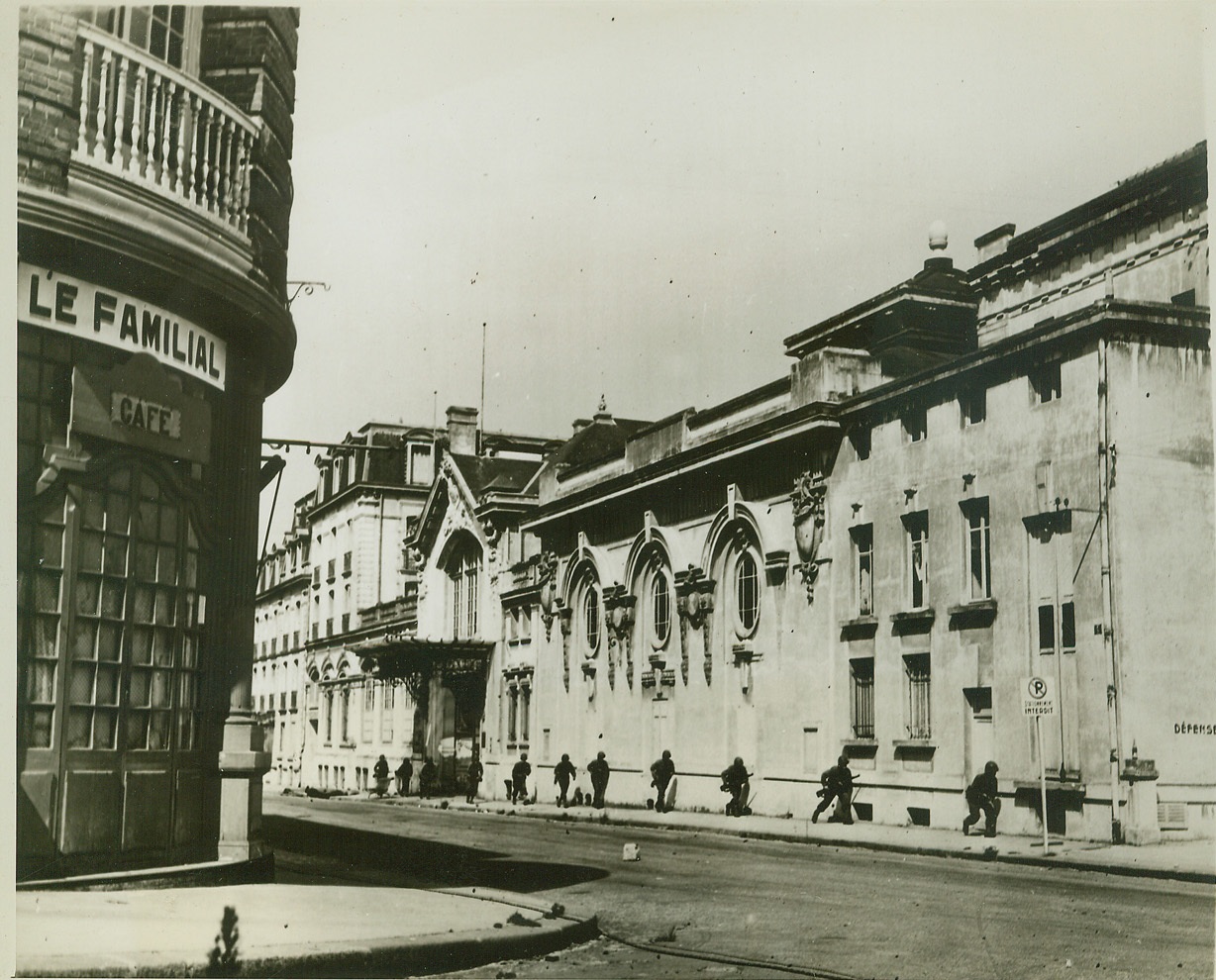
Step-by-Step Advance, 8/21/1944. Dinard, France—Hugging the wall of the casino building in Dinard, American infantrymen crouch as they advance. Making their slow way up the street, the Yanks are wary of German sniper fire. Credit: Signal Corps photo from ACME;
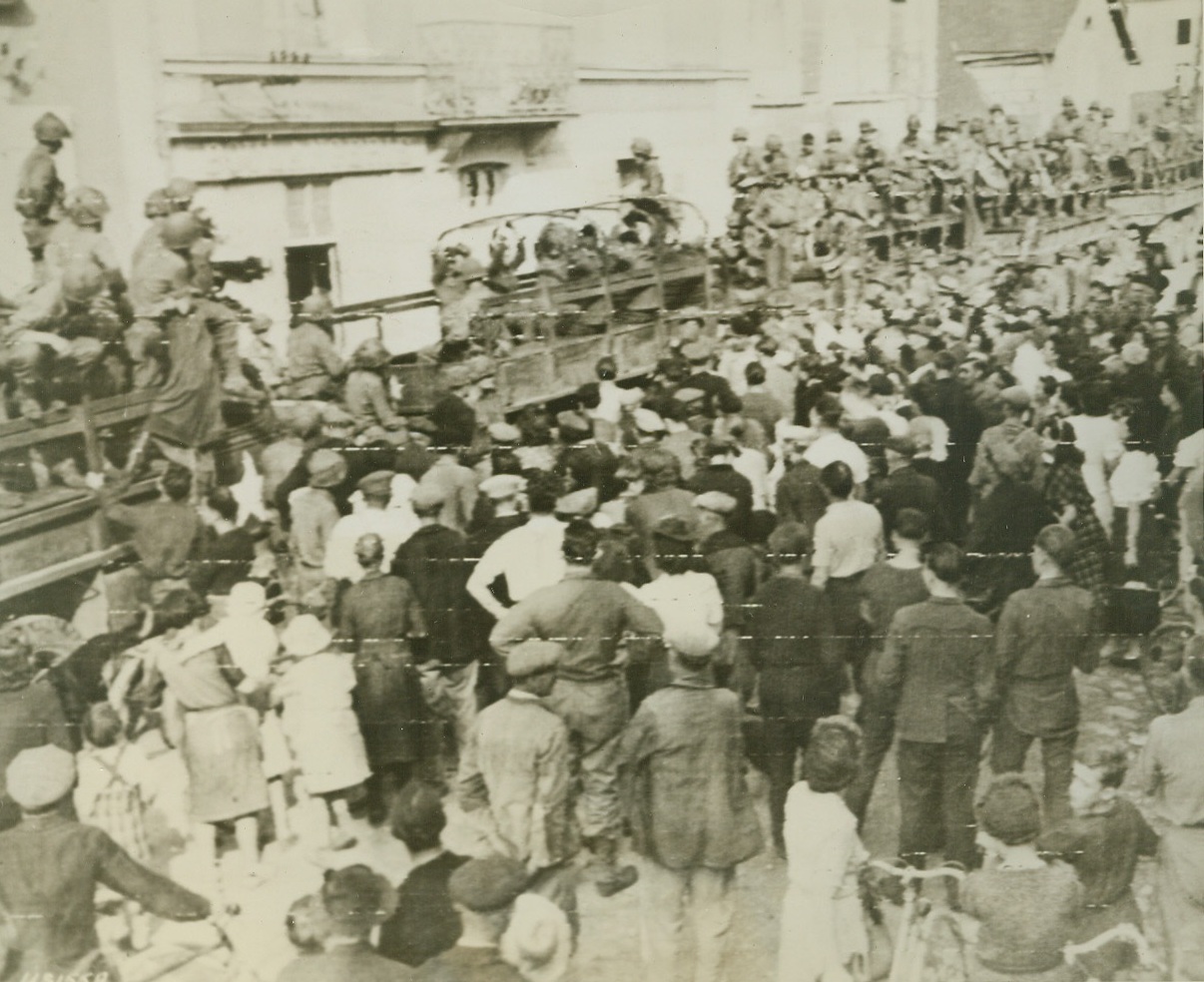
Nazi Prisoners Ride Yank Trucks, 8/15/1944. France—As residents stand at the side of the road, some of the 800 Nazis captured in Chateauneuf sur Sartre are driven by American soldiers on trucks to prison compounds. Credit: Army radiotelephoto from ACME;

France Regains Its Chamber of Deputies, 8/30/1944. France—Some of the 400 Germans who barricaded themselves in the Chamber of Deputies in Paris and fought off liberating troops are lined up in the courtyard after surrending to French partisan forces. Credit: ACME;
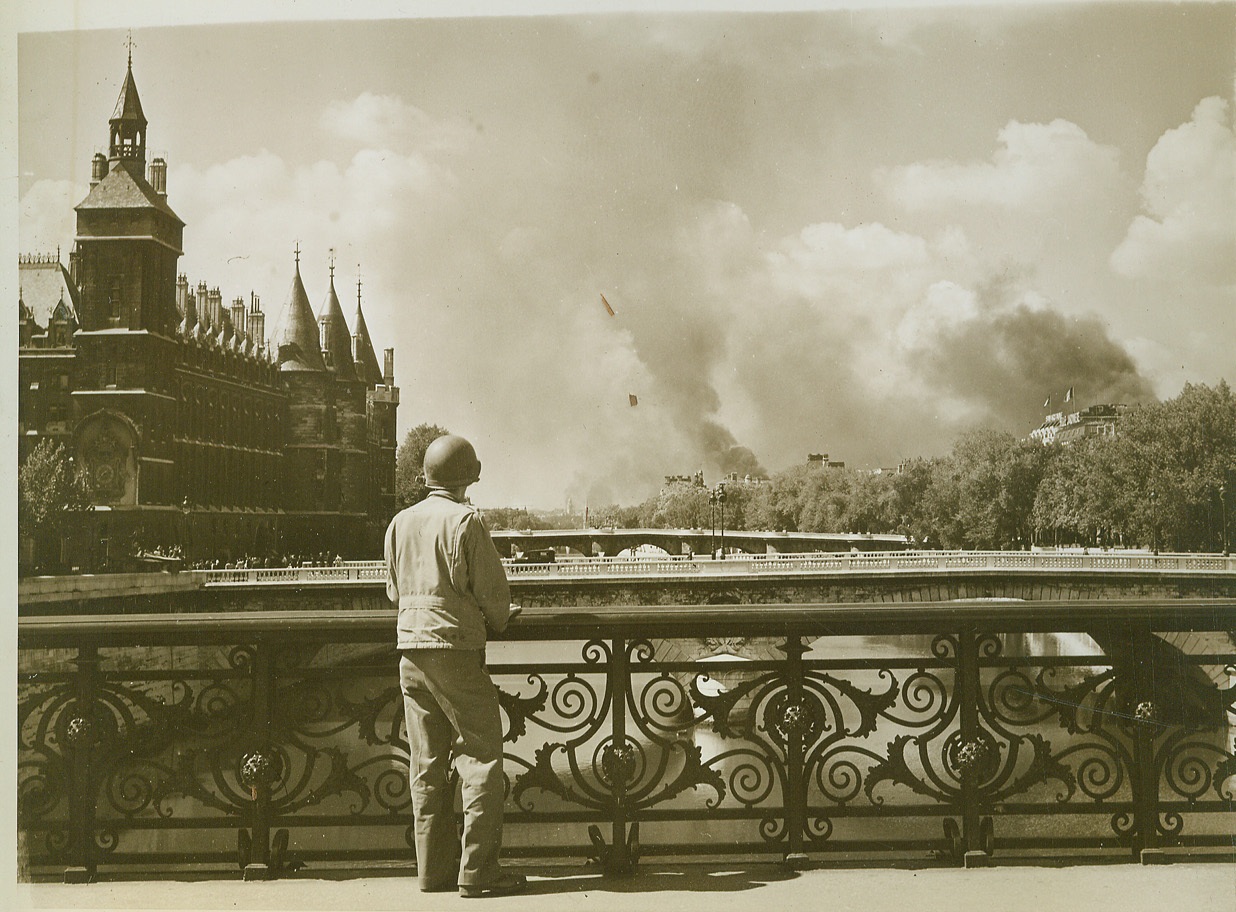
Across the Bridge Paris Burns, 8/30/1944. France—An Allied soldier stands on one of the many bridges across the Seine in Paris to watch fires burning on the outskirts of the French capital during the spasmodic fighting that took place before the city was completely liberated. Credit: ACME photo by Bert Brandt, War Pool correspondent;
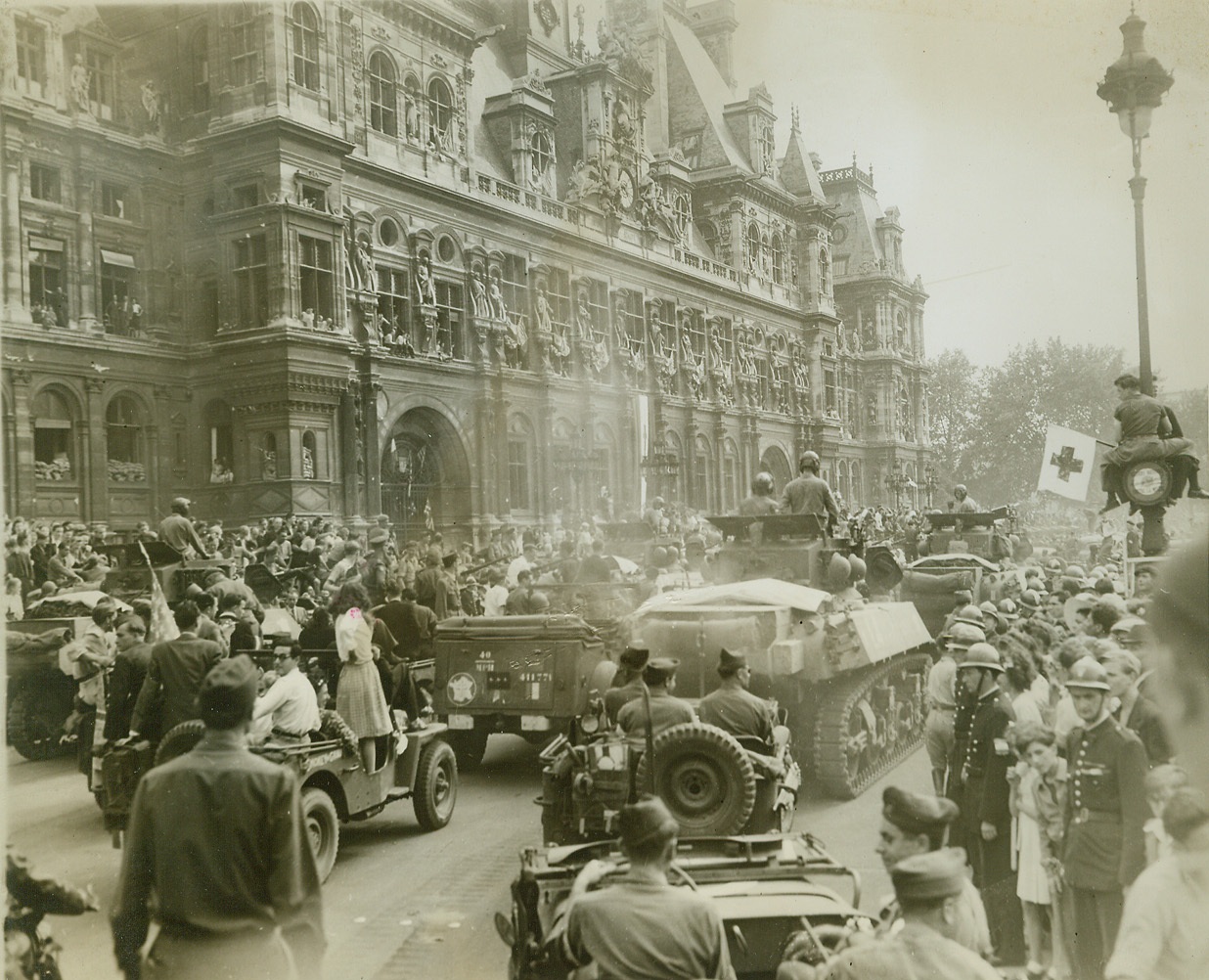
Stage Set For Panic, 8/28/1944. Paris—This was the scene in the Place de L’Hotel de Ville before snipers sent a panic-stricken crowd scurrying for their lives during the official reception for General Charles de Gaulle. The street is jammed with Allied armored vehicles and hundreds of celebrating Parisians. At left, spectators jam the windows of the Hotel de Ville, while at right one spectator has climbed to a perch halfway up a lamp post to witness the celebration. Credit: ACME photo by Andy Lopez for the War Picture Pool;
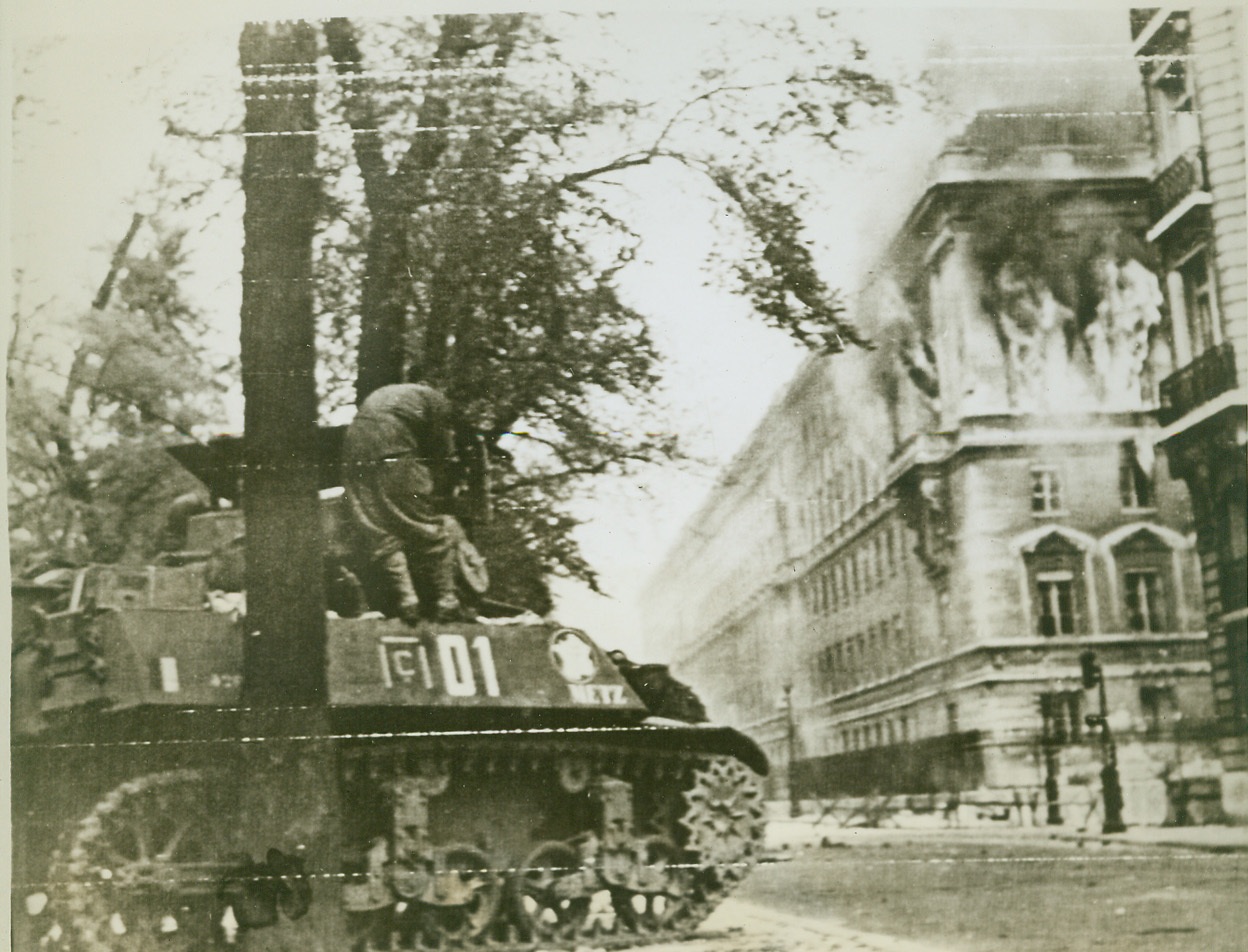
Chamber of Deputies Burns, 8/28/1944. Paris—Flames and smoke pour from the windows of the Chamber of Deputies in Paris, which was used as a defense point by German troops and French fascists. A free French tank halts in the street below. Credit: ACME photo via Army radiotelephoto;
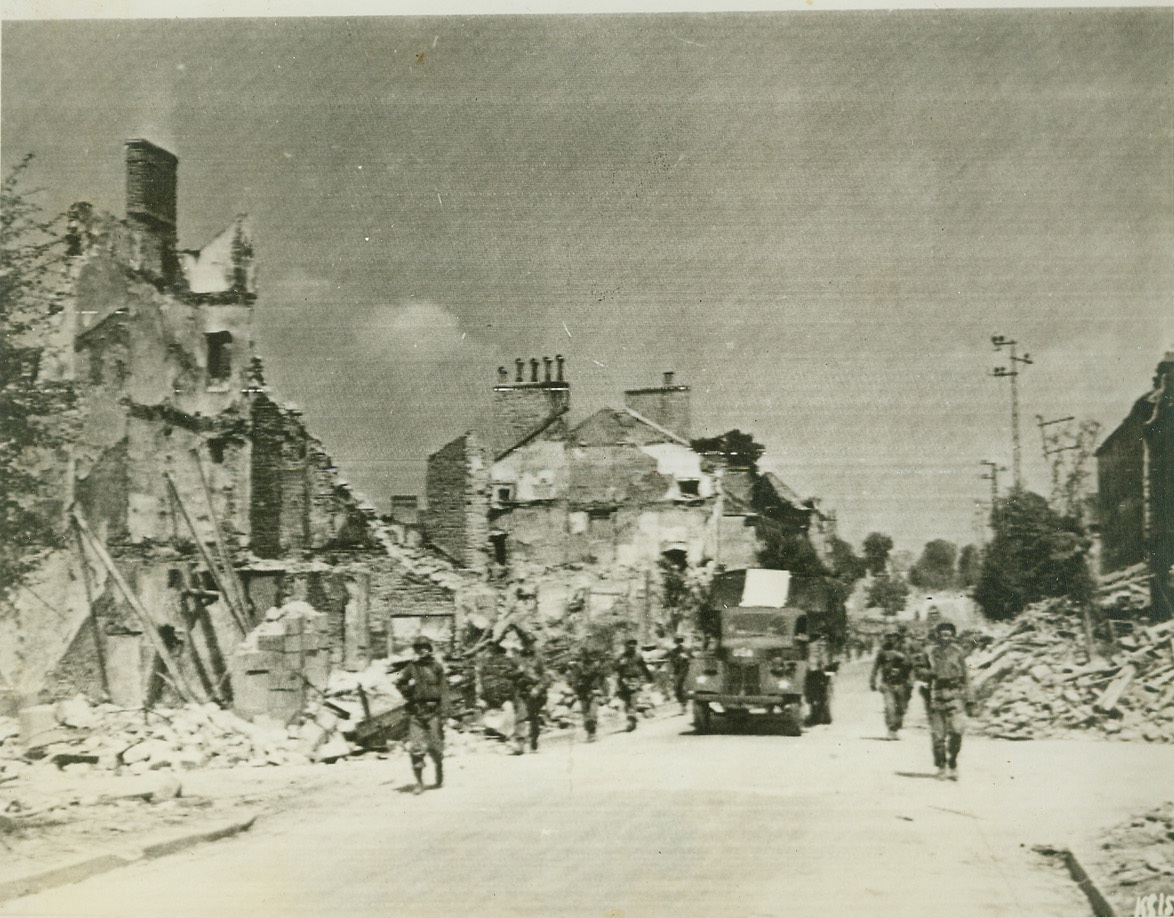
In Pursuit of Germans, 8/8/1944. France—American Infantrymen move through Mayenne on the heels of German forces, fleeing in the face of the American blitz offensive. Buildings were blasted by U.S. bombers. Credit: Army radiotelephoto from ACME;

Welcome Home, Son, 8/19/1944. Alencon, France—With her arms outstretched eagerly, a happy mother welcomes her soldier son back to France after the town of Alencon had been freed by advancing American forces. The soldier has returned to his homeland after years of exile while it was under German rule. Credit: Signal Corps radiotelephoto by ACME;
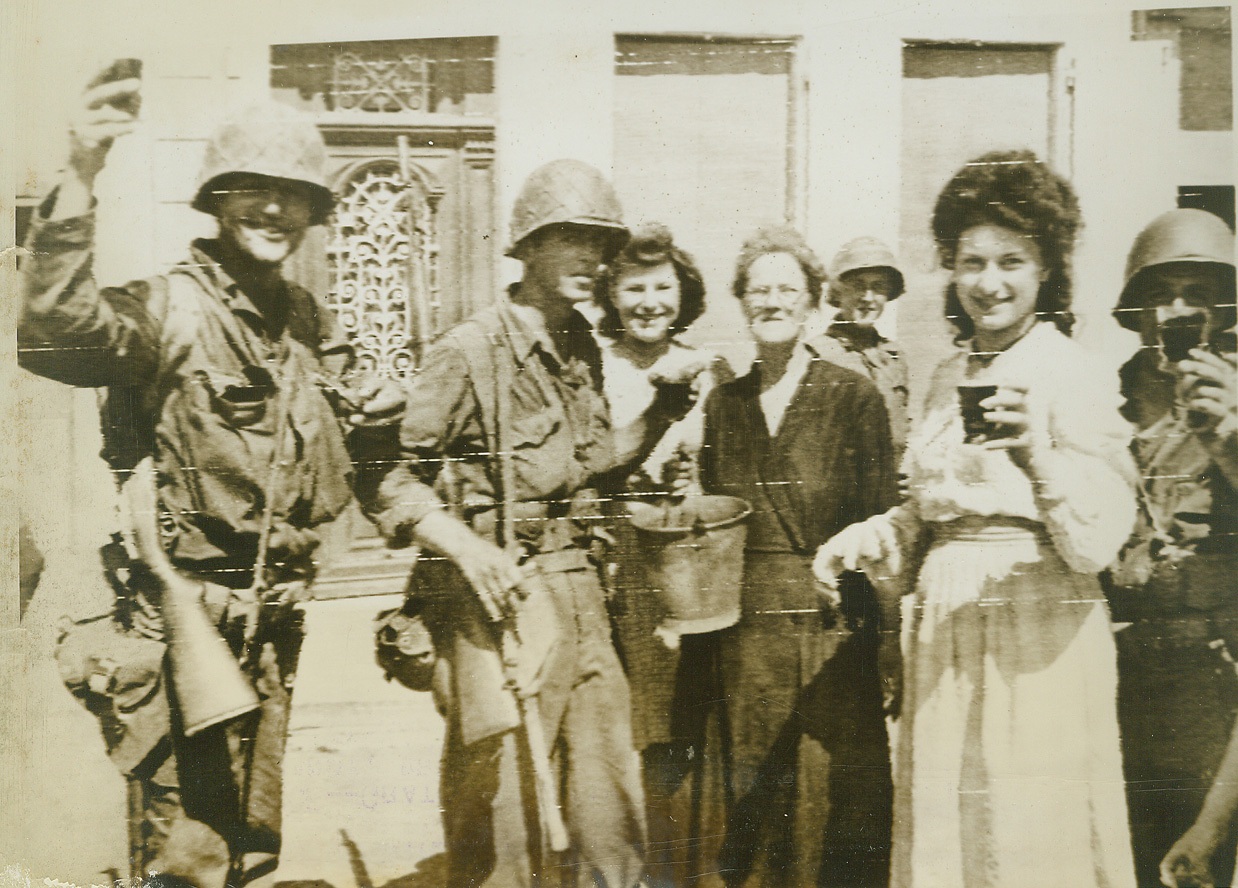
Wine "Bucket Brigade", 8/17/1944. France—Grateful natives of this town in Normandy bring wine in buckets to refresh Yank liberators passing through the streets. Credit: Army radiotelephoto from ACME;
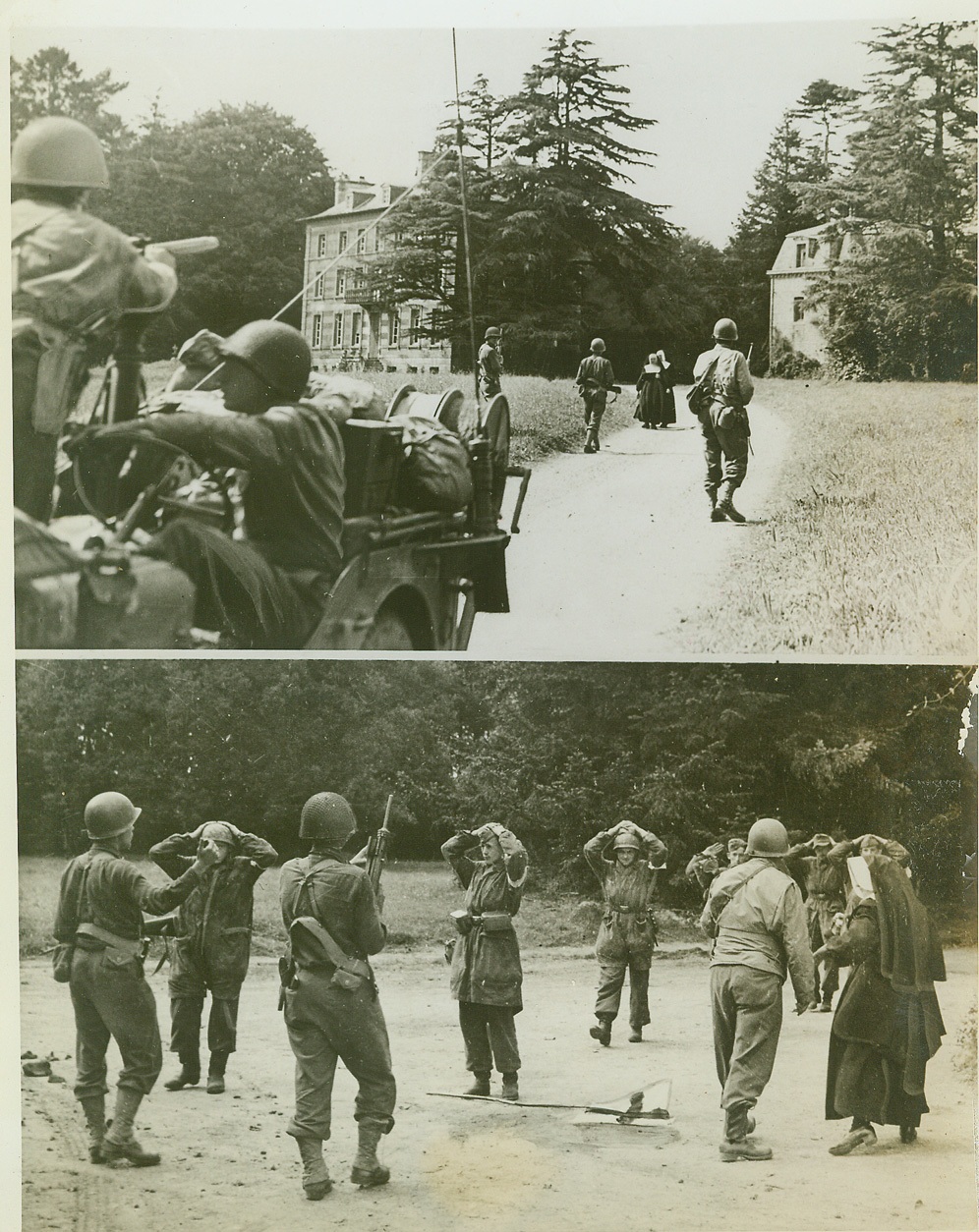
Surrender In Avranches, 8/10/1944. France—During the drive for Avranches an American patrol heads cautiously toward a convent where Nazi soldiers are believed to have fortified themselves. In the top photo two nuns come out to meet the patrol bearing the German offer of surrender. Capt. Albert J. Owen, nearest the nuns, accepted the surrender. In the bottom photo, German soldiers, hands on their heads, come out of their convent hiding place. Looking on is one of the nuns who negotiated the surrender. Credit: ACME;

France Regains Its Chamber of Deputies, 8/30/1944. France—With a Nazi garrison barricaded behind him, a German officer hangs onto rail of the Chamber of Deputies in Paris while negotiating for surrender to the French partisans. He holds the white flag of truce while a French soldier in the foreground has the Tricolor ready to hoist as a signal of victory when surrender is complete. Credit: ACME;
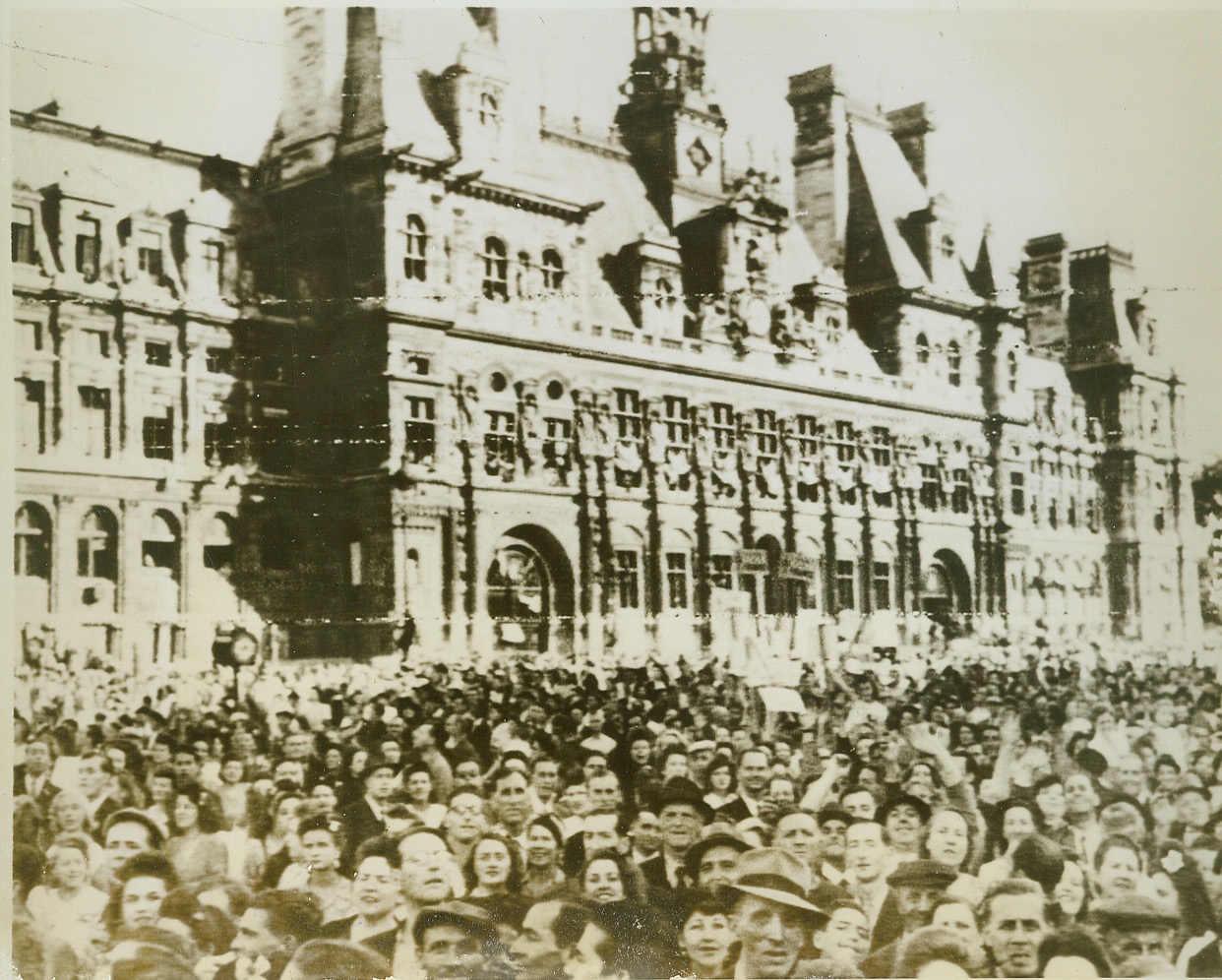
Celebrants Mass in Paris Streets, 8/28/1944. Paris—With faces reflecting the joy of being free once more, Parisians mass in front of the Hotel de Ville in Paris to celebrate the liberation of their city. Shortly afterward, as their voices raised in triumphant cheers for Gen. de Gaulle, shots rang out over their exuberant voices as snipers preyed on the assembly. The General, leading a triumphal procession, narrowly escaped death or injury. Credit: Signal Corps radiotelephoto from ACME;
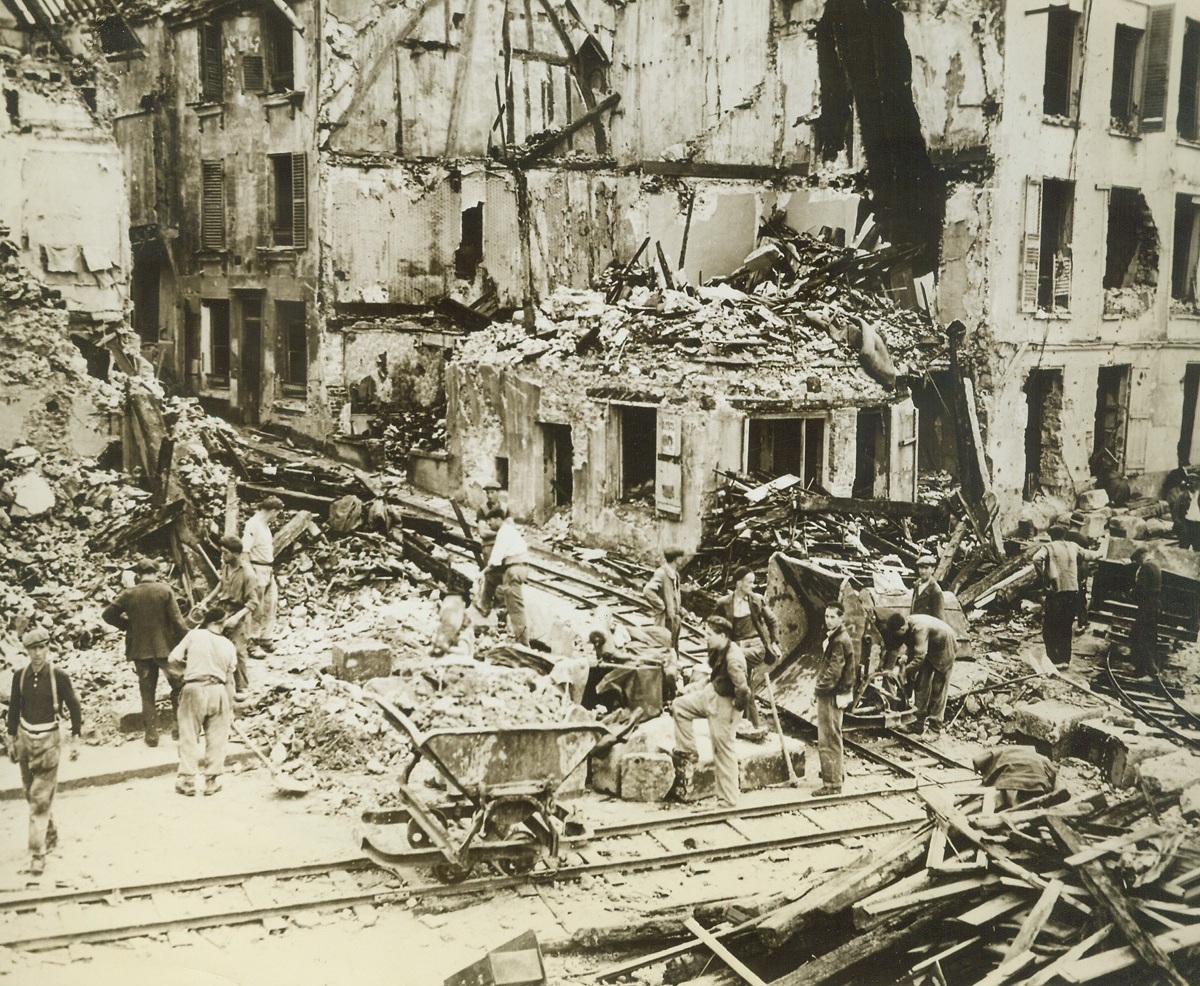
Digging Out After Liberation By American Army, 8/29/1944. MANTES, FRANCE - Damage done by Nazi demolition teams as they left town to Yanks.;
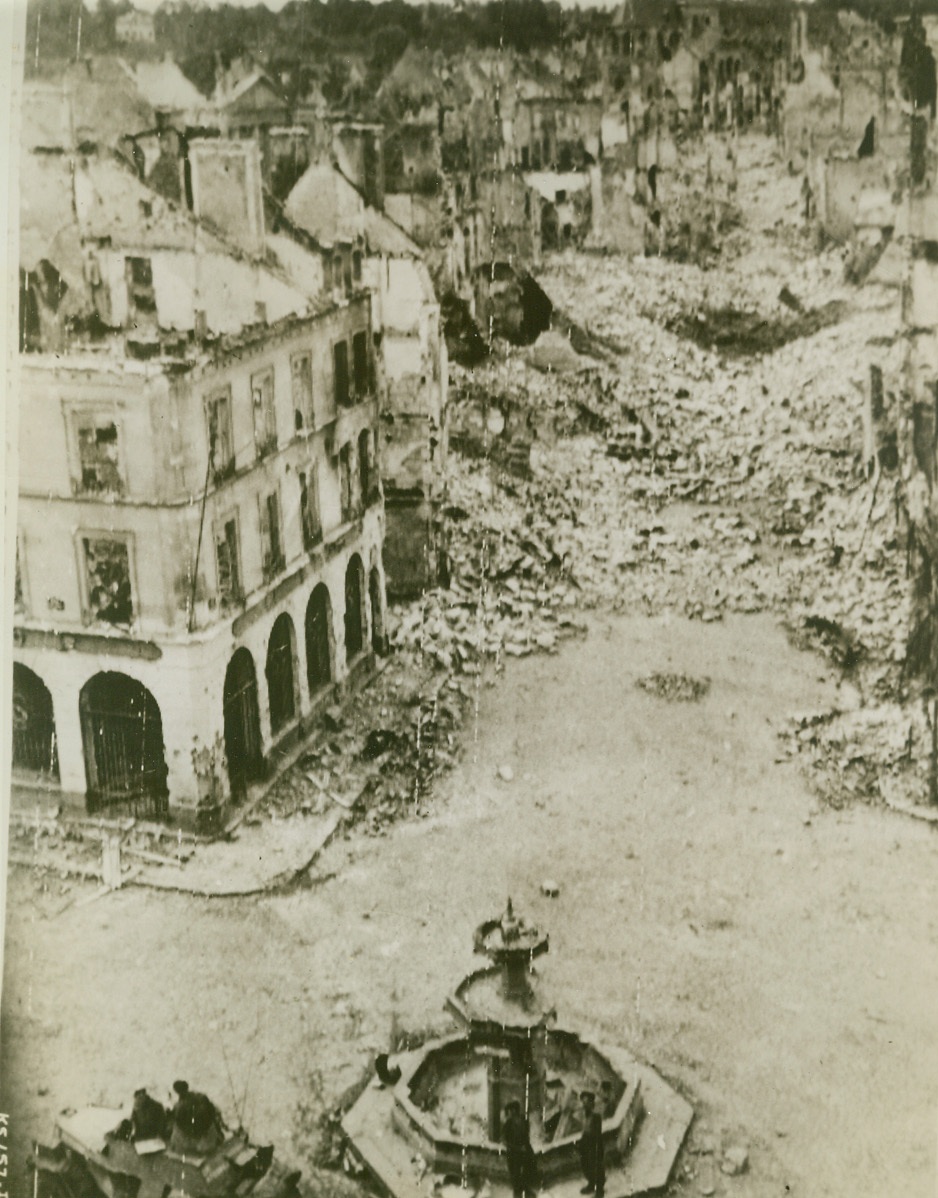
Falaise—City of Destruction, 8/18/1944. France—Heaps of broken masonry line the shell-torn streets of Falaise, France, taken by Canadian troops after hard and bitter fighting. Houses are gutted and the city is but a ghost town after Nazi demolition squads finished their destructive tasks. Credit: Army radiotelephoto from ACME;
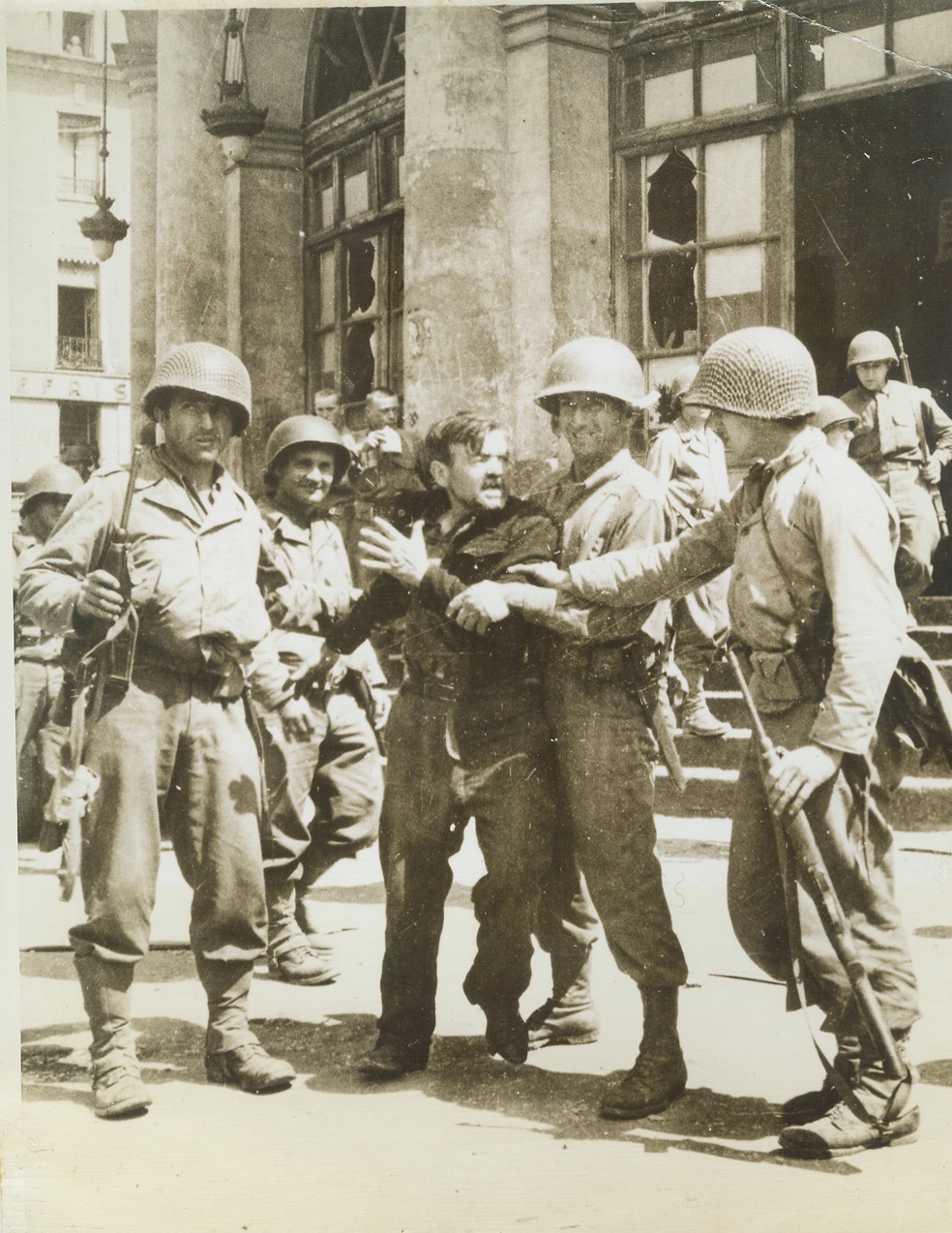
Underdog Turns on Nazis, 8/11/1944. Rennes, France—While American soldiers restrain him, this French patriot struggles to free himself and vent his wrath on disarmed Nazi prisoners of war gathered on the Rennes City Hall steps. Finally freed of Nazi oppression, he fought to get at those who were responsible for the tyrannical treatment. Credit: ACME;
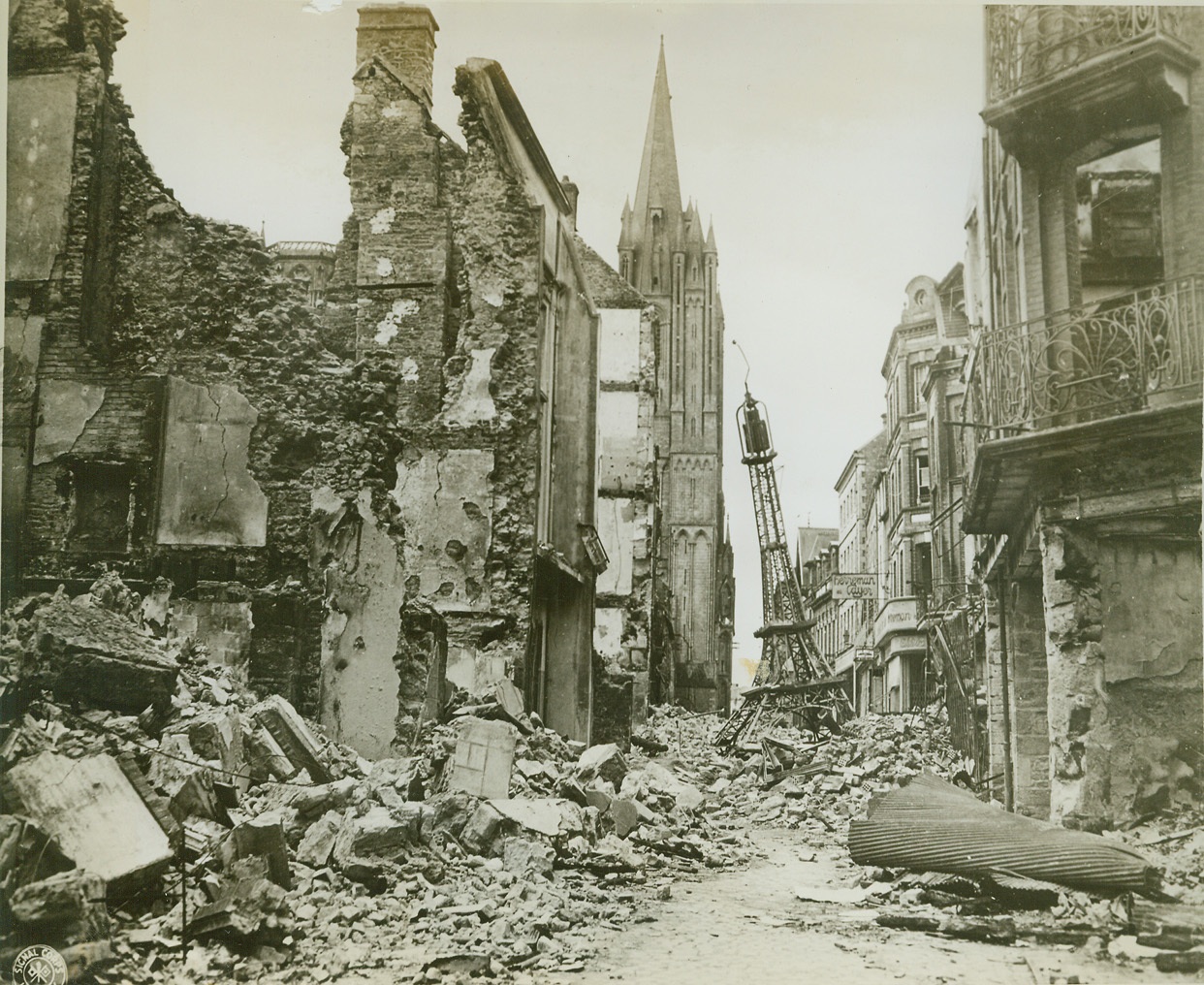
Miniature Eiffel Tower Amid Wreckage, 8/3/1944. France—Flanked by war-torn buildings, a small replica of the famous Eiffel Tower rests atop a heap of rubble in a Coutances Street. In the center, background, is the Cathedral, seemingly undamanged. Credit: U.S. Army photo from ACME;
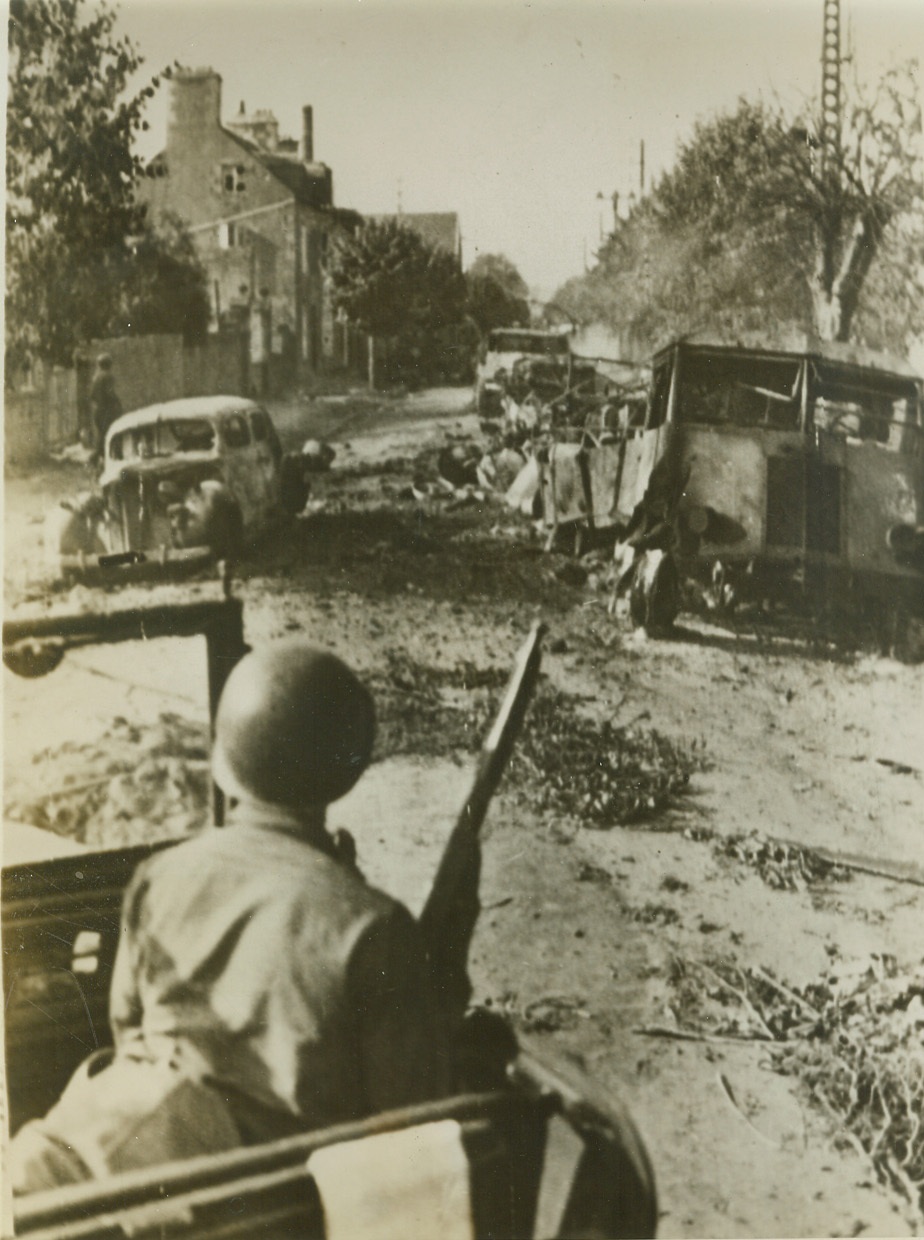
Blasted Nazi Vehicles Greet Yanks, 8/3/1944. France—American forces sweeping through Avranches, are greeted by the sight of destroyed German vehicles lining a street in the town. Credit: Army radiotelephoto from ACME;
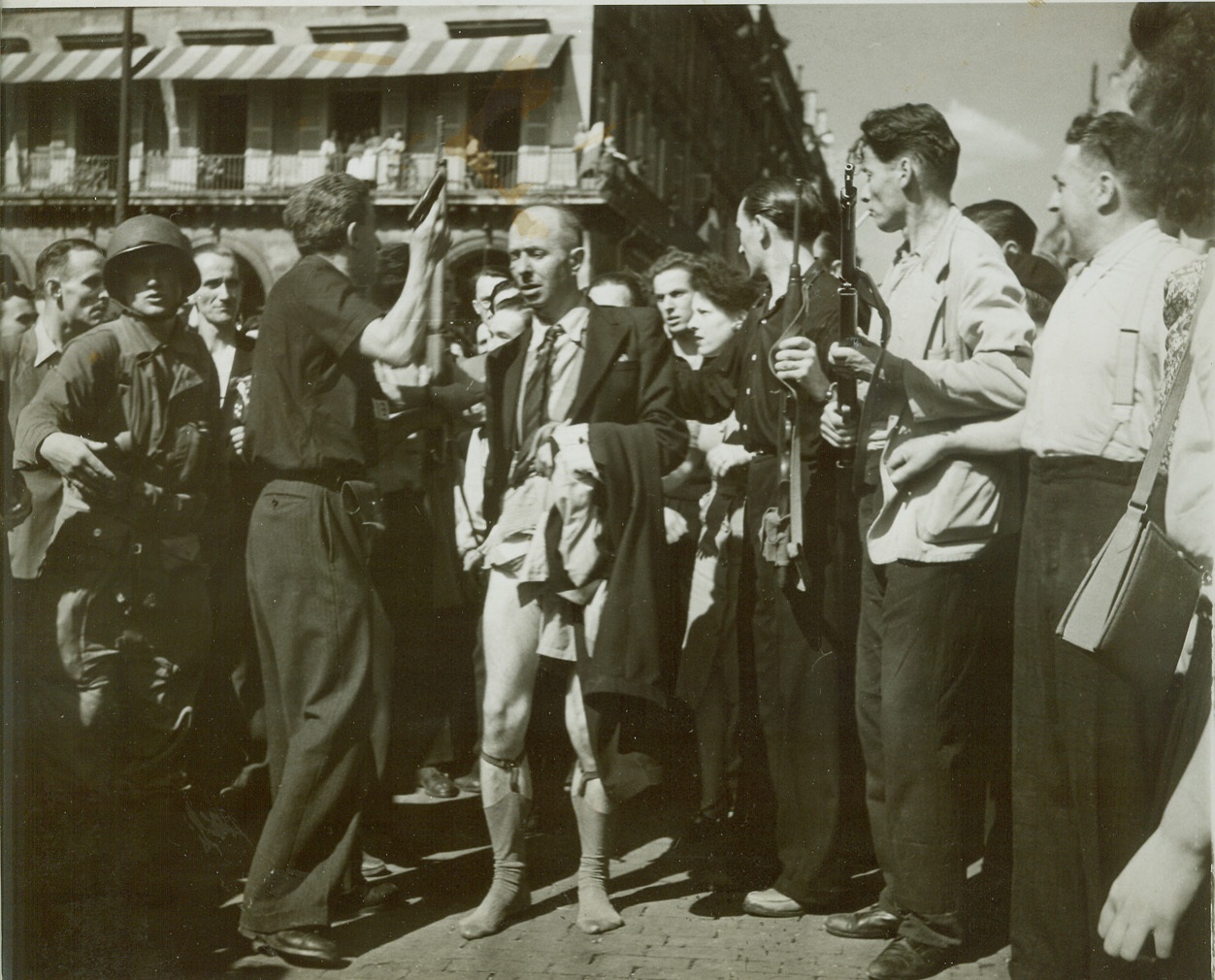
Collaborationist Who Needed “Protective Custody”, 8/28/1944. Paris—This collaborationist who lost his pants to an angry group of Parisians is shown being saved by the F.F.I. and taken into their protective custody. Credit: ACME photo by Bert Brandt for the war picture pool;

Removing German Tank Obstacle, 8/1/1944. Normandy, France—The camera records the instant when the bazooka guns fired by the Allied soldiers in the foreground score direct hits on the German tank in the rear, and the vehicle goes up in a cloud of flame and smoke. The soldiers were aiming at the wrecked building which housed German snipers, but the tank was blocking their attack. Credit: ACME;
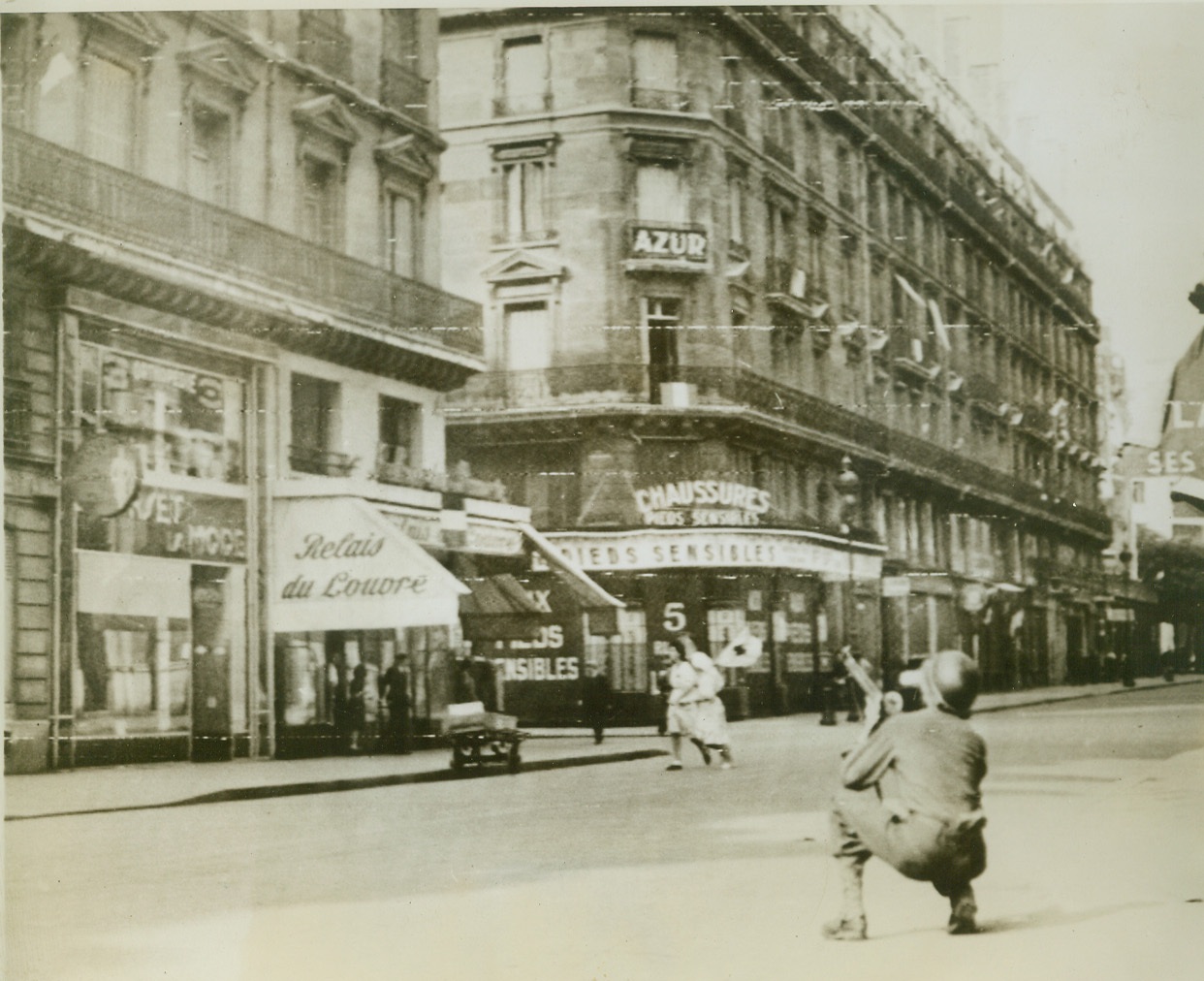
Snipe-Hunting in Paris Streets, 8/28/1944. Paris—As two French Red Cross nurses scurry for safety from a sniper who opened fire from a building in Paris, an American infantryman, with no shelter, kneels in the street and seeks to locate the sniper. Credit: Signal Corps radiotelephoto from ACME;
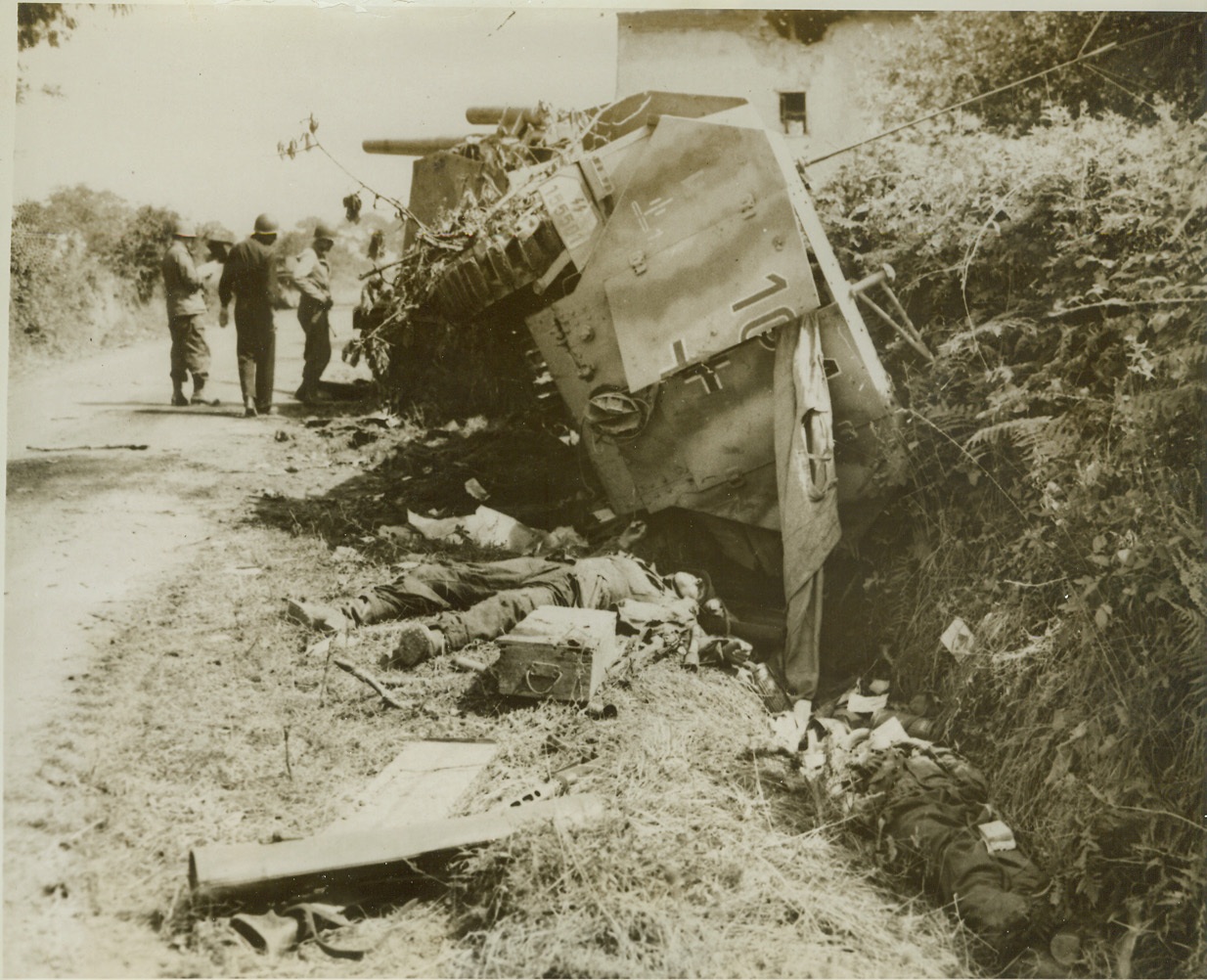
Where Nazi Panzers Were Trapped, 8/3/1944. France—Wrecked German armored vehicles and their dead crew members lie along this road in Roncey, where they were trapped by American troops and destroyed by supporting Allied fighters and rocket bombers. The U.S. Second Armored Division sprung the trap on the Nazis. Credit: ACME;
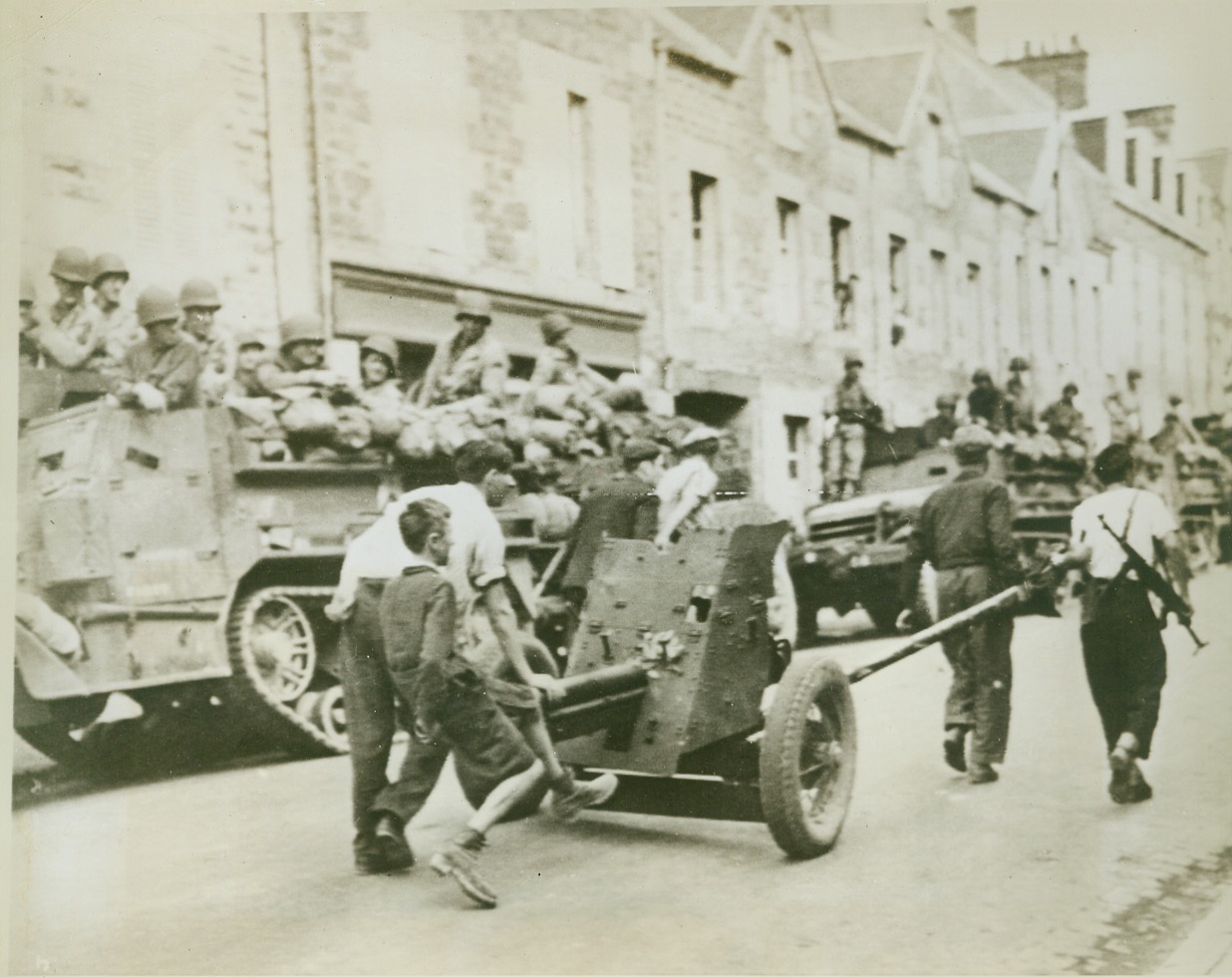
Frenchmen Retrieve German Gun, 8/4/1944. France—As American and Allied forces watch from trucks at the side of the road, civilians of Brehal, France, bring in German equipment left behind by the rapidly retreating Nazis. Little boy rides the barrel of a light infantry cannon being rolled through the town. Credit: Signal Corps radiotelephoto from ACME;
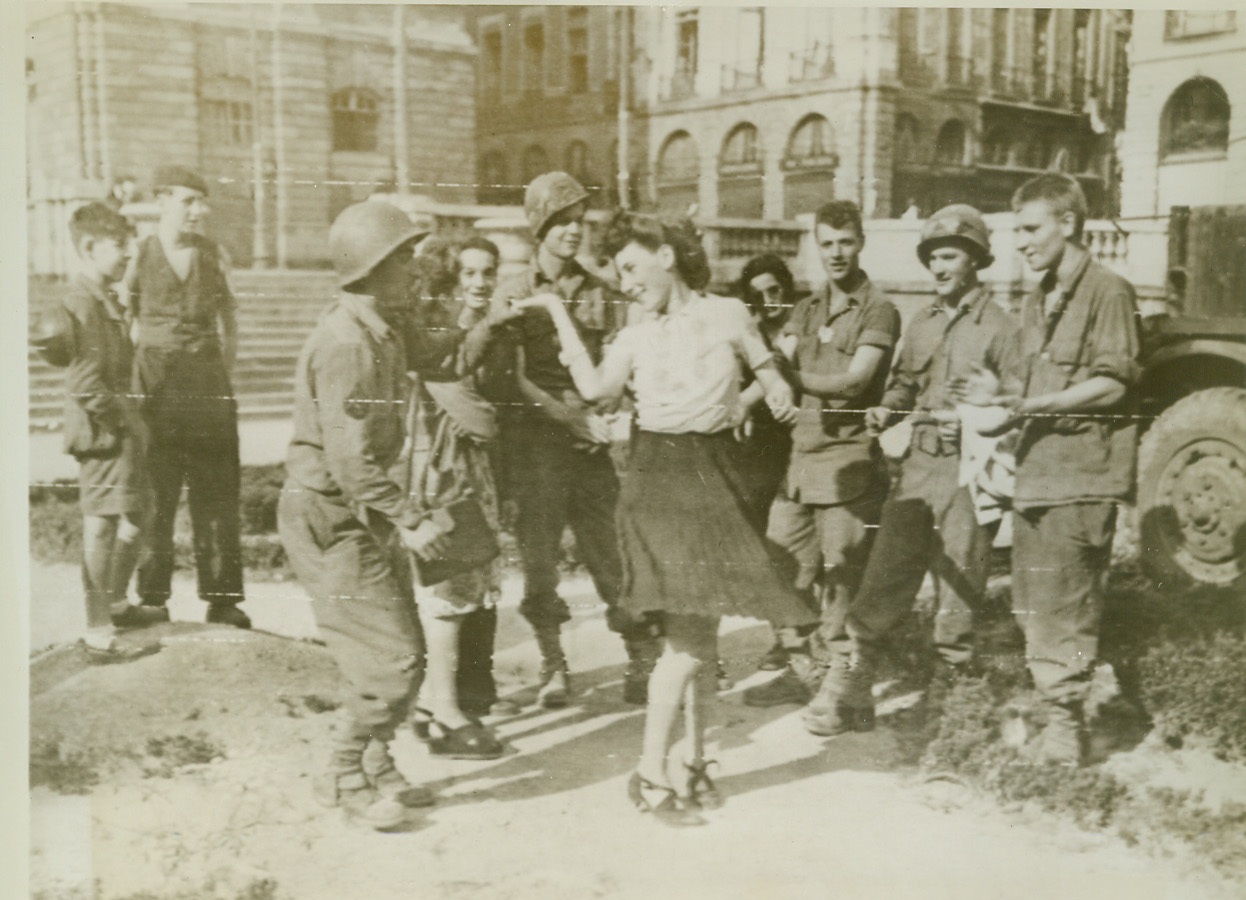
G. I. Jitterbugging, 8/6/1944. Rennes, France—So great was their joy over the Allied capture of Rennes that natives of that great city literally danced in the streets. Here a pretty French girl cuts a rug with Rosario Talliento, a G. I. from Brooklyn, New York. Credit: Signal Corps radiotelephoto from ACME;

She’ll Wave No More, 8/6/1944. Rennes, France—Smiling Yanks hold the flag that will fly no longer over liberated Rennes, capital of Brittany and largest French town to fall to the Allies to date. Beside the deposed Swastika, someone waves the Stars and Stripes, which, with the Tricolor, now waves over the city. Credit: Signal Corps radiotelephoto from ACME;

Before the ruins, 8/5/1944. France—Before the ruins of a war torn house in Periers, Normandy, Sgt. F. Clark, Marblehead, Mass., gazes at the statue of peace that somehow escaped damage. Only the pedestal has been chipped by shell fragments. With the rapid Nazi retreat on all fronts, this statue becomes a definite sign of the times. Credit: ACME;





 Trash & Recycling
Trash & Recycling
 Online Payments
Online Payments
 City Documents
City Documents
 Parks
Parks
 Traffic Court
Traffic Court
 City Parks
City Parks
 Outdoor Recreation
Outdoor Recreation
 Volunteer
Volunteer
 Home
Home TRANSLATE
TRANSLATE
